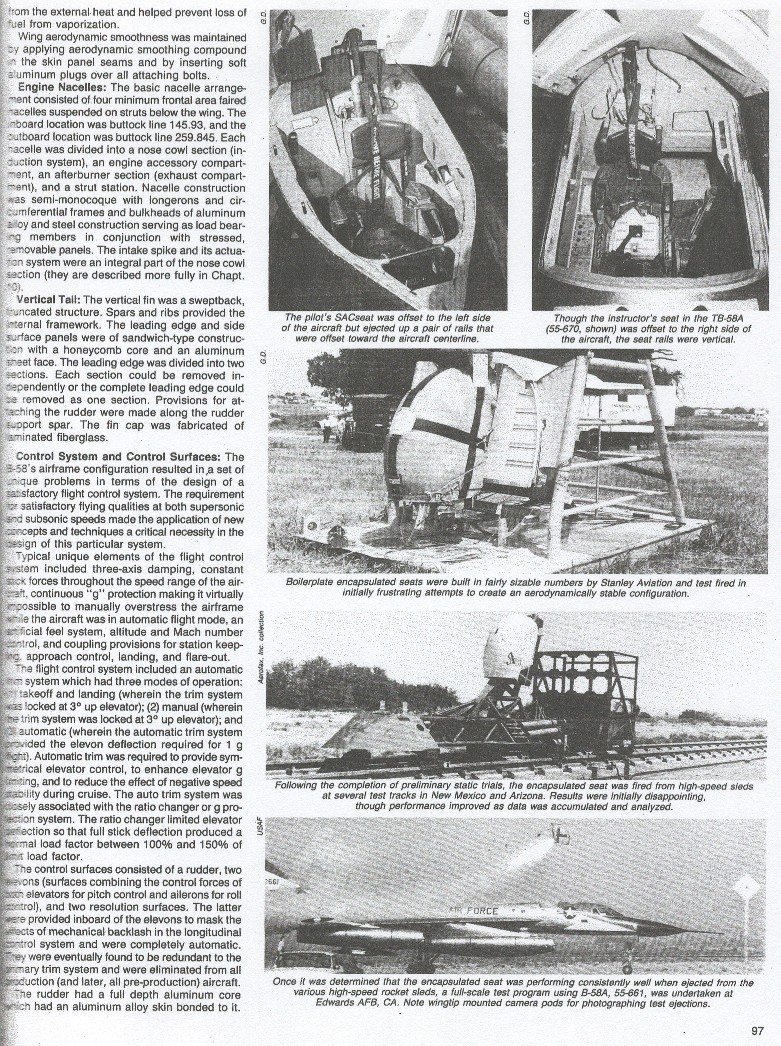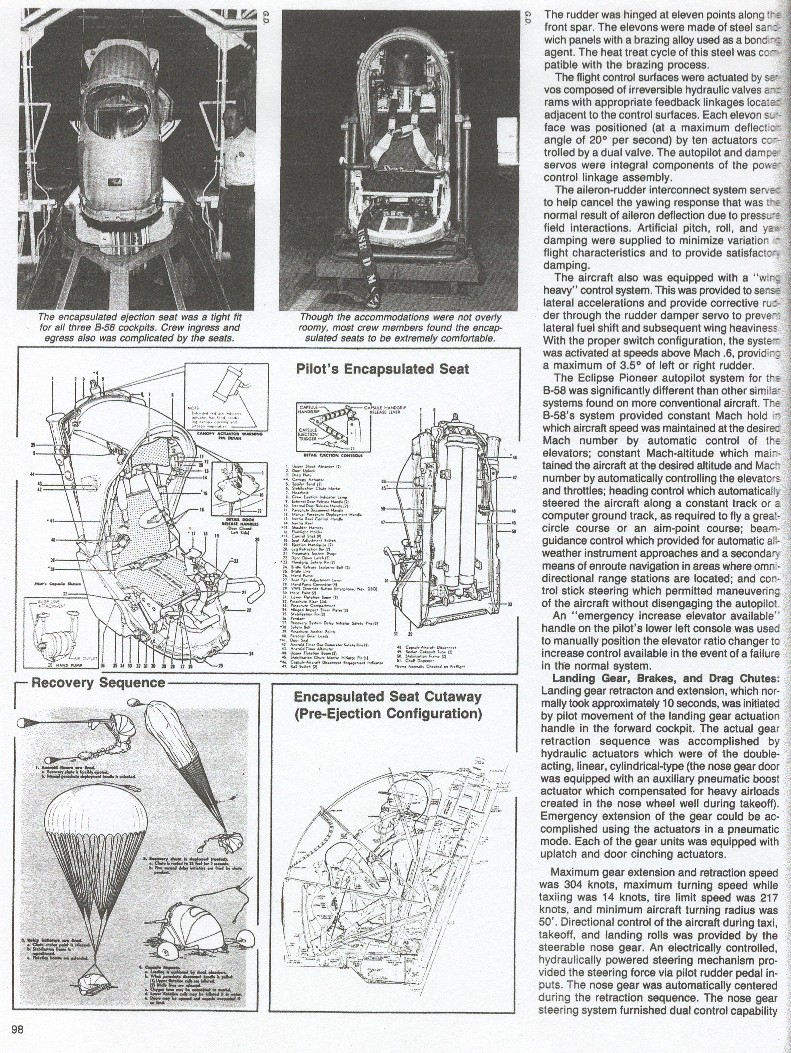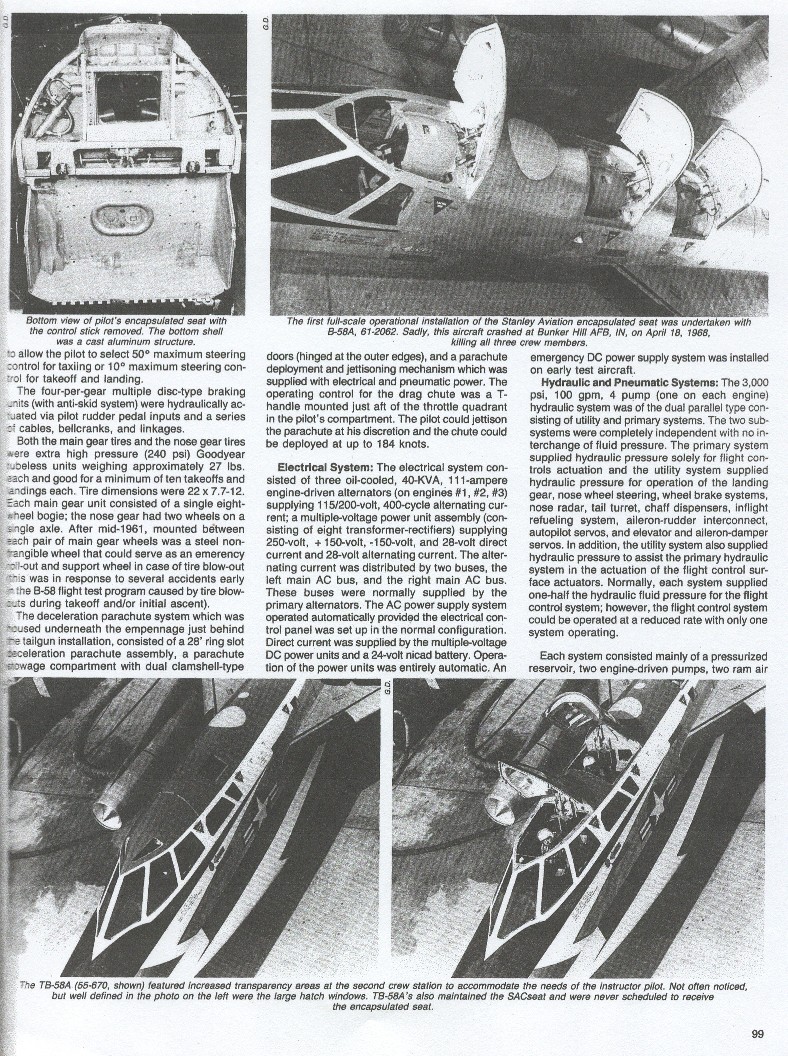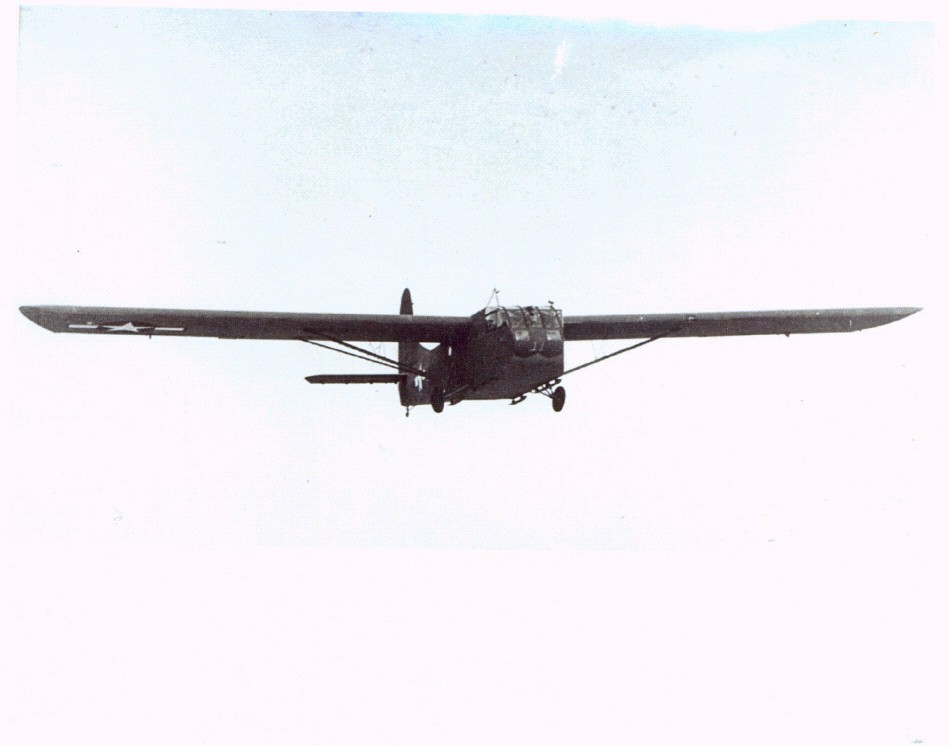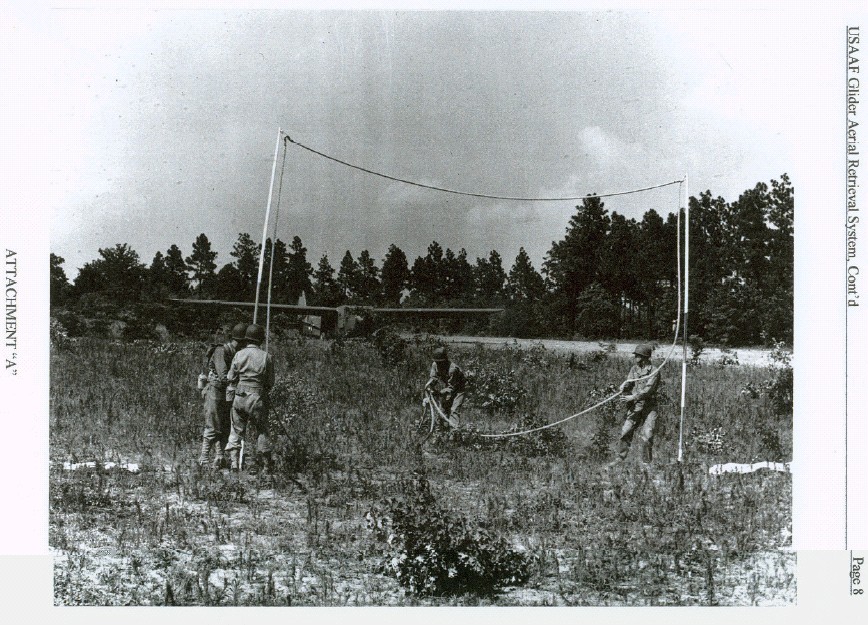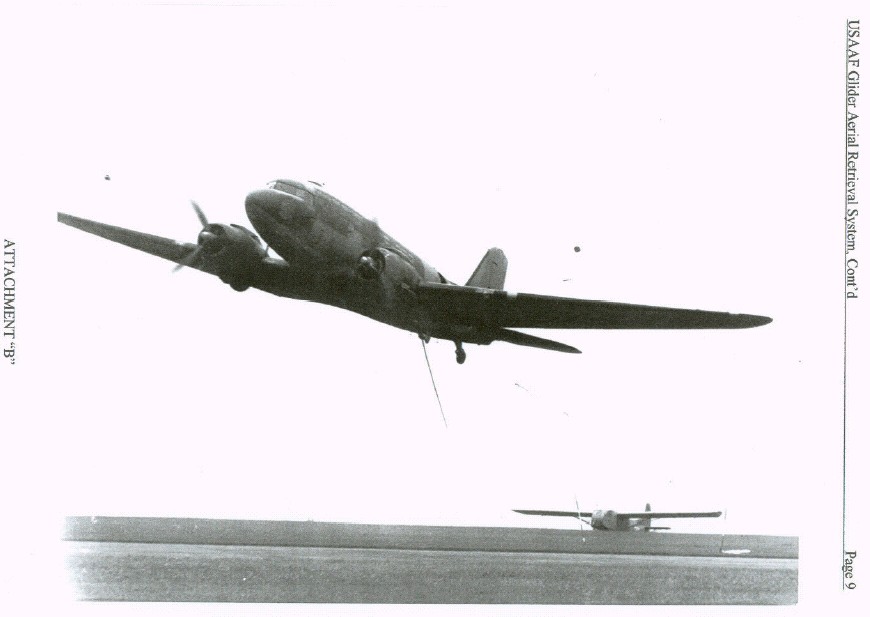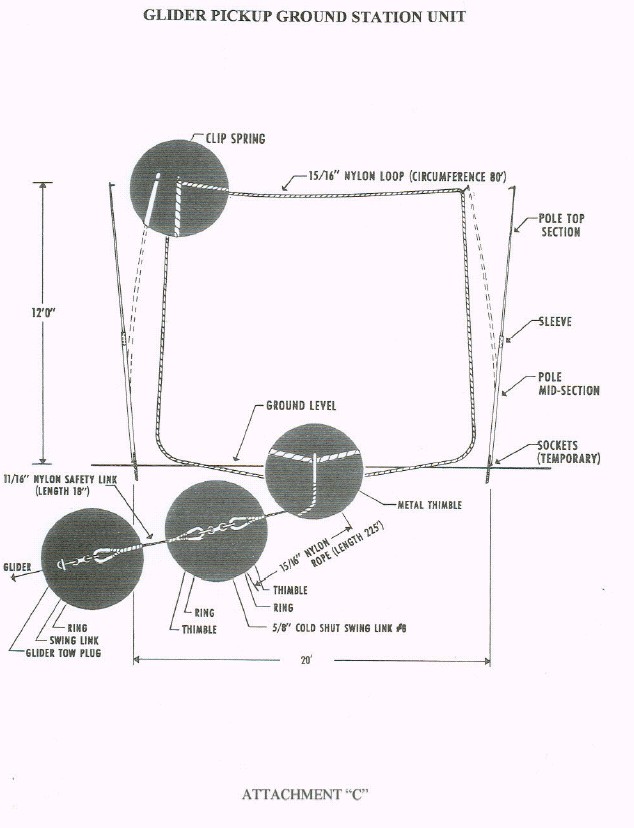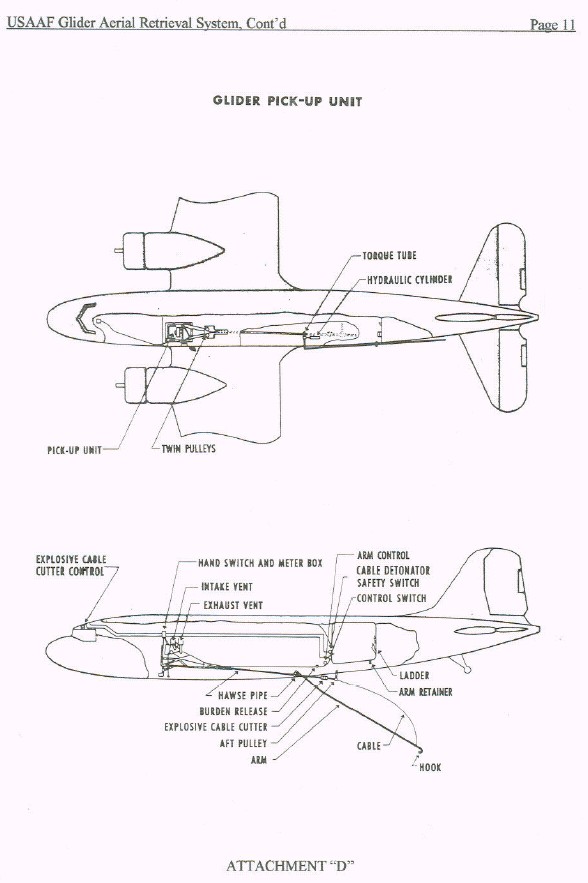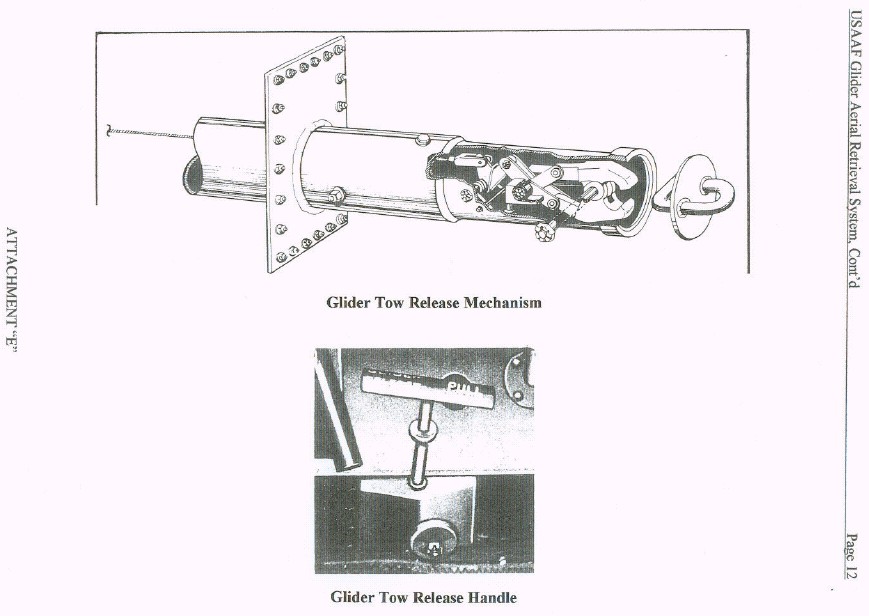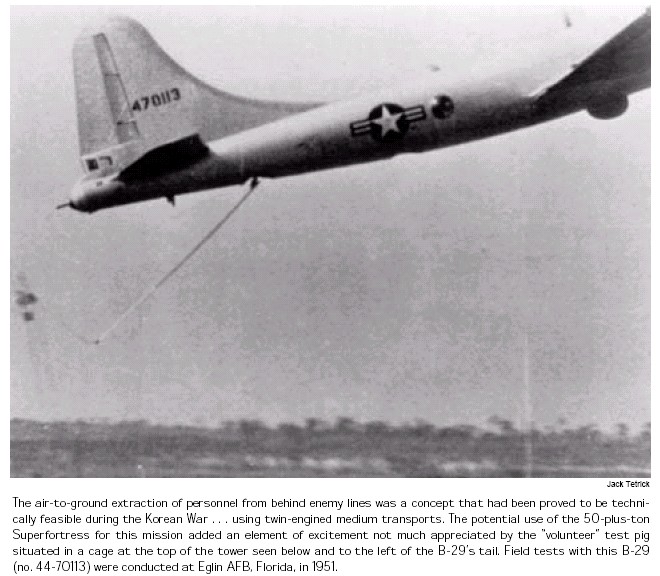ESCAPE-EVASION-RESCUE SYSTEMS ON MILITARY AIRCRAFT
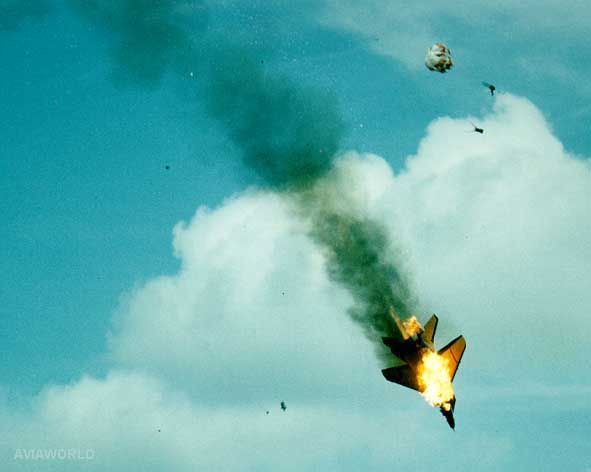

EXCLUSIVE! See the Russian MIG-29 and SU-35 air show ejections:
2002. Chechnya. 2007. Iraq.
The Day of Reckoning has arrived for Slow, Loud, Conventional Helicopters
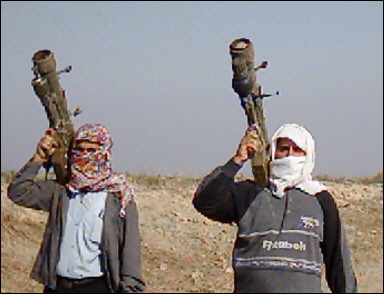
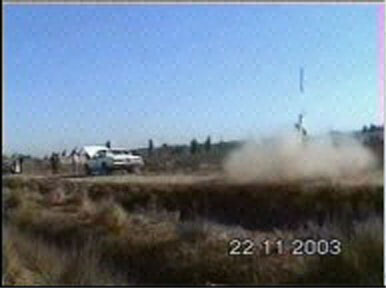
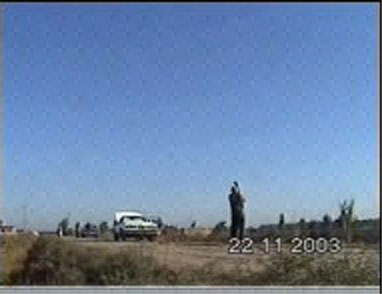
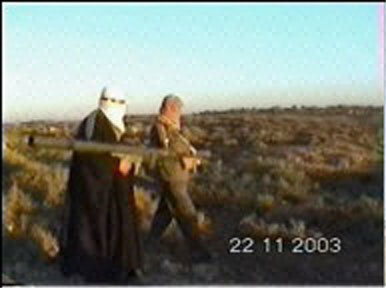
Time to face the music.
Not only are our helicopters too-hard-to-maintain and literally grounded except for dire emergencies in Iraq, they fly too slow and too loud to survive enemy man-portable air defense system (MANPADS) surface-to-air missiles (SAMs) and small arms-fire. Since some of you will not listen or accept this here's two audio/visual "reality checks" from Chechnya as if the recent tragedies over Iraq are not enough:
 SA-7 MANPADS vs. Mi-8(?) Hip helicopter
SA-7 MANPADS vs. Mi-8(?) Hip helicopter
www.combatreform.org/manpadsvsloudpoorcamohelicopter.wmv
 SA-16 MANPADS vs. Mi-26 Halo heavy lift helicopter
SA-16 MANPADS vs. Mi-26 Halo heavy lift helicopter
www.combatreform.org/sa16manpadsshootsdownmi26helicopter.wmv
Next, examine some of our aircraft shoot-downs in Iraq:
New York Daily News
January 23, 2007
Pg. 16Missile May Have Downed Copter
By News Wire Services
WASHINGTON - There is evidence that an Army helicopter was shot down in Iraq by a shoulder-fired missile, a senior military official said yesterday.
Searchers at the scene found a tube that could be part of a shoulder-fired weapon that may have been used to shoot down the aircraft, said the official, who requested anonymity because the investigation was still continuing.
A dozen U.S. Soldiers died when the Black Hawk helicopter crashed Saturday in the province of Diyala north of Baghdad.
Col. David Sutherland, commander of U.S. forces in the Iraqi province of Diyala, has said the crash is still under investigation.
An Al Qaeda-linked coalition of Iraqi Sunni insurgents calling itself the Islamic State in Iraq claimed yesterday that its fighters shot down the helicopter.
The posting's authenticity could not be independently verified, but it appeared on a Web site used as a clearing house for militant statements. The Islamic State in Iraq is believed to be the political wing of Al Qaeda in Iraq.
Also disturbing was the news over the weekend that insurgents were waved through checkpoints and allowed inside a provincial headquarters because they were wearing Iraqi and American uniforms and had American ID cards.
Five Americans died in the subsequent firefight Saturday.
The gunmen arrived in a convoy of seven white GMC Suburbans, a vehicle favored by Americans. After breezing through checkpoints, the force stopped at the police directorate in Karbala and took weapons but gave no reason, said police spokesman Capt. Muthana Ahmed in Babel province.
OBSERVATIONS:
1. Right off the bat, this should end all debate forever on whether we need much faster fixed-wing observation/attack (O/A) aircraft. We do. We need to get off our asses and get some STOL Grasshoppers.
2. Immediately repaint ALL our helicopters in sky-gray to not help enemy gunners to spot and track and aim on them. The first video shows the fatal flaw of dark green helicopters in a blue sky background.
 youtube.com/watch?v=VPGgwBr-OEs
youtube.com/watch?v=VPGgwBr-OEs
3. LISTEN to the audio on the first video. Silence our helicopters with NOTAR. If you lose 15% of anti-torque power get bigger engines. That's too fuking bad if it isn't the "old school" tail rotor crap you are used to. The world doesn't revolve around you, Mr. Army RotorHead. It beats getting shot down and dying, doesn't it? If the two helicopters were in the right camouflage and NOTAR in the first video Mr. Allah Akbar in the bushes may not have even been alerted to go out and fire at them. When LTG James M. Gavin created helicopter air-mobile units in the 1950s, he never intended for us to be forever stuck with them as the only means to have vertical take-off and landing capabilities; he assumed we wouldn't be a bunch of lazy retards sitting on the laurels of those who had gone before us and would have functional fixed-wing V/STOL aircraft by now (not overly-complex, crap V-22 tilt-rotors)
The Army should buy the MD520 Little Bird NOTAR for its 368 x light scout helicopter program not the bullshit loud and slow Bell 407. The made-in-America, (Arizona to be exact--but fucktard Senator John McCain didn't lift a finger to help) MD900 NOTAR should be bought for the Light Utility helicopter (LUH) mission, but hey! The #1 enemy of the U.S. Army is THE U.S. ARMY. That's why they bought crap racketeer Bell 407 LongJetRangers made in Texas where lots of corrupt politicians are to twist the Army's arm and Eurotrash EC-145 tail-rotor copters for the LUH--which later as the UH-72A "Lakota" proved so defective we cannot even fly them if the sun is out! And its been configured as a homeland security flying "pussy wagon" with no armor or armament etc. so as to not threaten the active duty rotorheads and their mega-expensive-to-fly $4, 000/hour UH-60s racket. We couldn't have the "regular" Army flying agile Little Birds superior to the "Special Feces" flyboys of the 160th Special Operations Aviation Regiment....it would make too much economic sense to have more of the same type of helos to save $ for the taxpayers on parts....and this would make the "unwashed", "Conventional" Army helo pilots a "high speed" look and demeanor only reserved for our snobs in the 160th SOAR...we cannot bust up our snob racket just for...COMBAT EFFECTIVENESS...and ECONOMIC FRUGALITY....hell no!
 2008 UPDATE: Piece-of-Crap Bell 407 ARHs cancelled!
2008 UPDATE: Piece-of-Crap Bell 407 ARHs cancelled!
http://en.wikipedia.org/wiki/Bell_ARH-70
On 16 October 2008, the Army's Acquisition Executive Office for Aviation directed that the ARH contract be terminated completely for the convenience of the government.[15] The cancellation was the result of the United States Department of Defense (DOD) not certifying the US$6.2 billion ARH-70 program to Congress. John Young, the Undersecretary of Defense for Acquisition, Technology and Logistics, cited the reason as excessive costs of the program which had increased over 70 percent with an estimated per-unit cost of US$14.5 million, up from US$8.5 million.[16]
Maybe now we will buy the NOTAR LittleBirds with ground mobility we need?
4. Immediately supply EVERYONE on board every fuking U.S. military aircraft bail-out parachutes EVERY TIME THEY FLY. In both video shoot-downs there was plenty of time and altitude to bail-out and survive the MANPADS strikes. Details:
Why No escape from U.S. Military Aircraft?
5. Develop at least for small A/MH-6 and OH-58D observation/attack scout helicopters a tail boom (or rotor mast) Recovery Parachute (RP) to bring them safely down with their nose covered with a small air bag touching first to push over the rest of the fuselage into an upright position.
6. Every jet at the very least should have a brake/spin recovery parachute that also lessens post ejection crash destruction (witness the recent Miramar NAS tragedy when a dumb marine pilot ejected and his crap F-18 StuporHornet crashed and burned-to-death an entire family in the house it hit; develop RPs to recover them and floats for naval aircraft recovery
7. Immediately start converting our helicopters to Piasecki VTDP/wings so they fly faster at 250 mph to be less vulnerable. This will take some time but there's no excuse why steps 1-5 cannot be taken TODAY.
AIRCRAFT ARE GOING TO CRASH AGAINST THE EARTH AND BE SHOT-DOWN BY HUMANS: STOP DENYING IT AND START PLANNING TO OVERCOME IT
One of the ironies of flying sophisticated aircraft which by their very nature requires intelligence is that aviators tend to be narcissistic/arrogant and deny the fact that THEIR aircraft could get shot down or crash. Even the great Brigadier General "Chuck" Yeager got shot down in WWII and had to BAIL-OUT (parachute) then escape & evade ON FOOT back to friendly lines. Later on, the great Yeager had to eject then parachute from his NF-104 Starfighter with a R-2 rocket engine in the tail when he pushed it to the edge of space (110,000 feet+) and beyond its flight "envelope" to try to beat the Russian record while at the Test Pilots School at Edwards AFB.
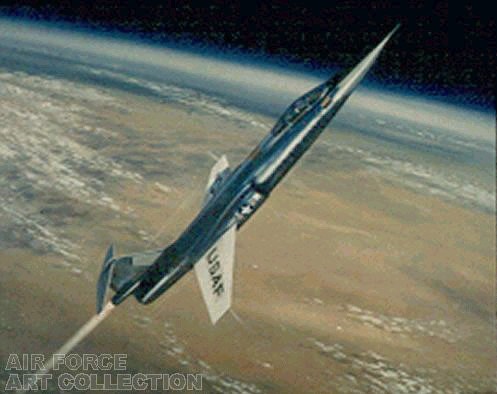
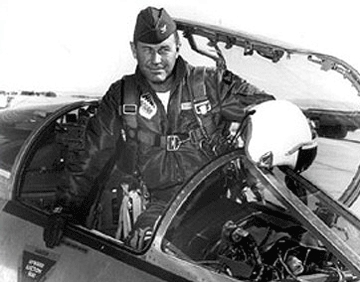
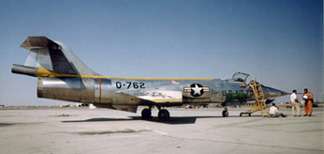
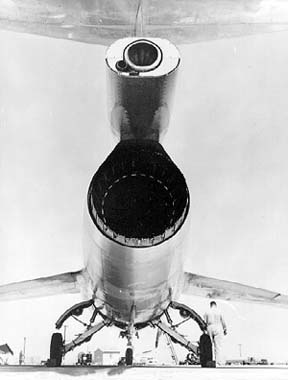
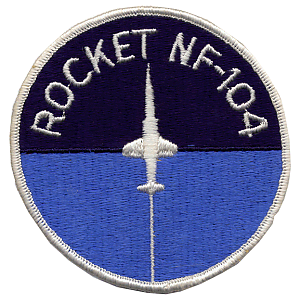
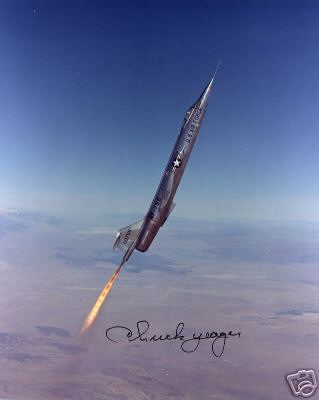
No one can say he didn't have the "right stuff"? Getting shot down or crashing may be caused by things having NOTHING TO DO WITH PILOT SKILL.
The worse form of this "see no evil" pilot narcissism monkey business is the airline industry which builds planes that are not crash-worthy and the light airplane industry that doesn't have parachute recovery systems as standard equipment. Thus, we have THOUSANDS of people dying in civilian plane crashes who would instead be alive had the "aircraft industry" been more human and less greedy $$$.
In an even uglier form is in the U.S. military where we KNOW planes are going to be shot at, (some will crash) we fly on the edge of the "envelope" daily yet we provide no escape systems for our helicopter pilots/crew and nothing for passengers onboard USAF airlifters. In WW2 and years thereafter we were not like this. Being smug and stupid was something we learned how to do over time. We can replace planes; people we cannot. It is high time we solve this NOW.
Aircrew are our most valuable asset: they cost us millions of dollars to train. While aircraft can be replaced, they cannot. Its time we created a well thought-out, in depth system to recover them and their passengers from aircraft crashes and shoot-downs THAT ARE GOING TO HAPPEN.
We are now going to look at the problem of military aircraft ESCAPE, EVASION and RESCUE.
ESCAPE
BAIL-OUT PARACHUTES FOR PEOPLE ONBOARD U.S. ARMY and USAF AIRCRAFT, IS THIS ASKING TOO MUCH? It wasn't in the past; has physical reality changed since then or just we have less brain cells available today?
Stupid Americans: WW2 Tragedy
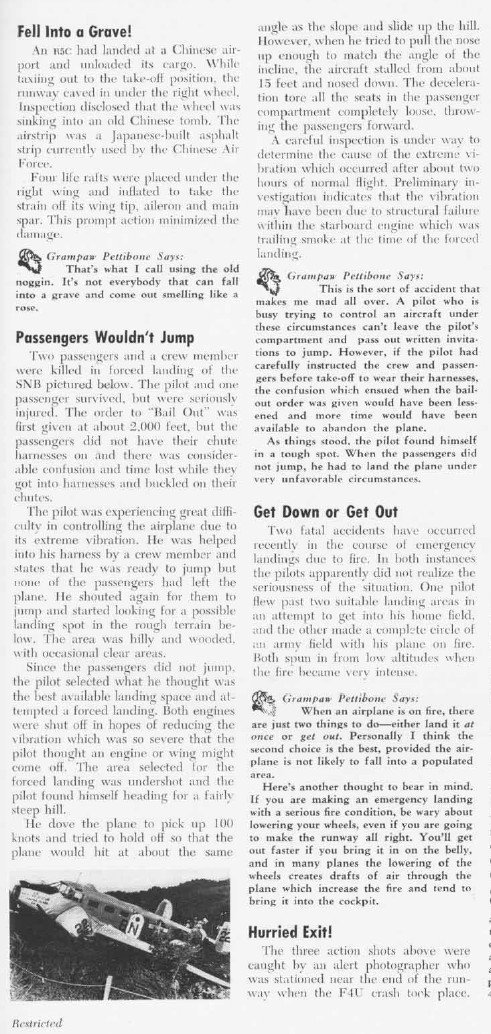
Stupid marines: Vietnam Tragedy
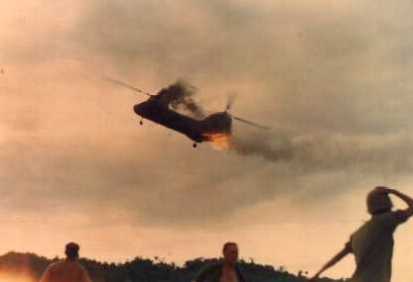
Army/Mc bail-out capability?
A CH-46 hit by enemy fire with marines inside burning a few seconds before crashing and exploding in flames during the Vietnam War. Why weren't the aircrew wearing bail-out parachutes to jump and live? How about the embarked troops?
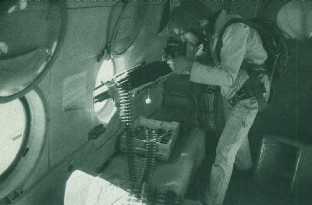
Smart Russians: Afghanistan Tragedy Averted
The action, which was lead to Captain Valeriy Popkov becoming a hero [of the Soviet Union--equivalent to the U.S. Congressional Medal of Honor] occurred just a few days before the final withdrawal. Flying a "Hip" as wingman to Captain Ilgiz Sharipov on a reconnaissance mission, Popkov followed his leader through a solid layer of cloud and headed out over the mountains. Soviet helicopter pilots liked to fly above cloud because they were then safe from Mujaheddin missiles. Thirty minutes later the pair let down through the overcast, located the rebels after a while and radioed the information back to their command post.--From Helicopters in combat: the first 50 years by John Everett-HeathTheir duty done they headed up for home. A break in the cloud appeared and it was then, suddenly, that Popkov saw to his horror Sharipov's helicopter burst into flames, stall and then fall steeply. Suspecting that the "Hip" had been hit by a missile, but disregarding the fact that his own helicopter might shortly become a victim, Popkov started a steep spiraling descent to keep Sharipov's "Hip" in sight. He called his command post to report what was happening.
Popkov's crew saw three figures parachute from the burning helicopter but was unable to see where they landed. As Popkov headed on downwards, he suddenly noticed a bright orange canopy with a man standing by it. He also saw some Mujaheddin running towards the spot firing their weapons. Popkov turned his "Hip" towards them and launched a few rockets while his crew chief fired a machine-gun through an open side window.
Landing near the parachute, and some 300 metres down slope from the burning "Hip", Popkov could see that the survivor was Sharipov. Everybody was ordered out to get him aboard and find the remaining members of his crew. At that moment Popkov's helicopter was hit and a smell of fuel pervaded the "Hip". Nevertheless, Sharipov was bundled aboard as the crew chief and two others engaged the approaching Mjuaheddin with their rifles."
Stupid marine gene reproduces: Iraq Tragedy; another USMC CH-46 goes down in flames whose people inside could have parachute-jumped to Safety
How about having less people in each chopper and those that are inside wearing bail-out parachutes so if they get a missile warning they can bail out before being blown up?
WHY were these poor USMC people on board the CH-46 not wearing parachutes so they could bail-out? They appear to be at least at 1, 000 feet at 100 mph which would give them plenty of air flow and height for their parachutes to open.
The Russians wore parachutes in their helicopters over Afghanistan. (We are flying over Afghanistan today, so where the fuck are our parachutes? Yes I said "fuck" because I'm fucking angry at this stupid American triumphalism, problem-denial crap. Sometimes...as Angelina Jolie's character learns in the movie "The Changeling" that's exactly what needs to be said--)
Are they not the "god-less communists" who are supposed to not give-a-crap about individual people? How come they are showing more Christian values in their TANGIBLE ACTIONS than we are in the allegedly Judeo-Christian western military establishments?
Again, typical U.S. military live-in-denial and make believe there is no problem as the article at the end shows they are even denying the marine CH-46 was shot down!
msnbc.msn.com/id/17071631/
Insurgent video claims to show copter downing Smoking object appears to hit Sea Knight in Iraq; flames
BEFORE
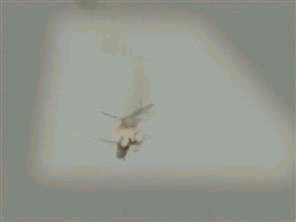
AFTER
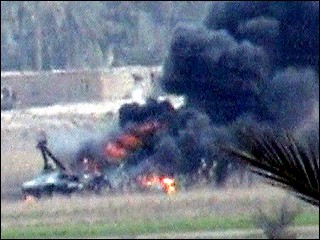
Updated: 7:55 p.m. ET Feb 9, 2007
BAGHDAD, Iraq - An insurgent group linked to al-Qaida posted a Web video Friday showing what it said was the downing of a U.S. military helicopter this week. Seven Americans [marines] were killed in the crash. The U.S. military has said it did not believe the CH-46 Sea Knight helicopter was shot down in the crash Wednesday northwest of Baghdad.
But a U.S. official, who was not authorized to address the topic publicly and spoke on condition of anonymity, said "the video appears to be legitimate" - meaning that it shows a Sea Knight crashing.
The two-minute video - which says it shows the "downing of U.S. aircraft on Feb. 7" - shows a helicopter that appears to be a Sea Knight flying. An object trailing smoke is seen in the sky nearby, and then the craft bursts into orange and red flames, with a spray of debris emerging from it. It is not clear whether the object is a rocket, and it cannot be clearly seen connecting with the craft. In the footage, the helicopter heads downward, but appears to be at least partially in control, though smoke and bright flames are trailing from it. The helicopter then disappears behind a line of trees as it hits the ground.
The video was issued by the Islamic State in Iraq, an umbrella group of Iraqi insurgent groups that includes al-Qaida in Iraq. The group on Wednesday issued a written claim of responsibility for the craft's downing and had promised a video would follow.
The video, titled "the Hell of Christians and Apostates in Iraq," was posted on a Web forum where the group and other Islamic militants often post messages.
The Islamic State in Iraq has also claimed responsibility for downing two other U.S. helicopters - a BlackHawk which crashed northeast of Baghdad on Jan. 20, killing 12 Americans, and an Apache shot down Feb. 12, in which two U.S. Soldiers died.
At least six U.S. helicopters have crashed or been forced down under hostile fire since Jan. 20. In the wake of the recent crashes, U.S. officials have said they were reviewing flight operations and tactics but maintain there is no evidence of sophisticated new weapons used in any of the latest attacks.
The authenticity of Friday's claim could not be independently confirmed.
U.S. Lt. Gen. Douglas Lute, chief operations officer for the Joint Staff, suggested the claim may not be authentic.
"This enemy is very astute in the use of the media. He has in the past had a pattern of posting things on the Web sites and claiming responsibility for attacks that did or did not occur," Lute said at a Pentagon news conference. "I'd be very cautious about drawing conclusions from things that are posted on the Internet."
As to what caused the crash, Lute said "there are some eyewitness accounts that cause professional aviation officers to believe it was most likely ... mechanical."
What a lying fucktard. The CH-46 was brought down by a SAM. Nice bit of creating wiggle room to avoid reality and reforms by shit-canning the internet's reality checks so the status quo BS can continue unabated. We don't buy it, General Lute. Fuck you and the horse you rode in on. Get off your high horse and start SOLVING PROBLEMS instead of making excuses and denying them.
U.S. Military aircraft bail outs, anyone?
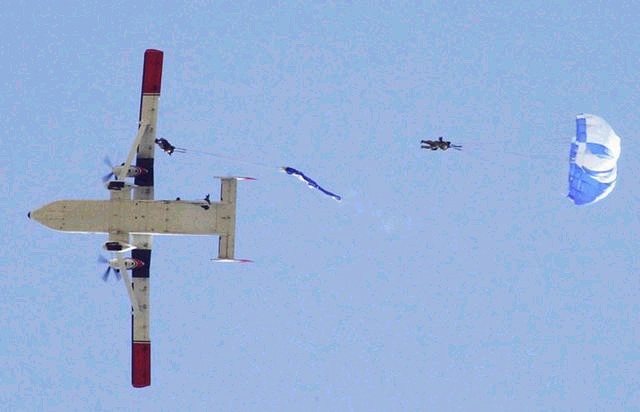
Men who wouldn't be Alive Today if Current USAF Policy of No Bail-Out Chutes Had Been in Effect Then (Think About It)
Smart Americans Can Jump
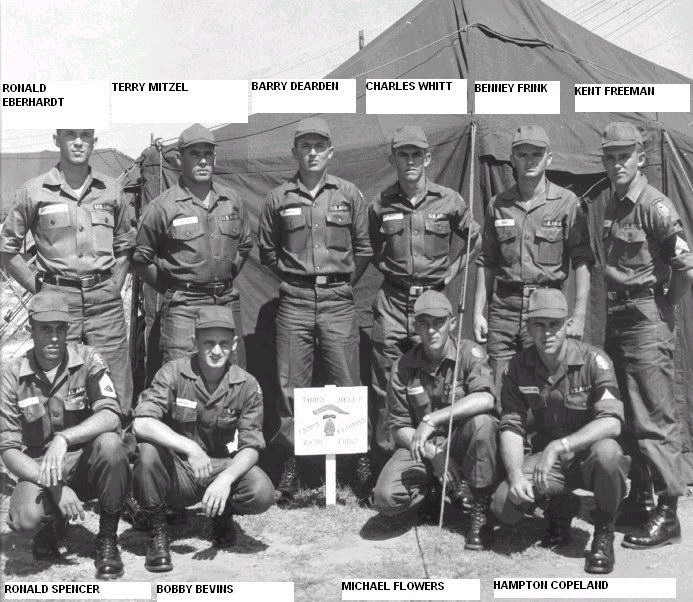
From c119crash.com:
Upcoming 2008 SFGA Party is Saturday February 23, 2008. The location is at Barry Dearden's which is located at: 15125 Carlton lake Road Wimauma, Fl 33598 ---- GPS coordinates are: N 27 45 09 84 W 082 14 4287 Barry's phone # is 813-634-6356.On July 16,1966 a C-119 departed Jacksonville Naval Air Station @ approximately 8:45 PM. On board were members of 20th SFGA, 10 recruits from Tampa, 20 troops from Miami and 4 crew members. Approximately 15 minutes into the flight at an altitude of 7,000 feet The left engine developed mechanical problems and was engulfed in flames. The plane started descending as the pilot fought for control and activated the extinguisher on the engine. At approximately 4,500 feet the pilot rang 2 bells to prepare for a crash landing. At about 3,000 ft the engine became engulfed in flames again he rang 3 bells to bail out. Once the doors were open in the rear all 34 persons became members of the Caterpillar Club by jumping with emergency parachutes. All 34 survived and only a few had minor injuries. The 10 recruits from Tampa all went on to Basic training, Special Forces Training and jump school where they all completed there training in 1966-1967 @ Ft. Bragg, N.C. and Ft. Benning, Ga.
Thanks to the crew of the Aircraft from the 357th Troop Carrier Squadron and especially to Major Robert C. Coyle for his professionalism and pilot skills during this emergency situation. Without him we would have all died that night. Also thanks to his crew: Capt. Charles B. Dowling, MSGT John A. Sandlin, A2C John B. Schlotman. Also to Colonel Gray for his cool headness in a very tense situation where he stood tall and led his men to safety.
Military parachuting experts like Manley Butler and Ted Strong know how to do this even better today. How many more men have to die needlessly?
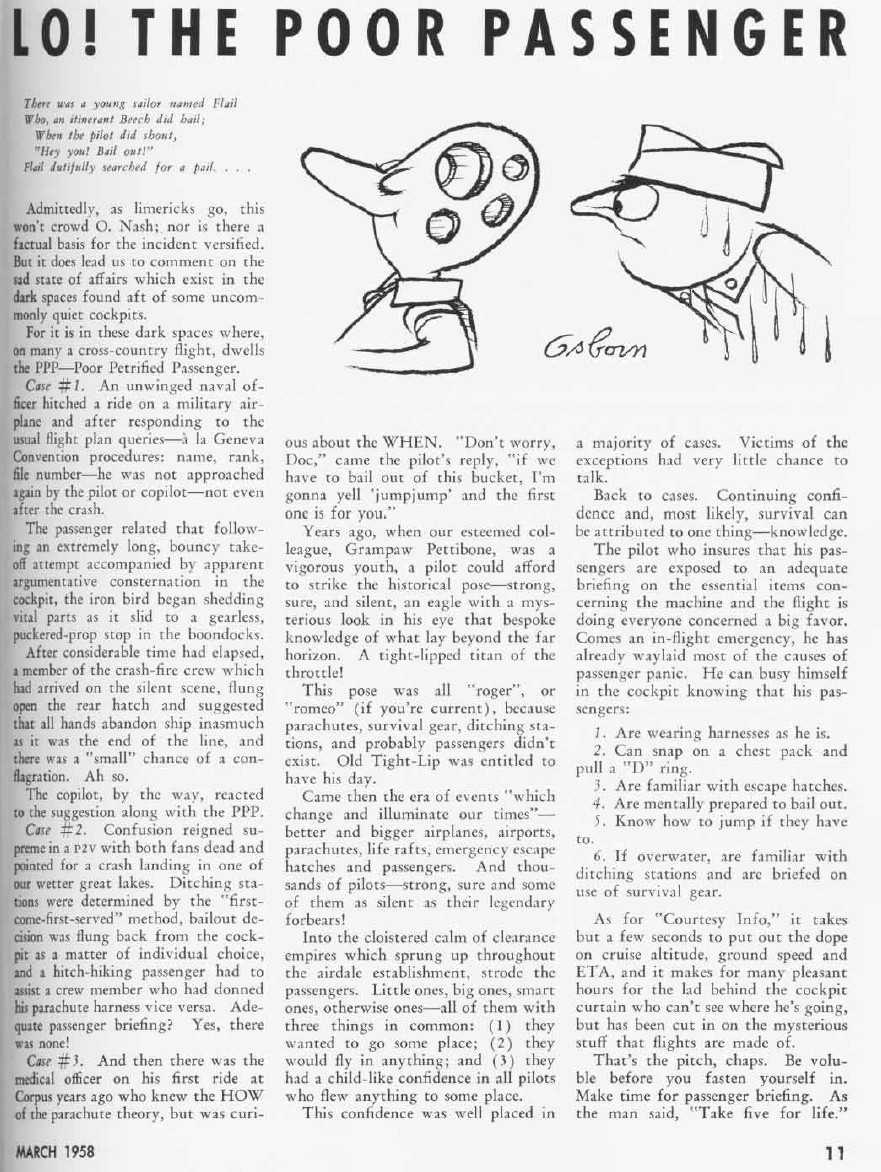
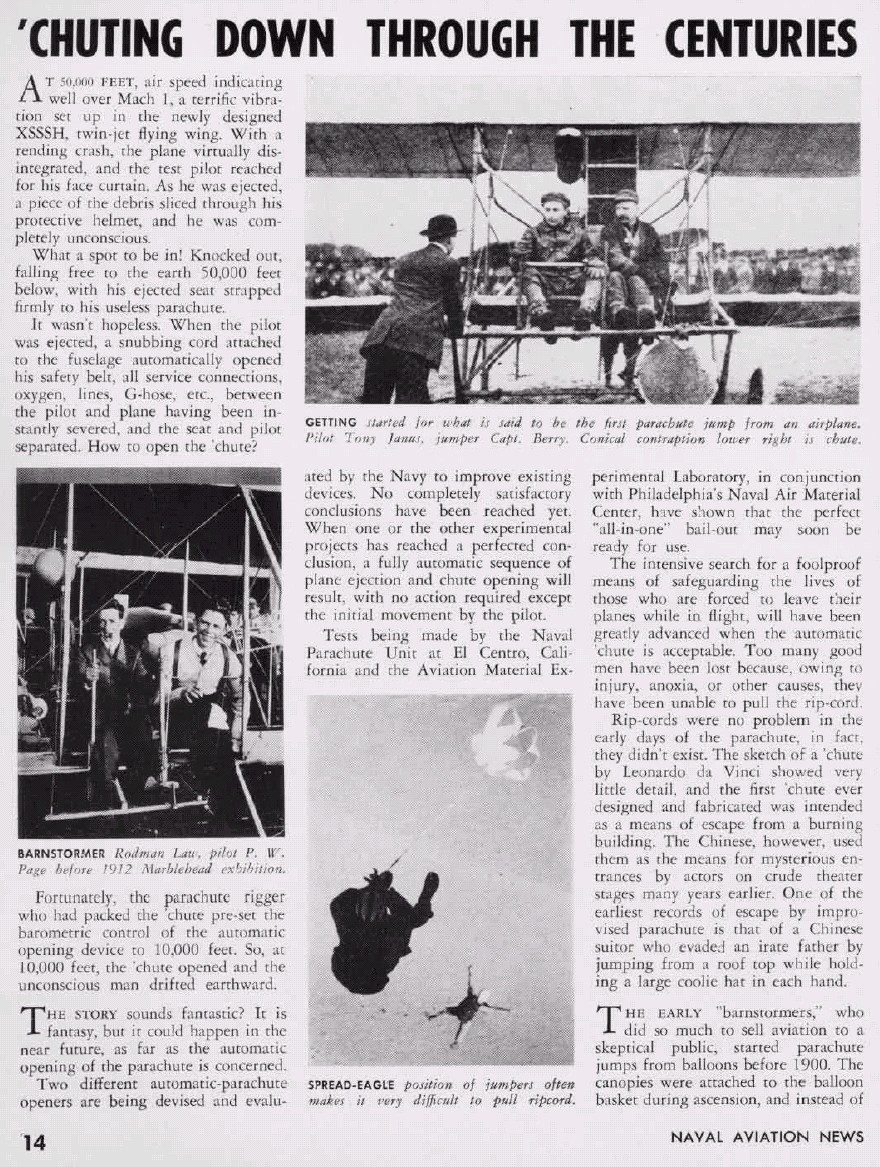
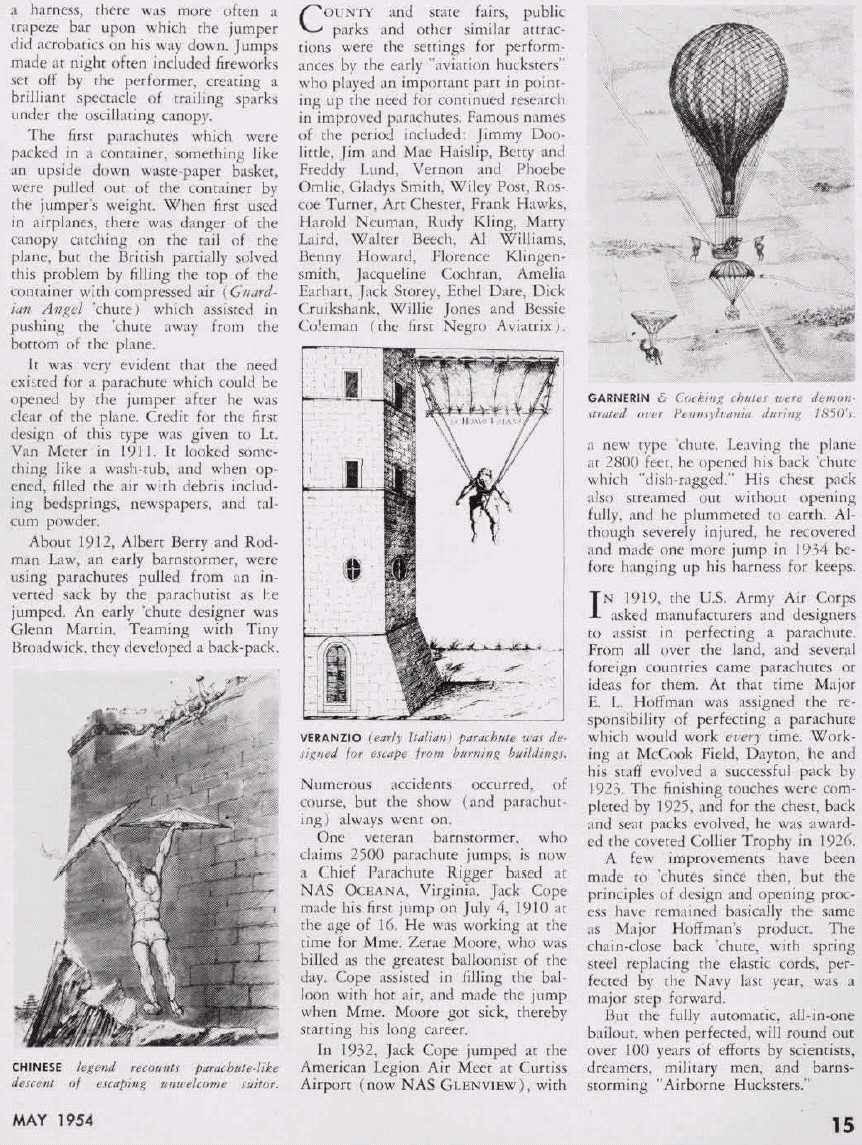
One of the amusing things to see in the film, Air Force One is there being ram-air parachutes (RAPs) in large quantities onboard for people to bail out in event of a crippled aircraft. While the RAP is not a good choice since it requires Military Free Fall (MFF) skills to use safely, the idea of a simpler, round canopy bail-out parachute is a good one. This is a common sense thing the American public thinks the AF actually does today like it used to in the past when it had common sense. The truth is if you are a military passenger or Soldier on a USAF or Navy or Army or marine transport and it goes down, you and everyone onboard go down with it in flames. The picture above shows a C-23 Sherpa with jumpers successfully exiting, yet a few years ago a National Guard C-23 went down in flames over Georgia killing everyone onboard needlessly when they had plenty of time and altitude to bail-out once the plane started having serious mechanical troubles. This is one time where life needs to "imitate" wiser "art" and the AF should develope a simple to don, bail-out (round canopy) parachute with rip cord that would be under the seats or in the seats when you sit down and strap-in, in the quantity of every seat belt position offered of every one of its transport aircraft to save lives--especially when flying into a combat zone. Butler Parachutes Inc made a very compact bail-out parachute for Dick Rutan-Jeanna Yaeger's record-breaking around the world without refueling flight that can be worn by aircrew without it even being noticed its there. We need another option other than going-down-with-the-aircraft, fatalism.
Fuck Fatalism
google.com/search?hl=en&defl=en&q=define:fatalism&sa=X&oi=glossary_definition&ct=title
Definitions of fatalism on the Web:
* a submissive mental attitude resulting from acceptance of the doctrine that everything that happens is predetermined and inevitable *
* a philosophical doctrine holding that all events are predetermined in advance for all time and human beings are powerless to change them *
wordnet.princeton.edu/perl/webwn *
* Fatalism is a philosophical doctrine emphasizing the subjugation of all events or actions to fate or inevitable predetermination. *
en.wikipedia.org/wiki/Fatalism *
* fate, fatality, the doctrine that all events are subject to fate or inevitable necessity, or determined in advance in such a way that human beings cannot change them *
en.wiktionary.org/wiki/fatalism *
* a belief or attitude that one is powerless to change something. *
inspection.gc.ca/english/corpaffr/publications/riscomm/riscomm_appe.shtml *
* the doctrine that no choice or act of the individual can affect the fate to which he is destined. *
willdurant.com/glossary.htm *
* The doctrine that all events are predetermined by fate and are therefore unalterable. *
strongatheism.net/intro/lexicon/
Operation Varsity was a good example--23 fire-prone C-46 Commandos were hit by enemy fire, but every single Paratrooper was able to jump out to safety and perform his combat mission on the ground below.
Post-WW2 Common Sense Saves Lives: Compare the we-want-to-live strength and vigor of the can-do WW2 generation:
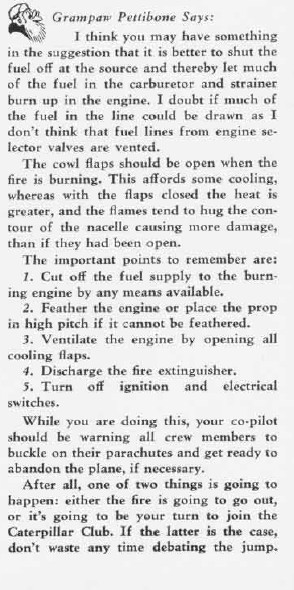

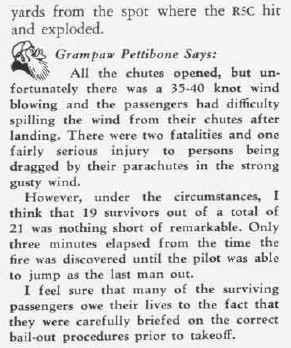

Notice that military PASSENGERS were given bail-out parachutes and expected to use them if needed. They were needed and lives were saved. None of this non-chalance crap.
Now contrast to today's pussified, worried-about-who-is-looking-high-speed, vain, live-in-denial, everyone-mediocre can't-do, fatalistic U.S. military:
Get on any military plane today (2008-and on) and if it catches on fire, the SOP is to SHUT-THE-FUCK-UP (STFU) AND GO DOWN IN FLAMES AND LEAVE WHEN WE TELL YOU! (yeah, right).
P.S. if anyone tries to be a smart ass on the bail-out incident from 1952 that two people died to try to overthrow the greater truth that 19 people were saved out of 21, WAKE-THE-FUCK-UP (WTFU). We did not get Capewell canopy releases (Army term) until 1960...a lot of Paratroopers died by wind dragging until then, so DON'T BLAME BAILING OUT for a problem on-the-ground created by hard-to-release snap-hooks. Now that we have canopy releases there should be no one dying from wind dragging from ANY kind of on to land parachuting. And--if the two bailer-outers from 1952 that died out of the 19 who were saved had had Capewell canopy releases they would likely have used them and lived.
The Russians in Afghanistan wore parachutes, saving HUNDREDS of lives. Had it been the U.S. Army or marines fighting from helicopters these would be dead going down with their flaming helicopters. Why are we "anti-parachute" in helicopter and transport aviation circles in the U.S. military? Do we have a death wish? Or is it that parachutes are associated with the rival Airborne snob club so we cannot use them lest we be like them? You never can tell with the weaklings who populate today's U.S. military what stupid fucking reasons (I use that term lightly) and idiotic mentalities are driving them.
The so-called don't-care-about-human-life Russians beat us again when it comes to mechanical advantage things....they design crew escape/recovery into their aircraft; we do not. They are realistic, we are not. They save lives, we lose lives. And we wonder why Army and Naval Aviation is in a decline?
The Mi-28 Havoc is their AH-64 Apache helicopter gunship "clone".....
Jane's reports:
"Crew doors are rearward hinged, to open quickly and remain open in emergency; parachutes are mandatory for CIS military helicopter aircrew; if Mi-28 crew had to parachute, emergency system would jettison doors, blast away stub wings, and inflate bladder beneath each door sill; as crew jumped, they would bounce off bladders and clear main landing gear; port-side door, aft of wing, provides access to avionics compartment large enough to permit combat rescue of two or three persons on ground"
What does this mean?
1. They can parachute bail out, they don't have to go down with their aircraft like we do in the U.S....
2. Those that bail out can be IMMEDIATELY picked up by whichever Mi-28 gunship is around the area--instead of waiting for dedicated C/SAR forces to transit, arrive, find the downed aircrew and hope he's not being used as "bait" for an ambush of the rescuers. Immediate suppression/destruction of the threat that shoots down a crew followed by immediate recovery would be better than waiting for C/SAR.
If the enemy ground force is too much to be handled by the attack helicopters, then Air-Mech-Strike rescue forces should be parachute or HH-47 Chinook inserted and move by light tracked, armored "Mini-Gavins" on the ground 2D axis, recover the downed aircrews; secure a PZ and then fly them out.
BAILING OUT IS NOT A GIVEN: TRAINER AIRCRAFT EJECTION SEATS?
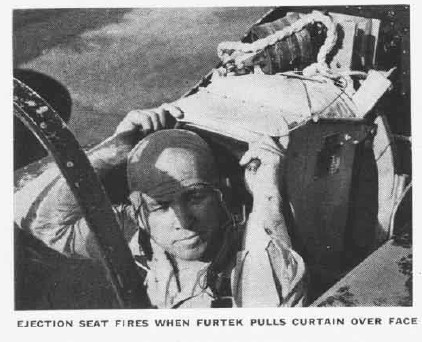
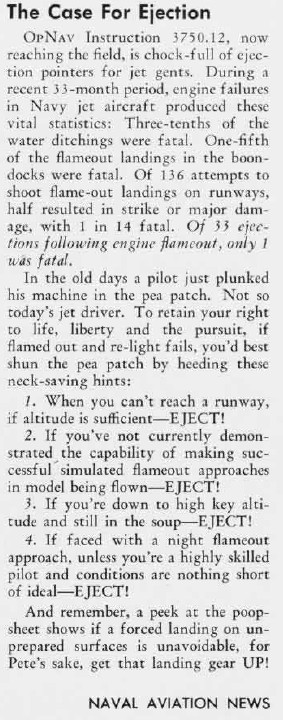
Military Plane Crash Kills TwoMIAMI (Reuters) - The U.S. Navy says a small U.S. military training plane crashed, killing its crew of two, after colliding with a similar plane over the Florida Keys yesterday. The two T-34C Turbo Mentor aircraft, from Whiting Field in the Florida panhandle, were on a cross-country training run when they collided in midair near Marathon, Florida, a town about midway between the Florida mainland and Key West. Witnesses say one plane spiraled into shallow water about 100 yards off Tavernier island. One of the crew members, a woman, tried to jump from the aircraft but became entangled in a parachute. The other plane made an emergency landing at an airport near Miami.
 youtube.com/watch?v=NtB-XKFxEJY
youtube.com/watch?v=NtB-XKFxEJY
Bail-out from a bubble canopy aircraft is possible as the F-4U video above shows, but clearing the tail is a problem even if you can overcome G forces and of course the canopy may not open...


The T-34 should have lightweight ejection seats as a high performance aircraft capable of aerobatics and speeds in excess of 250 mph that could generate enough G forces that the two people inside could not get rid of their canopy and get clear of the tail to pull the ripcord of their parachutes and descend to the ground safely. We have known about and struggled with this problem for many years. The higher the aircraft's performance extremes of speed/height, the greater the need for more drastic escape mechanisms. The problem of the canopy not going away led to ejection seats that punch their way through.
WHEN EJECTION SEATS DON'T WORK: RIGHT THE PLANE WITH A TAIL CHUTE
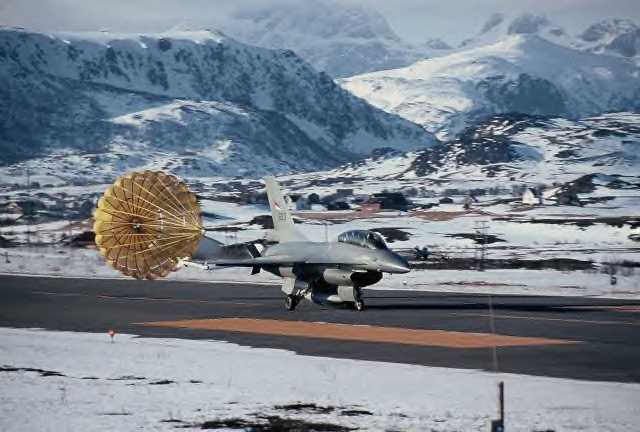
We just got done re-reading an old tragic report (see below) of two people dying in a T-2 Buckeye jet trainer spin where the IP didn't have his lap belt tight so in zero-G his head slammed against the cockpit so unable to reach either top or bottom eject handles and the chick student pilot wasn't trained to turn a lever before pulling her ejection seat handles, by the time they punched out they were upside down and too low.
It occurs to us that had their jet had a brake parachute it could have at the very least yanked them out of the spin for a safe ejection. If we can't get a Recovery Parachute to bring the whole plane down, at the very least ALL jets should have brake/spin recovery chutes. After the crew ejects, the brake/spin chute should deploy to lessen the severity of the crash from 500+ mph pancaking into a row of houses to a vertical descent at 200 mph that people on the ground would have time to get away from.
A side benefit is shorter landings and help if the brakes fail.
By Matthew Brelis, Globe Staff, 11/09/97After spending 14 weeks trying to determine the cause of the crash of a T-2C Buckeye training jet that killed a Navy flight instructor and his [female] student aviator, U.S. marine Captain Paul E. Bowen came to a frightening conclusion: Many Navy and marine jet fighter flight instructors were unqualified for their jobs and in over their heads.
But the commanders who received Bowen's investigation of the 1992 crash that killed flight instructor Lieutenant Commander Gene D. Murrell, 46, and his student, Terri L. Wolthers, 28, quashed the report, the Globe has learned. The investigation was then ordered redone. [Cool! maybe the Cable-car massacre MC Colonel was there for that one!]
The new report, finished in less than three weeks, came to vastly different conclusions: There was no suggestion that Murrell or other jet instructors might be unqualified. And in approving the second report, officers up the chain of command blamed Wolthers for not ejecting from the aircraft sooner.
How the Navy handled the investigation into the obscure July 22, 1992, accident in a Mississippi forest is a startling example of the conflict of interest that is built into its method for probing fatal aviation accidents involving the Navy and marines. The commanders that "own" the plane that crashed also appoint the investigators. Because of that, they can control the direction and outcome of the investigation.
A Navy spokesman said the judge advocate general's office in Washington never received Bowen's report so it cannot comment on the conclusions he reached. Commander Brett B. Bernier, who conducted the second investigation, is no longer in the Navy and refused to comment. The squadron commanders who assigned the probe to Bernier have also left the Navy and could not be reached.
In a series of articles in June, the Globe reported that safety in the military is under-funded, investigations in the other service branches are compromised by the same conflict of interest that Bowen encountered, and that safety recommendations resulting from accidents in each of the services are frequently ignored. A computer-assisted analysis by the Globe of military records found that since late 1979, more than 2,100 service members died in aviation accidents that destroyed airplanes worth more than $20 billion.
After the articles, Defense Secretary William S. Cohen ordered the Defense Department inspector general to conduct a sweeping review of training and safety in the military.
The rewriting of his report to the judge advocate general has left Bowen, who retired from active duty in November 1992 after he submitted his report, and the Wolthers family believing the Navy covered up embarrassing truths and, in the process, kept other student aviators at risk.
"Terri chose a career fraught with risks, but I had always thought those risks would be minimized by those in charge," said the student pilot's mother, Mickey Wolthers, who has read Bowen's report.
"I had no reason to believe that the Navy would cover up the incident, but I don't feel that way anymore," she said. "They left out important findings and attempted to blame the accident on Terri; that is not OK. They disregarded their own orders; that is not OK. They put an instructor in the plane not trained to Navy standards, and that is not OK."
[ED: typical narcissism; blame it on the dead guy, ehh gal who was a "pussy" oops, I mean a wimp; a bad pilot...thsat's the source of all problems, BLAME AND DESTROY THE INDIVIDUAL!!!! THE SYSTEM IS ALWAYS RIGHT!!! NOTHING EVER HAPPENS SYSTEMICALLY!]
Bowen was more blunt, saying, "I don't know how some officers can sleep at night."
[ED: Easy. They are likely members of the 25% of all human beings who have no conscience whatsoever]
Bowen's report concluded Murrell, the flight instructor, did not belong in a jet aircraft because he had not undergone the training Navy regulations require when pilots switch from propeller aircraft to jets.
As a result, Murrell, who felt uncomfortable doing the high performance flying required in jet training, tried to compensate by studying the instruction manual for the Buckeye. That strategy, Bowen found, left Murrell "perpetually `inexperienced' while an instructor pilot in the Intermediate Strike [jet fighter] Program."
Bowen wrote that putting pilots with helicopter or maritime experience in the fighter jet curriculum, "is to match `inexperienced aviators' with `inexperienced student Naval aviators.' The operational environment is unforgiving when out of control flight or other emergency situations develop."
Navy spokesman Lieutenant Patrick Moore said 57 percent of the current T-2 Buckeye instructor pilots did not come up through the ranks as jet fighter pilots. However, he said, under Navy regulations, they receive 41 weeks of jet training before becoming instructors.
Murrell had only 11 weeks of training.
Bowen's report stated that the practice of having non-jet pilots be jet instructors should be stopped. The second investigation made no such recommendation. [EDITOR: Fuck you, Bowen you marine jetsnob. The problem is solved by insuring instructors get the required jet experience whether from their past or more recent training]
"I found out in January of 1993 that they were re-doing the report," Bowen said. "I got a copy of Bernier's report in July. When I read it, I should not have been surprised, but I was outraged. When the Navy chief of training faulted the student, I found that to be extravagant. That is like me saying the mishap was due to Murrell's misconduct. It just shows how completely insensitive Navy leadership is to this."
Had the Navy handled Bowen's report normally, it would have been sent up the chain-of-command for approval and criticism. Superior officers would have been required to respond to Bowen's charges and say why they had allowed someone who was not fully prepared to become a jet pilot. The report might have caused the Navy to delve into the underlying causes of the crash, making systemic changes where needed and disciplining the commanders who were responsible.
Trained on cargo flights
Murrell was a skilled, careful pilot who came up through the propeller-driven maritime ranks. At the time of his death, he had accumulated more than 4,200 hours of Navy flight time since he began flying in 1968. During his career, largely spent delivering cargo, Murrell had a distinguished record of more than 400 carrier landings. He never had had an accident, nor was he cited for a flight violation.
Bowen was unable to say in his report, or in a series of recent interviews at his home in Southern California, who was responsible for allowing Murrell to start flying jets without the training that is required under Navy regulations.
What is clear is that Murrell "bypassed all the checks and balances in the system," Bowen said. There were two chances for Murrell to get experience in the T-2C and in both cases he did not. As a result, his commanders never learned of Murrell's aversion to high performance jet flight, and he was not trained to master the Buckeye's problem-ridden ejection system.
Had Murrell received the normal amount of jet instruction, he would have had about 90 hours in the T-2C Buckeye and 100 hours in another type of jet trainer. In an interview, Bowen said that such training would either have exposed Murrell's weaknesses or given him the experience learned from aviators who had spent their careers in jet fighters.
After getting 550 hours in a jet air transport from 1989 to 1991, Murrell went to the Naval Air Station in Beeville, Texas, in August 1991 with the assignment as a jet flight instructor. It was a disappointment to him, as he had been hoping he would be stationed at Pensacola, where his wife and two children lived, to fly cargo flights.
[ED: why the hell did Navy personnel (Bupers) send him to train others in jets? Stop trying to fill round holes with square pegs! Stop treating people like interchangeable cogs-in-a-wheel; stop being a WW2-style, mass mobilization bureaucracy and start being a PROFESSION that values people!]
Lieutenant William Francisco flew instructor-under-training flights with Murrell at Beeville and had immediate reservations: Even flights with sudden dips and turns seemed to bother Murrell.
"I explained to him that the T-2C Buckeye syllabus involves some serious `yank and bank' and overhead flying [aerobatics]," Francisco told investigators. On one flight, Francisco made the plane go nose down, which created the same negative gravity environment that made Murrell float out of his seat. "Once on the ground I could tell he didn't enjoy the unusual attitudes I had given him, and he was a little upset," Francisco said.
"I have the feeling that the Navy put Murrell way over his head by sending him to be an instructor in Intermediate Strike. The flight we had together was good, but he did not want to be there." Francisco said.
When Beeville was closed, Murrell was transferred in April 1992 to Meridian Naval Air Station in Mississippi. He was closer to Pensacola, but he was still training jet fighter pilots. Many at Meridian knew of Murrell's dislike for aerobatic flying. In one briefing, Murrell told Lieutenant Patrick M. Timothy that he hated the flight they were about to take, known as FAM-12, or the 12th in a series of student familiarization flights.
"I thought that this was a `different' attitude for a `jet pilot,'," Timothy told investigators. "On FAM-12, you are getting to do all the `good stuff.' FAM-12 is only one of a couple of flights where you get to go `upside-down.'"
Wing-over ended in dive
wing-over," or high performance turn. Wolthers had dreamed of flying jets since seeing the film, "An Officer and a Gentleman," when she was 15. After graduating from college in 1990 with a degree in aeronautical engineering she was actively recruited by the Navy. She made it through Aviation Officer Candidate School where she said she had been sexually assaulted by her drill instructor, according to Bowen's report. She did not press charges, but others with the same drill inspector did. Wolthers was to testify at the court martial on July 27. Friends said she was concerned her integrity would be attacked, but was able to keep focused on her flying.
On the morning of July 22, the two climbed into the two-seat twin-engine jet. Wolthers sat in front; Murrell was in the rear.
The flight took off at 7:46 a.m. When they reached the practice area, they attempted a wing-over, which did not go well. It is not known who was flying. Bowen, however, said it is likely that Wolthers first tried the maneuver, and that Murrell then took the controls to demonstrate the proper technique.
Suddenly, something went very wrong.
Bowen believes that the elevator trim motor, which moves the tail section to control the plane's pitch, malfunctioned, forcing the plane to dive. When the nose dropped, the cockpit experienced negative gravity, raising Murrell out of his seat because his lap belt was not tight. In the preflight check-list of the Buckeye, there was nothing directing pilots to check lap belts. They were only to make sure harnesses were secure. [Editor: retire the T-2C!]
Both Bowen's investigation and Bernier's agreed that because of his loose belt, Murrell was floating up against the canopy, unable to reach either the upper or lower ejection handles.
Over the next 30 seconds, the plane's rate of descent increased, according to radar. At 8:17 Murrell radioed: "Mayday, mayday, mayday." His distress call came nearly half a minute after the plane began its rapid descent, falling from 4,500 feet per minute to 9,000 feet per minute.
Had he initiated ejection, the plane would have automatically sent a radio distress call.
"Murrell has already lost control of an aircraft and the situation," Bowen wrote in his report of this moment. "Under duress, he has already started to 'waste' valuable time by making a completely unnecessary distress call. This can only be regarded as a reversion to emergency procedures which are more familiar to him, which are transport aircraft in distress procedures. Trouble is, he is not in a transport aircraft."
The plane was upside-down, now plummeting in a spiral at 11,000 feet per minute, with its nose at a 50 degree angle. The plane passed through 7,000 feet, the minimum safe ejection altitude for out-of-control flights, but Murrell was still unable to pull either ejection handle. So he called out, "Eject, eject" 19 seconds after his distress call.
Wolthers responded: "See ya, Sir."
In her training, including simulator flights, Wolthers had been able to eject from the plane. But this time, when she tried to eject nothing happened: A control mechanism made Murrell's cockpit the only one to initiate ejection. Both investigations found she had not been trained to first switch the control mechanism to her cockpit and then eject.
Murrell was finally able to pull the upper ejection handle, but it was much too late. Both fliers, upside-down, were rocketed towards the ground, parachutes unopened. They died instantly.
[Editor: ALL jets need at least braking parachutes in the tail for spin recovery if not large parachutes to RECOVER THE ENTIRE PLANE.] This would have righted the plane for a cut-away and an ejection. Another option would be ejection seats that can fly upwards and right themselves if the plane is upside down.
Murrell had been a jet instructor for eight months. Wolthers had 20 hours of flight time in the T-2C.
Dan Wolthers, Terri's father, remembers his daughter as someone who wanted desperately to be a Navy jet fighter pilot. [Editor: the kind of existentialism for self-esteem we do not need in our military. If she was sooo desperate, why wasn't she a "guru" on the T-2C reading the book inside-and-out and been aware of the need to flip the switch to activate her ejection seat? If you are going to hunger to belong, then DO THE DUE DILIGENCE required to BE the part]
He recently recalled how she called him after flying solo in a propeller Navy training plane for the first time. "I said, `Honey, were you scared?' and she said, `I didn't even think about it until I got up there and leveled off and thought: Wow! The Navy trusts me with this $2 million airplane.
"I guess maybe she should not have trusted the Navy."
[ED: Again. She is showing weak ego euphoria at a time when she should have been focused ONLY on the tasks at hand flying the plane solo. The time to celebrate and reflect on such ego biscuits is AFTER the flight when you are on the ground]
Stephen Kurkjian of the Globe Staff contributed to this report.
EVASION
Escape Kits: Began in Korea, forgotten art today
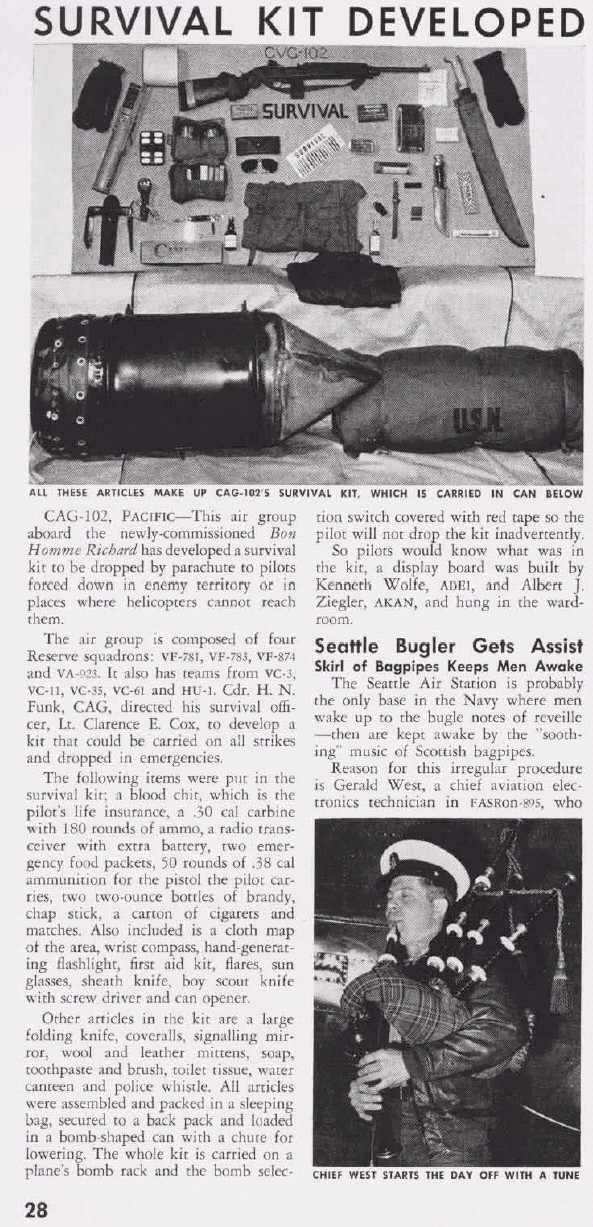
Once an aircrew and/or passengers are on the ground after an aircraft shoot-down/crash, they still are having to fight both the earth (The Battle Against the Earth) and other humans (The Battle Against Man) in order to survive just like ground Soldiers do. They should already have in their minds basic SERE skills that every member of the U.S. military should get intense training on and not just aviators and "special" feces personnel since the Non-Linear Battlefield (NLB) makes ALL Soldiers at risk of being isolated from friendly forces. This is far from being true today. Even infantrymen don't even get SERE training in our garrison BS military; they are too "busy" doing more "important" tasks like playing Mort Walker's "Beetle Bailey" mowing lawns and trimming vegetation around needless buildings than learning how to make vegetation into shelters and signal fires to save their lives in war.
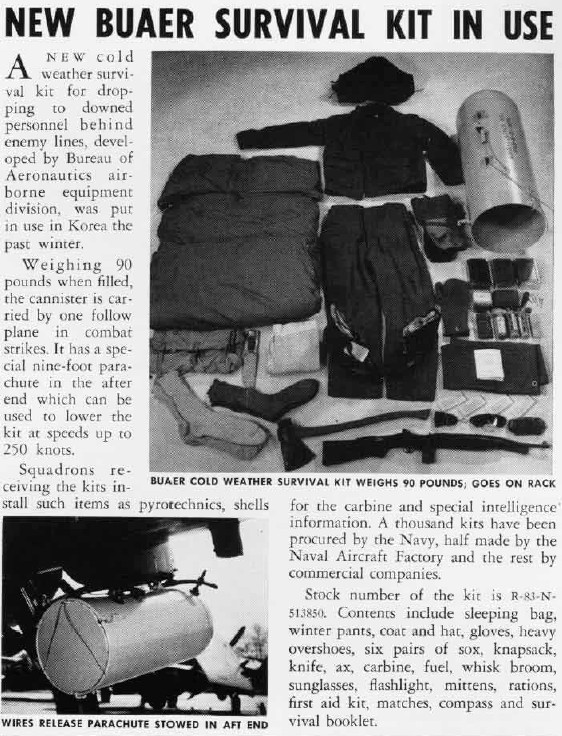
During the Korean War, even with the exalted helicopter's vertical landing and take-off (VTOL) capabilities, downed pilots were left to fend for themselves while being chased by communist enemies. One designated aircraft would have a survival kit fitted like a bomb under a wing ready to be dropped to the comrade below to give him needed survival items and even a M1 carbine to defend himself with better than the pistol on his body. IMHO that 9mm pistol should be a Beretta 92R with a folding stock that can be clipped to it to enable full automatic firing or a 5.56mm pistol/carbine system with greater range to keep the bad guys at bay. Ejection seat packs would protect a weapon system from hard knocks to insure its functional upon landing.
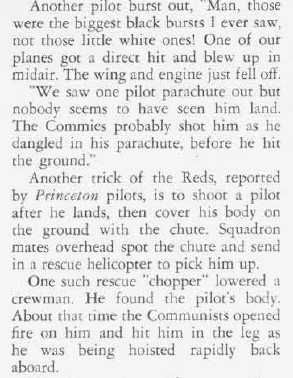
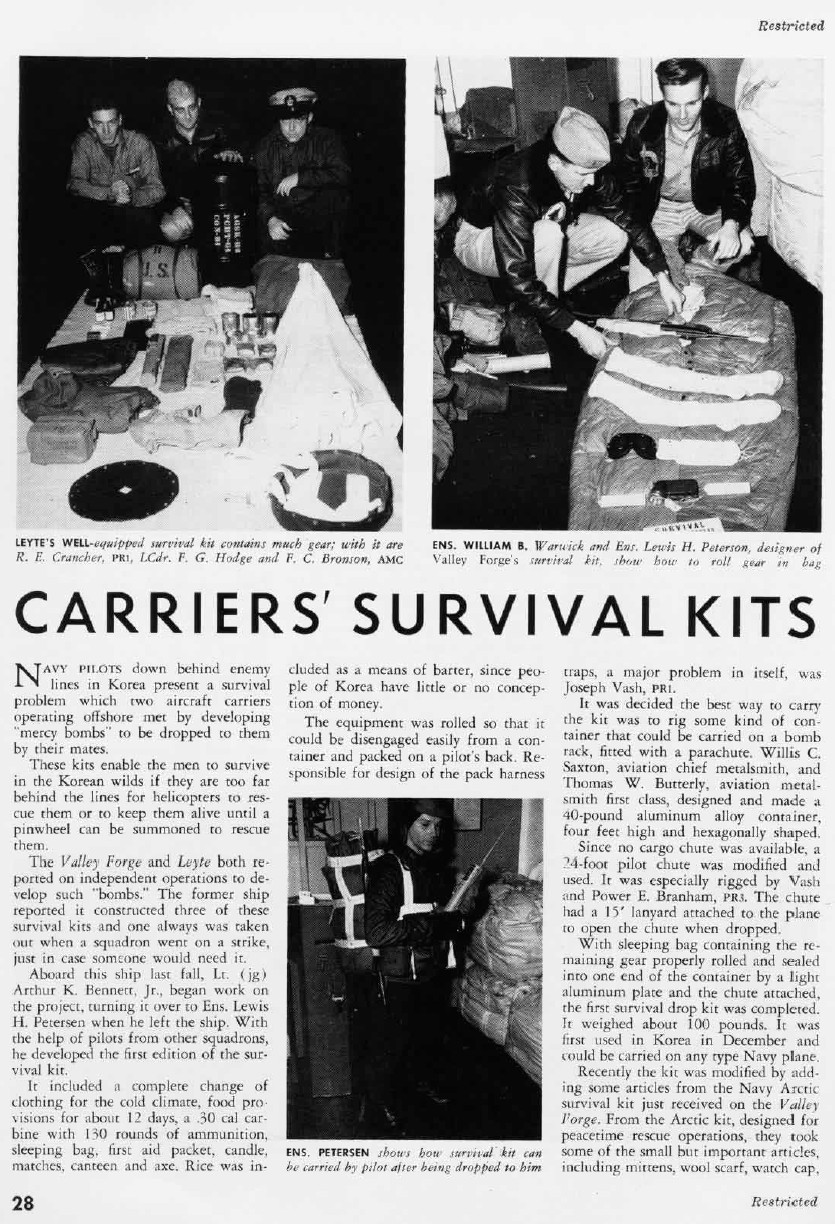
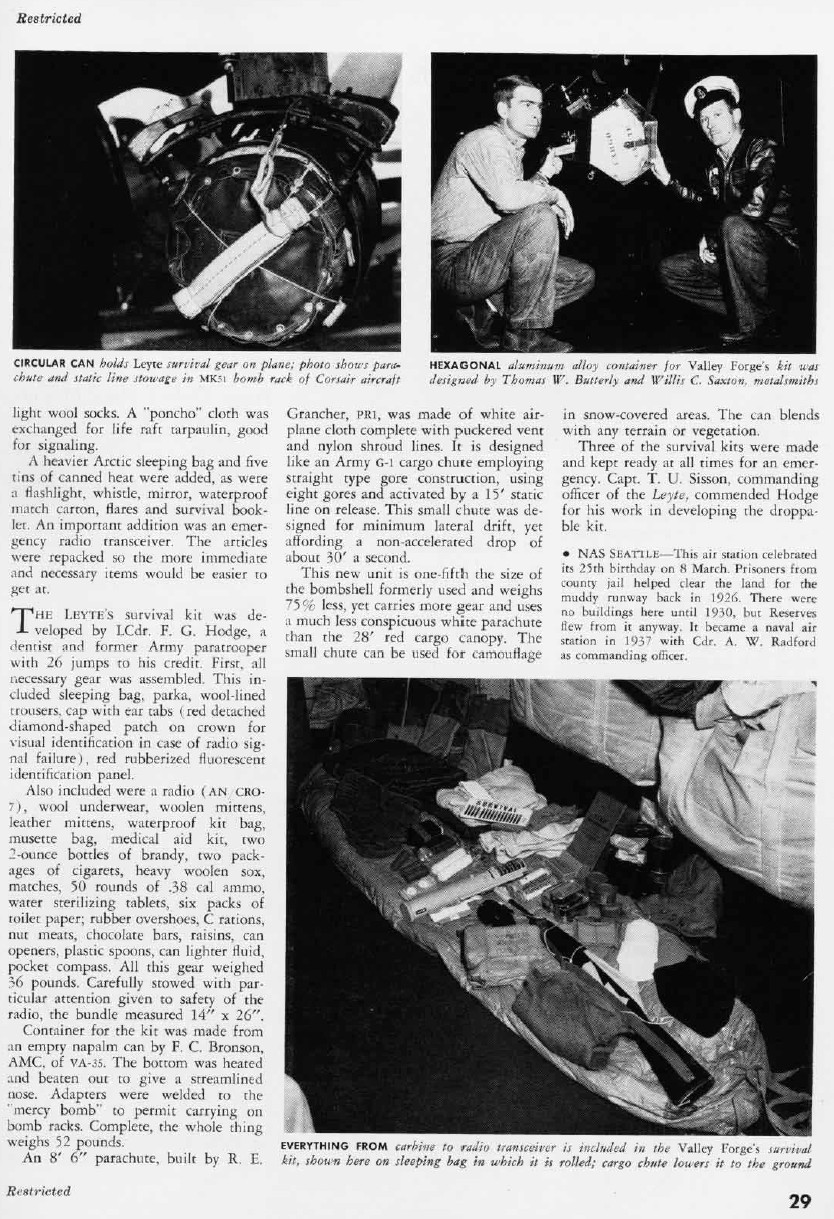
The enemy would often use downed pilots as "bait" to lure in rescue forces and ambush them. The perils of being captured by our often immoral and unethical enemies are well-documented and horrific.
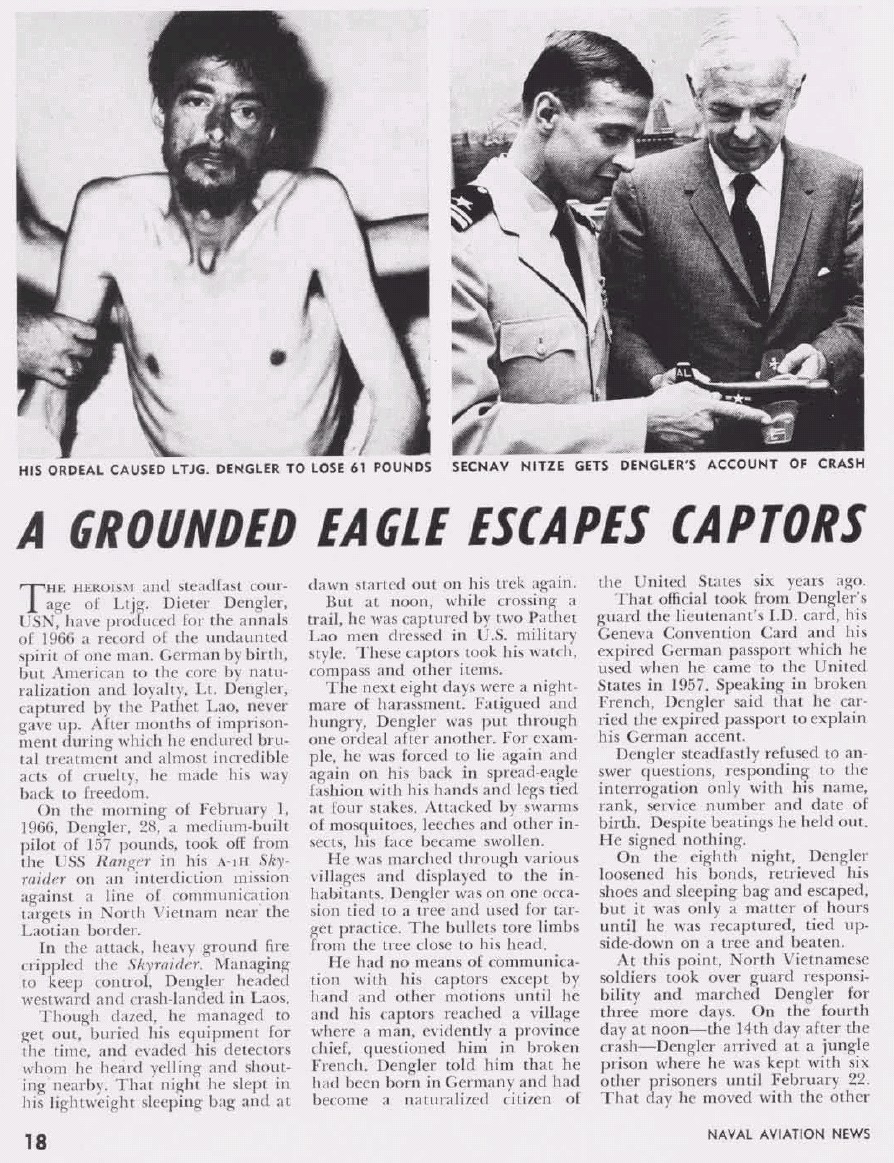
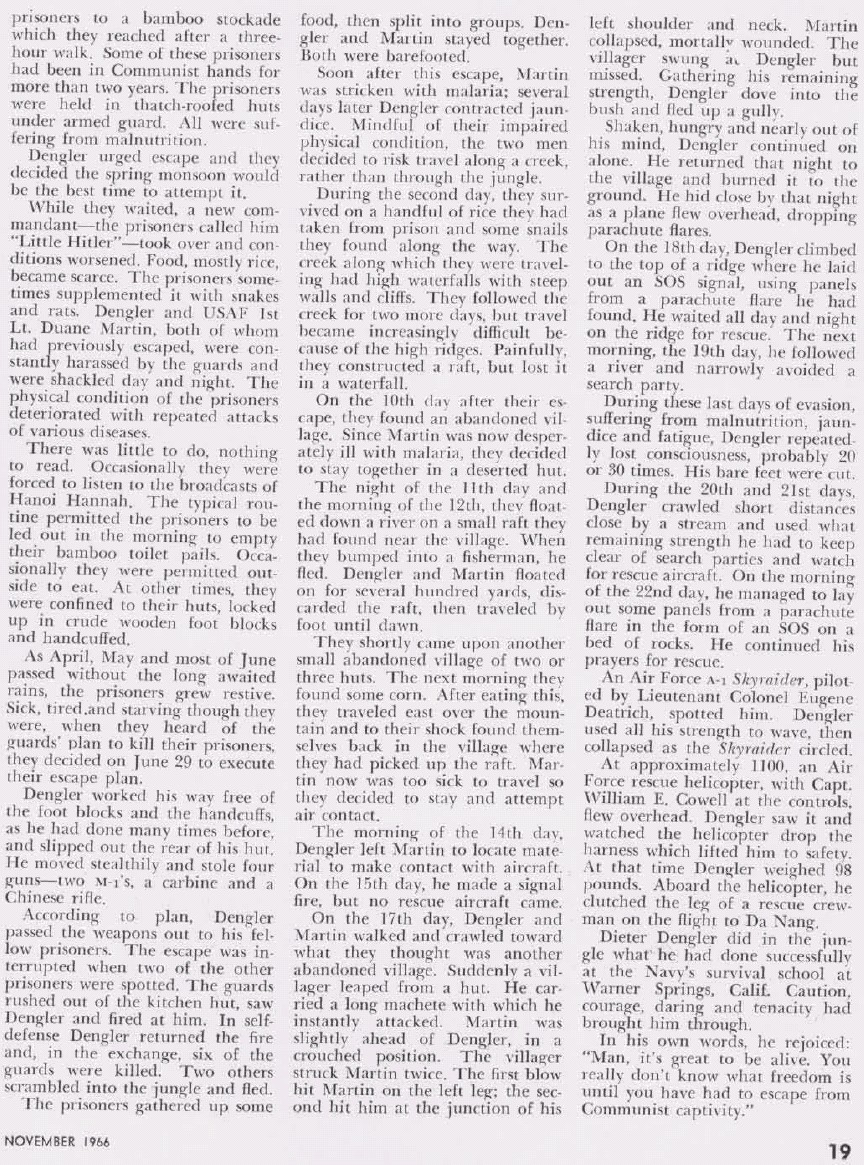
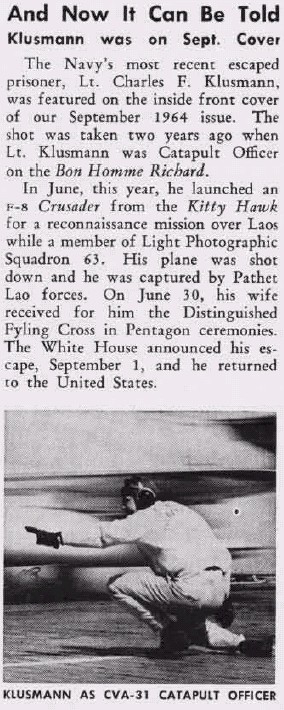
Unfortunately most of our downed pilots once captured did not have a happy ending of escape and rescue and had to endure years of suffering needlessly had we used Iowa class battleships to bombard the enemy instead to preclude much of the shoot-downs in the first place. Hardened design aircraft would prevent downings of the aircraft missions that would remain to be flown. Another possibility would be improved escape means in our aircraft with an EVASION and even a self-RESCUE capability.
Rescue-Thy-Self
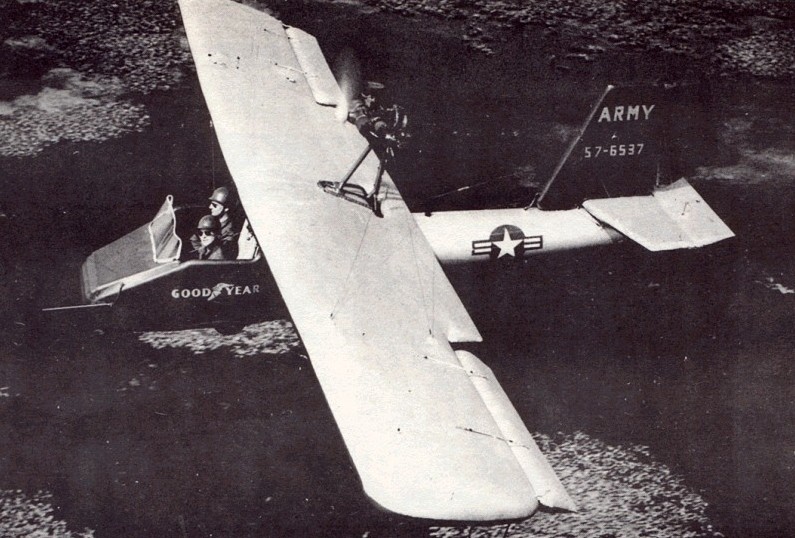
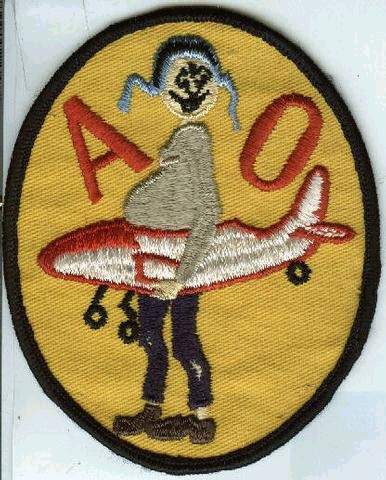
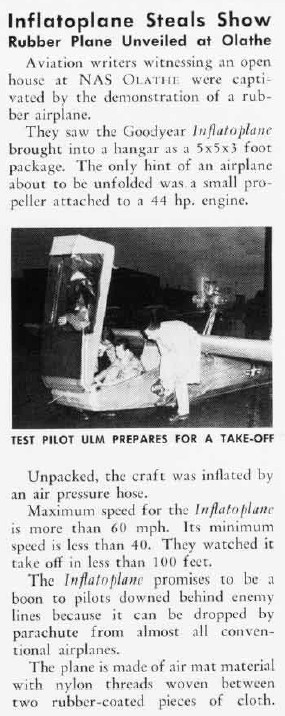
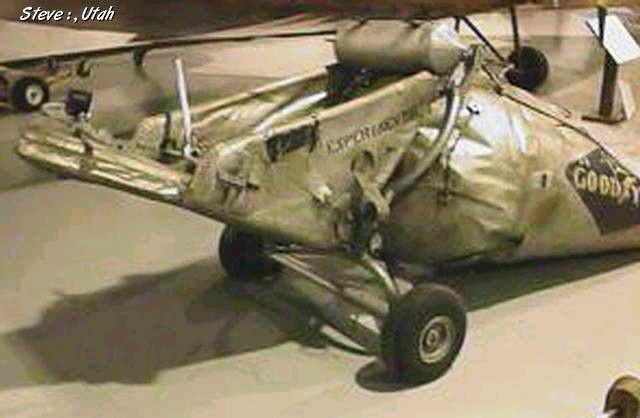
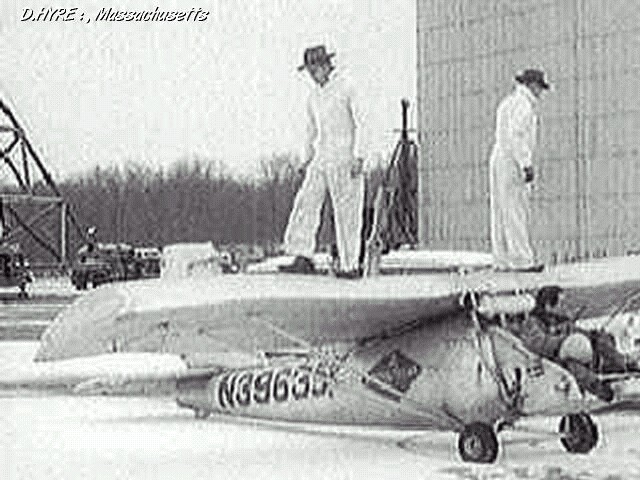
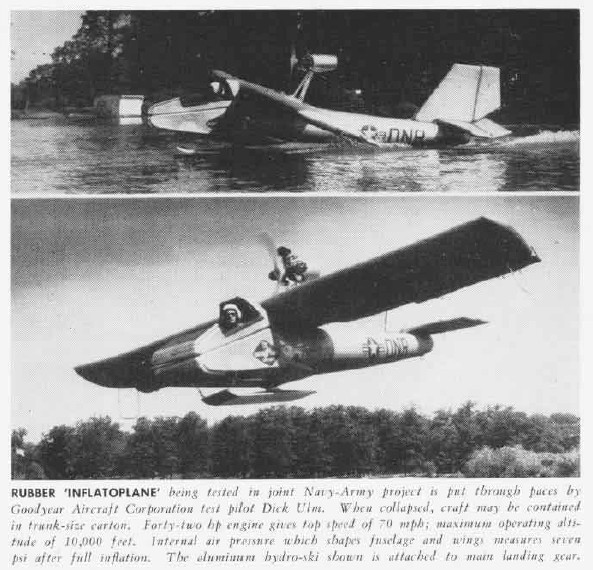
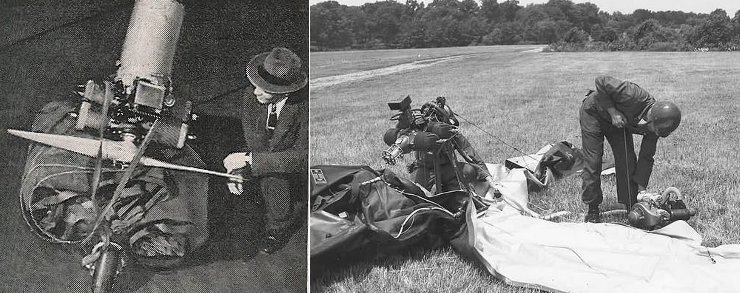
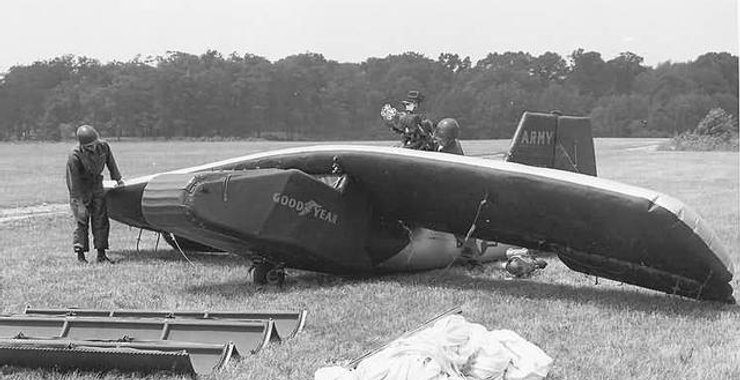
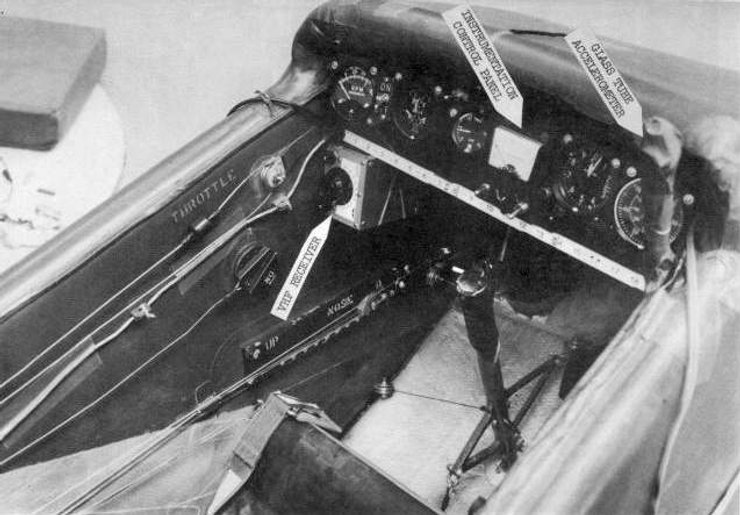
Military bureaucracies want their members in a weak, dependent status. It is no surprise means to self-recover oneself have not been fully exploited. One of the things we've yet to exploit for CSAR are inflatable airplanes and powered parachutes/paragliders. Such an entire aircraft could be placed inside a kit dropped by a buddy aircraft to a comrade below and he could inflate it, start the engine and take-off back to friendly forces--if he has enough runway length.
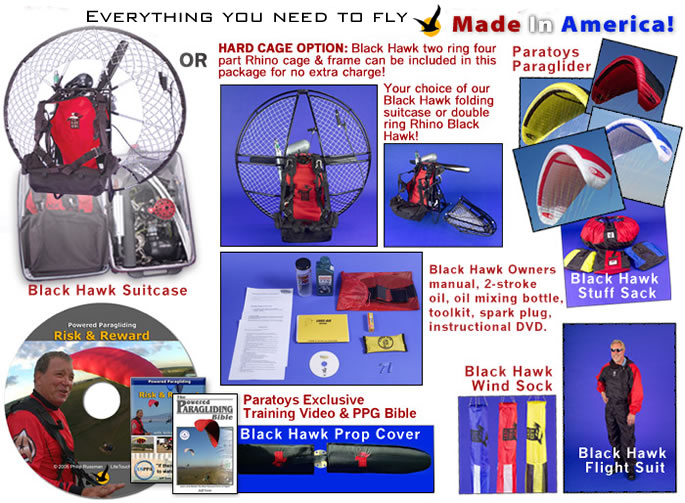
Another option would be a powered parachute or paraglider which have a near vertical take-off capability. The downside of powered parachutes/gliders is they can't fly against winds in excess of 20 mph, though 100 mph inflatable airplanes can IF they can get enough runway roll to take-off. Powered paragliders (PPGs) cannot fly in the face of strong winds.
STEP 1: Land as Far from the Enemy as Possible: AutoGyro Rotor or Pop-out wing Technology to Extend Ejection Seat Flight?
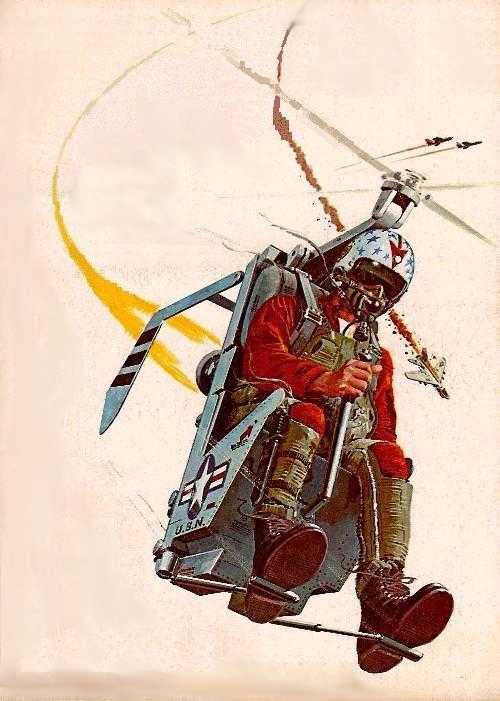
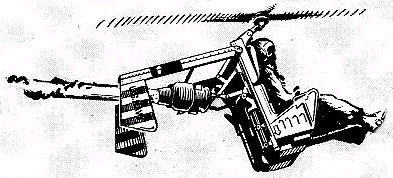
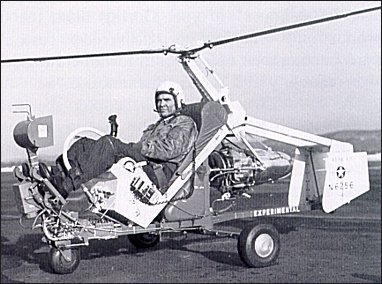
USAF F-16 pilots dies over Iraq, was it necessary?
1. Wrong plane
The tragedy here is the egomaniac USAF fighter jock brass are trying to make thin wing unarmored F-16s fly low altitude close air support missions instead of thick-wing, armored A-10s; if this pilot had been in an A-10 he'd still be flying and alive. The pilot may have been TARGET FIXATED and simply flew into the ground. Having a back-seat observer calling out altitude would remind pilots not to fly into the ground.
Reason?
The military narcissist ego can only have ONE THING GETTING ALL THE ATTENTION; in the USAF its the sexy fighter-bomber.
So the next time before you put military men on pedestals because they are doing your dirty work with slogans like "support our troops" consider that its immoral to put ANYBODY on a pedestal and that A LOT of our military's losses are self-created because there is a direct link between narcissism and military incompetence. The same arrogance you may detest in NeroBush that refuses to admit we caused the rebellion in Iraq by overstaying our welcome has its military versions.
2. Wrong Ejection Seat
Its high time we face the fact that parachuting directly over where you were shot down is no longer good enough. We have the technology to make the ejection seat "fly" a good distance so the pilot can contact rescue forces and get out of immediate danger for recovery.
http://articles.news.aol.com/news/_a/pilot-of-crashed-us-fighter-jet-missing/20061128062709990003?ncid=NWS00010000000001
Updated: 12:17 PM ESTPilot of Crashed U.S. Fighter Jet Missing
AP Says Video May Show Serviceman's Remainshttp://ar.atwola.com/link/93179288/377524249/aoladp?target=_blank&border=0
BAGHDAD, Iraq (Nov. 28) - U.S. forces investigating the crash of a single-seat Air Force jet in Iraq said that insurgents reached the site before American forces could and the pilot remains missing.
Videotape pictures obtained by Associated Press Television News appear to show the wreckage of the F-16CG jet in the farm field where it crashed Monday and the remains of a U.S. serviceman with a tangled parachute nearby. Al-Jazeera satellite television showed similar pictures on Monday, but declined to include the scenes of the dead pilot, saying they were too graphic to air.
Meanwhile, Iraq's parliament voted on Tuesday to extend the country's state of emergency for 30 more days, and suspected Sunni-Arab insurgents set off bombs in three different areas of the country that killed eight Iraqis and wounded 40.
The state of emergency has been renewed every month since it was first authorized in November 2004. It allows for a nighttime curfew and gives the government extra powers to make arrests without warrants and launch police and military operations. The measures are implemented in all areas of the country apart from the autonomous Kurdish region in the north.
Attacks by suspected Sunni-Arab insurgents occurred in Baghdad and in northern Iraq on Tuesday. Two car bombs exploded near al-Yamouk hospital's morgue in the capital, killing three civilians and one policeman and wounding 19 civilians, a police officer said on condition of anonymity to protect his security in a country where insurgents kill many of the Iraqi security forces working with the U.S.-led coalition.
In Diyala province north of the capital, where heavy fighting between police and Sunni insurgents has raged for several days, a roadside bomb exploded in the town of Baladrooz, killing three civilians and wounding four, a police officer said. He also spoke on condition of anonymity out of concern for his security.
North of Diyala, an Iraqi governor survived an assassination attempt when a suicide bomber blew himself up near the official's convoy. The attacker - wearing a belt of explosives hidden beneath his clothing - approached the convoy at 9:35 a.m. as it was driving slowly through the center of Kirkuk near the city's main public hospital, said police Brig. Sarhat Qadir. The man tried to enter the governor's car, but when the door was locked he blew himself up, Qadir said.
Gov. Abdul Rahman Mustafa and his bodyguards were not harmed, but the powerful blast hit civilians standing nearby, killing one of them and wounding 17, the officer said.
Kirkuk's population is a mix of Kurds, Arabs and ethnic Turkmen. Hundreds have been killed in sectarian and ethnic fighting in the past three years. The city is 290 kilometers (180 miles) north of Baghdad.
The U.S. Air Force [jet] crashed about 20 miles (30 kilometers) northwest of Baghdad at about 1:35 p.m. Monday while supporting extensive ground combat by coalition forces in Anbar province, the area of Iraq where many of the country's Sunni-Arab insurgent groups operate, the Air Combat Command said in a statement Tuesday.
Fighter jets flying overhead when the crash occurred "confirmed that insurgents were in the vicinity of the crash site immediately following the crash," the command said. When U.S. soldiers reached the area, "The pilot was not found at the crash site and his status cannot be confirmed at this time."
DNA samples were taken from the scene and were being tested, it said.
The F-16 was deployed to the 332nd Air Expeditionary Wing at Balad Air Base in Iraq.
Capt. Nathan Broshear, an Air Force spokesman, said the cause of the crash is being investigated.
But Maj. Gen. William B. Caldwell, a U.S. military spokesman, told a news conference in Baghdad on Tuesday that there is no indication the plane was shot down.
11/28/2006 10:24:34 EST
During the Vietnam war, we were losing hundreds of pilots over North Vietnam against their integrated air defense system (IADS). After ejection, if captured--these men were placed in prisons and tortured.
If we fight against a nation-state with a capable IADS, we might relive this debacle all over again. Making a drone air force with just UAVs is a wimp-out and an invitation to DEFEAT since robot planes cannot do what manned planes can do. At the time, Kaman who specialize in counter-rotating rotor helicopters proposed after ejection, rotors unfold pushed by a small turbine engine to get at least 50 miles away from the target area for a seat detaching and parachute descent if not staying in the seat and an auto-rotative landing. Its still a good idea; getting some distance from where you were shot down to a recovery spot; if not rotors then a ram-air parachute or inflatable wings, if not a small turbine engine, then a small rocket motor for thrust. A computer can determine the situation if there's enough altitude to stay in the seat to fly it or to kick out the pilot and have him descend under a parachute.
STEP 2: Get Snatched or Fly Self Back to Base
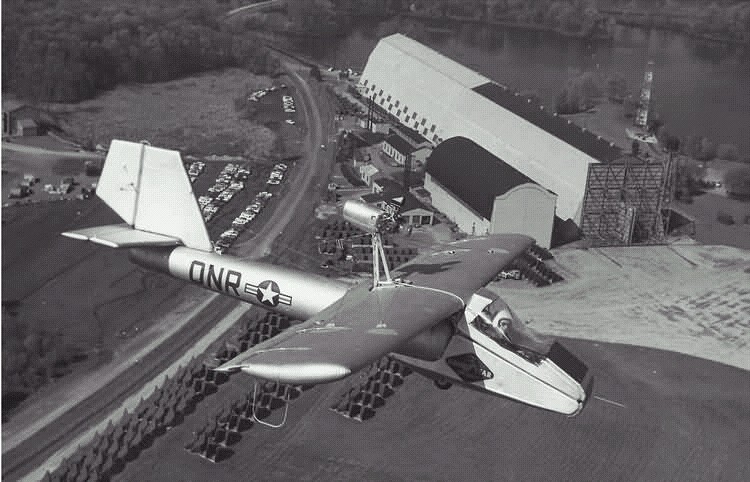
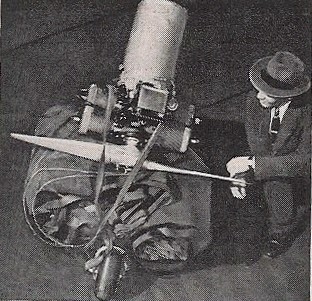
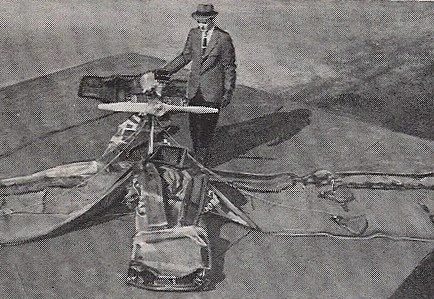
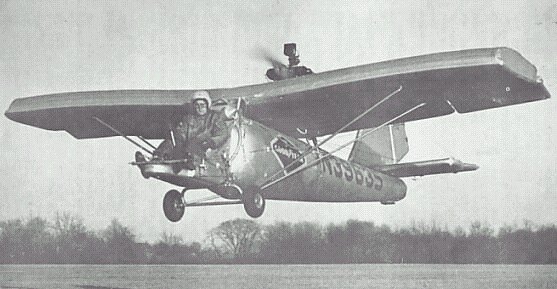
Wings could pop-out like a car crash air bag instantly to provide lift as the rocket motor or small turbine pushes the seat for forward thrust. The Goodyear GA-466 and 468 "inflatoplanes" proved this concept. You might say this is too "extreme", well wake up...flying a fighter jet is extreme...and in war is even "extreme". There have also been some tragic ejections where the pilot and back-seater in their round parachutes were unable to avoid landing their own aircraft's burning wreckage and not burn-to-death. An ejection seat that can "fly" a distance away can solve this.
Lighter-Than-Air (LTA) technology not fully exploited yet: FULTON ATAR?
In fact, we are all aware of air bag technology in our povs. A collision inflates a shock-absorbing bag to protect us from trauma. Why not a helium air canister or bottle of heat that inflates a bag within the parachute after ejection to keep the pilot aloft---and out of enemy light small arms fire and the ground----to help a MARS aircraft to rendezvous to recover him in the air? Or simply a small balloon on top of the parachute to interface with the Fulton STAR system?
If you go to the Pioneer Aerospace web site you will see parachutes with live humans have been successfully snatched and reeled in mid-air, or a Mid-Air Recovery System (MARS).
We recover balloons now from the ground using Robert Fulton's Surface-To-AiR (STAR) system, which has sucessfully extracted agents from the polar ice cap and a wounded Delta Force trooper during the SCUD SSM hunt during Desert Storm. With ATAR if the pilot feels this isn't going to happen he can cut-away from the balloon and descend by parachute--hopefully after a rescue force for ground pick-up has been acquired--a GRIER pod equipped STOVL AV-8B Harrier II, F-35 STOVL JSF, U.S. Army attack helicopter with GRIER rocket/rescue pod or V/TOL helicopters and tilt-rotors.
The beauty of EXTENDed FLIght Escape Systems (EXTENDFLIES) or a Fulton Air-to-Air Recovery system (ATAR) would be that it saves lives in peacetime over dangerous terrains and water. Aircrew held aloft by EXTENDFLIES could stay away from freezing waters, drowning, while emitting a search signal that would be heard for miles from their elevated position. Searchers would get an immediate fix and fly to their rescue by MARS or watch them descend on signal by parachute to the ground for immediate pick up.
FIXED-WING AIRCRAFT PEOPLE ESCAPE/EVASION PODS?
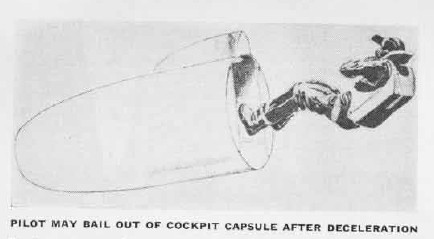
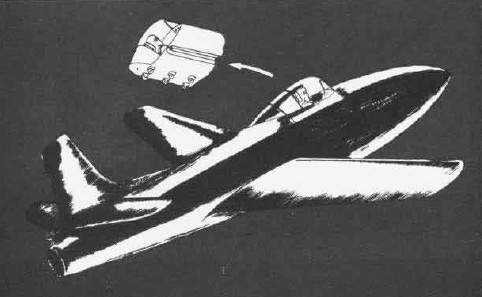
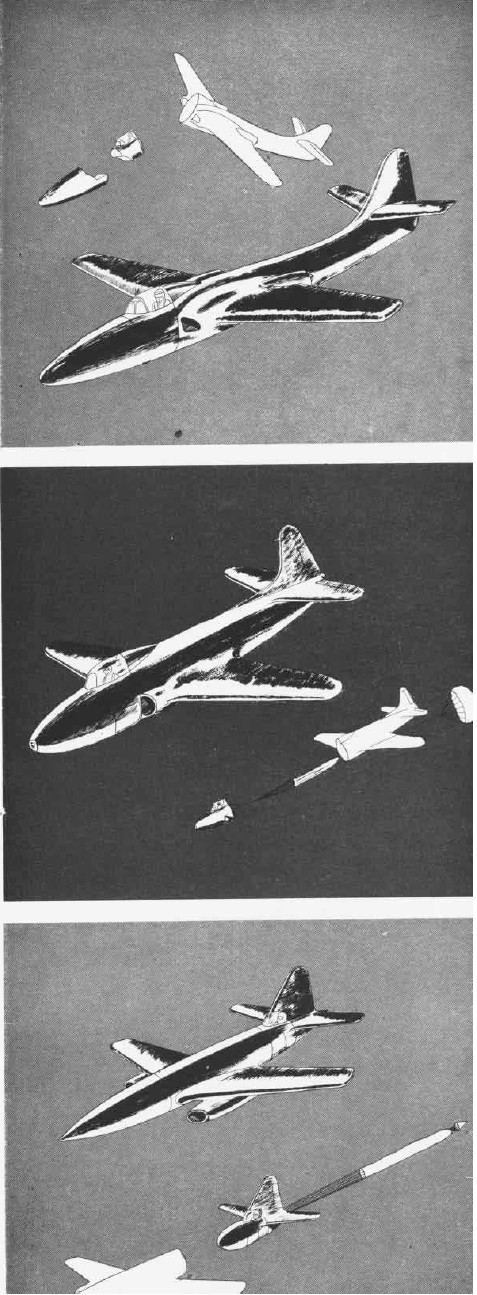
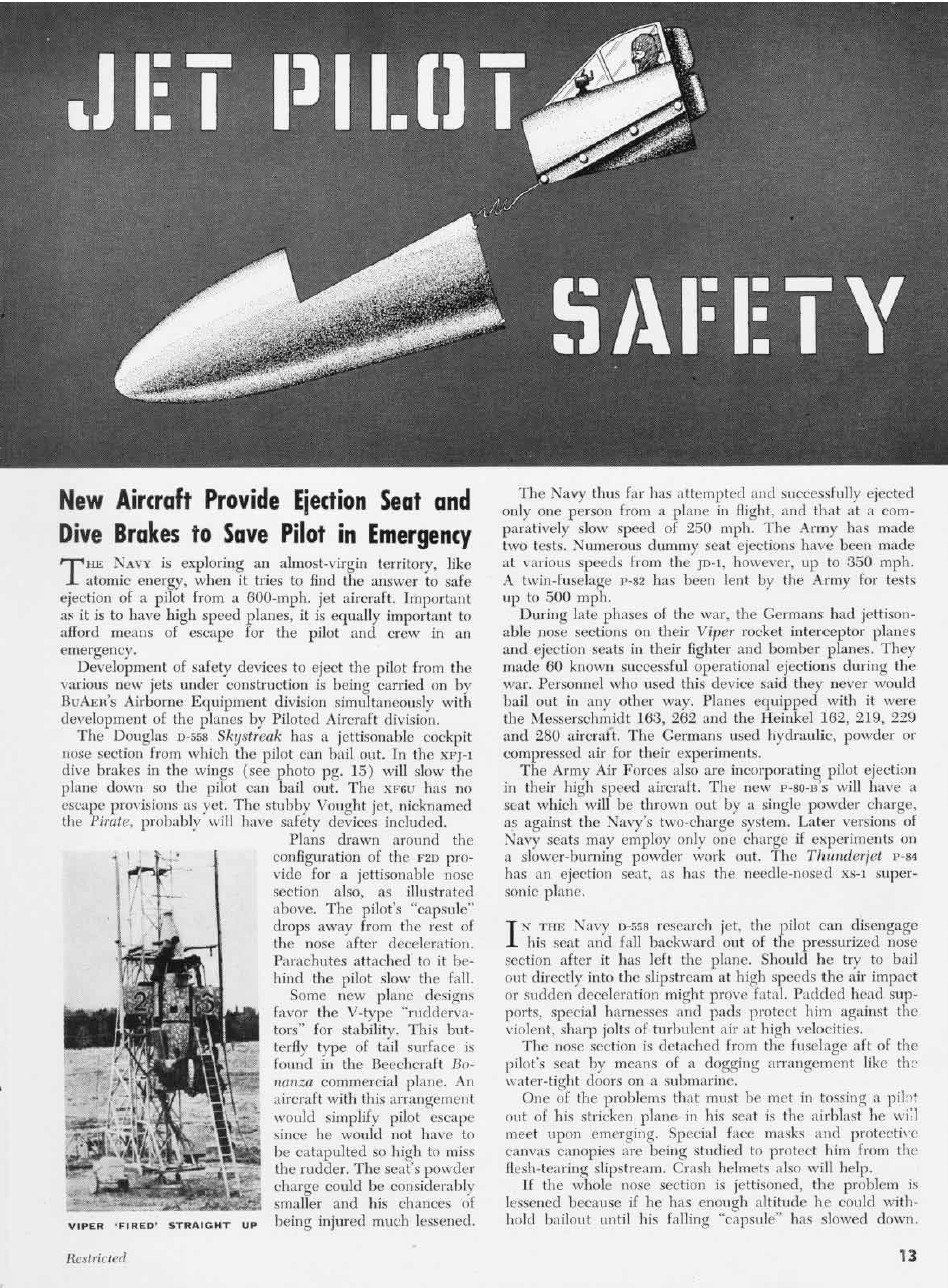
At the end of WW2, the Germans faced with their 500+ mph Me-262 jet fighter speeds that were simply to fast for a man to crawl out of the cockpit and bail out. They created the EJECTION SEAT with a ribbon parachute with a dangerous 40+ feet per second descent rate, but they had the right idea: you have to shoot the pilot from outside the cockpit to clear the tail. The ejection seat is the minimalist way to get instant aircraft escape from zero altitude, zero airspeed (zero-zero) all the way to high subsonic speeds. To protect the face, a blast screen can be pulled down over the helmet front. However for faster supersonic speeds PODS were considered by U.S. aircraft designers, a MAXIMALIST way for crew escape.
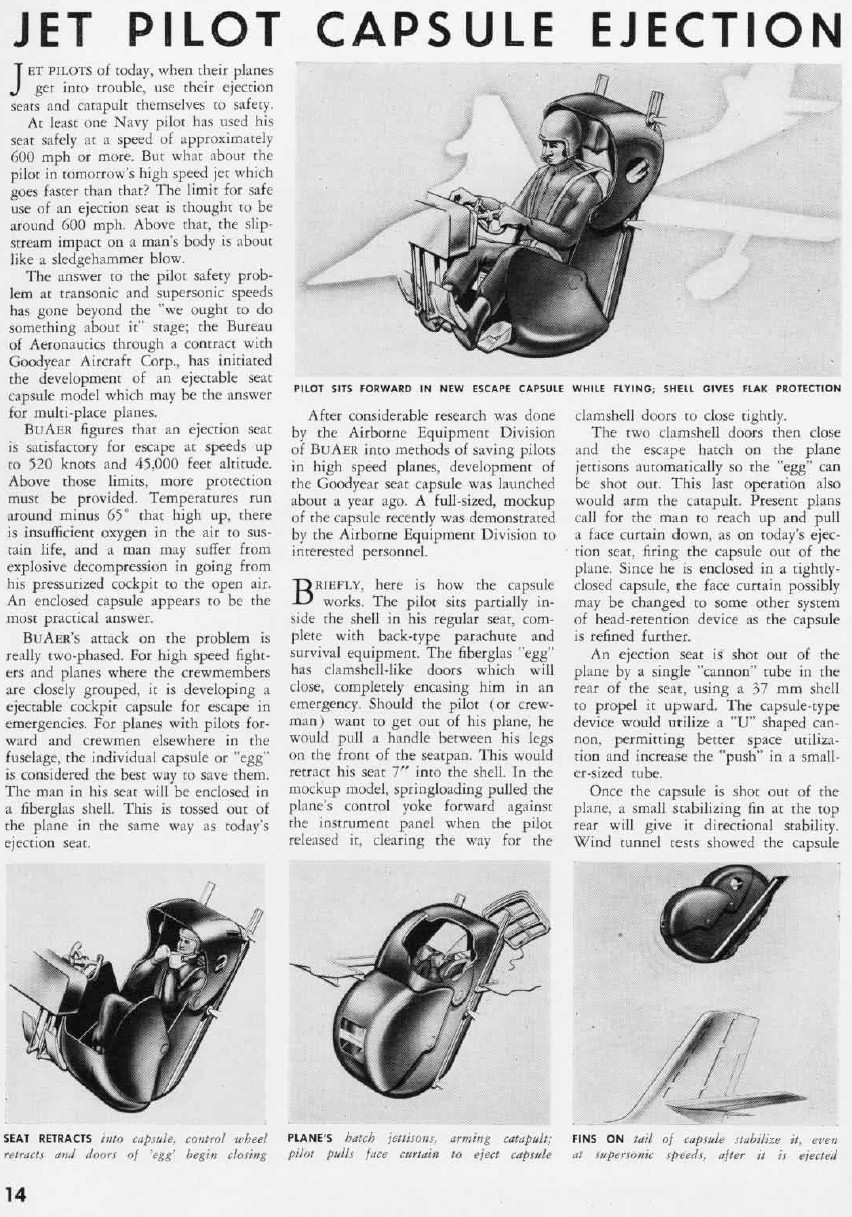
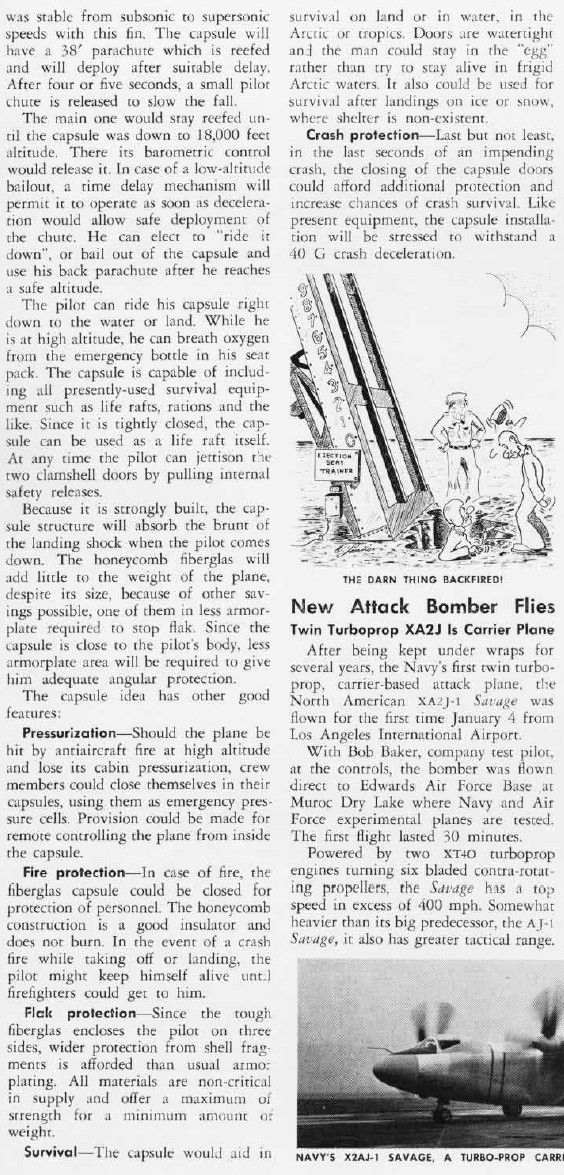
Escape pods that were in essence enclosed ejection seats were used in the B-58 Hustler and the B-70 Mach 3 bomber prototypes.
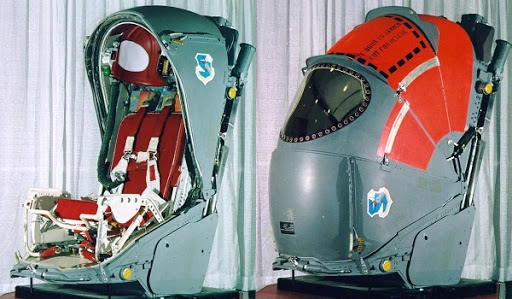
Ejection seat pods were considered for the F-105 Thunderchief, and in light of what we know today of how many would be shot down over North Vietnam, maybe not fielding them was a mistake.
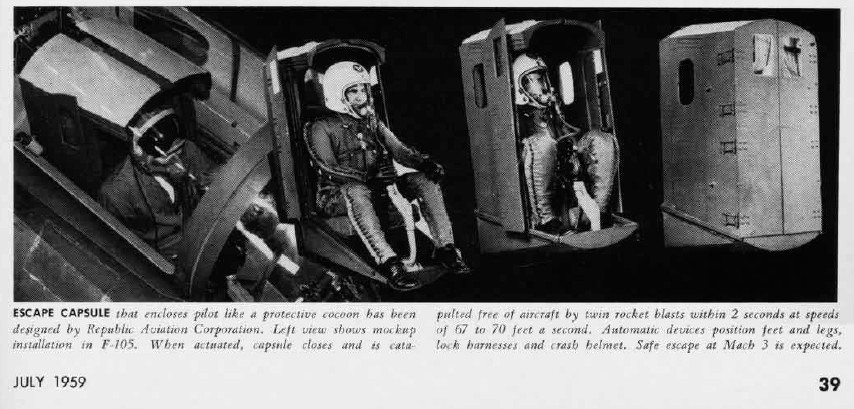

Vought, the makers of the F-8 Crusader Mach 2 naval fighter perfected a detaching nose escape pod for it, but the Navy by that time were done buying more F-8s and this feature never got fielded.
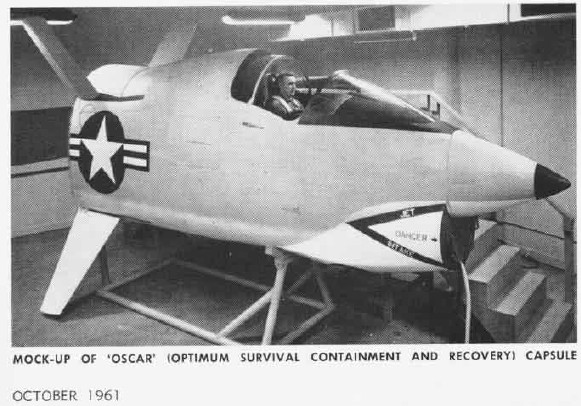
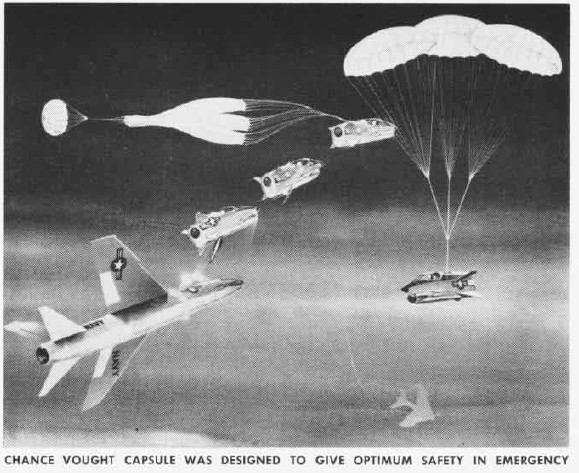
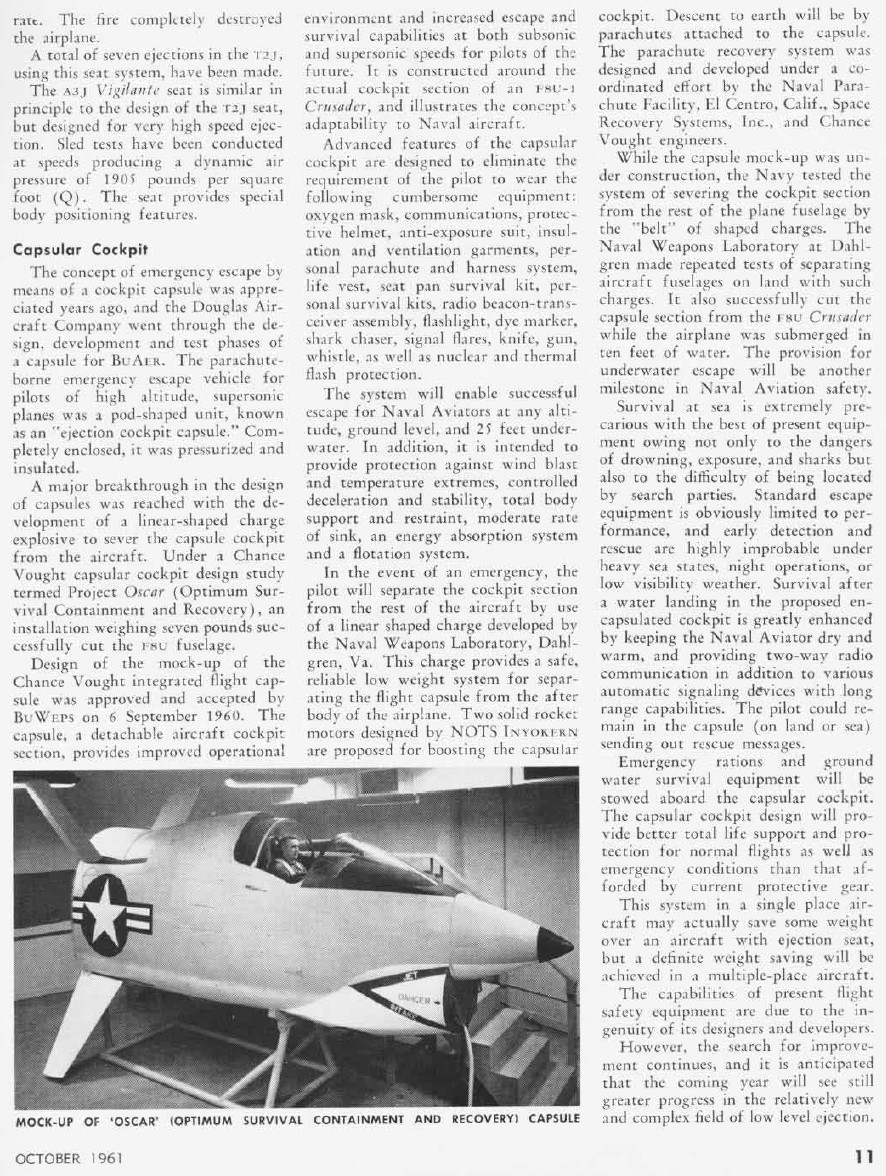
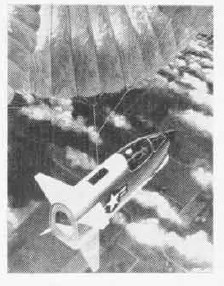
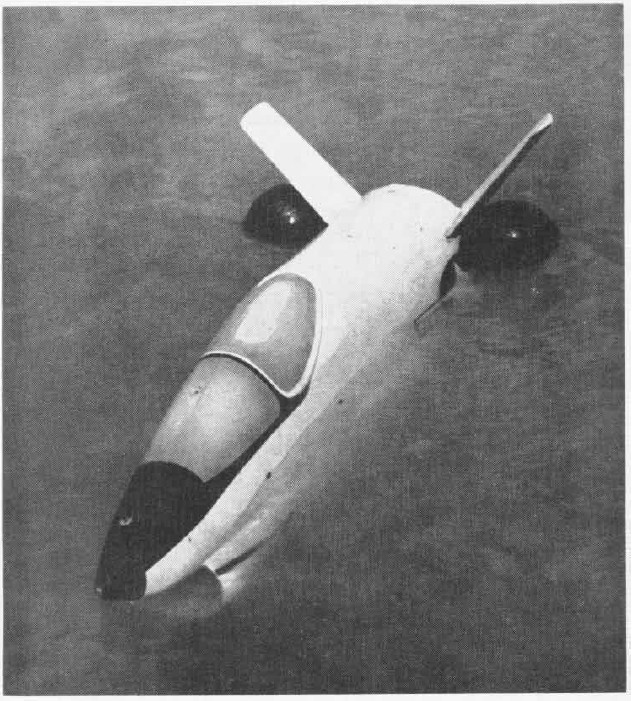
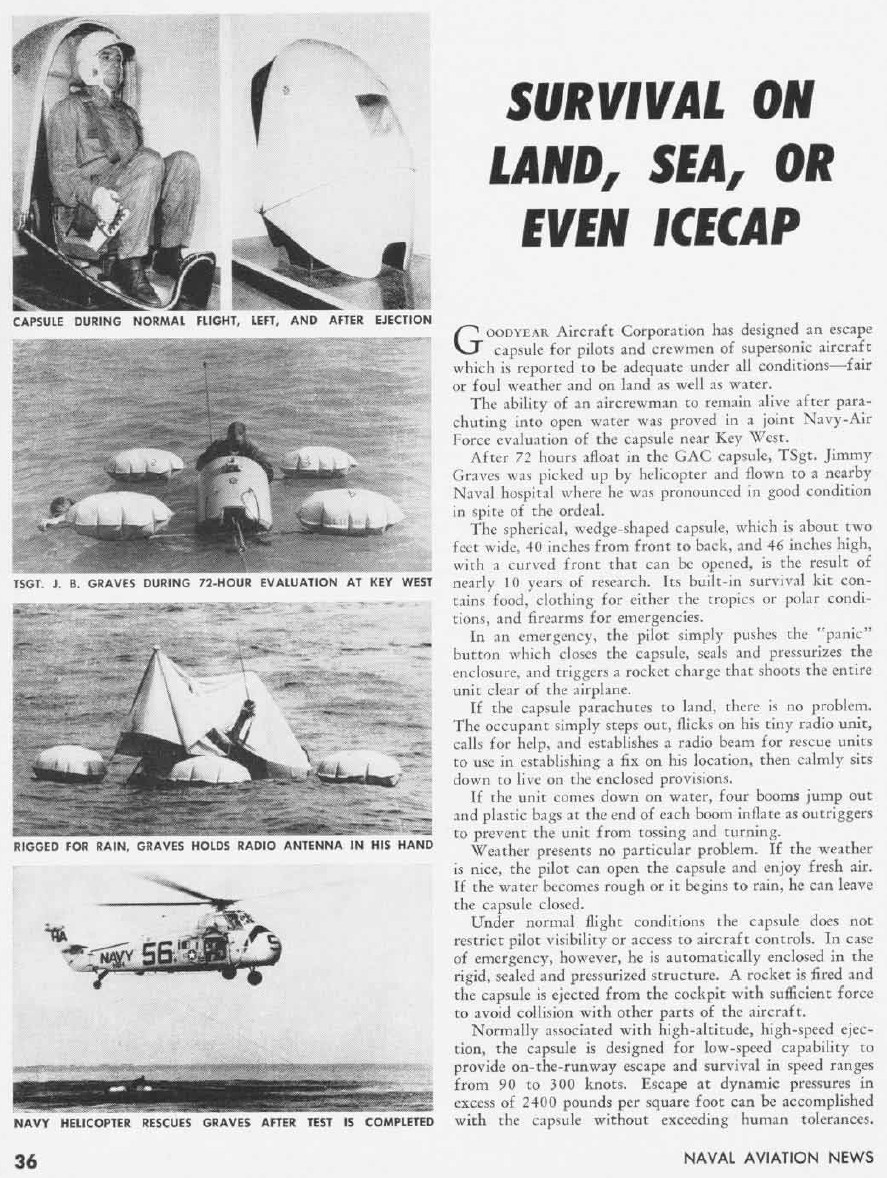
In light of the thousands of aircraft shot down over both South and North Vietnam, its tragic that the escape pod did not catch on into full-scale military use since thousands of men were killed by bad ejections, rough parachute landings to the body into often thick jungle tree canopy and subsequent failed rescues and prisoner of war torture. Escape pods would not only protect aircrew from the harsh air flow, they would cushion their bodies during landings under parachute canopies. There is a very good chance the aircrewman would be healthy and without either broken backs or lower extremities on the ground to better escape & recover (we used to call this "escape & evade"). It gets better. In the escape pod, the classic survival and escape gear kit would already be there and not have to be dropped. This could even mean FIGHTING means like a compact M16/M4 5.56mm rifle or a 9mm sub-machine gun WITH A LOT OF BULLETS to ward off the enemy who might want to use the downed men as "bait" to ambush rescue forces. As radical as this is, that the airdale becomes a defacto ground combatant infantryman, the escape pod could also contain inside SELF-RECOVERY MEANS. A folding mountain bike, a Fulton STAR kit or even a powered parachute or inflatable plane could be inside for the downed men to save themselves. In fact, the escape pod itself could be a SECONDARY "flying machine" by its parachute being a ram-air type and some thrust applied to extend its glide to such a degree that it might even fly all the way back to base and certainly could move to a safer spot for pick-up by CSAR forces than right over where the shoot-down took place.
Escape Pods that were actually a part of the aircraft fuselage were actually fielded in the F-111 Aardvark still in use by the Royal Australian Air Force.
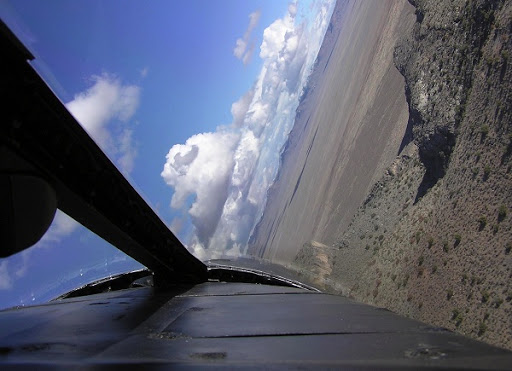
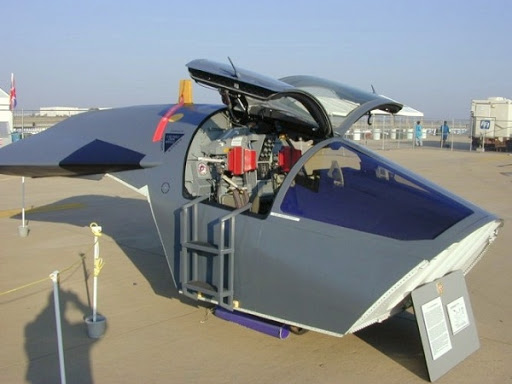
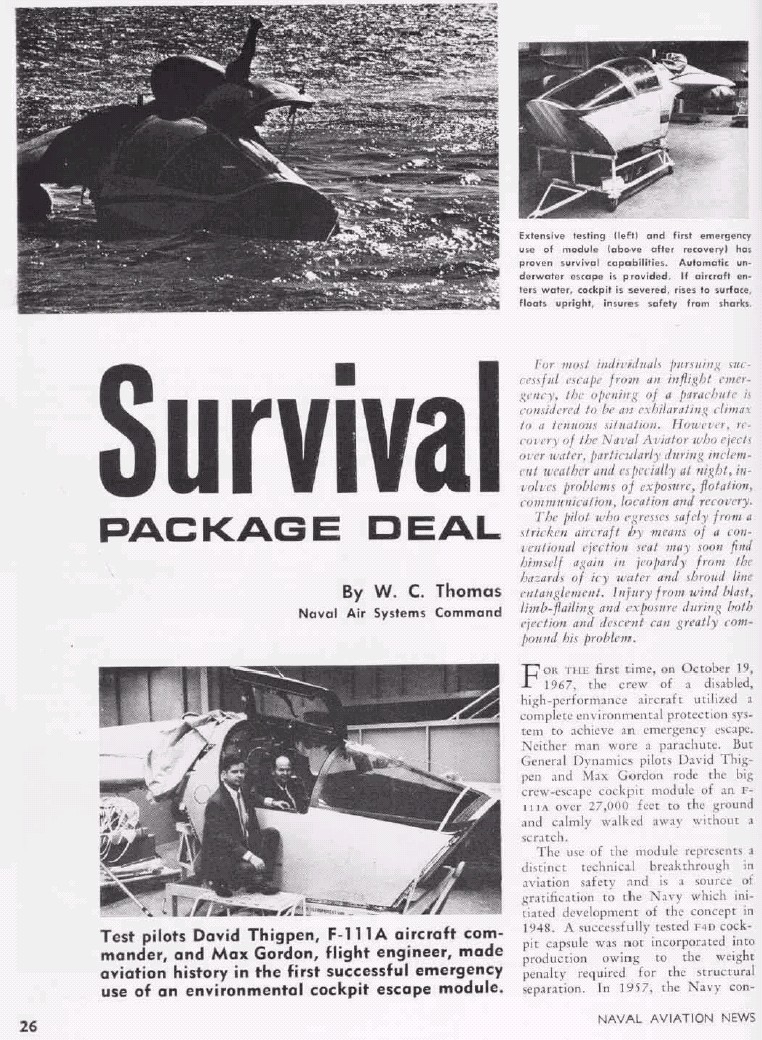
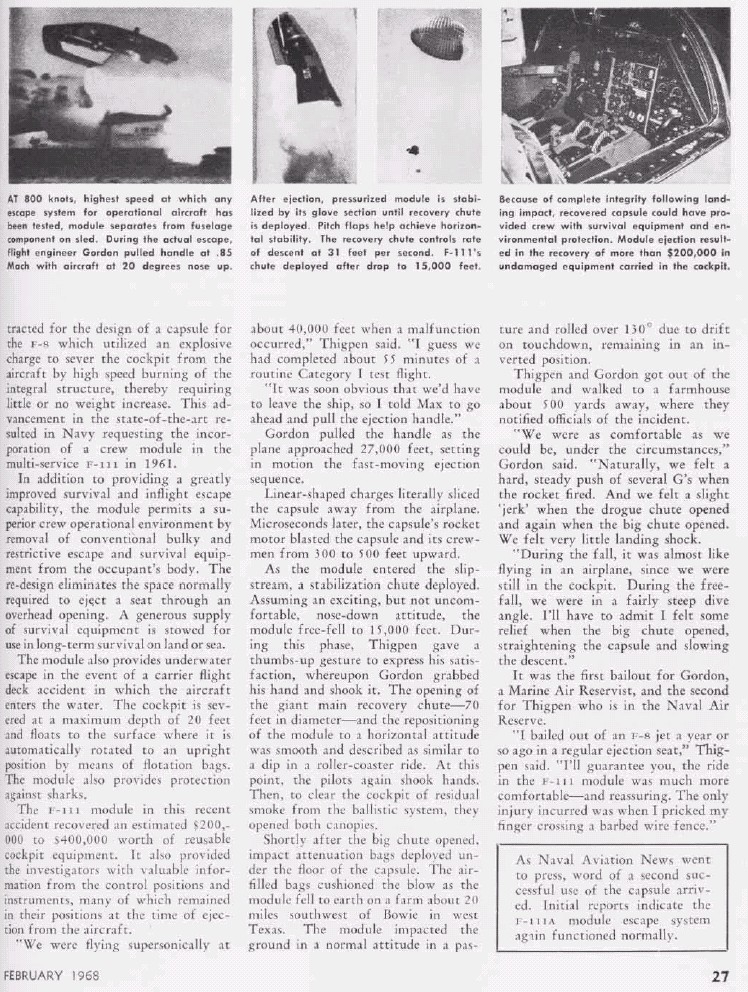
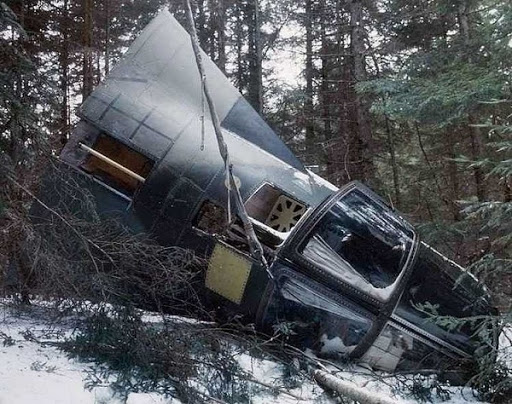
However, ever since then we've defaulted to ejection seats or worse every man/woman going-down-with-the-plane without even bail-out parachutes.
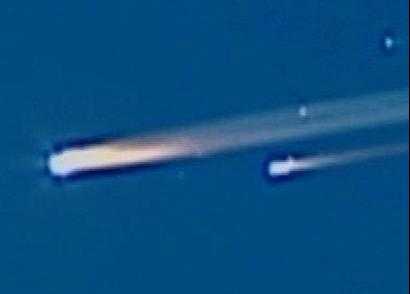
Pods will indeed become necessary when we become serious about men in aerospace craft having a fighting chance of survival when they blow up or burn up as the Challenger and Columbia space shuttle tragedies show.
MILITARY TRANSPORT PLANE ESCAPE PODS: SHOW GREEDY COPORATE AIRLINES THE WAY
www.google.com/patents?vid=USPAT4699336&id=n7U3AAAAEBAJ&printsec=abstract&zoom=4#PPP1,M1
Airplane safety body passenger compartment
Peter Diamond

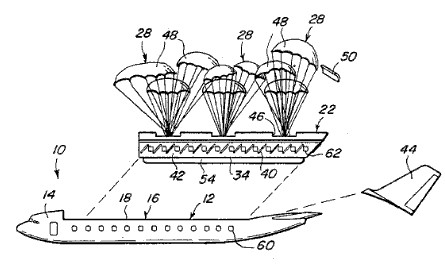
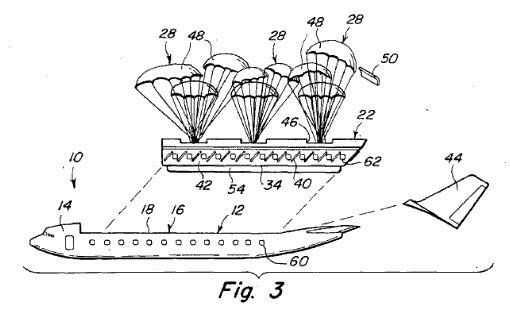
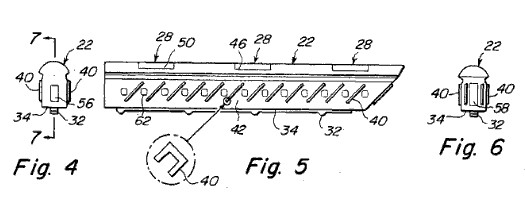
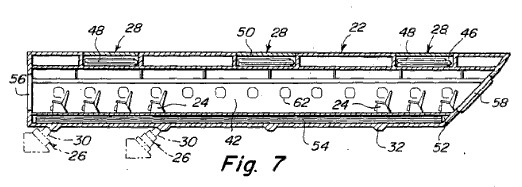
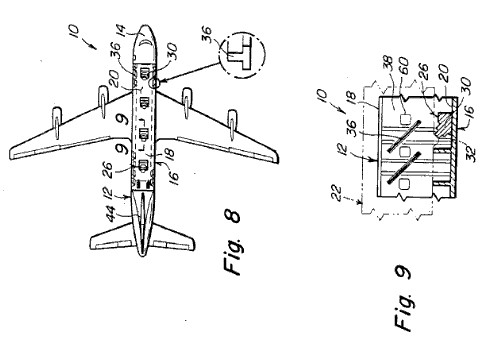
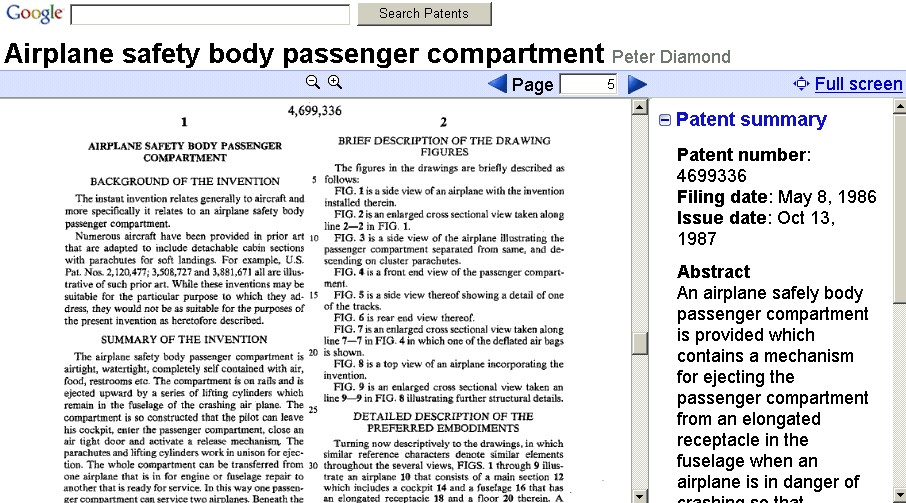
Citations
|
Patent Number |
Title |
Issue date |
| 1760061 |
PARACHUTE SAFETY SUSPENSION FOR AEROPLANES |
May 27, 1930 |
| 1895256 |
DROP CABIN PLANE |
Jan 24, 1933 |
| 2066810 |
AIRCRAFT |
Jan 5, 1937 |
| 2077910 |
PLYING MACHINE |
Apr 20, 1937 |
| 4298177 |
Aircraft safety apparatus |
Nov 3, 1981 |
Integrated capsulized cabin for passenger aircraft
Jul 16, 1991
Multi-axis g-compensating escape cockpit capsule
Mar 29, 1994
Segmented safety aircraft
Oct 18, 1994
Aircraft passenger extraction system
Jul 13, 1999
Aircraft with severable body and independent passenger cabins
May 7, 2002
Passenger airplane container system
Dec 17, 2002
Boarding device for aircraft and flying wings equipped with such a device
Jul 22, 2003
Aircraft with a detachable passenger escape cabin and an aircraft with airbags
Jan 27, 2004
Ejection escape system for a passenger airplane
Feb 24, 2004
Aircraft passenger safety module
Jul 13, 2004
SMOKE HOODS?
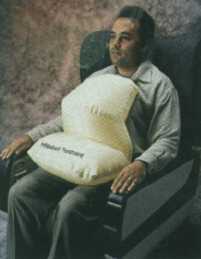
The combination airbag to prevent bodily injury from impact belt offered by Goodyear Aerospace is a great idea. We need to also have an integral smoke hood so military/civilian passengers can breath long enough to escape through toxic smoke, too. They would don the belt and hood just prior to crash landing. The air bag would be deployed prior to the crash or upon impact.
The next-generation of civilian airliners/military transports should be made with SAFETY as top priority--not corporate profits...Crash-worthy Burnelli type aircraft have been available for decades----but corporate GREED and politics have continued to send thousands of people to their deaths!
Full solution is Burnell-type airplanes with fuselage as lifting body so structure is stronger and contributes lift for lower wing loading and slower take-off and landing speeds....
However until we can get Burnelli airliners flying sit as far to the rear of the plane as possible! The following is proof that in a conventional tubular fuselage and wing aircraft the safest place is as close to the TAIL as possible!
ATTACK HELICOPTER EJECTION SEATS? TOO HARD? THE RUSSIANS CAN DO IT. HOW ABOUT ESCAPE PODS THEN?

In war, planes get shot at, hit and as they crumble the crew must be able to escape if they are to survive. If too many Americans die in a war, you can hang it up, America will cut her losses and run. So we had better stop living in denial, find ways to fight wars and bring our men back alive while we defeat the enemy.
The Russian KA-50 Black Shark (NATO code name: Hokum A -single seat, Hokum B -2 seat) already has helicopter ejection seats. We were the first to create them with the Sikorsky S-72 experimental helicopter, but like typical Americans we were lazy and continued with the status quo and a steady stream of dead aviators. We have no excuse.
"The Ka-50 is the world's first operational helicopter with a rescue ejection system, which allows pilot to escape at all altitudes and speeds. The K-37-800 Rocket Assisted Ejection System is manufactured by the Zvezda Research and Production Enterprise Joint Stock Company in the Moscow Region. The seat operates by pulling the pilot from the helicopter cabin using a solid-propellant rocket motor. The system comprises the seat, a control unit and a pullout rocket motor. The seat is fitted with a survival pack containing an NAZ-7M survival kit, a life raft and a PS-37A parachute system. The seat provides safe forced emergency escape from helicopters in the speed range 0 to 350 km/hour and at altitude 0 to 6,000 metres. The seat also provides safe ejection during inverted flight (at speeds 0 to 330 km/h with zero vertical velocity) at a minimum altitude of 90 metres."
Buy these seats from them and fit into our AH-64D Apaches, OH-58D Kiowa Warriors and RAH-66 Comanches.
ITS NOT TOO LATE FOR THE U.S Army! Curse of the Helicopter Shoot-Down: durability, survivability, and viability of helicopters now in question
"I am a dual-rated (fixed and rotary-wing aviator with a combat tour). I lost one of my flight school buddies over Laos when he was flying his H-53 Jolly Green Giant. He was air-to-air refueling at 8,000 feet when his main rotor blades contacted the refueling boom off the HC-130 and he lost his blades at 8 grand. That's a long way to fall and a long time to think about it. Put yourself in his shoes. I think I'd prefer the option of having a chute on top, just in case."
--Former U.S. Army combat pilot
As long as M1 Abrams heavy tanks and Apache helicopter fighter-bombers did not get destroyed their durability was not questioned. However, even if they are destroyed, as long as their crewmen are unharmed, their survivability is still intact. So far this has what has happened in Iraq until last week. For over a year, M1s and AH-64s have been shot up and the latter even shot down but all of their crewmen have walked away unharmed except in one instance where a large landmine killed a couple tankers. However, an AH-64 was shot down by a surface-to-air missile 3 miles west of Baghdad International Airport, killing both crewmen and bursting the Apache's invincibility "bubble". Now the DoD Luddite doomsayers will pile on saying we shouldn't have either tanks or helicopters because they are not 100% invincible; and absurdly we would be better off walking despite today, months later 4, 700+ dead and 26,000 wounded human bodies ruined mostly when inside far worse Humvee/Stryker truck platforms or on foot. The viability of helicopters on the modern, non-linear battlefield (NLB) is again in question.
It's our own fault: no crew escape is a set-up for failure
However, the reason the combat helicopter fighter-bomber (but not fixed-wing jets) is in jeopardy in the minds of many defense analysts is the fault of both Army/marine attack helicopter communities for failing to provide crew escape capabilities to eliminate the human tragedy of being shot down. Our own hubris to thumb our nose at fate is the cause. Aircraft crash EVEN WHEN NO ONE IS SHOOTING AT THEM; and thus need escape means. Without crew escape, when a helicopter gets shot down, the crew's survival hinges on living through an uncontrolled, often tumbling crash landing into the ground at 100+ mph. But its more than that, by not offering crew escape, we are making every helicopter shoot-down a huge psychological media loss/defeat when getting shot down shouldn't be a big deal for attack aircraft providing Close Air Support (CAS) if you can bail out. Consider that Hans Rudel got shot down a dozen times in his armored JU-87 Stuka attack aircraft in WWII; he walked away and continued to fight again and again.
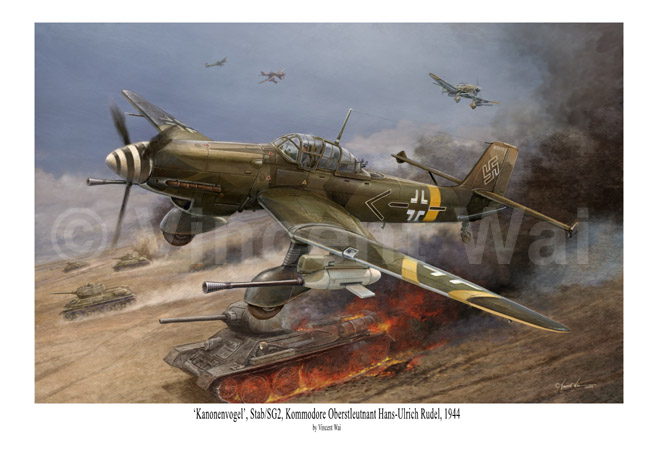
Attack aircraft should be like a horse; if its shot out from under you, you get another one and get back on it again. But if we provide no crew escape, this detachment from romantic idolization of a platform being knocked down and the resultant disillusionment doesn't occur. To avoid shoot-downs in Afghanistan, the Russians flew at higher altitudes, kept moving with diving attacks and had their men wear parachutes in order to bail out. Jet fixed-wing fighter-bombers have ejection seats; if they can no longer continue flying, the crew punches out and everyone shrugs their shoulders and everything continues like normal routine. Why not for helicopter fighter-bombers?
How to do it?:
OPTION 1: Helicopter Ejection Seats
 youtube.com/watch?v=jLhZN7fTwQQ
youtube.com/watch?v=jLhZN7fTwQQ
I bet Dr. Severin could design an AH-64 helicopter ejection seat...he already has done it for the Hokum helicopter! And the American Sikorsky company did it in their S-72 QRSA research compound helicopter..SO WHAT'S OUR EXCUSE?
Ejection Seatshttp://72.14.207.104/search?q=cache:_yQ3ojtMmzUJ:www.globalsecurity.org/military/systems/aircraft/systems/eject.htm+drogue+parachute+tail+spin+recovery&hl=en&ie=UTF-8
Within the last 10 years, dramatic escapes from Russian fighter aircraft have captured the attention of military pilots and aviation enthusiasts around the world. The low-altitude ejection from a MiG-29 just prior to ground impact at the 1989 Paris Air Show and a pair of miraculous escapes from two exploding MiG-29s that had collided over Fairford, England, in 1993, vividly demonstrated the potential downside of flying high-performance, military aircraft. (see videos at the top of this web page) The pilots ejected successfully thanks to the K-36D ejection seat designed and built by the Zvezda Research, Development and Production Enterprise in Russia.
The K-36D ejection seat and its associated life support equipment are designed, tested, and produced under the direction of Professor Guy Severin. Professor Severin, a member of the prestigious Russian Academy of Science, has devoted his life to developing and perfecting life-support and life-saving equipment for air and space systems. His achievements include the design of the cosmonaut seats, pressure suits, and the first extravehicular maneuvering unit for the Russian space program; aeronautical fire suppression equipment; and escape systems for fighters, bombers, VTOL aircraft, acrobatic aircraft, and the Russian Buran space shuttle.
The K-36D ejection seat provides directional stability and crew protection features that significantly reduce the risk of injury during ejection, especially at the higher speeds associated with fighter aircraft operations in wartime. Successful K-36D operational ejections have occurred at speeds of 729 KEAS and Mach 2.6.
The aerodynamic forces encountered at high speeds can cause severe neck, spine, and limb injuries. Our experience with Western ejection seats, which are aerodynamically unstable and have little or no limb restraint, indicates that the risk of major injury rises exponentially from about 350 KEAS to a high probability of fatal injury near the seat's structural limit, usually about 600 KEAS. The fact that the aerodynamic forces increase as the square of the velocity has made even incremental improvement of the performance envelope very difficult. Consequently, having an opportunity to test and evaluate an ejection seat with an envelope that Professor Severin claimed provides safe escape up to 755 KEAS, was one we couldn't pass up.
Engineers and scientists from the Air Force Research Laboratory's (AFRL) Human Effectiveness Directorate and the U.S. Navy's Air and Surface Warfare Centers first evaluated the K-36D ejection seat in 1993 as part of a foreign equipment comparative testing program sponsored by the Office of the Secretary of Defense. Tests were conducted using Russian test facilities including a windblast facility, a vertical ejection tower, a rocket-propelled sled, and a MiG-25 aircraft. The K-36D seat was ejected from the rocket sled at speeds as high as 730 KEAS and from the MiG-25 at speeds up to Mach 2.5 and altitudes up to 56,000 ft. Additional tests were then conducted at the Holloman AFB NM sled track to demonstrate performance at low speed and adverse attitudes. This program, which included 17 successive, successful tests, demonstrated that the performance of the K-36D seat at these test conditions was superior to ejection seats used in U.S. aircraft.[1]
A number of features are responsible for the superior performance of the Russian seat. During ejection, telescoping booms are deployed from the seat to stabilize the attitude of the seat from the time it leaves the aircraft until the seat and its occupant decelerate to the speed where the recovery parachute is deployed and the occupant is separated from the seat. The K-36D seat also deploys a windblast deflector during ejections at airspeeds in excess of 430 KEAS. The windblast deflector improves the airflow around the seat and contributes to windblast protection. Leg lifting devices and arm and leg restraints are provided to prevent limb flail injuries due to windblast forces. The limb restraints do not require the crew to hook up as they enter the aircraft and do not restrict limb movement during normal flight operations.
The successful results of the comparative-testing program led to a decision to adapt this technology in the development of an ejection seat suitable for use in American aircraft. AFRL contracted with Boeing North American (BNA) and their subcontractor Zvezda to engage in an advanced development effort to demonstrate a seat design that will meet U.S. performance requirements. These requirements include: reducing the seat weight by more than 50 lb, accommodating a larger range of occupant weights and sizes, improving the performance of the seat under adverse attitudes with high descent rates, integrating U.S. life support equipment, reducing life-cycle costs, and improving seat producibility and maintainability. The seat that has been developed to demonstrate the feasibility of meeting these requirements uses many of the operationally proven components of the K-36D seat including the stabilization booms, windblast flow deflector, and arm and leg restraints. The seat structure has been redesigned to reduce weight, increase the vertical adjustment range, and provide fore-aft tilt of the seat back. The headrest/parachute container is smaller to improve the occupant's ability to "check six." The ejection catapult and rocket have been redesigned to control the seat acceleration for a wider range of occupant weights and sizes. Zvezda is meeting the challenge of providing improved performance for ejections from adverse attitudes with high descent rates by incorporating an electronic control system and a set of small, roll attitude control rockets. The control system uses data received from the aircraft to establish the best seat operating parameters for safe crew recovery.
Zvezda was very proactive in their efforts to evaluate the effectiveness of the new seat design. They have developed a rocket-propelled sled with an aircraft forebody that can rapidly roll during the ejection. This facility is similar to the sled and forebody that will be used to test the seat at Holloman AFB later this year. Zvezda has also developed a flying testbed to evaluate the performance of the seat at adverse roll attitudes. The testbed consists of a cockpit mounted on the tail of an An-12 transport. The cockpit can be rotated to specific roll angles prior to the ejection. At the time that this article was written, Zvezda had completed 21 successful tests using these facilities as well as the MiG-25 test aircraft used in the earlier comparative-testing program.
Combining Russia's uniquely capable K-36D ejection seat and escape system design expertise with advanced U.S. pyrotechnics, improved life support equipment, and electronic controls technologies offers the opportunity to provide U.S. aircrews an affordable seat with unparalleled safe escape capability.
So all we need here is a little HUMILITY and hire Zvezda to design ejection seats for the AH-64....the AH-56 Cheyenne had downward-firing F-104 Starfighter ejection seats which are problematical for an attack helo flying at low altitudes but at least Lockheed was trying!
OPTION 2: Crew Escape Modules
 youtube.com/v/LoZbQBj7IN8
youtube.com/v/LoZbQBj7IN8
The first Pierce Brosnan 007 movie, Goldeneye stunk because without James Bond music it so doesn't feel like a James Bond movie. They should offer this movie in a new DVD with an alternative soundtrack by David Arnold with some actual John Barry-style James Bond music. Had to get that caveat in. However, it has two redeeming features; a scene where they eject from an Eurotiger attack helicopter using a crew escape pod after jettisoning their main rotors and a chase where a T-72 medium tank shows off its urban mobility. I guess U.S. Army Soldiers don't watch 007 movies to get a clue about anything.
We propose we do not have to jettison the main rotors but instead eject the crew capsule FORWARD by rockets at a much higher speed than the helicopter's 150 mph to clear the main rotors and then deploy a parachute to descend the crew to the ground safely. The entire front crew compartment of the AH-64 should be on rails and would blast down them when eject sequence is triggered. We could design a rocket/rescue pod for attack helicopters that can jettison its tubes, leaving just the outer shell which could be designed to carry a single downed aircrewman. McDonnell-Douglas before it was digested by Boeing was designing a GRIER (GRound Insertion Extraction Resupply) pod for the AV-8B Harrier II to use its V/TOL capabilities to insert/extract SOF members, as described before. Or we could do it right and design personnel recovery space into the aircraft like the Russians do.
OPTION 3: Recovery Parachutes
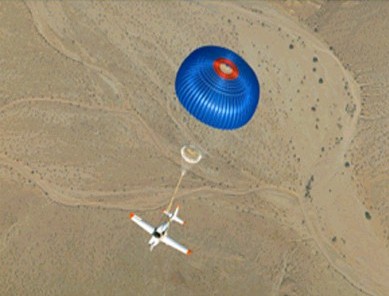
Right now light airplanes are being saved from crashing thanks to BRS's recovery parachutes (RPs). Why not helicopters?
A RP would work on the top of a helicopter rotor mast if it was rocket-propelled vertically and deployed away from the main rotors or in the tail to deploy aft of tail rotors (NOTAR would be ideal). A small inflation of helium into the parachute top to insure that the parachute stays above any main rotors below. If we use a tail-rotor RP, we should deploy an air bag on the nose so when it land it pushes over the tail so it rests upright for faster crew egress. If the helo is on fire, the RP can suspend the fuselage long enough for the crew to bail out if there is enough altitude.
1st TSG (A) EXCLUSIVE!
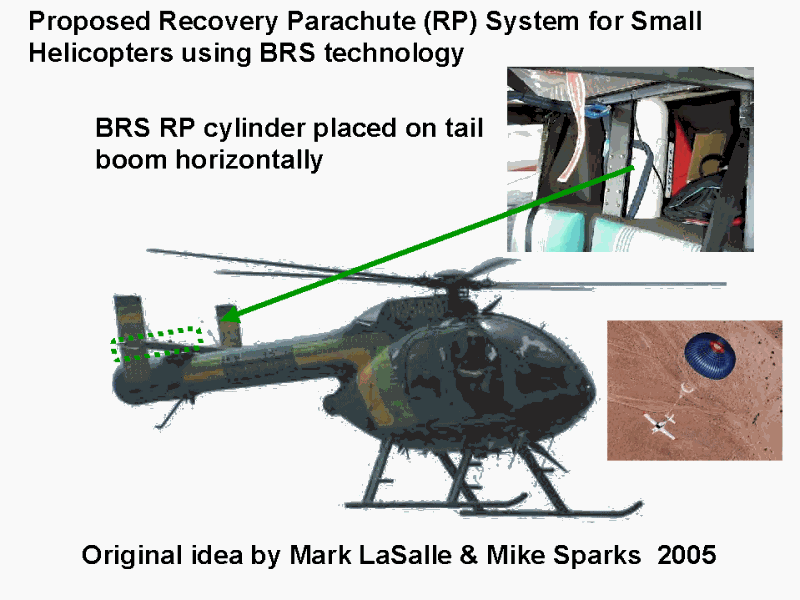
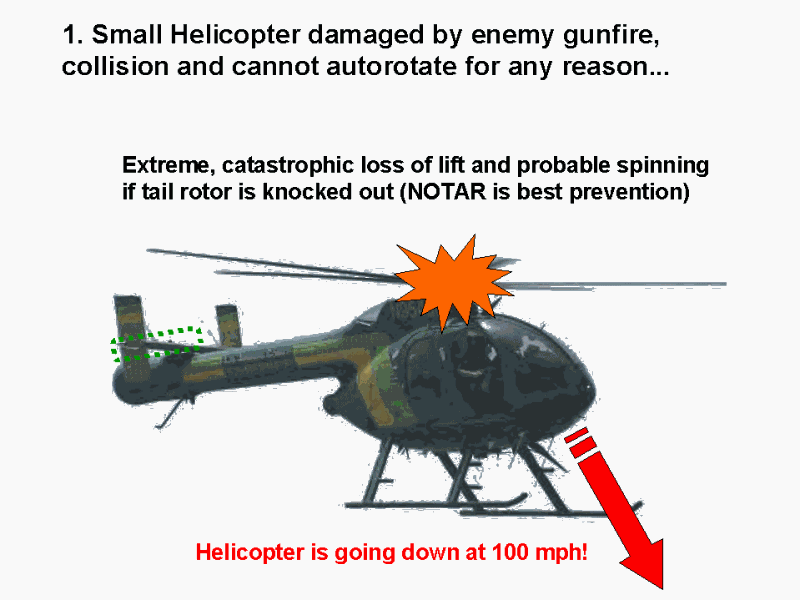
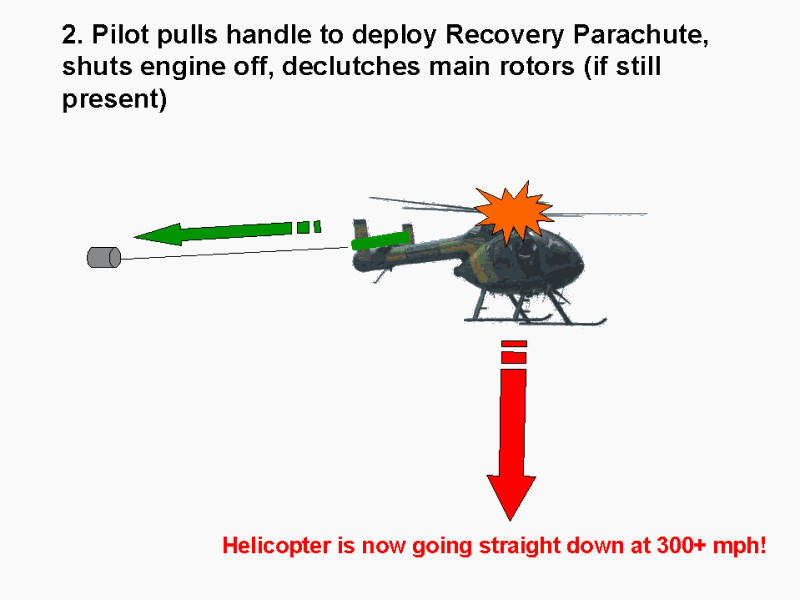
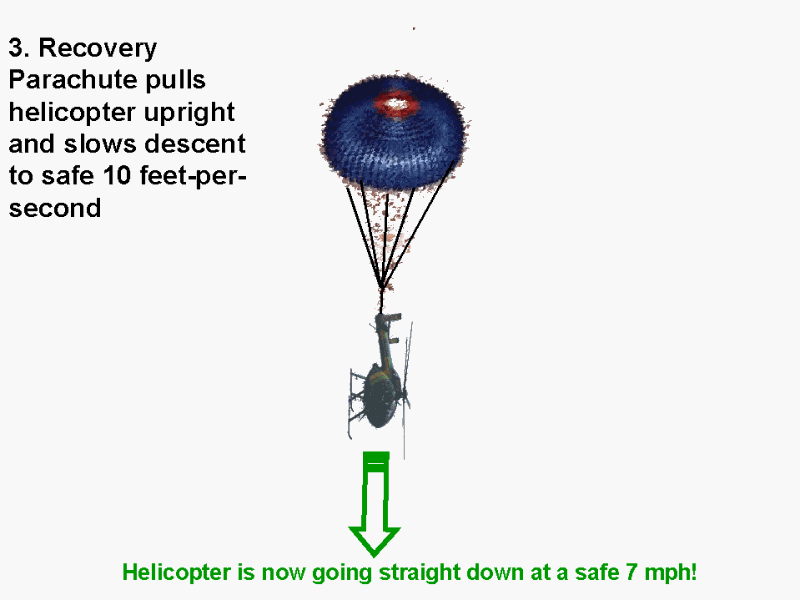
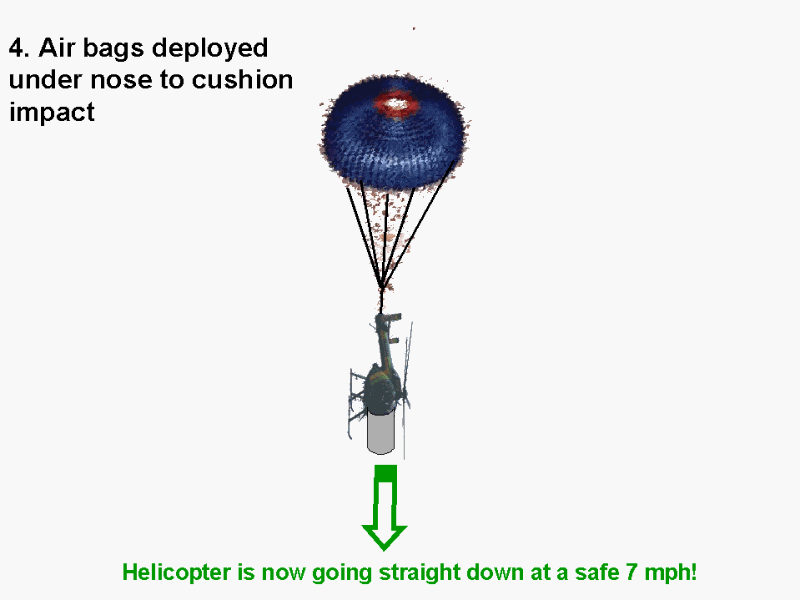
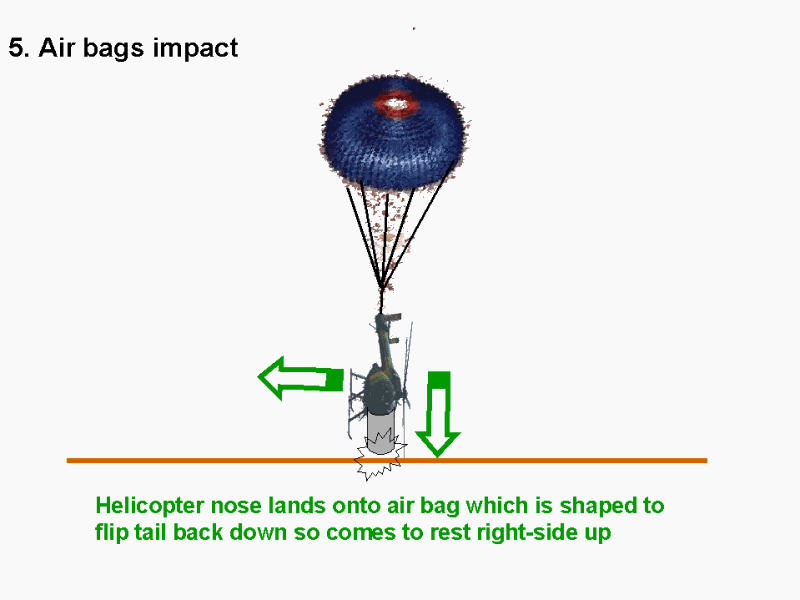
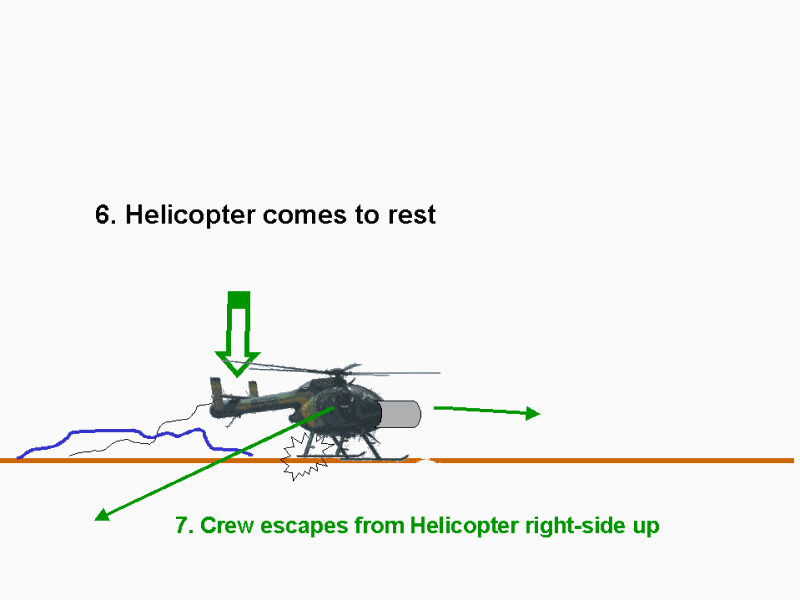
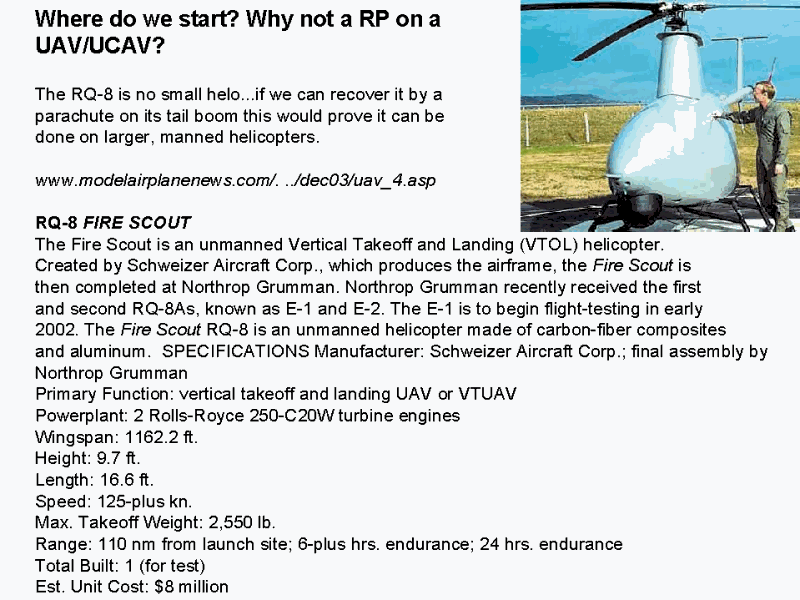
Chopper pilots hold on, we know about auto-rotation as essentially a rotary-wing parachute. However, what if the rotors and/or controls are ruined so you cannot autorotate?
We are putting the entire viability of attack helicopters in question by not offering crew escape. By insisting helicopter crews "go down with their ship" we are narrowly condemning the entire viability of helicopters to go down with it.
However, U.S. Army Aviation is so screwed up it will not even paint its helicopters in the proper sky gray or light tan to blend in with the skies over desert Iraq or simply stop hovering so damn much presenting a stationary target for enemy gunners! You don't see sky-blue USMC AH-1W SuperCobra and UH-1N Huey helicopters circling over Fallujah getting shot down--and they are not even armored. If Army aviators do not even have this much of survival instinct, its questionable that the hubris-filled Army Aviation branch bureaucracy will stop wasting millions of technotoy electronic mental gadgets and put the dollars in needed to field physical things like a crew escape system and the Piasecki ring-tail compound configuration to fly faster at 200+ mph and farther--so we lessen the risks of getting shot down in the first place. Army senior officers are not dying and getting maimed in Iraq, nor are their sons and daughters. However, if they do not wake up and start keeping faith with the brave men/women who ARE in physical danger and start improving their physical protection means, they run the risk of losing their entire "empire" as troops vote with their feet (do not re-enlist or youth even join in the first place). They will end up playting golf in retirement with their general officer buddies reminiscing about the "good 'ole days" when we actually had aircraft in the Army before we became a bunch of pussies driving around in wheeled trucks connected by computers asking the current generation of tactically-inept egomaniacs, "mother may I" and providing a constant stream of feel-good, lying situation reports to make middle-aged men think they are "trigger pullers" when they are not. If they want to be viewed as Rommels and Pattons they can get off their asses and start leading from the front by finding out from the men themselves what's going on away from their lying yes-man staffs and stop wasting MILLIONS on electronic command posts far to the rear where the action is. If helicopters are marginalized as preventable losses mount, all it will take will be rising maintenance costs coupled with replacement platform failures (V-22) and death spiral costs to kill helicopter aviation completely. We will simply be unable to afford to "do" combat helicopters, once the current generation of helicopters are life extended for the last time and no replacement models are in production to reconstitute the force. The 101st Airborne (Air Assault) Division is already slated by HQDA bean counters to lose a huge chunk of its lift assets and will no longer be able to do brigade-at-a-time 3D maneuvers.
Its time we add a crew escape capability to our helicopters starting with RPs on our small OH-58D and LHX successor scout observation/attack helicopters. R & D for a larger RP or crew escape modules should be done for larger UH-60 and AH-64 helicopters. Everyone that boards a CH-47 Chinook should have a bail out parachute.
BRS
John Gilmore
BRS Inc.
300 Airport Road
So. St. Paul MN 55075
(651) 457-7491
Flight School XXI: Narcissistic U.S. Army playing mental video games out of touch with physical realities as its helicopters get shot down in combat
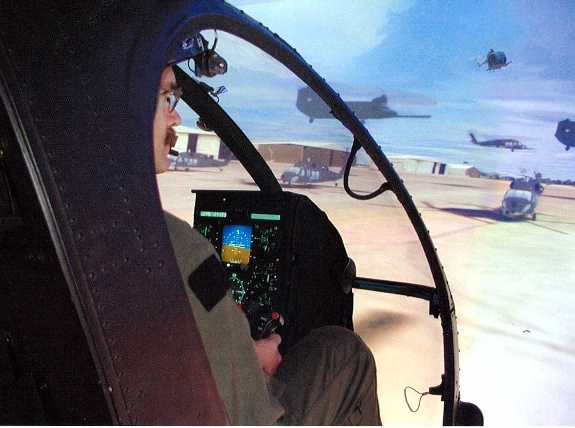
The appeal of being a pilot in the U.S. military is primarily the ego and the inbred, cultural narcissism of "proving your manhood"--this cannot be denied. It should be the adventure of flying not "I-am-better-than-you". The "flight suit mentality" is so strong that in the 101st Air Assault Division when aircrews were ordered to wear Nomex BDUs there was almost a fashion revolt. You can say this is a minor issue and "let the boys have their toys if it makes them happy" etc. they are risking their lives, they deserve it etc. However, this unchecked mentality has disastrous consequences when it results in a disconnect from physical reality.
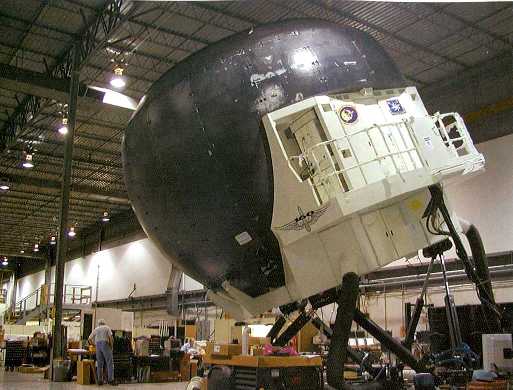
When military aviation is used as a constant prop for a weak ego, reality is distorted into an "its all on you" mentality. When aircraft crash its always "pilot error". The pilot(s) usually dead are not there to defend themselves and their actions. Whenever anything goes wrong its YOUR FAULT, you are feces, you were not good enough etc. ad nauseum. This is simply a childish and dangerous lie. Pilot error even in this "blame-the-dead-man-first-see?-I-am-alive-I-am-better-than-him" environment constitutes only 46% of the cause of all accidents. This leaves the majority of the crashes--54% are caused by things OTHER THAN THE PILOT(S) in case you are challenged at math when it deflates mythologies held in your head.
Considered the greatest pilot to ever live, Chuck Yeager was shot down in WW2.
Read and reread the true statement above a dozen times or as many times as necessary.
Not only that, Chuck Yeager ejected from an out-of-control NF-104 Starfighter jet.
Read and re-read that a dozen times.
When aircraft crash they DO NOT just crash due to pilot error. They crash due to either Pilot, Engine or Airframe (PEA) factors. These factors can be brought on by the earth itself or other humans (combat). Duhh.
You can say you agree with PEA covering all aspects of aviation but if you do not also reject the pilot existentialist narcissism you will get what we have today in the U.S. Army: "Flight School XXI"; where the majority of Army Aviation's budget is spent on "P" pilot mental training while the physical aspects "E" and "A" that represent the 54% of all crash causes are neglected. Real dumb.
In feel-good pilot narcissism and RMA technohubris, Flight School XXI simulations boast that they will make pilots combat ready when they leave and start flying real helicopters! Problem is helicopters are constantly getting shot down in Iraq/Afghanistan because simulators to improve pilot skills are NOT a panacea to cure everything when it only assists in one small part of the problem. However, if you are self and egocentric--you will not see this. You'll love it. Because Bullshit R Us is your motto.
Is it wise to spend $2 BILLION on flight simulators and ZERO on:
a. Aircraft camouflage so they cannot be seen/hit by enemy fire (why are we still flying dark green helicopters over desert brown Iraq/Afghanistan in the blue sky? Is it a wonder we are so easy to shoot-down? The other services have their aircraft painted in sky gray. What are we waiting for? Is paint that expensive?
b. Aircrew escape systems so if they are hit they can survive
c. Making helicopters fly faster/farther/higher so they are less likely to get shot down
d. Rapidly creating landing areas free of sand/dirt/dust brown out risks
Now back to Yeager, he was shot down in WW2 by anti-aircraft fire that his great flying skill could not avoid; you flood an airspace with fragments and cannot fly around it its a matter of chance before you are hit. The weakness of his essentially unarmored and fragile liquid-cooled engine P-51 Mustang is what resulted in him having to bail out. Engine and Airframe. NOT PILOT! Did you hear that pilot-egomaniac?
Notice he bailed out. At least he could, in an U.S. Army helicopter right now--you cannot. Years later, when his NF-104 was in an unrecoverable spin, he pulled an ejection handle and was saved from a fiery death crash. The PEA equation to create human flight needs a humility component that translates the kinetic energy of an adverse flying situation into a life-saving escape or recovery option (R). PEA needs to be replaced with PEA-R. Autorotation would be a part of PEA but often cannot be done. This is stupid. R must be a recovery option independent of PEA. However, right now in Army Aviation, there is no "R" in event of PEA failure, you CRASH. Its ridiculous. Its fatalistic egomania at its worse. You could say, "the egotistical helicopter pilots get what they deserve" (cause---->effect). "They want to spend their money on themselves doing video games instead of facing real world PHYSICAL problems, they dug their grave, now lie in it."
We disagree, we say that this atrocious misuse of Army funds stems from anxiety-riddled senior Army officers who want to further their bureaucratic careers and have spent years of their life inwardly focused on minor procedural BS and pleasing the boss than admitting to outward physical realities head-on, telling the boss things are fu*ked up and then offering answers that will entail risk, courage, imagination, breaking new ground. So yes, rather than develop helicopter recovery parachutes or ejection seats Army aviation brass will spend all their money on exotic video games to feed the culture of individual human ego (P) while the rest of aviation reality; E, A--and R are ignored.
I'm not against what Flight School XXI can do to improve pilot skills. I am against Flight School XXI taking up 99% of Army Aviation's budget and being seen as some kind of panacea and little funds being allocated to E and A and ZERO energies being spent on R.
One of the best places for an escape pod of the aircraft nose separating from the rest of the fuselage would be in HELICOPTERS where getting away from the main rotors would be facilitated. The Navy funded tests in the 1960s proving helicopter escape pods--yet decades later we don't have them and our men are dying needlessly in crashes and shoot-downs.
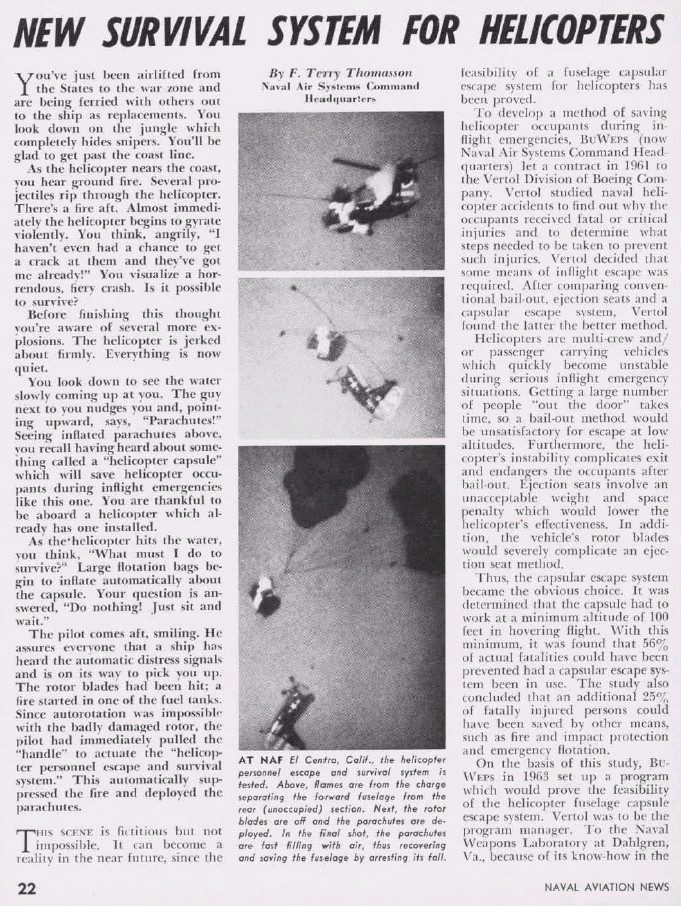
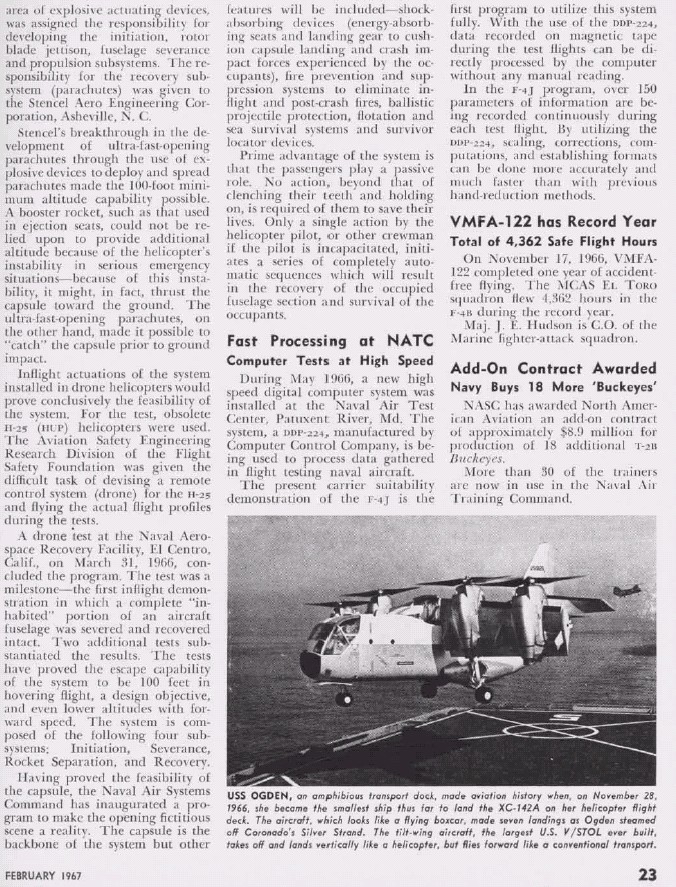
RESCUE
MID-AIR RECOVERY OF PILOTS UNDER CANOPY? OR ROTORS?
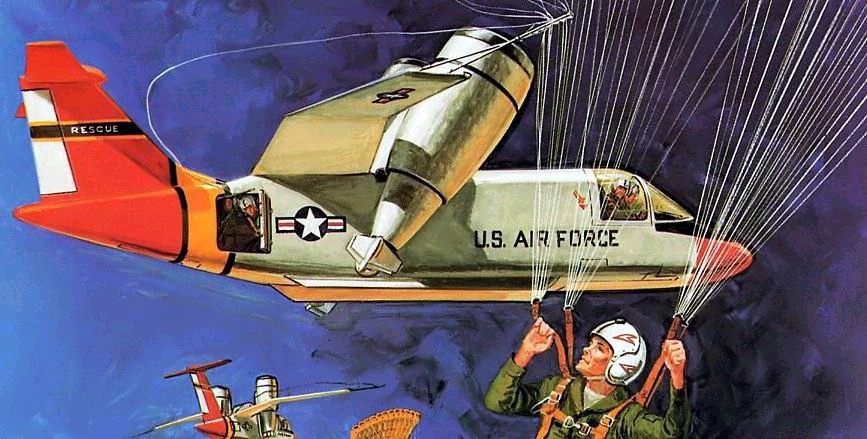

Bosnia. 20,000 feet. A SAM forces CPT Scott O'Grady to eject from his burning F-16 Fighting Falcon. He describes his descent:
"I came down from a pretty high altitude....We've roughly estimated that it took about twenty-five minutes from the time I ejected for me to hit solid ground. It was a long, long ride. It lasted forever. Forever. I was thinking, 'Geez, lets get this done', because it was really windy. I knew that sooner or later I had to hit the ground and start that episode of being in a hostile territory, trying to survive and evade, and hopefully get rescued."
--from Good to Go by Mary Pat Kelly, page 4
Most are unaware that the Desert Storm air campaign was fought at MEDIUM altitudes to evade small arms, light auto-cannon and shoulder fired SAM ADA systems. An aircraft hit at medium altitude (above 5,000 feet) that results in the pilot ejecting will have him descending under canopy at 15 feet per second for 5 minutes or more---plenty of time for the enemy to see him and marshal ground search teams to capture him--or for us to fly in and "snatch" him.
Reading USAF Colonel Jack Broughton's book, Thud Ridge about flying F-105 Thunderchiefs "Downtown" during the Vietnam war, you cannot help but to see his point that many died needlessly after being shot down and all we could do was helplessly watch their parachutes descend to the ground and enemy capture, murder or years of torture in their pow camps. While many were saved by extremely courageous ground pick-ups by USAF helicopters and A-1 Skyraider pilots, many died "So that others may live". The large, daylight rescue of Cpt. Scott O'Grady in war-torn Bosnia was one missile away from disaster, as the single-ship infiltration at night is realistically the only way we can recover men on the ground on the sensor and weapons swept battlefields of the 21st Century. We were very blessed that the Bosnian Serbs couldn't locate O'Grady thanks to his long drift time under canopy and his SERE school-learned evasiveness to use him as "bait" to lure in and ambush rescue forces as the Vietnamese often did.
One of the insights of Colonel Broughton's book was that there should be some way to "snatch" these pilots while they are descending under parachutes before they reach the ground in the first place.
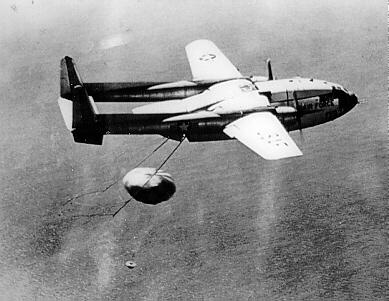
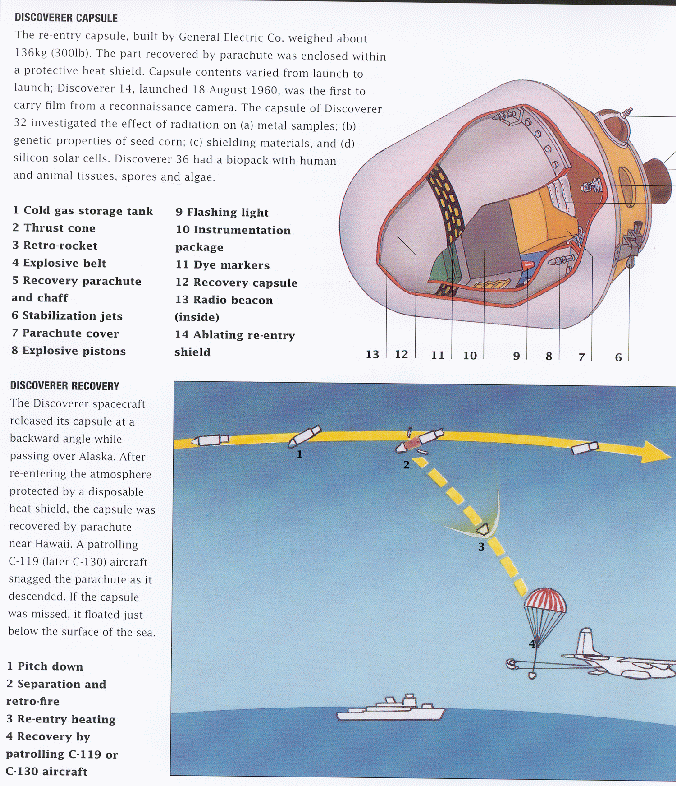
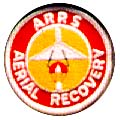
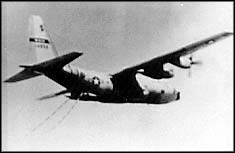
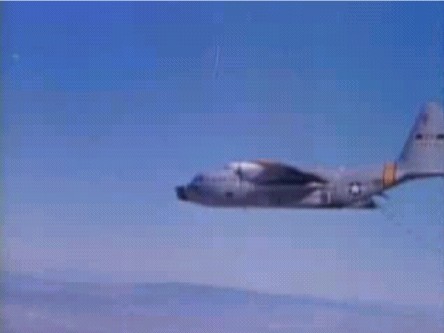
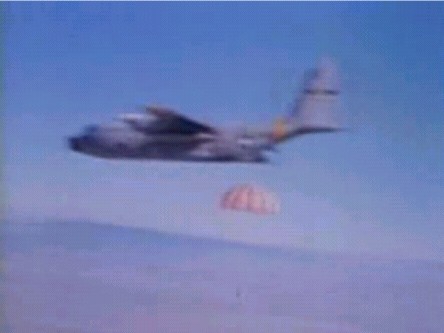
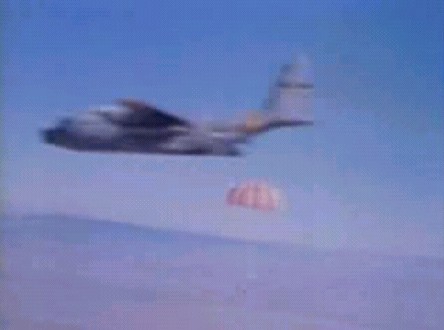
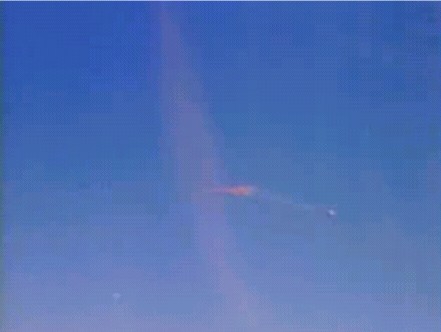
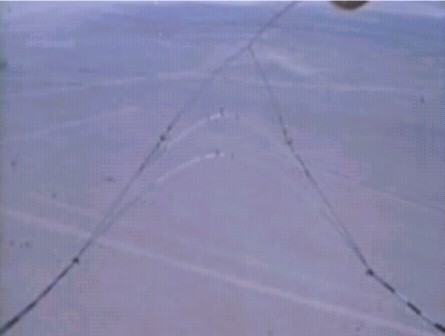
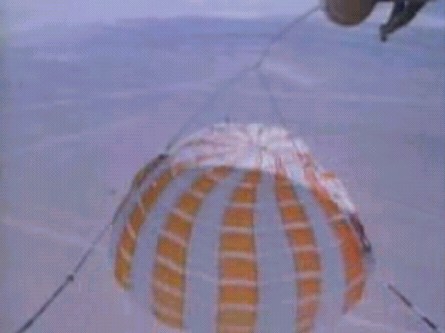
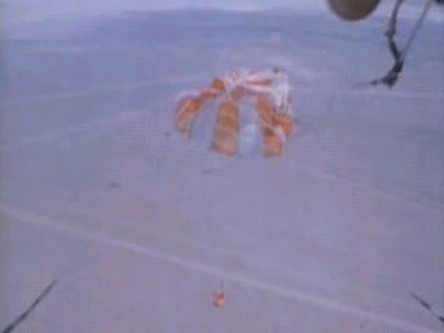
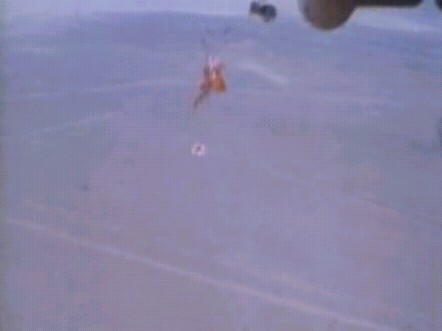
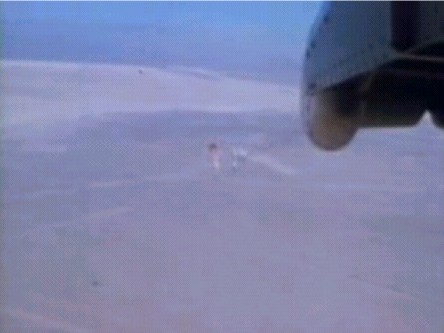
For years, before spy satellite photos were sent by digital link to the ground, actual film capsules were ejected from space and as they floated under a parachute a C-130 Hercules transport flew along and "snatched" the film capsule. We even recently snagged a returning satellite data capsule using a helicopter. Retired USAF Colonel Jerry Thigpen reveals in his book on Combat Talon history, Praetorian Starships that the All-American Company that made the Personnel Pick-Up System used this know-how to snatch satellites:
"All American Aviation did develop a successful engagement system, however, in the late 1960s. The follow-on system enabled C-130-equipped aircraft to snag satellite packages in midair as they parachuted to earth from orbit."
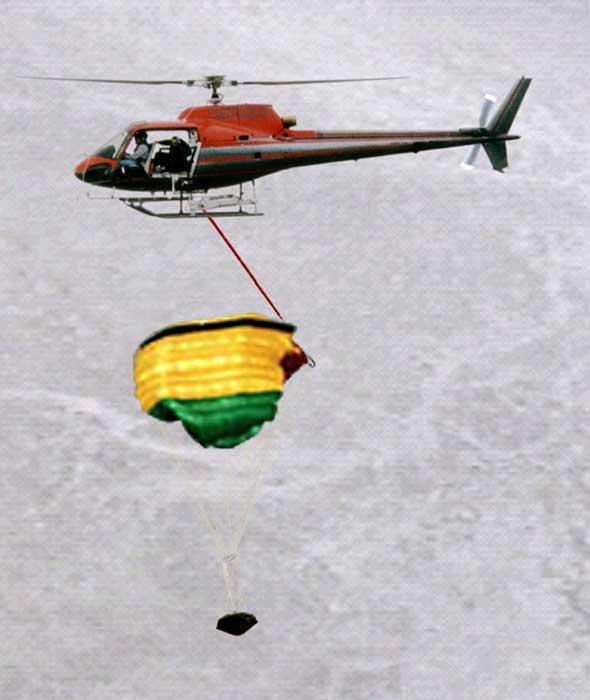
We also launched FireBee drones (UAVs) from DC-130s and recovered them from mid-air by helicopter
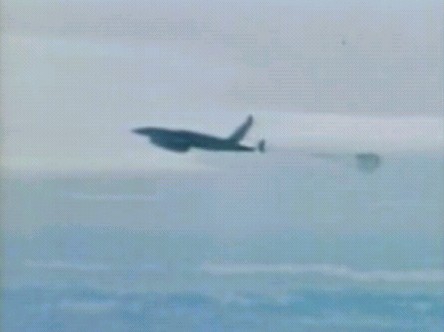
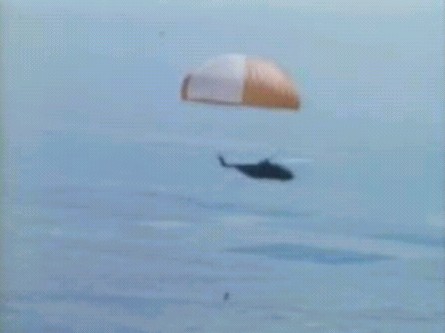
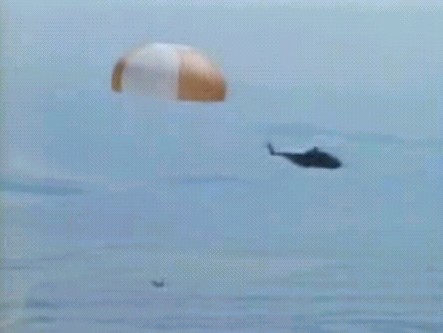
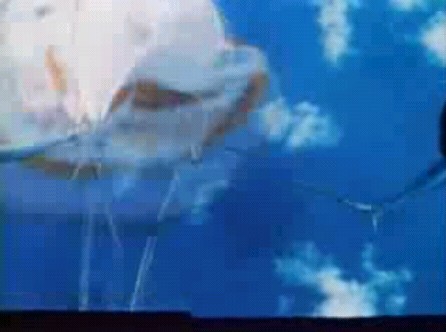
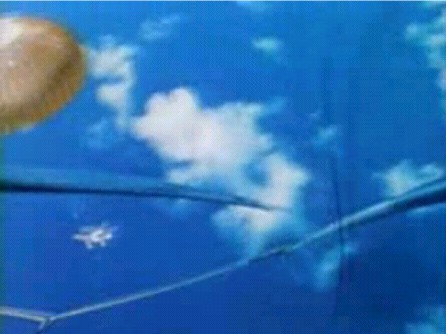
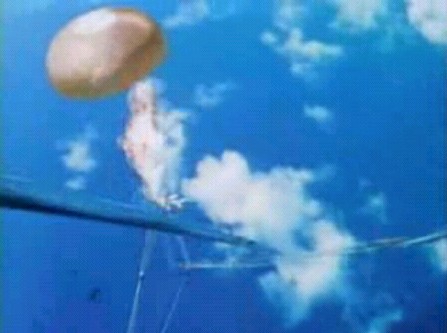
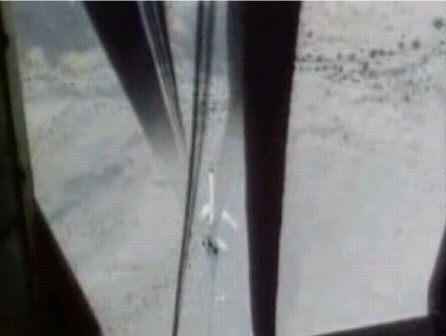
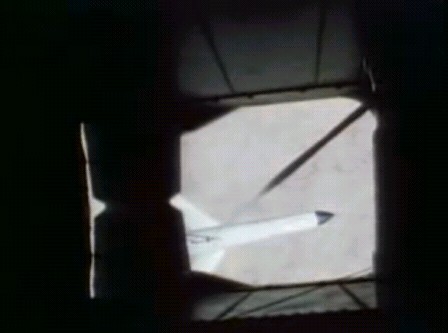
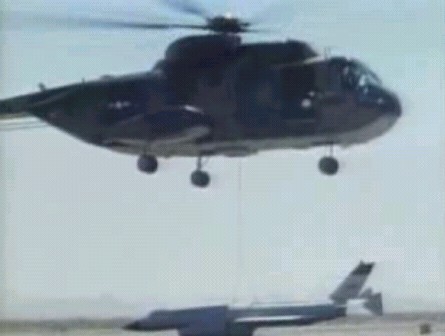
The question is why not have a very agile AFSOC "MC-22" 0r "AV-22" Pave Low IV tilt-rotor aircraft accompany AF strike missions for the sole purpose of swooping in and "snatching" the downed pilot's parachute and reeling him in BEFORE he reaches the ground?
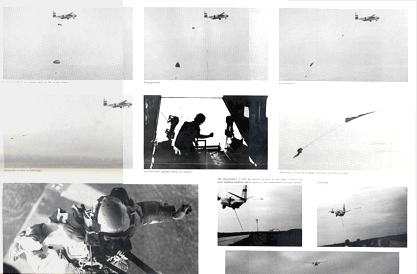




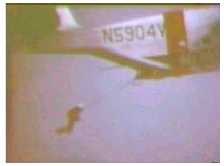
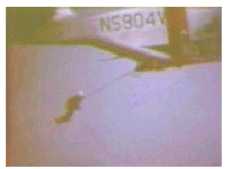


Mid-Air Recovery System (MARS)
 http://youtu.be/aWJCDL3n3dI
http://youtu.be/aWJCDL3n3dI
In the late 1970s/80s BioTechnology in Virginia researched such techniques and found them feasible. Pioneer Aerospace actually conducted tests. We should perfect a mid-air recovery system today before there is another "O'Grady" or Desert Storm Air Campaign.
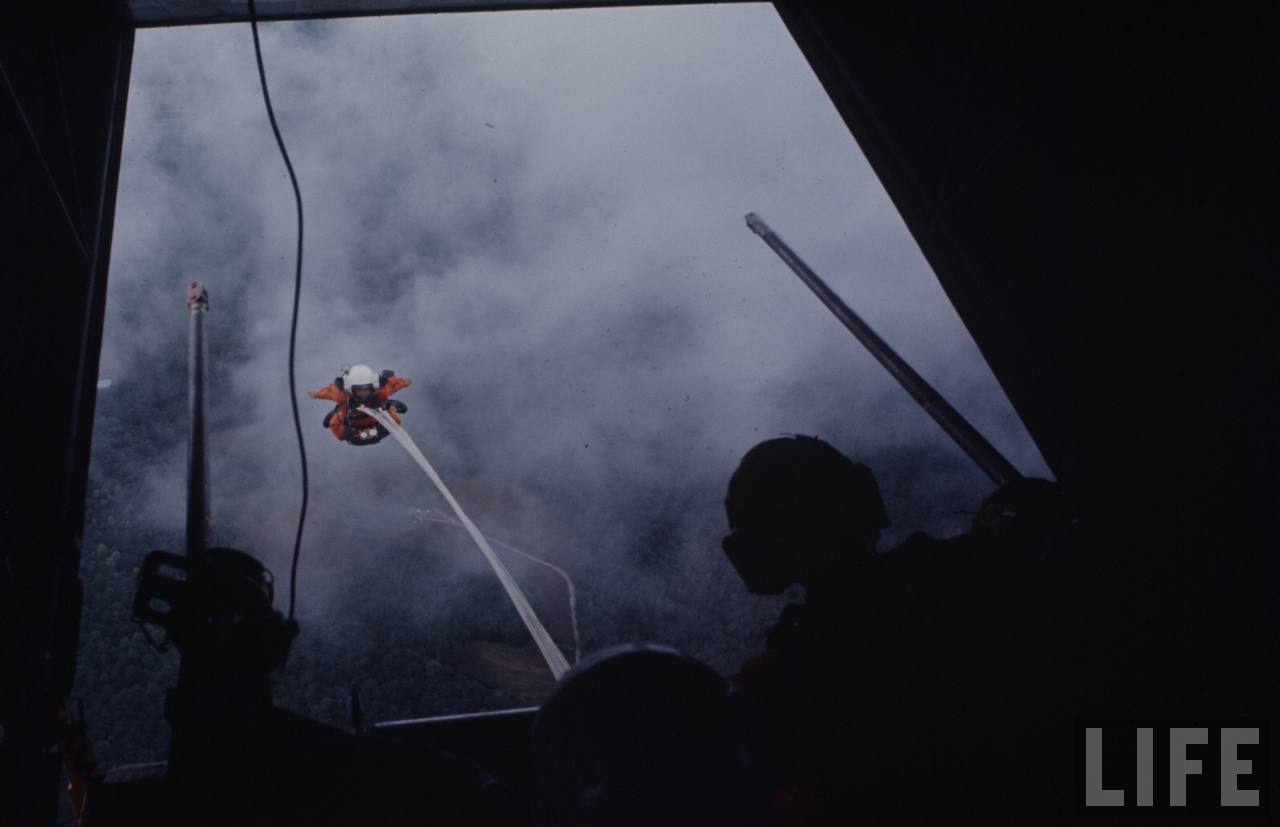
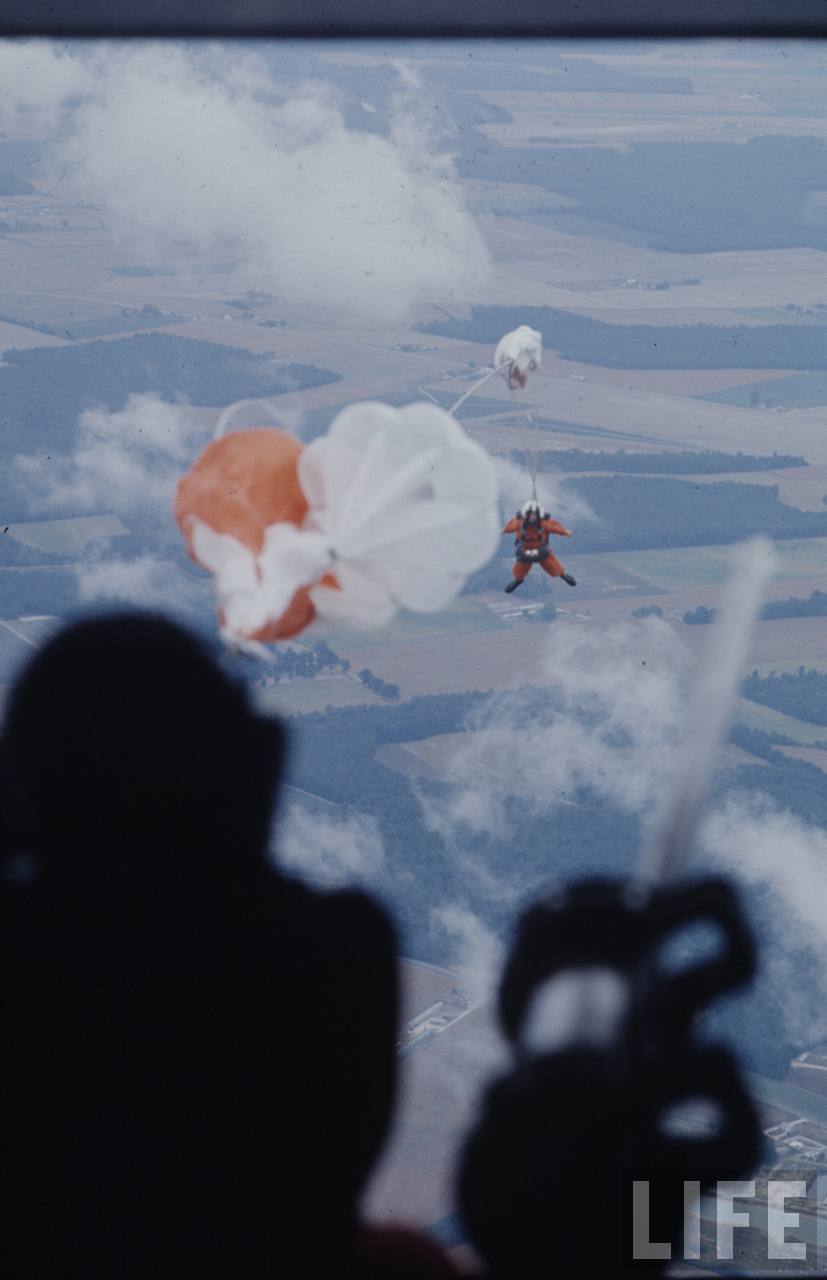
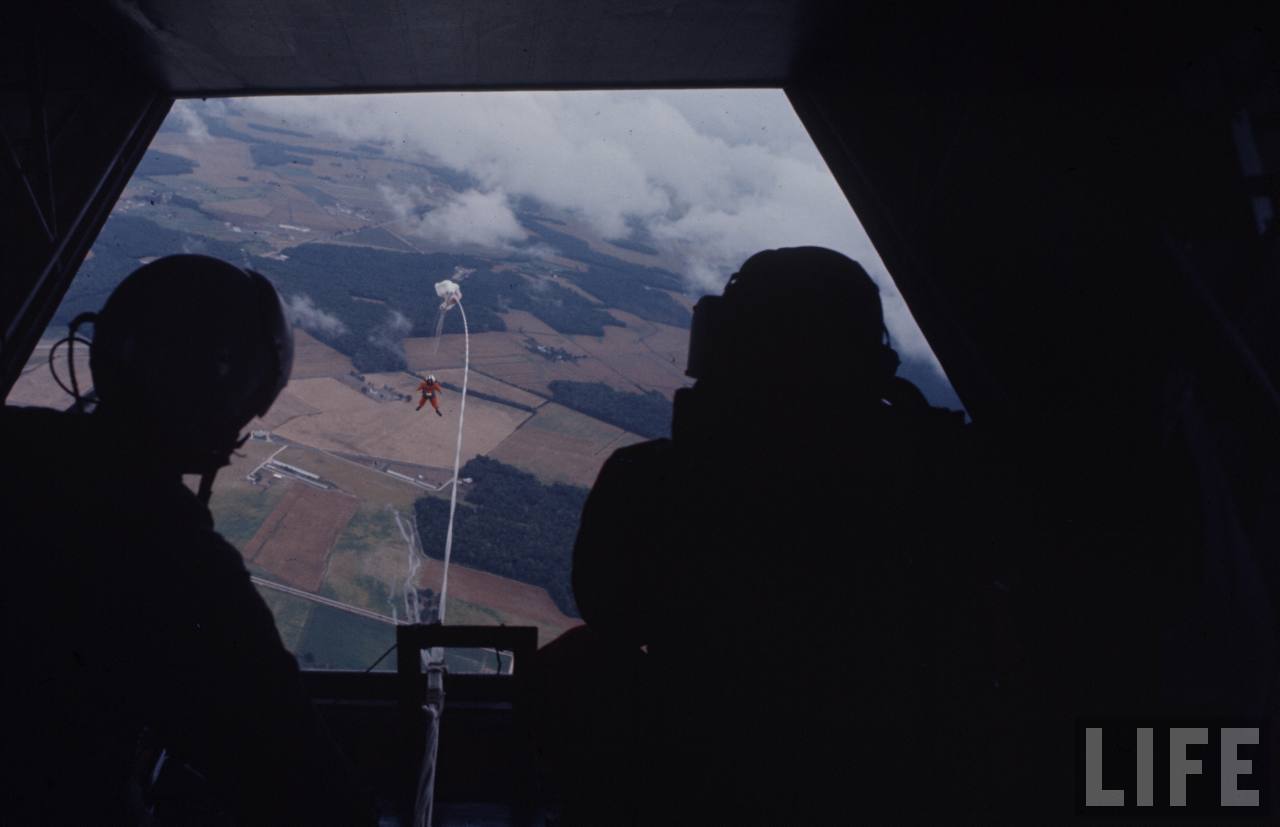
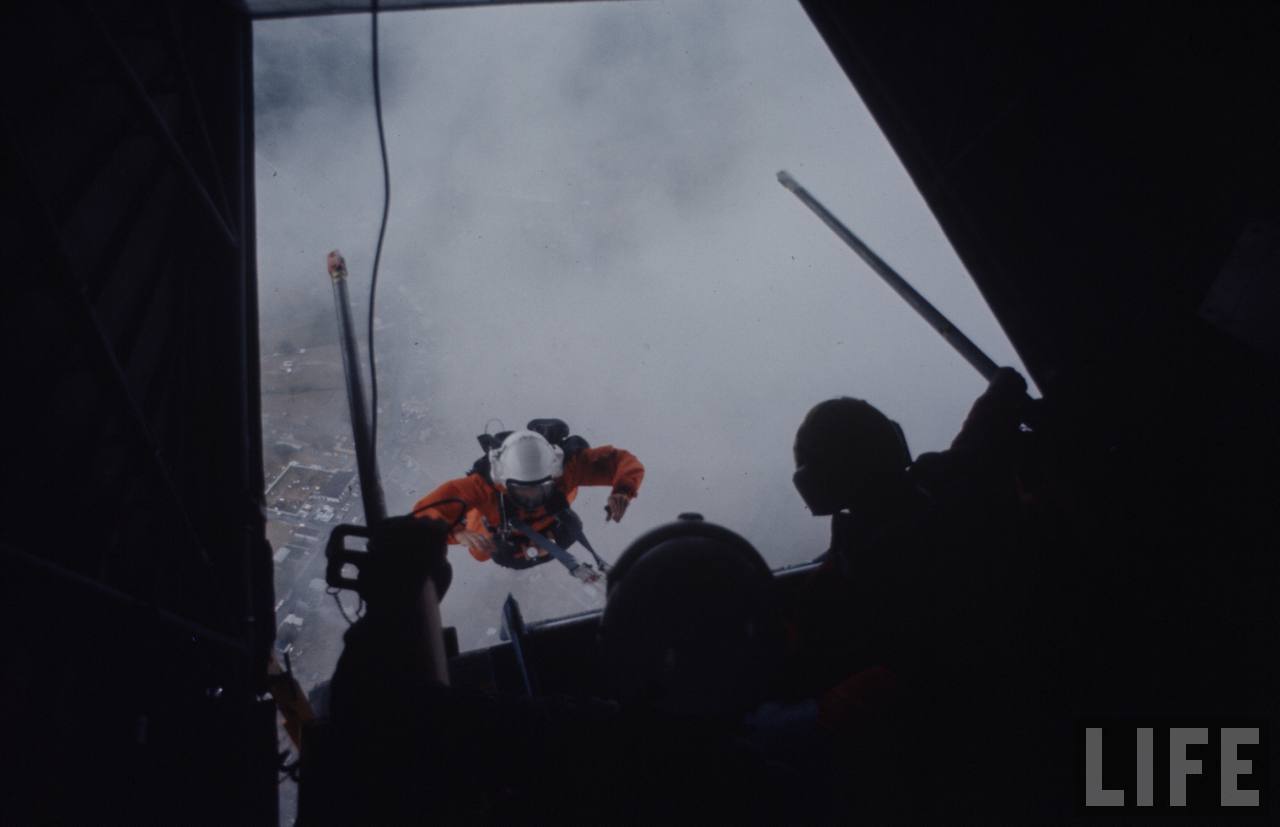
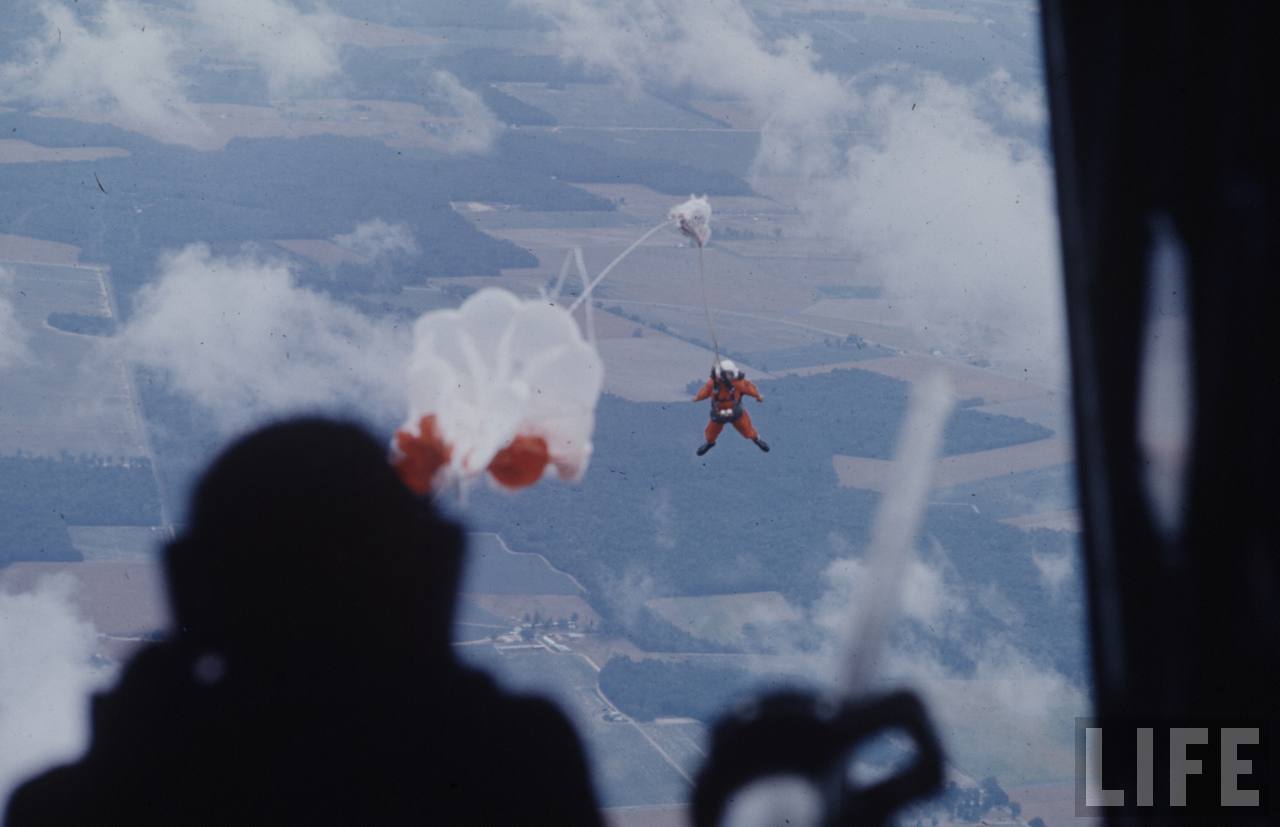
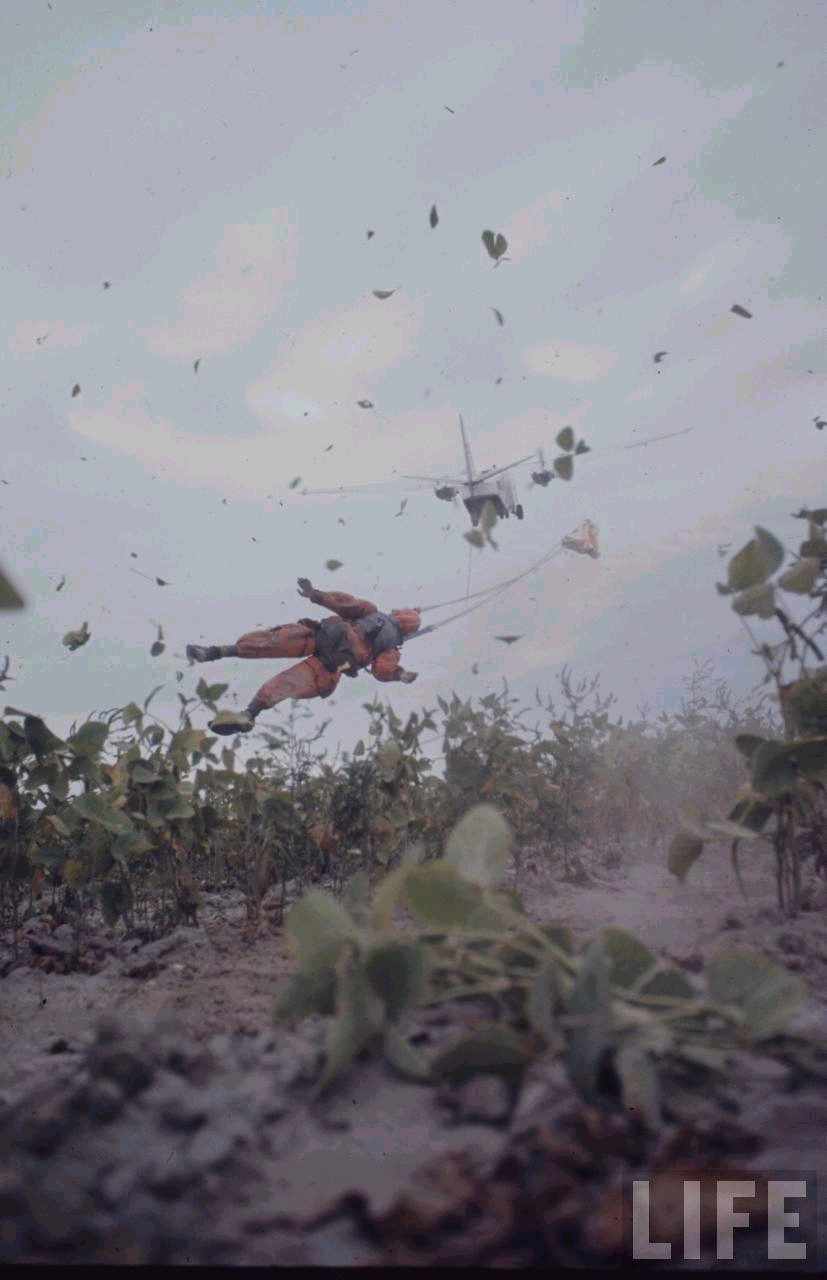
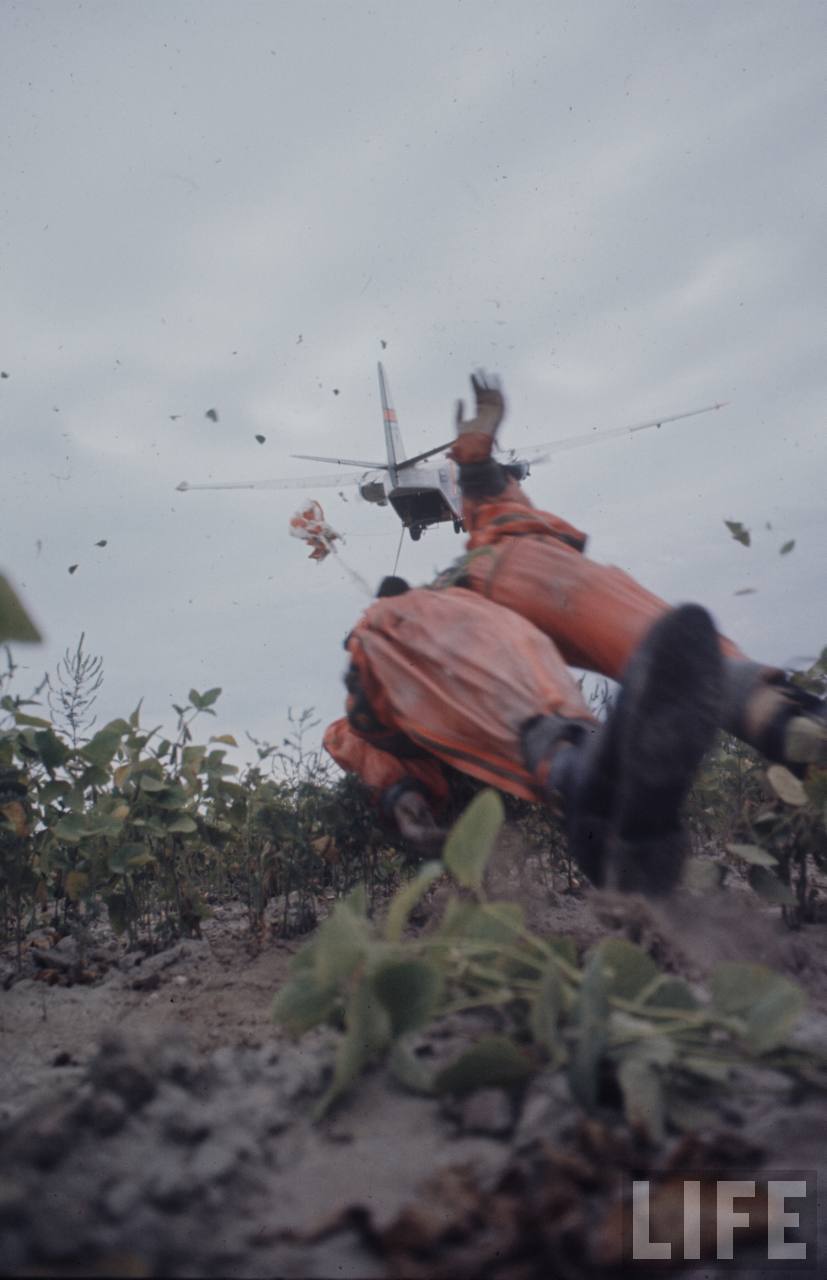
The ideal aircraft for MARS would be one that can slow to a hover to match up with a descending parachute or once snatched can land slowly by a hover with the aircrewman if for some reason he couldn't be reeled in. This aircraft would have a Pararescueman (PJ) with medical skills onboard to "reel him in" like on the MC-130 Combat Talon Is with Fulton STAR systems. Lastly, this aircraft should be a jet capable of high subsonic speed to fly as part of a jet strike package to be there if an attack jet pilot gets shot down for MARS retrieval.
The problem is no current aircraft in the world fits this without modification. The MV-22 "Osprey" is hover-capable and has a rear ramp and cargo area for a PJ and recovery but is too slow to fly along with a jet strike package, though it could fly ahead and stay on station nearby. Another problem with the V-22 is that is unsafe to fly at all...if your burnt to a crisp in a fiery crash you ain't gonna be rescuing anyone. The MC-130 flies faster--especially if a "J" model propfan equipped version were procured, has the rear ramp and the technology used to recover spy satellite film capsule parachutes already exists, though they cannot hover, thus requiring greater pilot skill. The S-3 Viking that used to be flown from Navy carriers is a jet with high subsonic speeds that could be modified to do MARS by removing its sonobuoy tubes and building an open area and rear access opening for reeling the snatched aircrewman in. The AV-8B and the future STOVL F-35 JSF can fly attack jet profiles and hover---if GRIER pods perhaps holding a PJ or reel in by remote control--and with MARS were created, they could look like all the other jets in the strike package until a pilot retrieval was needed. In fact with a GRIER MARS system ANY U.S. fighter or helicopter that can accept a bomb rack could become MARS-capable. If the pilot couldn't be reeled in for whatever the reason he would be flown to safer airspace and released with a new parachute deploying to supercede the one caught in the MARS apparatus.
BUDDYHOOKTM: Every Fighter Plane a Rescue Plane
slideshare.net/1st_TSG_Airborne/f35-jsf-spec-ops-6to14
Legendary inventor Robert Fulton tested and perfected his SkyHook system using his own Stearman light plane's left wing to carry the whiskers to snatch tethered balloons.
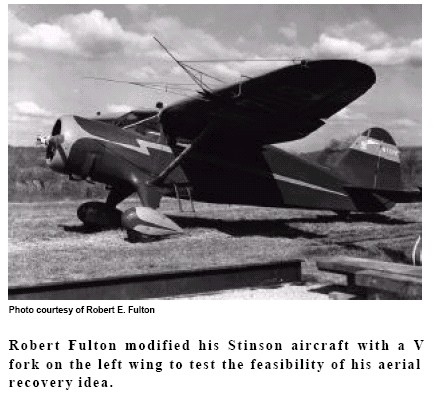
So why not have EVERY fighter plane equipped with STAR whiskers on a wingtip so if a buddy pilot gets shot down and ejects, his parachute can be snagged by an already-on-the-scene aircraft and he could be towed back to a safe area for release?
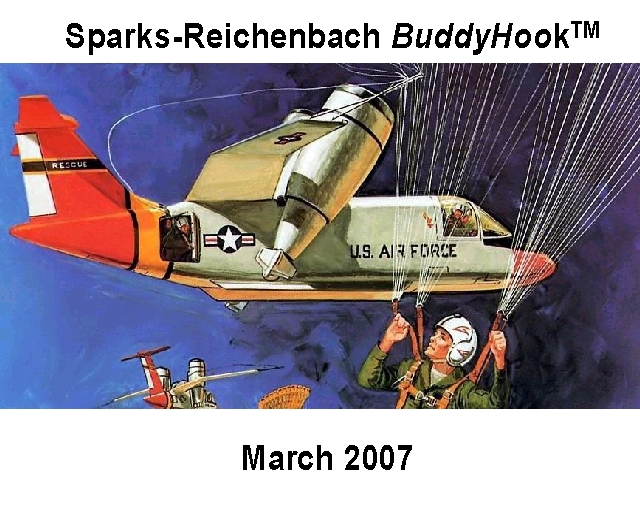
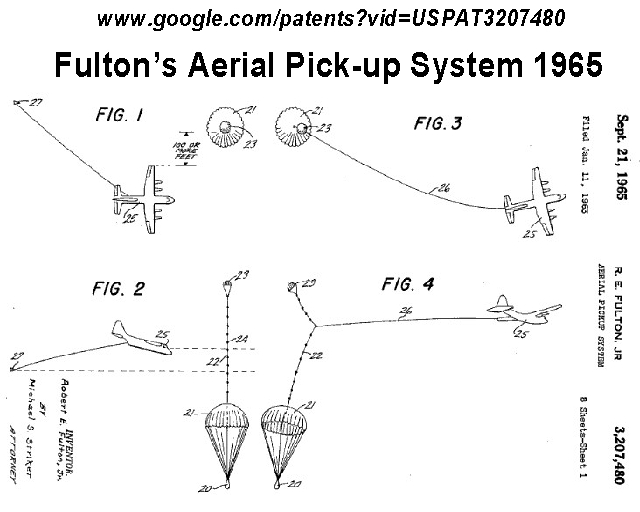
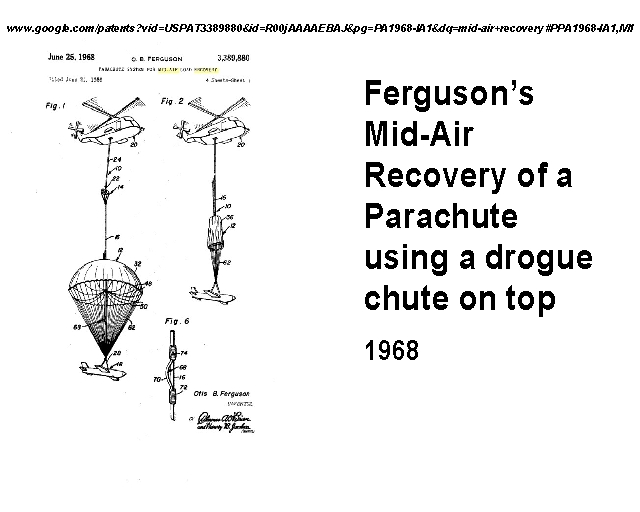
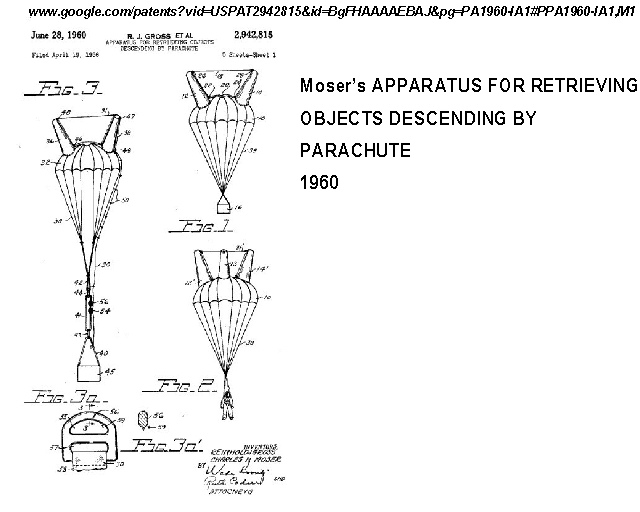
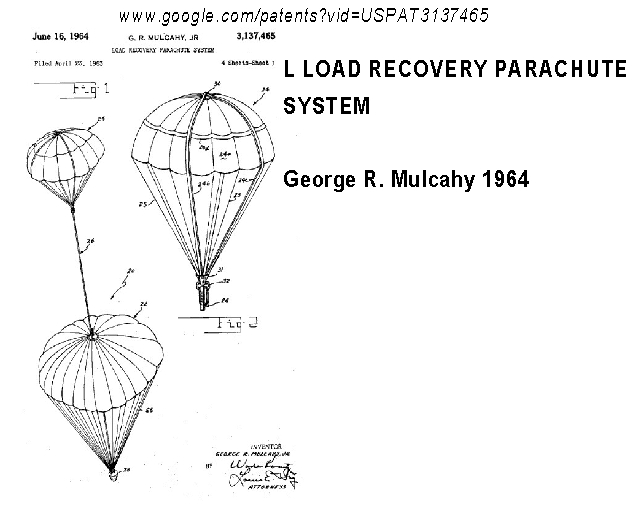
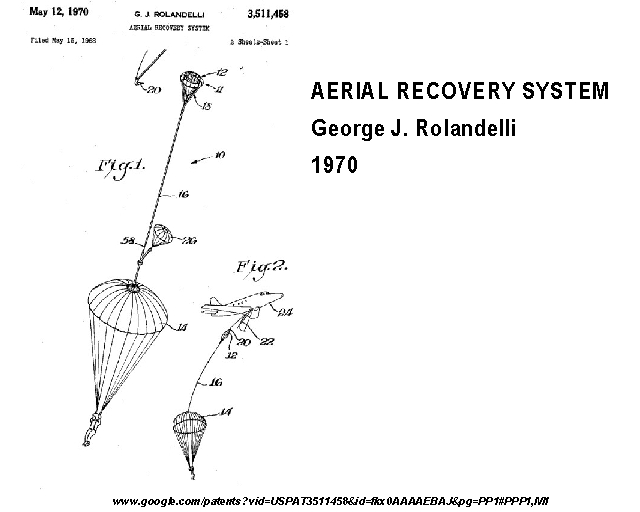
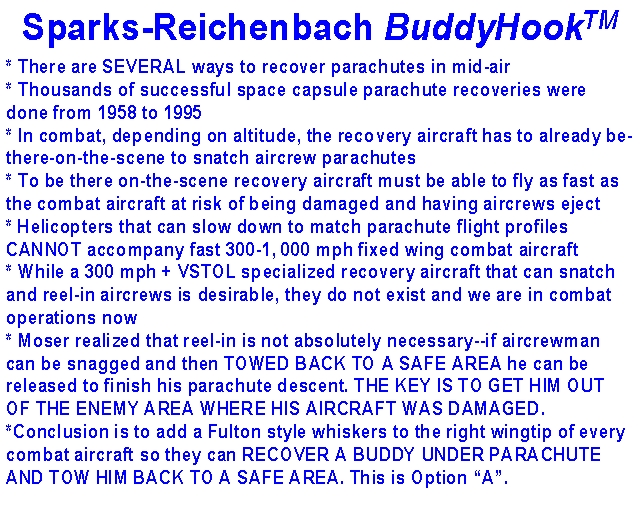
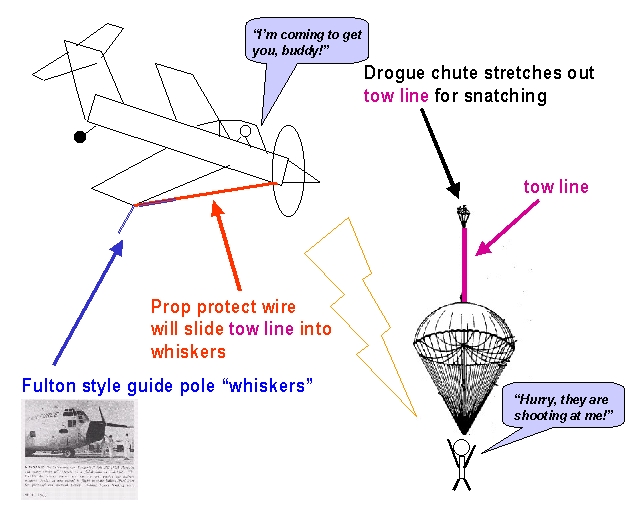
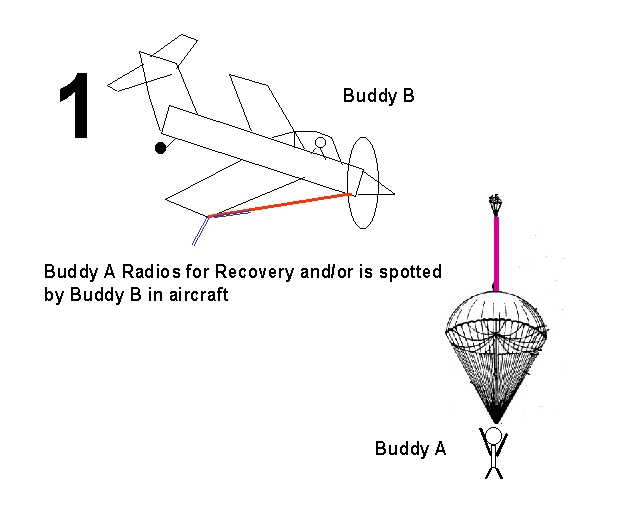
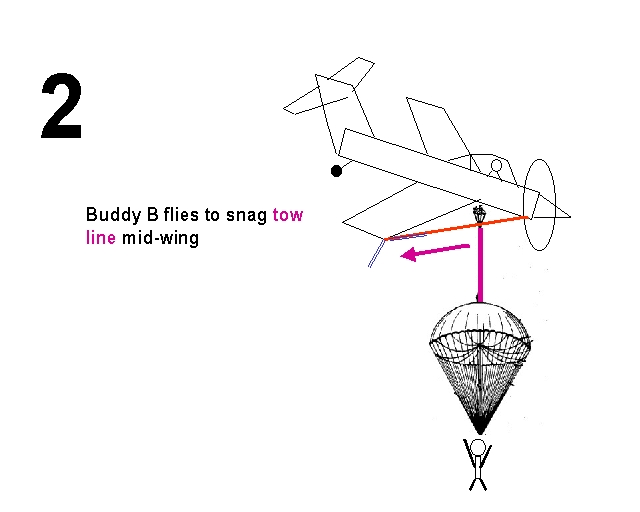
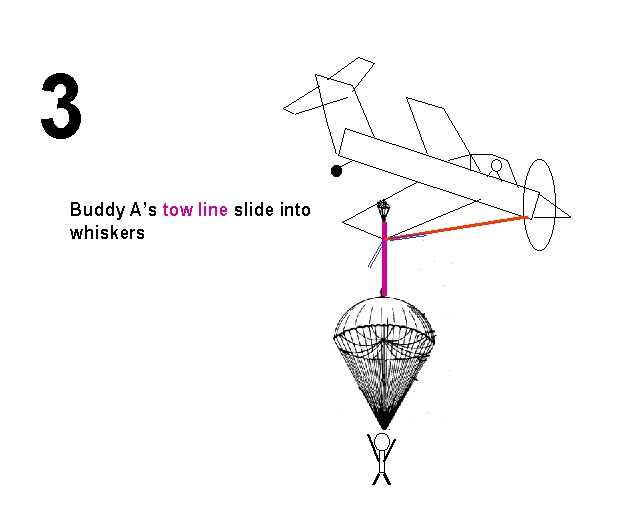
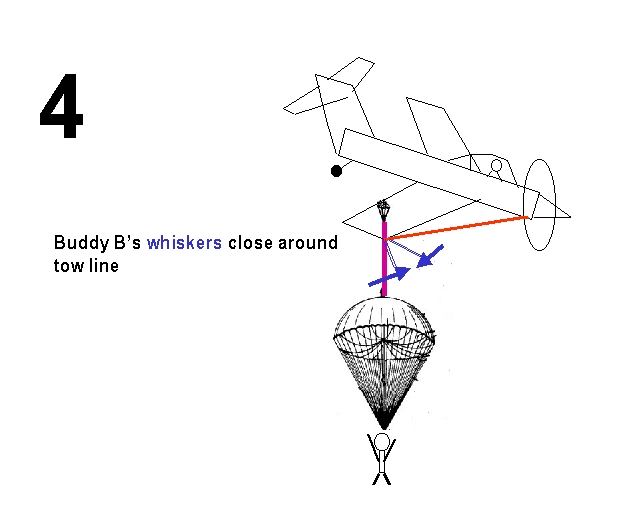
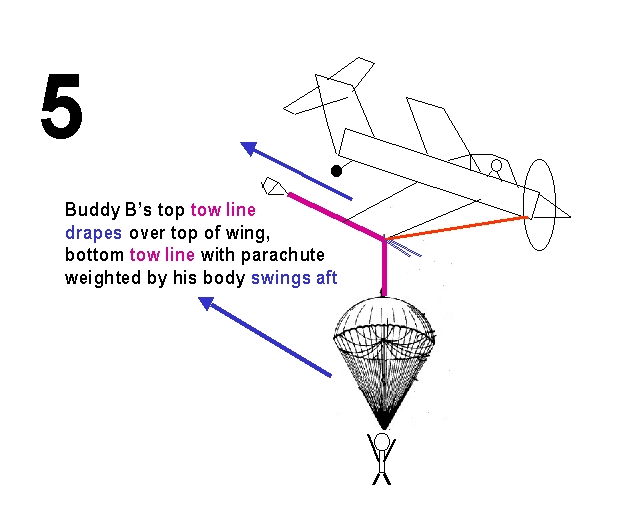
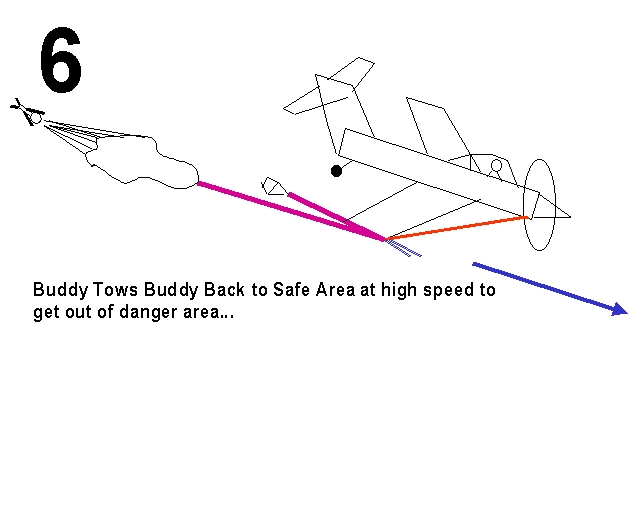
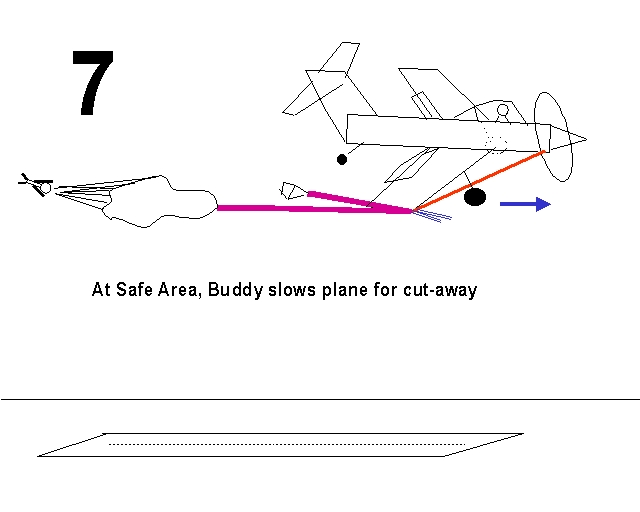
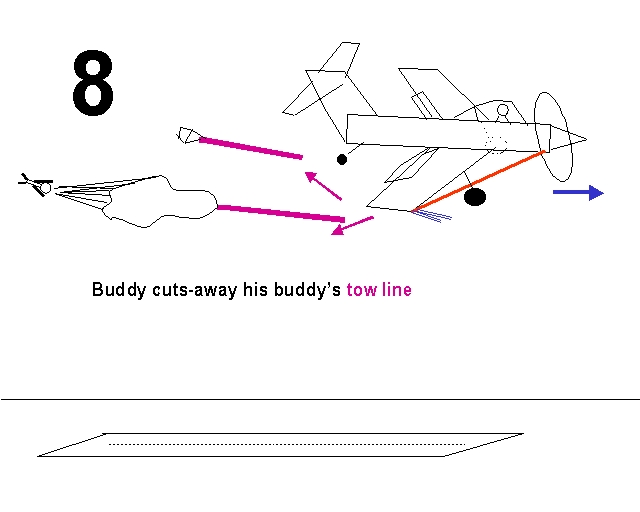
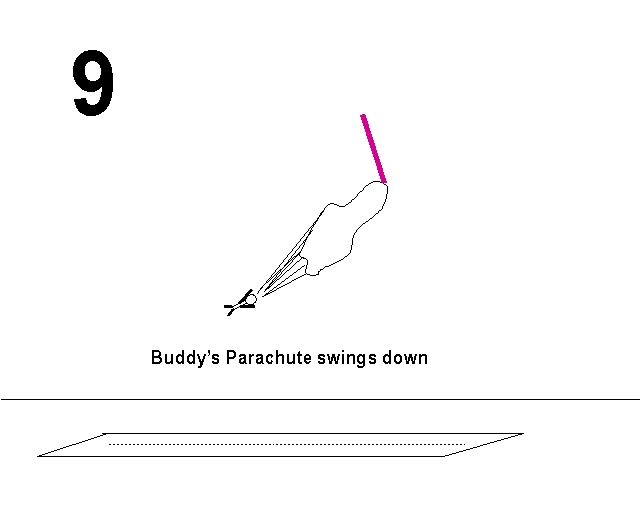
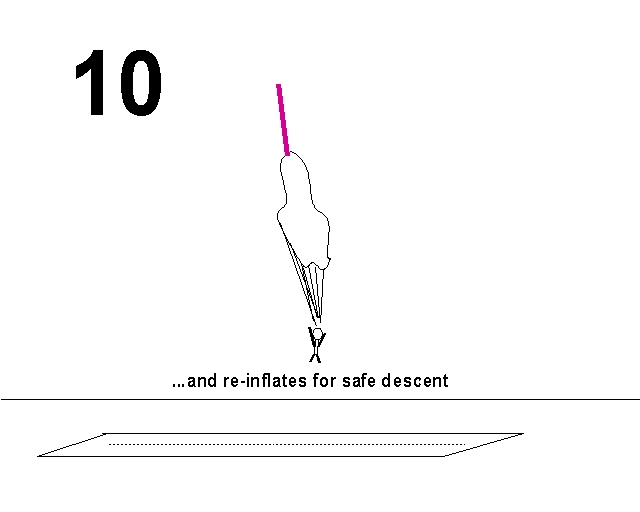
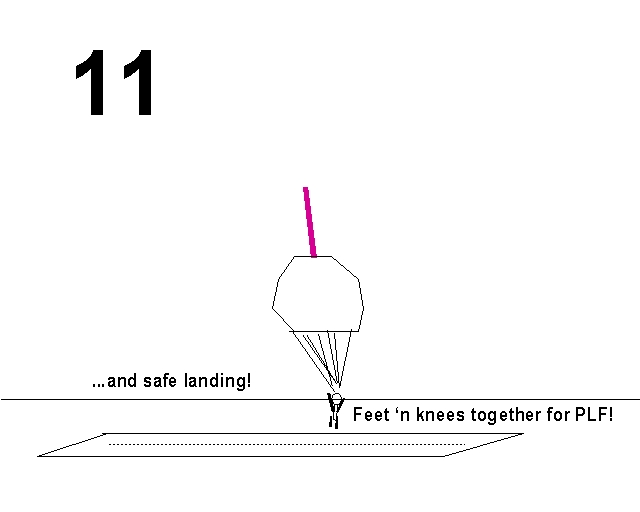
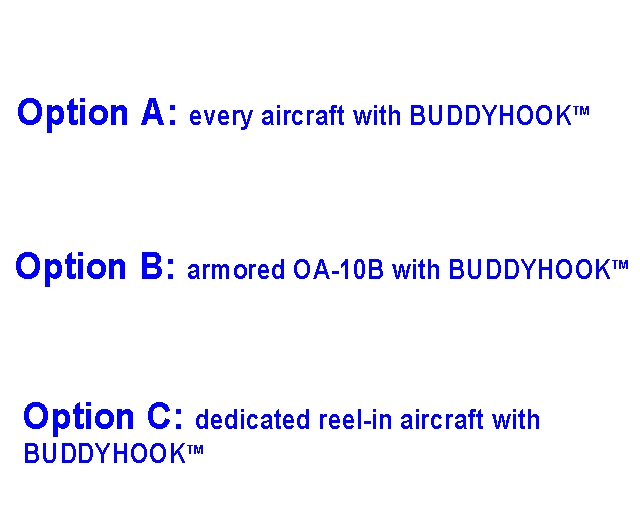
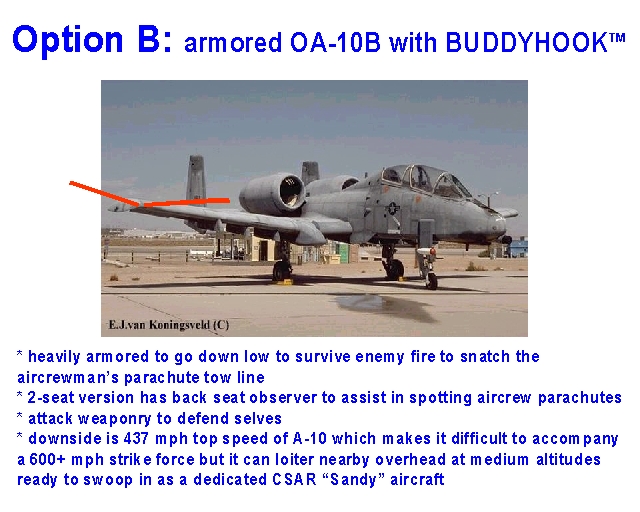
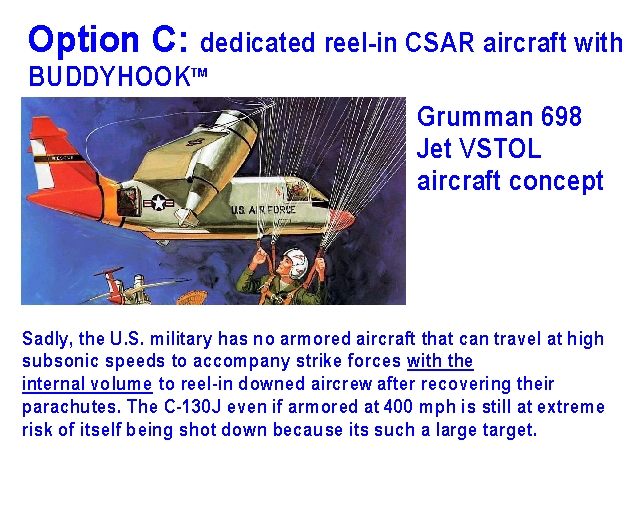
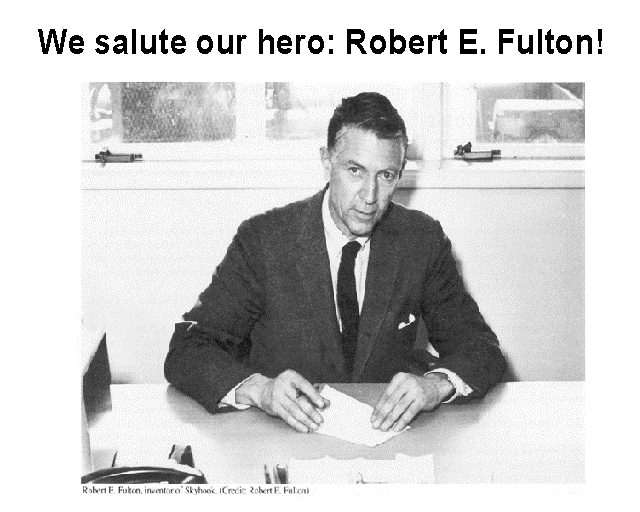
slideshare.net/1st_TSG_Airborne/buddyhook-midairrecovery-by-towing-v20
Fulton Surface-To-Air (STAR) SkyHook: Still a Great Idea that the current Cowardly Generation has Given up on
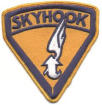
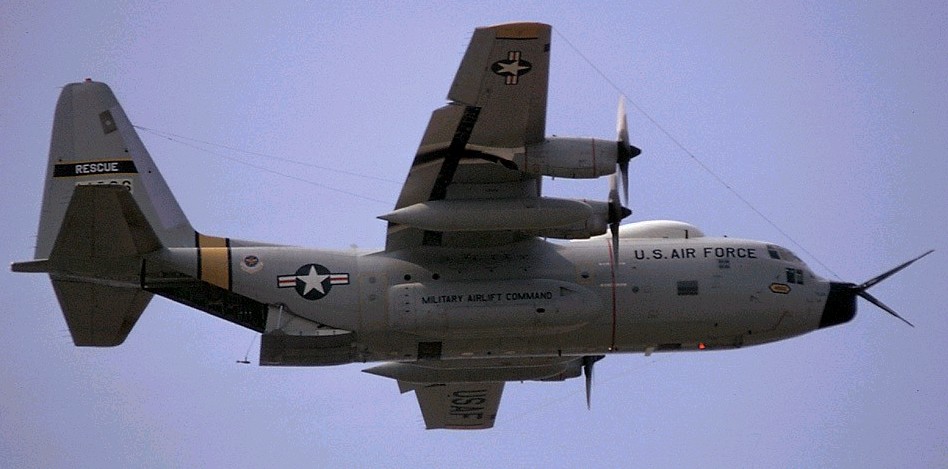
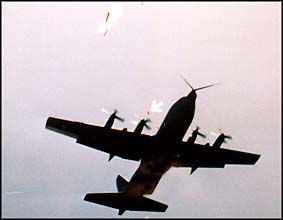


 youtube.com/watch?v=dekJ2Ip7koo
youtube.com/watch?v=dekJ2Ip7koo
 www.youtube.com/watch?v=PErEsNhDmo8
www.youtube.com/watch?v=PErEsNhDmo8
This is a short clip. The entire video is 30 min. For more details go to:
militaryvideo.com/store/cfm
This video documents the use of the Fulton Recovery System by C-130 Hercules aircraft at Edwards AFB in 1966 and at Phang Rang AB in 1968.
 http://www.youtube.com/watch?v=dLoz0H-44e8
http://www.youtube.com/watch?v=dLoz0H-44e8
BEST HISTORICAL REFERENCE:

USAF Colonel (R) Jerry Thigpen's
Message Pick-Up to Glider Pick-Up
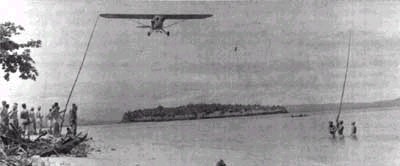
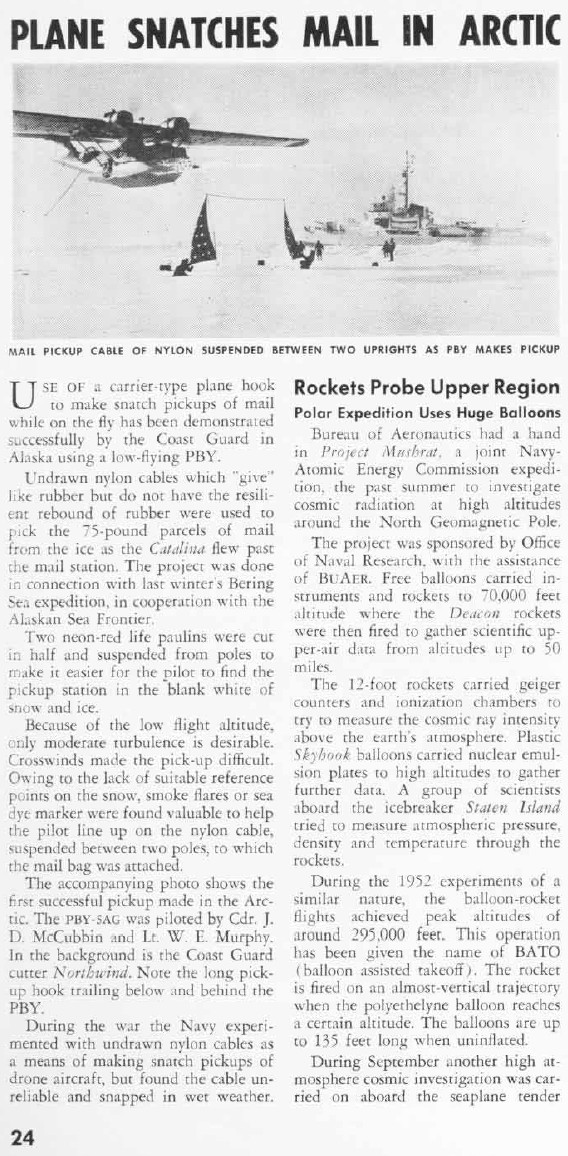
The architects of the U.S. Army Air Forces glider program determined in the spring 1942 that the large troop and cargo gliders under development were simply too expensive to be abandoned after one combat mission. The fields and pastures in which gliders landed were usually too small and the terrain too uneven for a plane to land and retrieve the gliders. Another means of recovery had to be found. To find an answer to their problem the Air Force turned to Richard C. du Pont, a 1930s national glider soaring champion and the president of our company (All American Aviation) of Wilmington, Delaware. Several years earlier, DuPont's company had developed an aerial retrieval system to pick up U.S. Postal Department mail pouches from the ground by an aircraft on the fly, and had demonstrated to U.S. Air Force officials at Wright Field, Ohio, on 18 July and 22-28 September 1941 that aerial retrieval of gliders was feasible.WWII U.S. Army Air Force Glider Aerial Retrieval System
Compiled by Leon B. Spencer, former WWII Glider Pilot
The architects of the U.S. Army Air Forces (USAAF) glider program determined in the spring 1942 that the large troop and cargo carrying gliders under development were simply too expensive to be abandoned after one combat mission. The cheapest unit price for a 15-place CG-4A was $15,580, while some companies charged much more. The fields and pastures in which gliders landed were usually too small and the terrain too uneven for a [powered] plane [with wheeled landing gear] to land and retrieve the gliders. Another means of recovery had to be found. To find an answer to their problem the Air Force turned to Richard C. duPont, a 1930s national glider soaring champion and the president of All American Aviation of Wilmington, Delaware. Several years earlier, DuPont's company had developed an aerial retrieval system to pick up U.S. Postal Department mail pouches from the ground by an aircraft on the fly, and had demonstrated to U.S. Air Corps officials at Wright Field, Ohio, on 18 July and 22-28 September 1941 that aerial retrieval of gliders was feasible.
The aerial retrieval of objects from the ground was not new in aviation. The marines were using a rudimentary aerial pickup system as early as 1927. The system was simple but functional. A wire with a weight on the end was trailed behind a surplus World War I de Havilland single-engine D.H. 4 biplane. As it flew over the ground station the trailing wire engaged a rope loop suspended between two poles to which was attached a leather pouch, probably containing dispatches.
In 1939, Richard duPont teamed with Dr. Lytle S. Adams, a dentist/inventor from Morgantown, West Virginia, and formed the All American Aviation Company in Wilmington, Delaware, duPont's hometown. Dr. Adams had designed an aerial retrieval system in 1938 but lacked the financial resources to develop and market his product and needed a partner with money. Mr. duPont, a member of the wealthy E. I. DuPont family, was the perfect choice. Their new company performed a number of experiments with Adam's system and made some improvements. On 12 May 1939, All American began operating on a demonstration basis two mail routes extending from East Coast cities along strings of small towns through the Appalachian Mountains to Pittsburgh, Pennsylvania. The company used a specially equipped single-engine Stinson SR-10C monoplane to pick up U.S. Postal Service mail pouches on the fly at rural towns having no airport. To satisfy the requirements of the Postal Service All-American Aviation fitted its aircraft with the company's AAS-4 internal cable winch with a braking mechanism. A cable ran through guides to an external boom mounted on the fuselage and then to a hook at the end of the boom. The system functioned much like a fishing rod and reel. The pickup airplane would fly low (approximately 20 feet above the ground) over the pickup station and hook a nylon loop stretched between two poles approximately 12 feet above the ground. Just as the hook snagged the loop the pilot would pour on the power and climb away at a fairly steep angle, dragging the mailbag behind the plane on the cable. At the moment the hook made contact the winch would feed out cable to absorb the inertial energy of the pouch weight. The operator would then retrieve the pouch by rewinding the steel cable.
The aerial retrieval demonstrations conducted by AM July and September 1941 used the Model AAS-4 pickup winch installed in a company Stinson SR-10C high-wing monoplane. The Stinson successfully snatched a 500 pound gross weight "Midwest Utility" glider containing a weighted pilot dummy from the ground. Following the demonstrations, AM issued a report proposing that they could build a system to pick up heavier gliders.
During further tests in 1942, All American Aviation used the Stinson SR-10C to successfully snatch a two-place, Schweizer XTG-3 military training glider from the ground at Clinton County Army Air Field (CCAAF), Wilmington, Ohio. Mr. duPont himself piloted the glider. As a safety feature the company aircraft was equipped with cutting knives mounted in front of the wheels in the event that the tow rope should snag on them. During further demonstrations a propeller-less Piper Cub was successfully snatched from the ground. That same year glider aerial retrieval demonstrations were conducted at CCAAF with the larger and heavier 9-place Waco XCG-3 troop/cargo glider. A twin-engine, Douglas B-23 Dragon bomber equipped with the newly developed AAA Model 40 system was used as the pickup aircraft. Like duPont's Stinson, it too was equipped with cutting knives mounted forward of the landing gear. Colonel Frederick Dent, head of the Glider Branch at Wright Field, piloted the XCG-3 for the first test in December 1942. It proved successful. Army Air Force contracts to AM were let in 1942 to provide pickup equipment initially for training gliders, and finally for gliders weighing from 8,000 to 16,000 pounds. A new Model 80 heavy-duty pick up system was subsequently designed incorporating improved braking systems that made use of a "time delay" function where the first several drum rotations had a reduced braking force to allow the drum to accelerate without applying high cable loads, and then the final brake force was gradually applied until the preset line tension was established. Much of the credit for the successful development of the M-80 system belongs to the AAF's Captain Chester Decker, who first tested its military application and who taught its use at Laurinburg-Maxton AAB, North Carolina, to hundreds of power pilots.
Initial flight testing of the M-80 system was conducted at AAA's DuPont Airport in Wilmington, Delaware, in the first half of 1943, but subsequent primary testing was switched to CCAAF. An 1821 foot nylon tow rope, 15/16 inches in diameter, was initially used for the Waco CG-4A tests. One end of the tow rope was connected to the nose of the glider, while the other end was connected to a closed loop of nylon rope, 80 feet in circumference, which was draped over the top of two 12 foot stanchions spaced 20 feet apart and positioned ahead of and slightly to the right of the glider.
The use of tow ropes made of nylon fiber developed by the E. I. DuPont Company greatly enhanced glider "snatch pickups." This fiber, when woven into a rope, was elastic. It would stretch 25% to 30% of its length and thus absorb much of the shock as the glider became airborne. The rope would then return to its original length. Because of this characteristic, the average acceleration for pickup was only 7/10 of one G, which according to AAF Manual No. 5-17, lasted about 6.2 seconds. This is significant if you consider that pilots catapulted from an aircraft carrier experience 2 G's. The glider would usually become airborne in no more than 200 feet.
Twin-engined Douglas C-47 transports were the primary aircraft used to test the Model 80C pickup system. Several were retrofitted with the device for the tests. The M-80C Glider Pick-up Mechanism, as it was officially designated by the AAF, consisted of a controllable, motor-driven, energy absorbing drum containing 10003 feet of flexible 5/8" steel cable, twin pulleys, torque tube, hydraulic cylinder and explosive cable cutter controls. The mechanism was bolted to the floor on the left side of the cabin about six feet from the front bulkhead of the aircraft. The reel was equipped with friction clutch that could be adjusted for different glider weights and speeds. The amount of cable played out was directly proportional to the weight of the glider and the nature of the acceleration of the glider after the pickup. Under most circumstances the cable pay-out was usually less than 600 feet. The maximum designed load of the pick-up unit was 8,000 pounds.
Modifications evident from the outside of a C-47 included a plug-style access panel mounted within the aircraft's door frame and an adjustable, exterior mounted, 20 foot wooden arm on the left side of the fuselage that could be raised or lowered electrically. At the end of the arm was a polished steel hook. Steel cable from the energy absorbing drum was secured to the hook. In the stowed position, the hook, arm and cable assembly was secured to the fuselage forward of the cargo door. It was accessible through the open cargo door. The pole was held in a level position for takeoffs and landings, and was adjustable so it could be locked down at a 45 degree angle during glider retrieval. In addition to the normal crew of a pilot, copilot, crew chief and radio operator, the retrieval aircraft required a winch operator. The aircraft crew chief and radio operator assisted the winch operator if necessary. The winch operator's function was to properly set the pickup drum clutch snubbing adjustment, which was based on the glider's weight and the aircraft's proposed speed at the instant of the cable hook/ glider rope loop engagement. The drum manufacturer (General Aviation) provided a chart with recommended snubber settings for various glider weights/aircraft contact speeds, etc. The shock of the initial contact with the nylon rope was the critical moment that placed the greatest stress on the flexible steel cable. At the very instant of "snatch" the winch operator's judgment received its most critical test. A misjudgment could result in a broken cable and possible severe injury to the operator or damage to the aircraft, or both.
When retrieving a glider the tow plane approached the pick-up station at a 45 degree angle about twenty feet above the terrain at 130 to 145 miles per hour IAS, depending on the gross weight of the glider. At the moment the tow rope was snagged by the aircraft's trailing hook the winch drum began to feed out cable rapidly, then more slowly as the brake took effect. Some of the initial shock was absorbed by the unwinding cable and the elasticity of the nylon tow rope. In a matter of about seven seconds3 the glider would accelerate from 0 to 120 miles per hour lAS and would become airborne in as little as sixty feet. At the same time the extra weight of the glider slowed the tow plane to about 105 mph. Slowly, the cable drum braked to a full stop and then reversed. The glider, now 500 or more feet behind the tow plane, was slowly winched in to the tow rope hook.
In July 1943, Major Louis B. Magid, Jr., on the staff of the Airborne Command at Fort Bragg, North Carolina, tested the AAA glider retrieval system and its associated technique. In these tests a C-47 flying at 140 miles per hour snatched a glider off the ground Within seconds from the time the C-47's towhook seized the glider rope slung between two upright poles, the glider was in the air and flying at 120 miles per hour. Tests were also conducted with gliders equipped with skids only as take-off gear. Major Magid reported that the engines of the tow plane showed less strain during the pickup than during a conventional take-off.
While the year 1943 was one of great achievement for the aerial pickup technology, it was a sad year for the AAA Company because of the death of its founder, Richard C. duPont. He had accepted an assignment as a special assistant to the Army Air Force chief, General H. H. Arnold, in June 1943, and was tasked to oversee the Army's glider program. At March Field, California, on 11 September 1943, while flying aboard a Bowlus XCG-16 test glider it entered into a spin shortly after being released from the tow plane. DuPont bailed out, but his parachute failed to open fully and he was killed. He was awarded the Distinguished Service Medal by the AAF posthumously in recognition of his services to the war effort.
Once the aerial retrieval system became operational glider pilot students at the Glider Crew Training Center at Laurinburg-Maxton Army Air Base were required to participate in at least one snatch pickup as first pilot, and one as copilot. As the need for gliders became more acute at glider pilot training bases it was not uncommon for CG-4As to be snatched rather than shipped from the manufacturers' plants. This was frequently the case at the Ford Plant at Iron Mountain, Michigan; the Gibson Refrigerator Plant at Greenville, Michigan; and the Waco Plant at Troy, Ohio.
Glider snatch pick-up was employed by the USAAF in the European and China-Burma-India (CBI) theaters during World War II. Pick-up teams retrieved downed gliders from the battlefields of France, Burma, Holland and Germany. Extant records note that thirteen gliders were retrieved from Normandy, France, two hundred fifty-six (256) from Holland following Operation MARKET-GARDEN, and one hundred forty-eight (148) from Germany following Operation VARSITY.
On 21 June 1944, Captain Roy Sousley and ten other glider pilots from the 437th Troop Carrier Group were sent to Normandy to begin preparations for the retrieval of the gliders used in the invasion. Sousley had orders from Ninth Air Force to conduct a survey of the entire American airhead area and then send back to England a report on how many gliders could be retrieved by using the aerial snatch method. The results were far worse than anticipated. Every one of the Horsas and all but 13 of the 292 CG-4As were found to be either located in heavily treed fields inaccessible to the snatch plane, or damaged beyond repair by rough landings, German shelling, or vandals, some of them American Soldiers. The 13 CG-4As were snatched out of Normandy on 25 June and returned to England.
Reacting to pressure applied by General Arnold, who had been greatly displeased with glider recovery operations in Normandy and Southern France, General Brereton undertook a vigorous effort to retrieve as many gliders as possible from Holland. Between 25 September and 1 October, three repair teams of 150 glider mechanics each were sent to Holland to salvage the damaged American gliders that were scattered all over the liberated portions of that country. The weather during that period was horrible. On 17 October, a storm blew across Holland, wrecking 115 gliders that had been completely repaired and readied for aerial snatch pickup. By mid-December, when salvage operations ended, only 281 American gliders had been snatched out of Holland. .
On 22 March 1945, an historic MEDEVAC glider mission took place in Europe. Two CG-4As landed in a clearing near the Remagen, Germany bridgehead to evacuate twenty-five severely injured American and German casualties. Each glider was fitted with six stretchers suspended by nylon straps on each side of the cargo area. Once loaded the gliders were successfully snatched from their landing site by a C-47 transport and flown to a military hospital in France.
An Army nurse from the 816th Medical Evacuation Squadron, Lieutenant Suella V. Barnard (or Bernard), volunteered to accompany and care for the wounded enroute. She became the only nurse to participate in a glider combat mission during WWII.
A second high profile glider mission was carried out following the crash of a C-47 in Hidden Valley, New Guinea, on 13 May 1945. Two Paratrooper medics jumped at the crash site five days later to care for the injured survivors, two Soldiers and a WAC corporal while rescue plans were formulated. It was decided that the safest method of rescue was to land a CG-4A glider at site ten miles below the crash site and retrieve it by snatch pickup. On 20 May, Captain Cecil E. Walter, Jr. and eight additional Paratroopers jumped below the survivor's campsite to locate and clear a site for the glider to land. It took three trips to extract the survivors and the rescue team from the valley. This remarkable rescue mission is fully described in Colonel Edward T. Imparato's book, Rescue from Shangri-La, published in 1997 by Turner Publishing Company of Paducah, Kentucky.
Once the retrieval of a single glider was perfected experiments began at CCAAF to retrieve two gliders with a single tow plane. In this operation, two gliders were properly lined up with two separate tow ropes and two separate ground stations for holding each pickup loop. The C-47 tow ship picked up the first glider and then circled back and snatched the second glider. The difficulty in the double retrieval was the transfer of the first tow rope from the winch pickup cable to the normal tow point on the tail of the tow plane. This was necessary so the winch cable and pickup hook could be reset on the boom in order to pick up the second glider.
On the double pickup the following method was used to remove the first glider pickup loop from the hook and transfer it to the tow release on the tail of the C-47; First, one end of a doubled nylon rope was tied off to a tie down ring in the floor of the C-47. The cable winch then reeled the pickup loop near the door of the C-47. A gaff hook was used to insert the free end of the doubled line through the pickup loop and bring the free end of the doubled rope back into the door. The free end of the doubled rope was then hooked to the working end of a double block and tackle. The block & tackle was used to pull the pickup rope loop and pickup hook to the edge of the door of the C-47. The free end of the short doubled rope was secured to another tie down ring and the block & tackle removed. A pre-attached short tow rope running to the tow socket of the tow plane tail was connected to the loop and the pickup hook removed from the loop. To release the tow rope from the short double holding rope and allow the tow rope to go to the tow socket, the double rope was chopped through with a fire axe. The pickup hook was reset in the pickup arm and the second glider was picked up and towed on the winch cable. The procedure took less than fifteen minutes.
The C-47 for the first test was flown by Lt. Lee Jett, with Louie Winters as crew chief, and other CCAAF enlisted men handling the winch and associated operations. Lt. John Bryant piloted the first glider snatched, and Lt. Joseph Mollinary piloting the second glider.
See Attachments A through F for a pictorial view of the USAAF Glider Aerial Retrieval System.
Note:
1. The length of the tow rope was subsequently increased to 225 feet.
2. AAF Manual No. 50-17, Pilot Training Manual for the CG-4A Glider, Page 44, notes that the winch drum could accommodate 1,057 feet of 5/8" steel cable.
3. Some say as little as 3 seconds, while others say about 6 seconds. AAF Manual No. 50-17 shows about 6 seconds.
4. Some records say as many as 281.
5. In Colonel Young's book, Into the Valley, published in 1995 by PrintCom, Inc, Dallas, Texas, he states that it took 900 men two months to repair the gliders.
Source Data: The data was extracted from a number of sources:
(1) Gerard M. Devlin's book, Silent Wings, published in 1985 by St. Martin's Press, New York;
(2) Colonel Charles H. Young's book, Into the Valley, published in 1995 by PrintCom, Inc, Dallas, Texas;
(3) James E. Mrazek's book, Fighting Glider of World War II, published in 1977 by St. Martin's Press, New York;
(4) Charles L. Day's book, Silent Ones - WWII Invasion Glider Test and Experiment, published privately in 2001;
(5) AAF Manual 50-17, Pilot Training Manual for the CG-4A Glider, dated March 1945;
(6) AAF Manual 51-129-2, Pilot Training Manual for the C-47 Skytrain Aircraft, dated 15 August 1945;
(7) USAAF Handbook AN-01-25LA-l, Pilot's Flight Operating Instructions for Army Models C-46 Series Airplane, dated 15 December 1944.
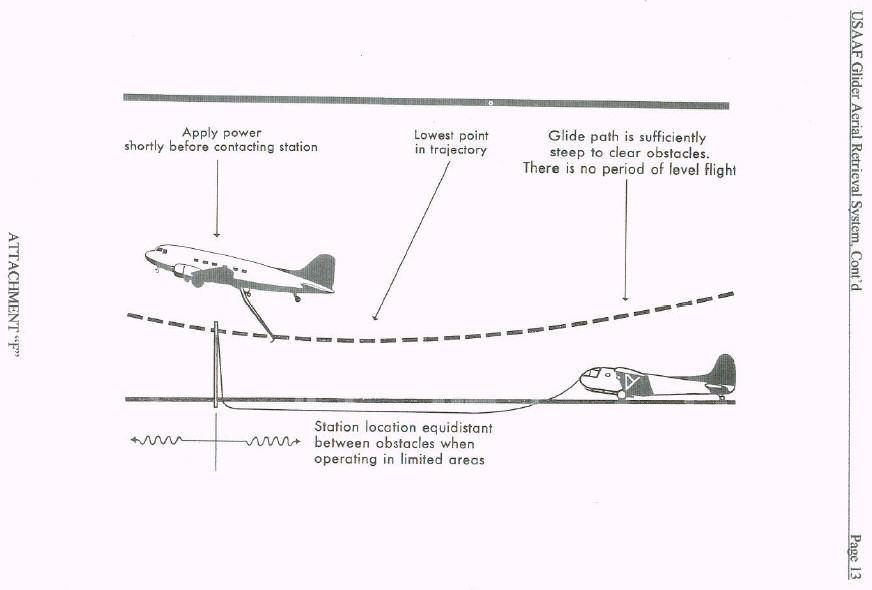
Video of CG-4 Waco Glider Pick-Up by B-18 Bolo (Color)
youtube.com/watch?v=S-EFmKr7P0w
A clever way was devised to beef-up the message pick-up system to pick-up a man by a low-flying, fixed-wing aircraft using a hook.
 youtube.com/watch?v=76rCndvhxeo
youtube.com/watch?v=76rCndvhxeo
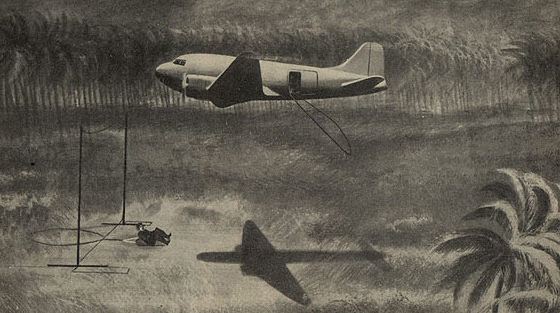
During WW2, OSS agents and downed crews were behind enemy lines and far away from an open grassy field for a STOL aircraft like the Lysander or a C-47 to pick them up. Colonel Thigpen explains:
During the 1920s, a mail pickup system was invented by Lytle S. Adams [direct descendant of Presidents John Adams and his son, John Quincy Adams] and was employed to retrieve outgoing mail in remote areas where overland pickup was impractical. Using Brown's invention, All American Aviation developed a modified pickup system in the 1930s that consisted of two steel poles, set 54 feet apart, with a transfer line swung between them.
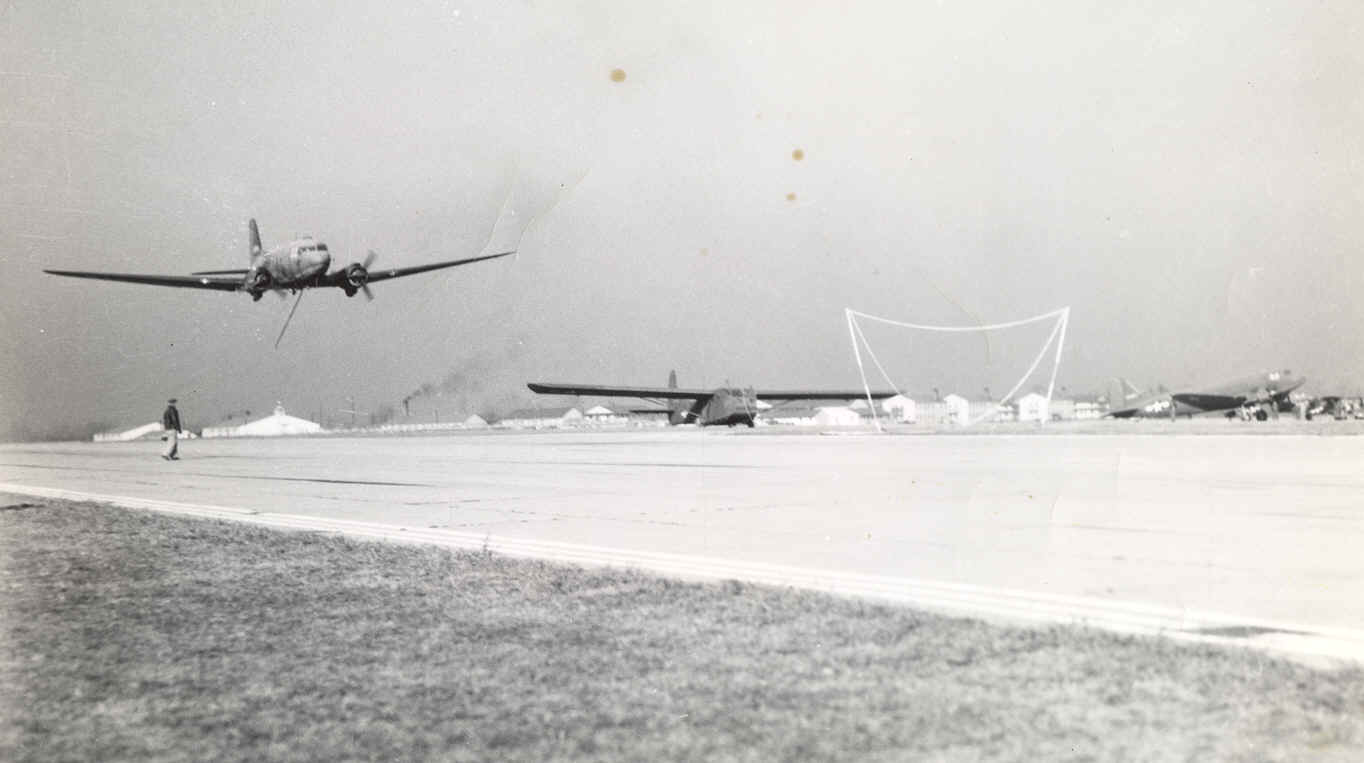
A pickup aircraft would approach the cable at 90 miles per hour, with a 50-foot steel pickup cable trailing behind. Just before impact with the transfer cable, the pickup pilot would pull the nose of the aircraft up and engage the transfer cable with a four-pronged grapple anchored to the end of the pickup cable.
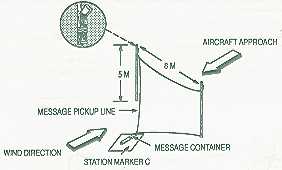
A flight mechanic stationed in the fuselage of the aircraft then used a winch to reel the package on board.[25] The system was operational by 1941 at the outbreak of World War II [for use by STOL Grasshopper liaison aircraft].
All-American Aviation and the Air Mail Pick-up System
youtube.com/watch?v=qoNVI6drEMY
youtube.com/watch?v=Ppd-J0y_jI0
From May 1939 through June 1949, All American Aviation employed a unique non-stop airmail pickup and delivery system, invented by Dr. Lytle S. Adams and modified for commercial use by company engineers after Richard C. du Pont acquired Adams's patent rights. Used to deliver airmail to small communities scattered throughout rugged terrain in western Pennsylvania and West Virgina, the system was also exploited in World War II to tow gliders aloft, and to rescue personnel trapped behind enemy lines.
The All-American System: The Forerunner to Fulton STARS
http://youtu.be/-v-XACYdKIE
As the war progressed and the Allies prepared for the eventual invasion of Europe, it became apparent that a capability was needed to extract personnel who had previously parachuted behind enemy lines. Literally thousands of Paratroopers/Special Agents were dropped by Carpetbagger B-24 and B-17 aircraft, along with RAF Halifaxes, in the months before and immediately after the Normandy invasion. The primary option for their recovery was a risky overland trek through enemy-held territory followed by an equally risky linkup with Allied forces in the field. Hoping to find their exfiltration solution in the All American Aviation system, the British began testing the capability early in the war.[26]
In July 1943, the USAAF validated the need for the extraction of downed airmen from behind enemy lines and began an operational test of the All American Aviation system. Initial test produced unsatisfactory results for personnel pickups, with instrumentation recording more than 17 g's (acceleration of gravity) at initial contact with the pickup line. Modifications were made in the parachute harness and the transfer line, thus reducing the initial force on the pick-up package to 7 g's. On 5 September 1943, the first volunteer Paratrooper, Lt Alex Doster, was picked up by a Stinson aircraft utilizing the All American Aviation system.[27]
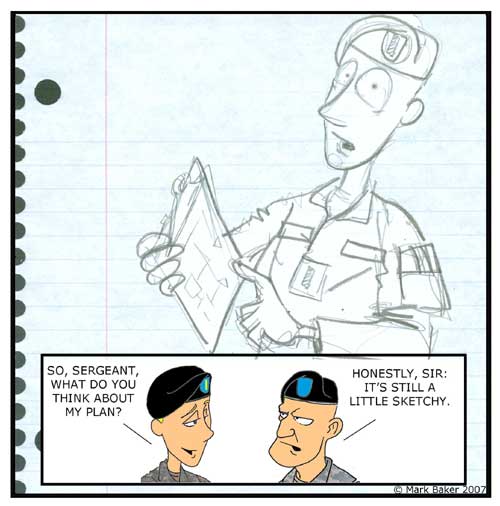
All-American Man Pick-Up By HU-16 Albatross Amphibian
youtube.com/watch?v=FRu6ZxFAVU8
By Stinson & Norseman Liaison Grasshoppers
youtube.com/watch?v=-v-XACYdKIE
youtube.com/watch?v=p4fvCcqtumo
The first man pick-up was at Wright Field on September 5, 1943. Lt. Alexis Doster, A Paratrooper who volunteered. The Pilot was Norman Rintoul. Rintoul swept down and snagged him in his Stinson at 125MPH. Rintoul is also piloting the aircraft in the HU-16 video clip.
The USAAF continued to improve the capability, and by early 1944 it had developed an airdrop kit containing telescoping poles, a transfer line, and a parachute harness to be worn by the person being extracted. In February 1944 the first operational use of the system came when a C-47 extracted a glider from a remote location in Burma and returned it to a base in India.

For the remainder of the war, the USAAF refrained from using the All American Aviation system for extraction of personnel, but records indicate that the British did use it for that purpose. [28]
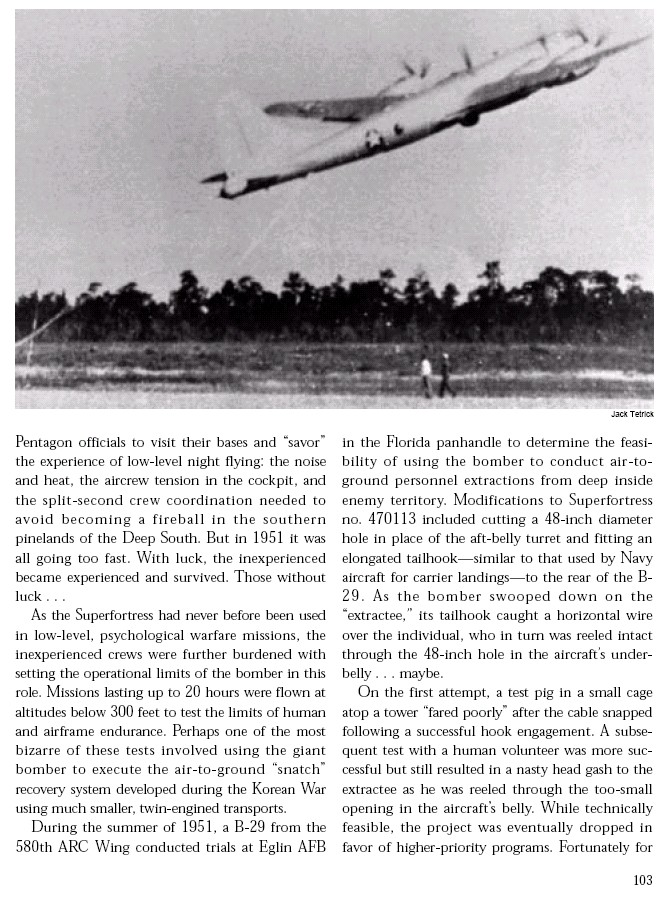
After the war further development of the retrieval system was discontinued. Not until the Korean War was interest revived. In the summer of 1951, a B-29 of the 580th ARCW conducted trials at Eglin AFB, Florida, to determine if a large aircraft could be used for pickups. Although proven technically feasible, safety considerations of flying such a large aircraft close to the ground resulted in the program being dropped for the B-29.[29]
In early 1952, the CIA renewed its interest in the All American Aviation system. The agency was attempting to establish a resistance network in Manchuria with its proprietary airline CAT dropping agents and supplies into Kirin Province by way of C-47 transports. The rugged terrain found in Manchuria favored an extraction system such as the All American Aviation system over airland exfiltration by way of an unprepared runway. By the fall of 1952, CAT C-47 pilots were making static pickups in Japan and successfully retrieved aircraft mechanic Ronald E. Lewis during a training pickup. With the system tested and operationally ready, a CAT C-47 aircraft equipped with the All American Aviation system departed Seoul City Airport (K-16) on the evening of 29 November 1952 for a scheduled pickup of team members previously inserted into Manchuria. Along with two pilots there were two CIA officers on board-John T. Downey and Richard G. Fecteau. A double agent had compromised the team, and Chinese gunners were waiting to ambush the CIA crew. On initial approach in preparation for extraction of the team, the C-47 was shot down, resulting in the death of the two pilots and capture of the two CIA officers by the Chinese. After two decades of imprisonment, the two officers were eventually released from Chinese prison-Fecteau in December 1971 and Downey in March 1973.[30]
The All American Aviation system was adapted by the USAF for C-47 use late in 1952. Building on knowledge gained from the B-29 test the previous year, B Flight, 6167th Operations Squadron, operating out of K-16 near Seoul, Korea, was assigned the extraction mission by Fifth AF. On two occasions in 1953, B Flight attempted to perform extractions utilizing the system. The first attempt was aborted when the downed airman was captured before the aircraft arrived in the pickup area. The second attempt resulted in heavy damage to the C-47 aircraft during the run-in for pickup. The mission had to be canceled, and the aircraft limped back to its home station without the survivor.[31]
The system proved to be an operational failure for pickup of downed airmen in a hostile [human] environment. All American Aviation did develop a successful engagement system, however, in the late 1960s. The follow-on system enabled C-130-equipped aircraft to snag satellite packages in midair as they parachuted to earth from orbit.
"The Green Berets" Fulton STAR Balloon SkyHook Scene
 youtube.com/watch?v=17z9A6Np2nA
youtube.com/watch?v=17z9A6Np2nA
Seizing upon this concept and improving it so aircraft wouldn't have to fly so low to the ground, genius inventor Robert Fulton created a kit that could be dropped to the ground containing a helium tank and balloon connecting to a line and 2 jumpsuits that 2 men could wear.
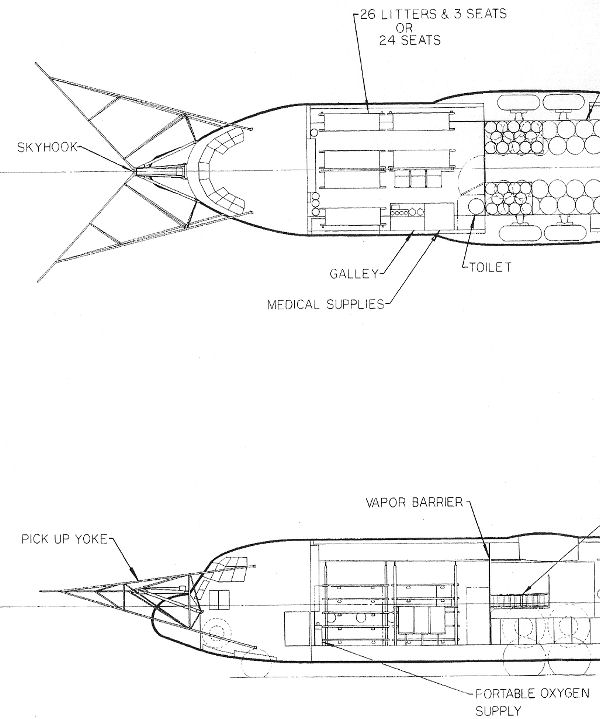
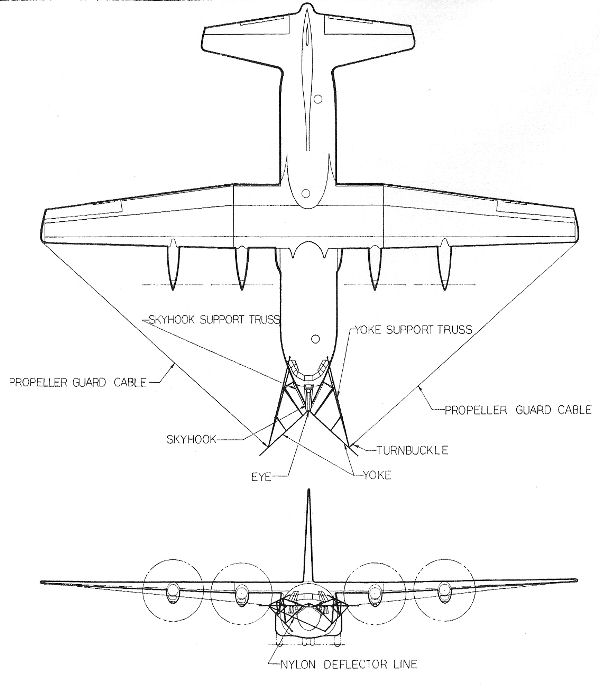
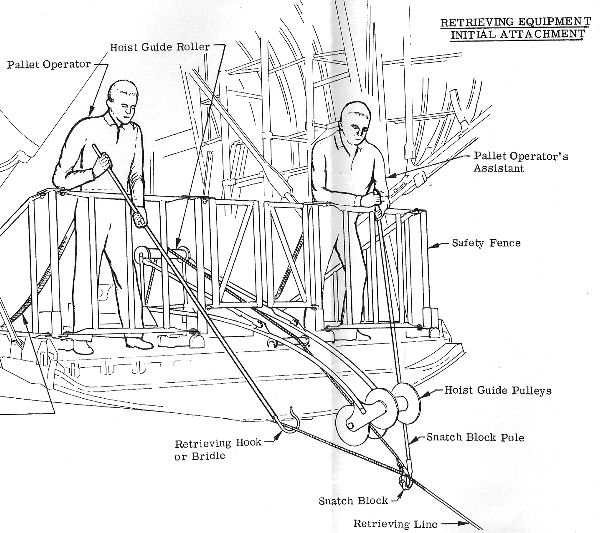
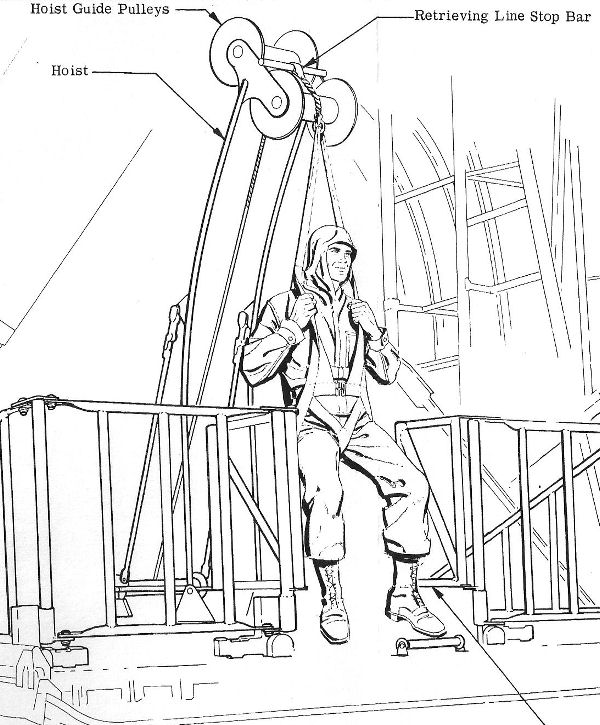
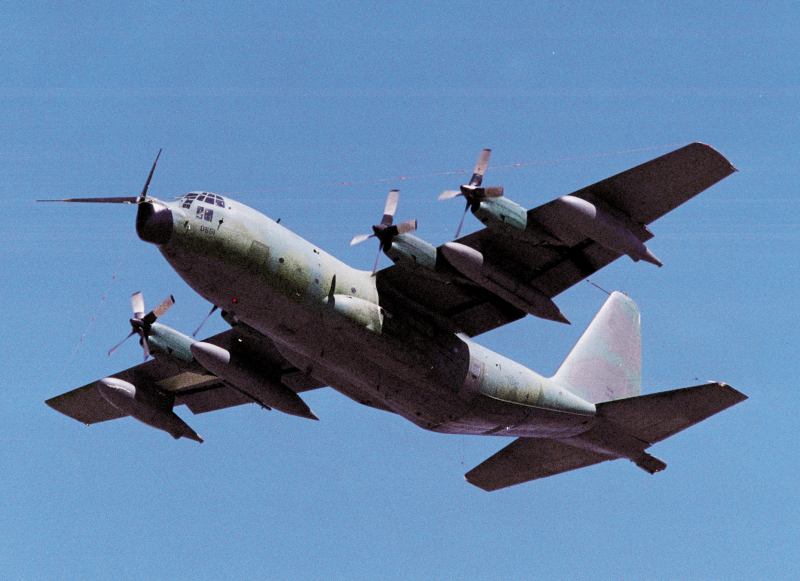
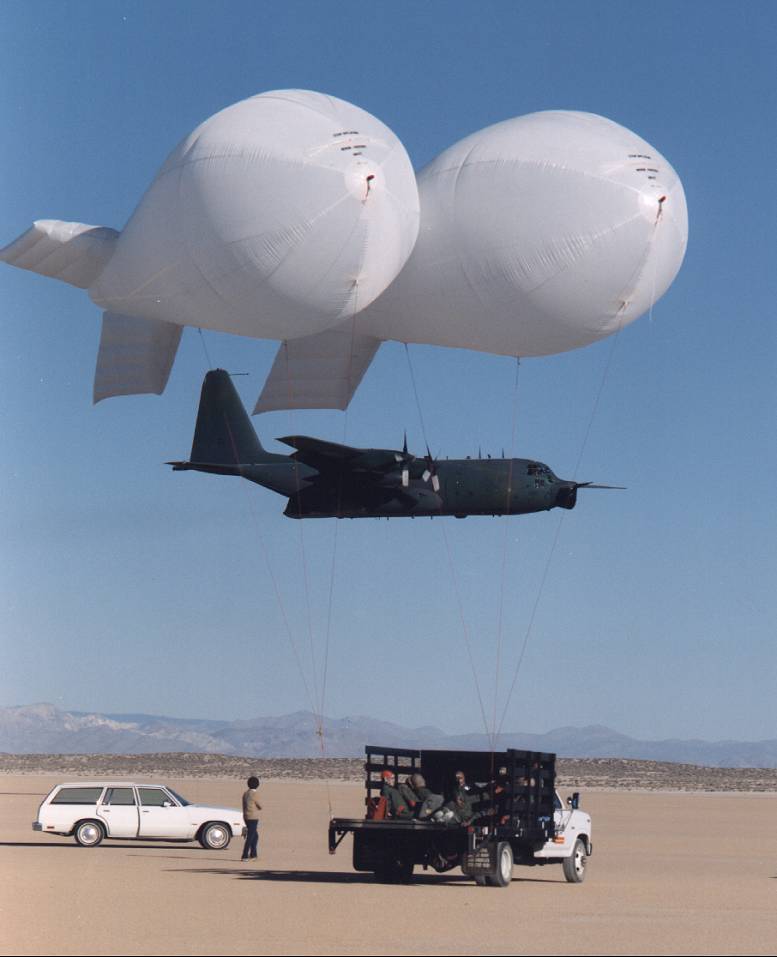
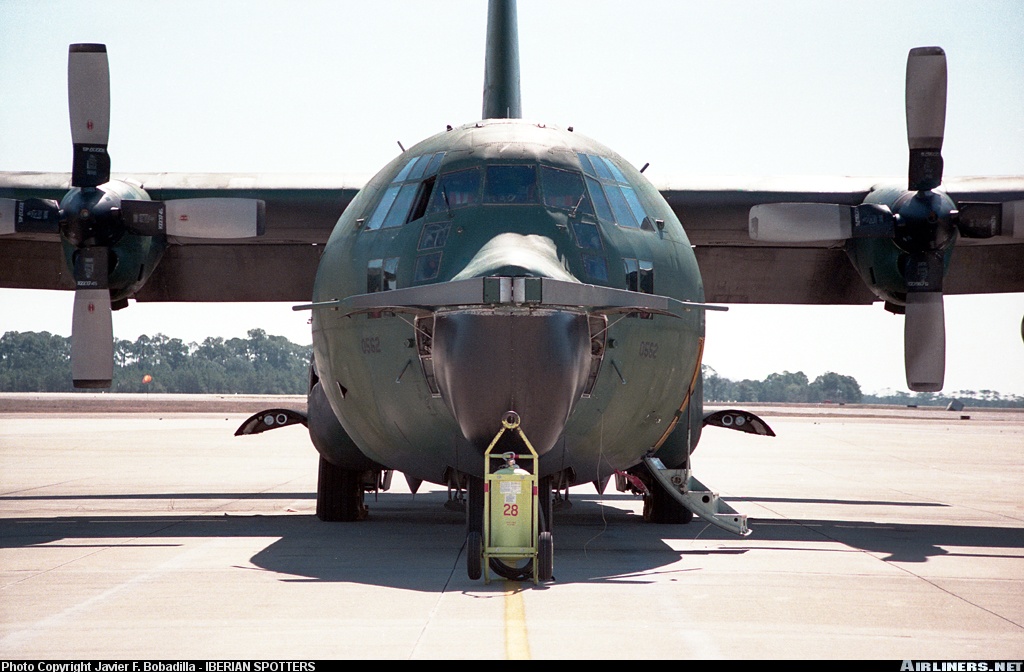
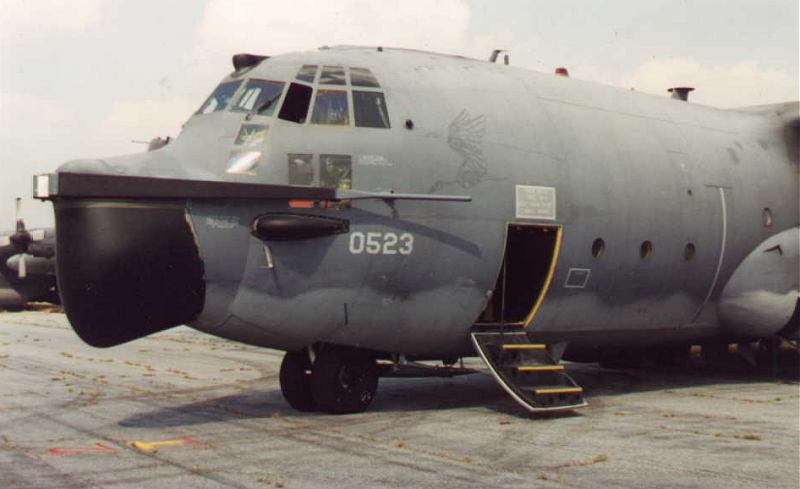
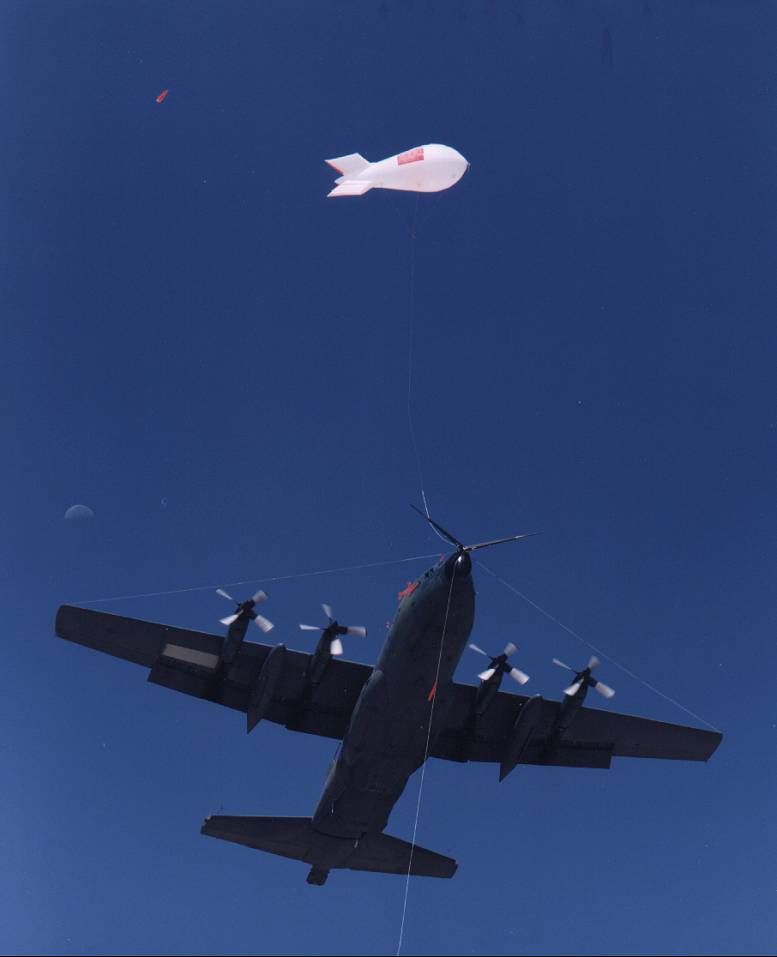
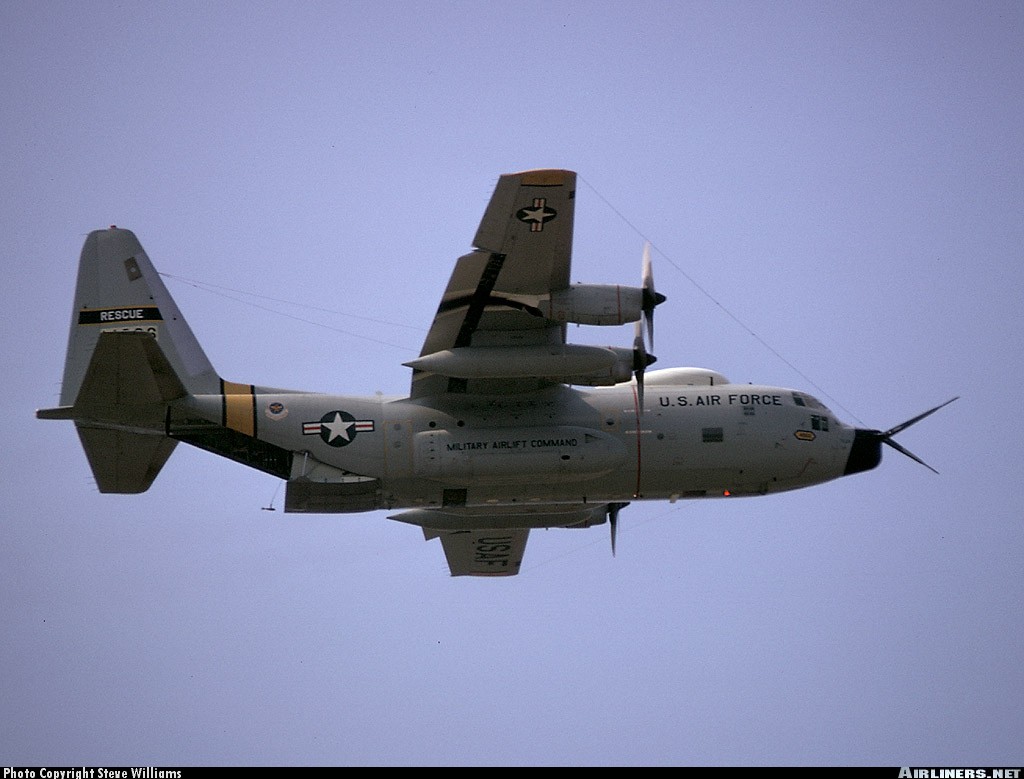
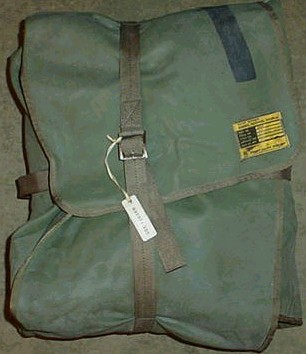
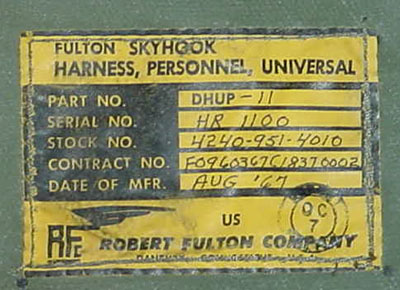
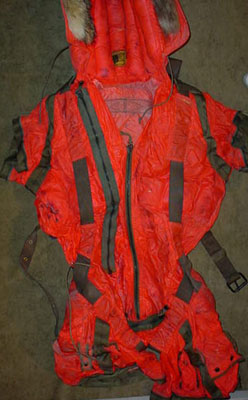
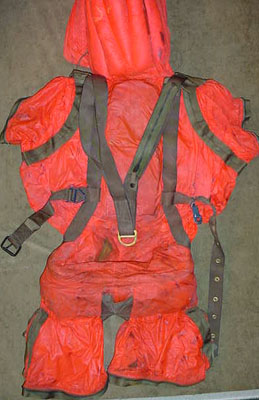
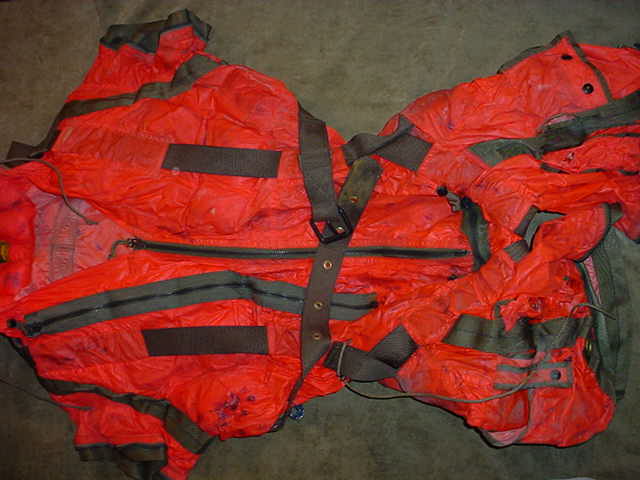
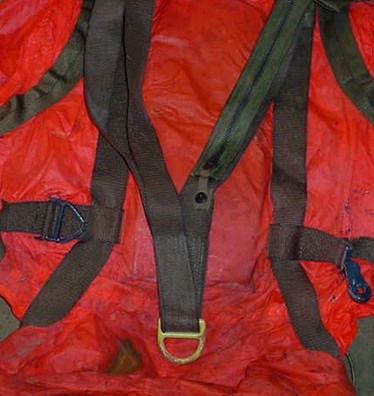
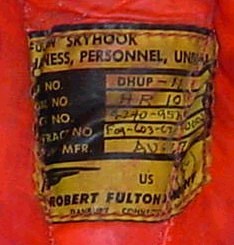
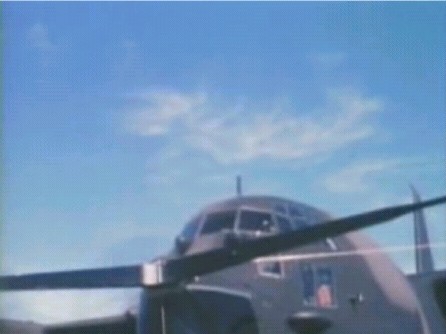
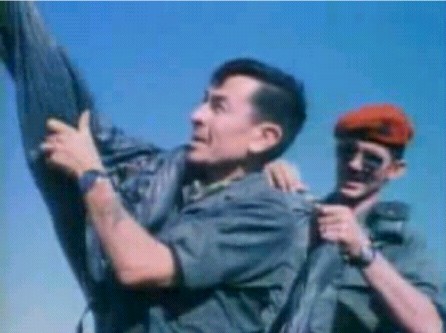
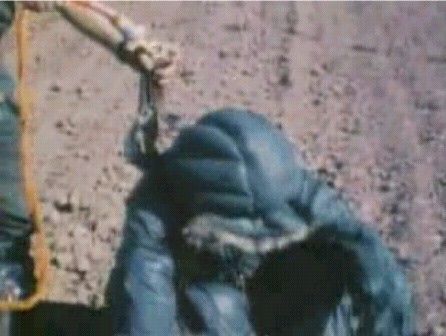
OPTION: Two-at-a-Time
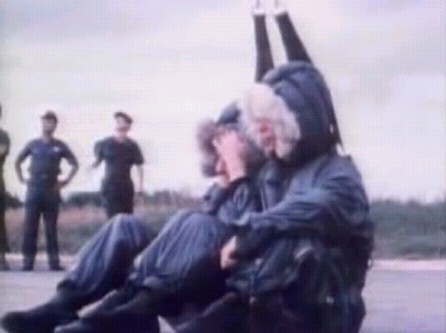
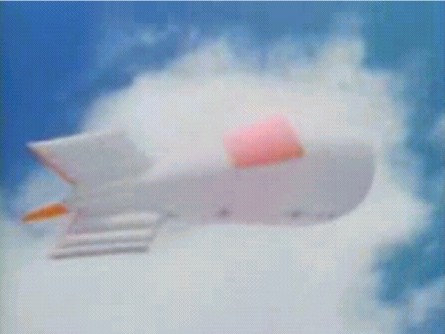
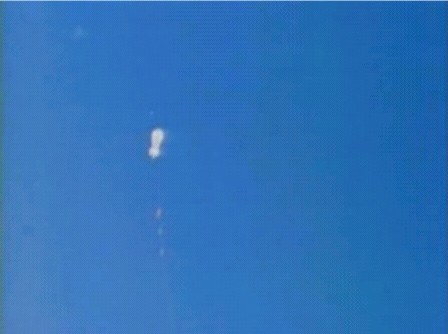
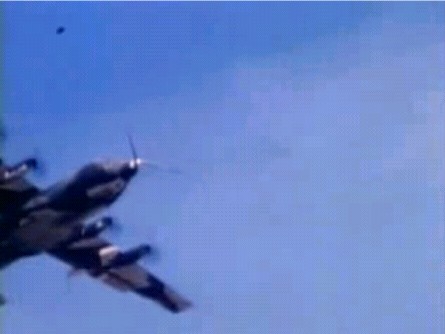
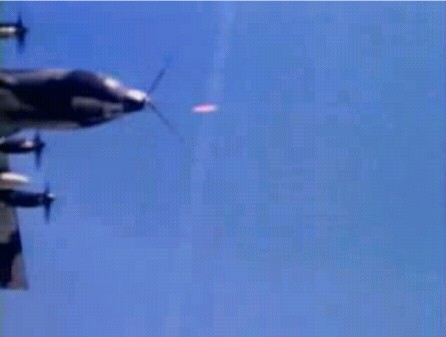
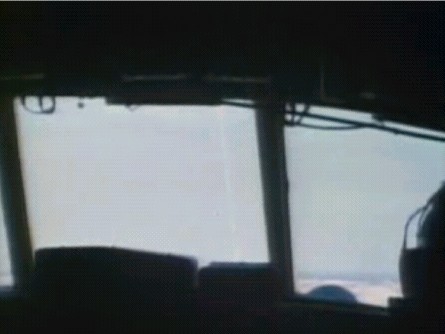

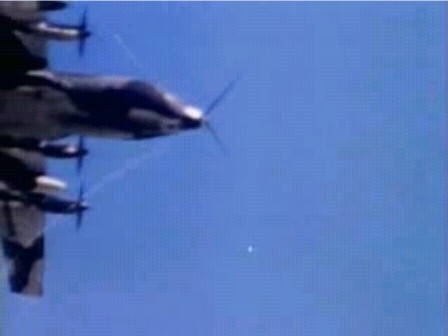
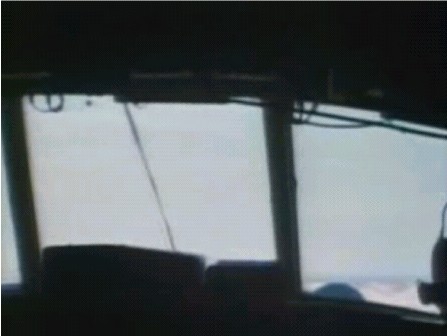
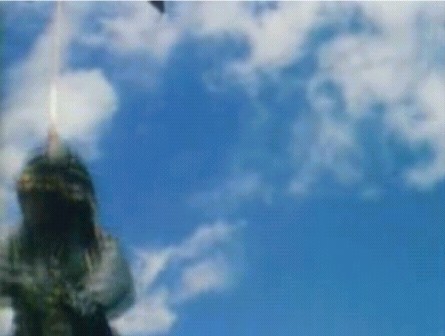
OPTION: Two-at-a-Time
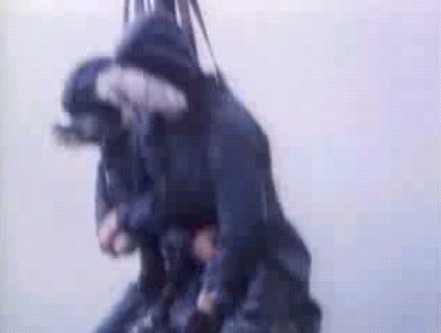
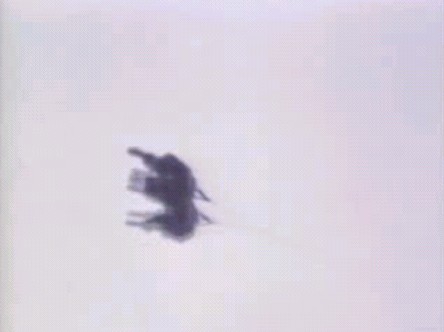
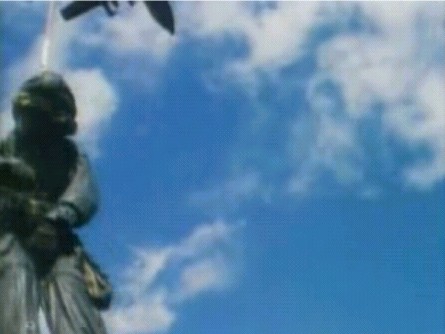
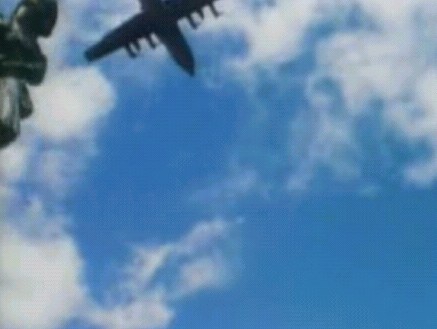
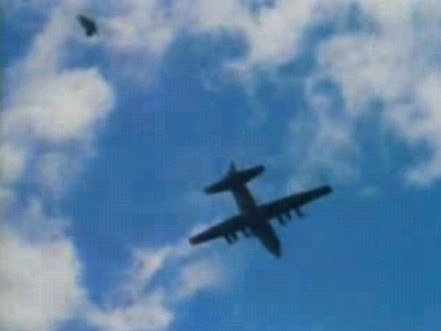
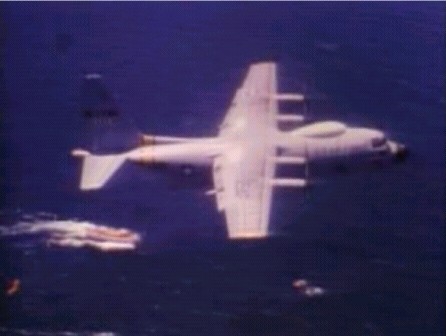
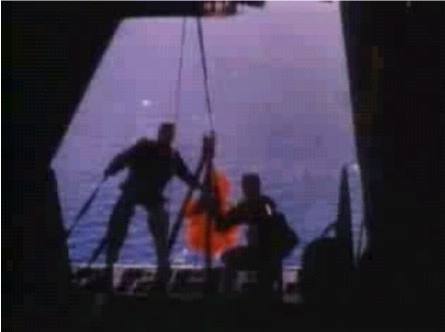
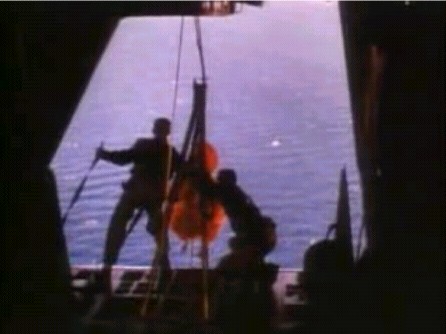
A specially-equipped aircraft with an antenna like device on the nose would fly towards the balloon and snag the line, yanking up the two men below until they trailed the aircraft horizontally and were hooked and reeled in.
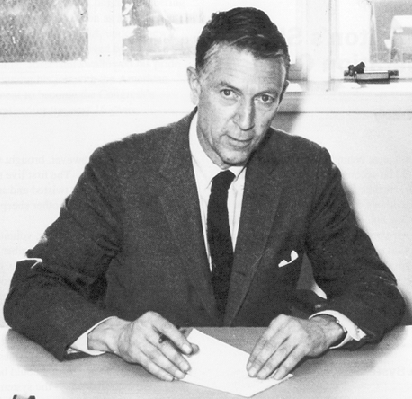

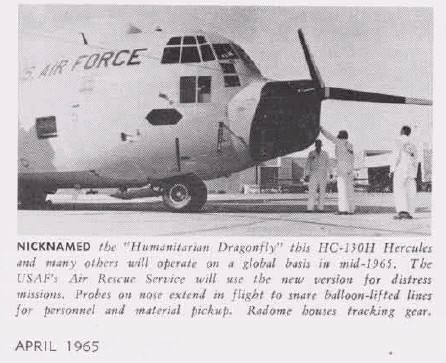
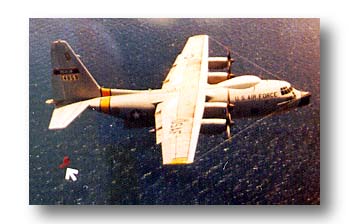
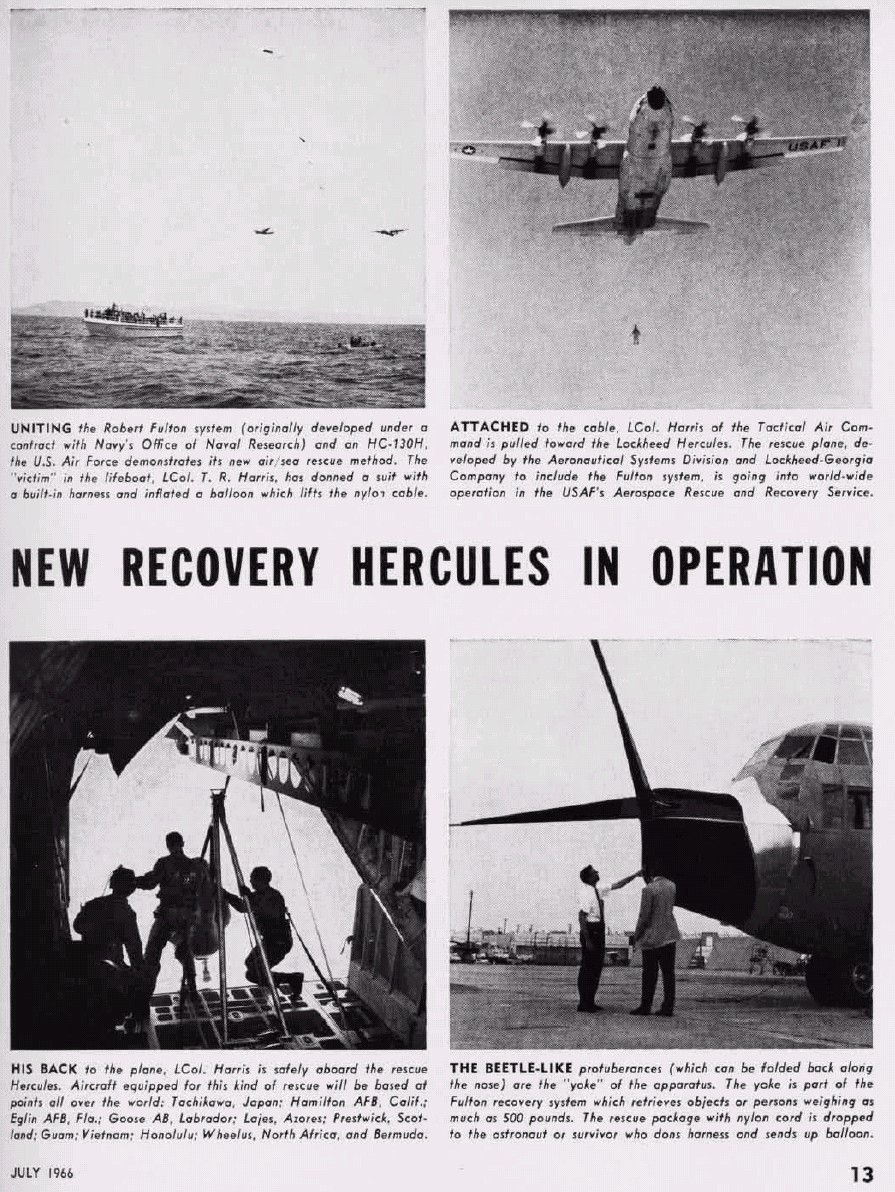
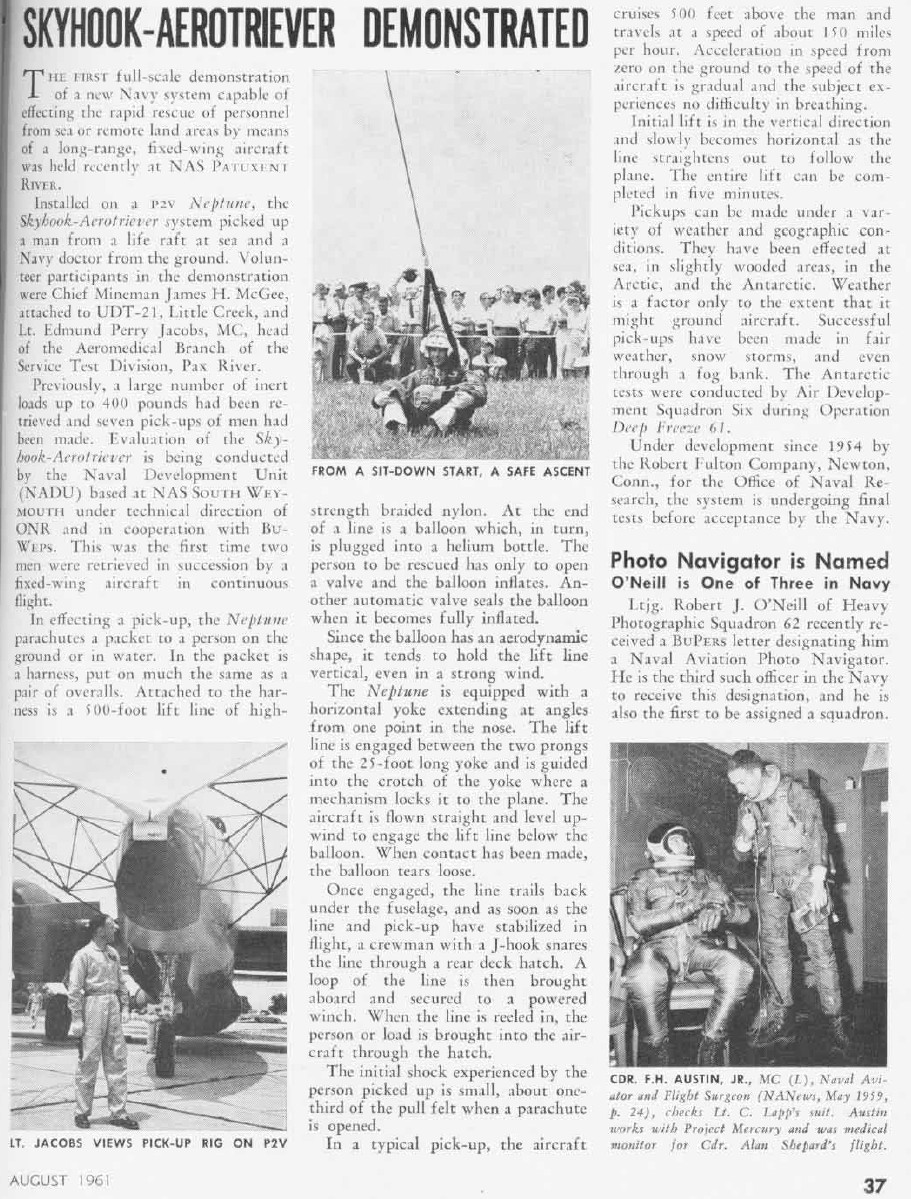
We know that Fulton STARS was used in actual combat operations during Desert STORM in 1991 to rescue a seriously wounded SFOD-Delta operator deep behind enemy lines too far for helicopters, saving his life. Another report says a British operative was rescued in Afghanistan in 2001 using Fulton STARS. Folks are still using the system even if the USAF is too cowardly these days.
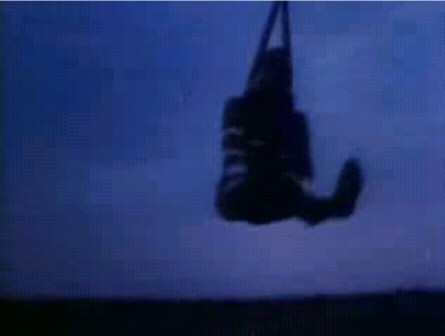
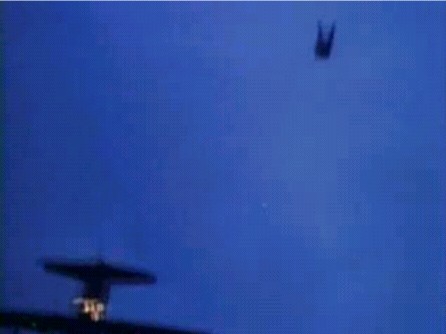
We also know Fulton STARS was used to do a secret CIA mission "Operation COLD FEET" to the arctic as the pictures below detail.
There were even plans for jet C-141 Starlifters with Fulton STARS. With them retired due to wing cracks, this is no longer an option...or is it?
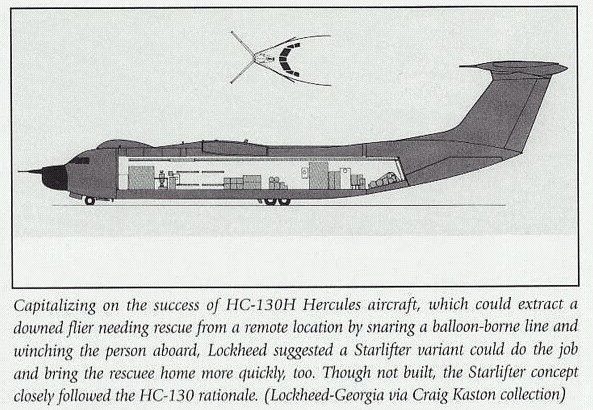



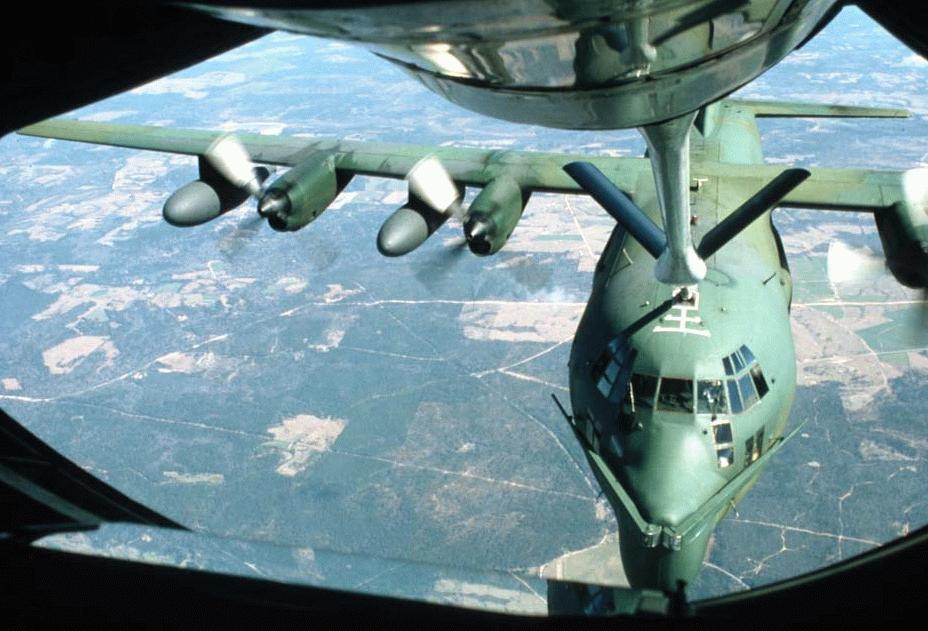
Turboprop Combat Talons have long-distance ranges that are enabled by in-flight refueling; we should have propfan, MC-130J Combat Talon IIIs with Fulton STARS and air-cushion landing systems (ACLS)--today not crap CV-22s.
CRASH-LANDING: Recovery Pontoons for ditching: Can we afford to throw away $56M each naval fighters into the drink?
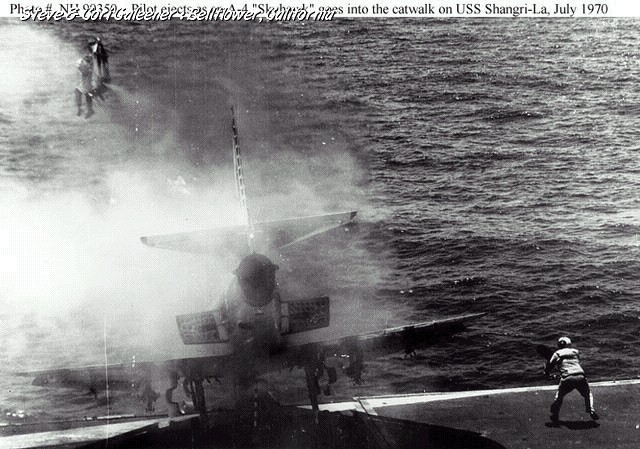
 VIDEO CLIP: combatreform.org/harriercrashesfromhoverintothewater.mpg
VIDEO CLIP: combatreform.org/harriercrashesfromhoverintothewater.mpg
Let's face the truth: one of the reasons navies cannot afford aircraft carriers is because landing and taking off from ships at sea results in them crashing into the water. The Australian Navy had to go out of the aircraft carrier business years ago because they lost too many A-4 SkyHawks. Ejection seats as the video clip above demonstrates can save the aircrew from death, but if you run out of airplanes, where is your naval aviation force?
This is the exact situation that is reaching critical mass in the U.S. Navy that is running out of airplanes to fill its 12 aircraft carriers.
Its time we face the fact that at higher altitudes, when the aircrew eject, the anti-spin landing brake parachute should deploy to reduce the resultant crash severity and perhaps get some parts for salvage. But for low-altitude crashes and ditchings in the water, we need EMERGENCY INFLATABLE AIR BAG FLOATS to deploy if the aircrew ejects when coming in to land on a ship. This will enable the aircraft to crash into the water and float so it can be recovered/repaired or at the very least salvage expensive parts. If they are shaped like skis they also would provide a forward-moving, water ditching capability if the pilot chooses not to or cannot eject. Helicopters that fly over the water have emergency floats and do not incur a significant weight/drag penalty. If helicopters can do this, certainly our $56M+ naval jet fighters, and our land fighters since they fly over oceans to deploy globally. If the aircraft are over enemy held areas and the aircraft floating would result in capture, the pilot could turn the inflatable floats to OFF.
One thing is certain, if we continue with the current rising "Death Spiral" costs of aircraft, U.S. Naval Aviation is going to go out of business just like the Aussies found out years ago.
STEP 3: Get Someone to Land and Rescue You: Want to Live Forever? Satisfied for Just Not Dying Today? Examples of Military Personnel Refusing to Accept Death as Lemming Victims
1968. Vietnam.
A wounded marine is dying and must be evacuated to a hospital or he will die. The weather is closing in so a MEDEVAC helicopter cannot fly to get him. An AH-1G Huey "Cobra" helicopter gunship gets the call over the radio and lands, he is placed inside the seat of the gunner, who climbs onto the stub wings and sits on the rocket pod as the helicopter speeds to the hospital. A life saved by unselfish courage.
1978. Southern Lebanon.
This same thing happens again in Israel, an Israeli Scout 'copter pilot is shot down over Lebanon. The bad guys are closing in on him. An AH-1S Cobra gunship lands and opens its side nose armament access panel, which the downed pilot sits on, and he's flown to safety before killed or captured.
2007. Afghanistan
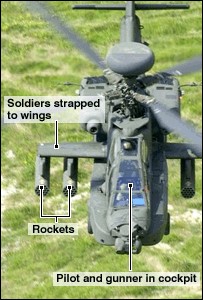
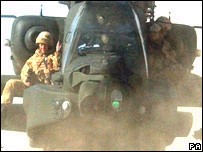
Below is a link about a recent attempted rescue by UK marines of a colleague by strapping themselves to Apaches - a clear example of the need for a Ground Rescue Insertion Extraction Resupply pod or something similar.
http://news.bbc.co.uk/1/hi/uk/6285091.stm
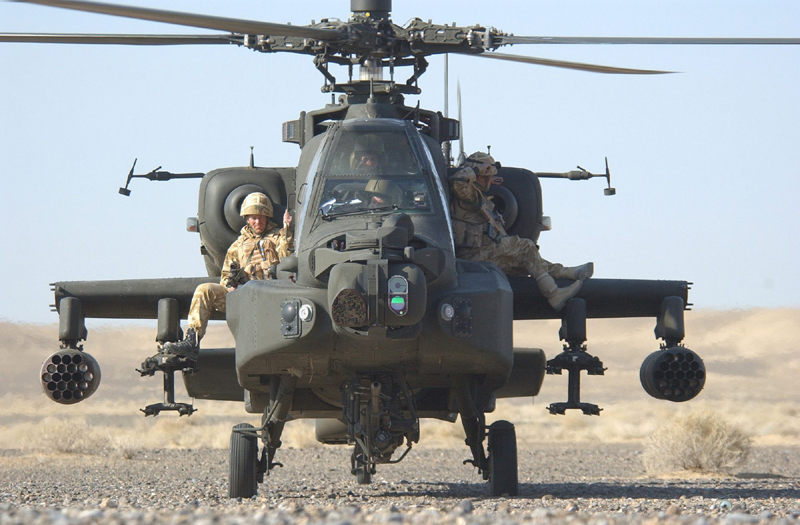
VIDEO:
 bbc.co.uk/mediaselector/check/player/nol/newsid_6280000/newsid_6284400?redirect=6284429.stm&news=1&bbwm=1&nbram=1&bbram=1&nbwm=1
bbc.co.uk/mediaselector/check/player/nol/newsid_6280000/newsid_6284400?redirect=6284429.stm&news=1&bbwm=1&nbram=1&bbram=1&nbwm=1
Footage has been released of a daring rescue mission in which four Royal marines tried to save a comrade in southern Afghanistan.The men strapped themselves to an Apache helicopter's wings to find Lance Corporal Matthew Ford who went missing in an attack on a Taleban stronghold.
L/Cpl Ford, of 45 Commando Royal Marines, had died but the men retrieved his body during last week's incident.
A UK Task Force spokesman called the mission a "leap into the unknown".
And Geoffrey Perry, the father of Chris Fraser-Perry, one of the marines involved in the rescue, said he was very proud of his son.
'Volunteers' sought
"From what I can gather, obviously they got back to the base and realised that one of the lads was missing and then they were looking for volunteers to go back," he said.
"Obviously everybody volunteered and he for some reason got chosen to go. He was strapped to the side of the helicopter. Obviously had his gun with him, he carries it at all times, and they went back in."
He believed his son was one of two marines who landed and found L/Cpl Ford's body and took it back to the helicopter.
"From what I can gather it was quite a drag; it was about 80 metres or so," he said.
"It was quite an effort for them to actually get there and do what he'd done. I'm just so proud of him really. I just can't believe it."
L/Cpl Ford was part of a 200-strong force who attacked a major Taleban fort to the south of Garmsir in Helmand province. The MoD said the Apache helicopter can only carry a pilot and a gunner but there are attachments on the wings for personnel to harness themselves to in emergencies.
The fort had been a surveillance target for more than two months.
A third Apache helicopter and other units provided covering fire, as the rescue bid got under way, the MoD said.
The helicopters landed in the fort and located L/Cpl Ford's body, which they then strapped to the Apache.
UK Task Force spokesman Lt Col Rory Bruce said: "This is believed to be the first time UK forces have ever tried this type of rescue mission," he said.
"It was an extraordinary tale of heroism and bravery of our Airmen, Soldiers and marines who were all prepared to put themselves back into the line of fire to rescue a fallen comrade. And it was with great sadness they later found their brother-in-arms had been killed in action." L/Cpl Ford, who was the eldest of three brothers, was brought up in Immingham, North East Lincolnshire.
WW2 People Pods: Desperate Times Call on Desperate Measures...
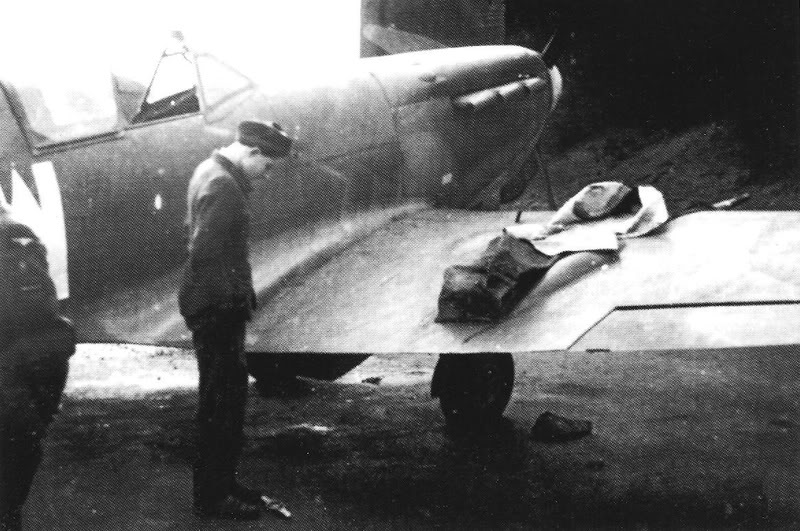
Another application of pods is to enable aircraft without built-in volume to transport ground crews, commandos or rescue people.
1940, France: So which will it be?
Stay here and be captured by the Nazis and be tortured or...
FLY IN THE POD!
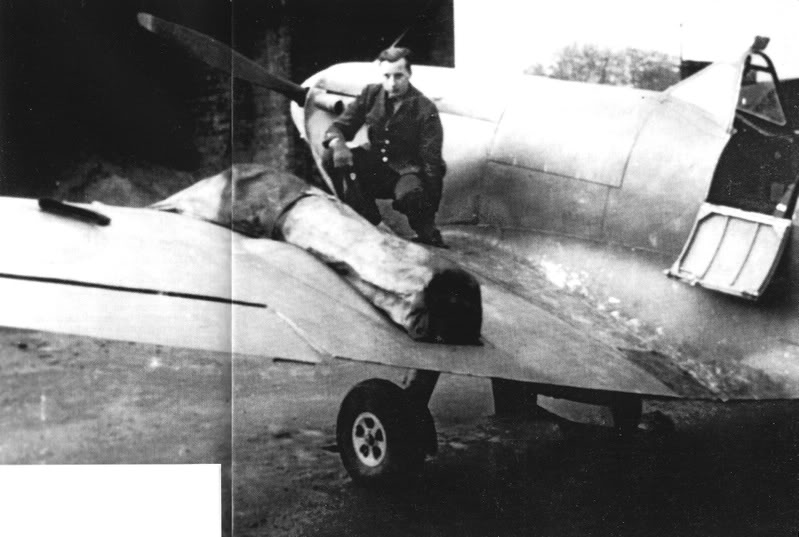
The infamous Spitfire fighter "body bag"
1943, Stalingrad: So which will it be?
Stay here and be captured by the Russians and tortured to death...or...
FLY IN THE POD!
JU-87 Pods


During WWII, the Germans were hard-pressed to stay moving to avoid air attacks from Soviet IL-2 Sturmoviks armored attack planes and the Red Army advancing on the ground with T-34 medium tanks.
Greg Goebbel writes:
vectorsite.net/avstuka.html+hs+123+armored&hl=en&ie=UTF-8
Manufacturing had moved on to the "Ju-87D-3" in late 1942, with this variant featured improved armor protection to optimize for the schlacht role. It did retain the underwing dive brakes but had no bomb crutch and no sirens. Some Ju-87D-3s were converted to "Ju-87D-4" torpedo bombers, but they were not used operationally and were later converted back to Ju-87D-3 configuration. The Ju-87D-3 was used in experiments with personnel pods, with one such pod carried on the top of each wing outboard of the landing gear. Two people could ride in tandem in each pod, and in principle the pods could be released in a shallow dive, to deploy parachutes for a soft landing. The whole scheme was questionable and though the Stuka was evaluated with the pods, apparently they were never paradropped.
Emmanuel.Gustin adds:
http://216.239.41.104/search?q=cache:XR1wv0umFksJ:users.skynet.be/Emmanuel.Gustin/history/stuka.html+Ju-87D-3+people+pods&hl=en&ie=UTF-8
Stuka units also often had to improvise the transport of their own supplies and ground crews. In Germany, enormous overwing pods were developed for this, which allowed the Ju-87 to carry four people. But they remained experimental, and a common solution was too load everything in a DFS 230 glider and tow it behind a Ju-87. For use during the winter, optional ski landing gear was developed, although it was not widely used because it reduced performance. The removal of wheel spats was also common.
Me-109 Pods
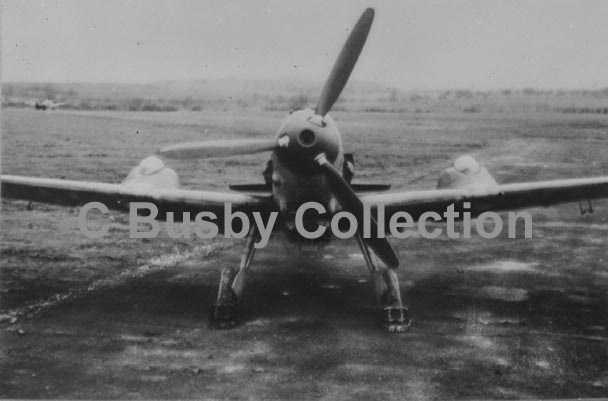
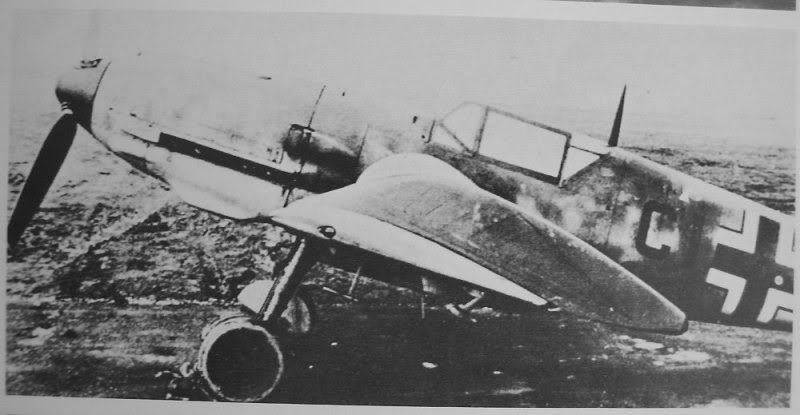
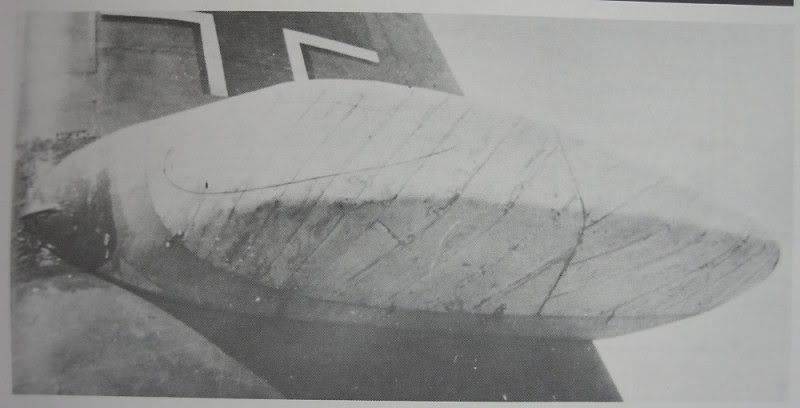
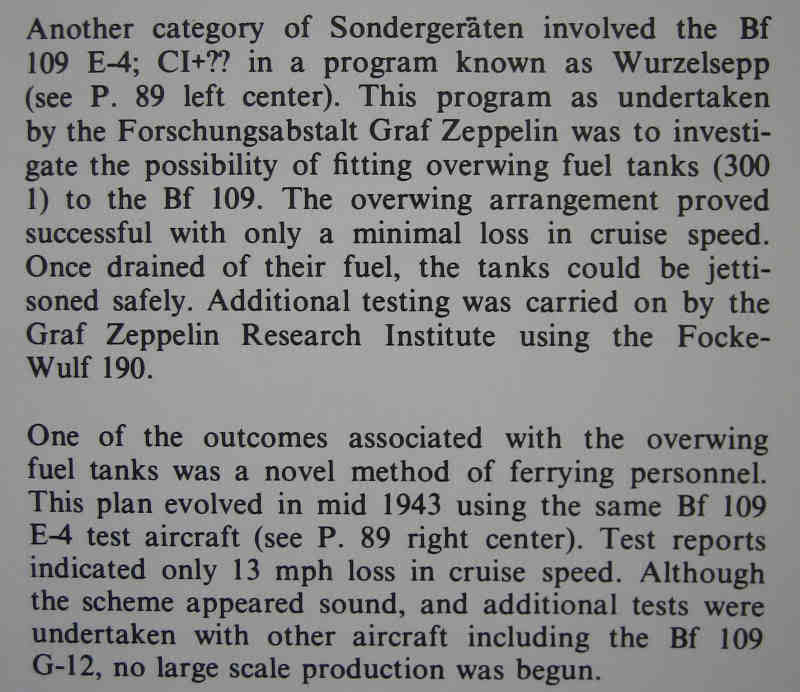
KG200: German Special Operations Unit Parachute Dropped People Pods
As Germany crumbled under the Allied advance, special operations units began to drop agents behind our lines to do sabotage--and escape to start-over with the 4th Reich.
Axis & Allies Special Operations Aviation
Some of these operatives and war criminals were not up to the job of personally parachute-jumping so they were placed in a 3-man (or woman) pod and DROPPED.
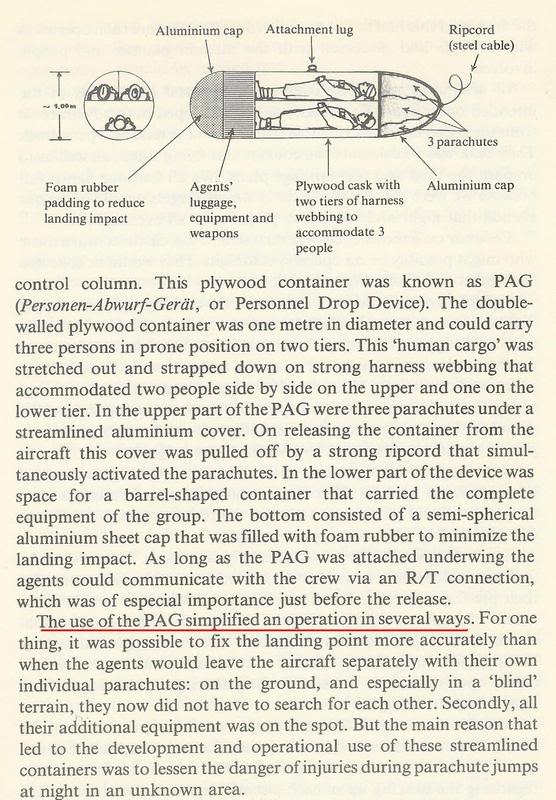
From KG200: The True Story by P.W, Stahl who indicates that these PAGs (as they were called) were indeed used operationally.
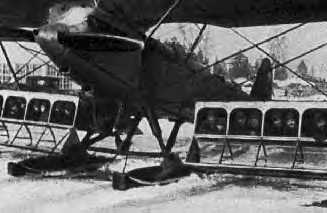
In late 1930's a Russian biplane R-5 was modified to carry sixteen Paratroops in special compartments fitted onto the lower wing of the aircraft. Each compartment housed two combat-ready men with parachutes. R-5 was flown and performed quite well, achieving speeds of 130 km/h. Additional surfaces were fitted under the lower wing (to compensate for loss in wing's performance).
Similar modification with fewer pods were used on a R-5 that participated in rescue of the Cheluskin's crew, a steamer which got trapped in ice and sunk in 1930s. The crew of the ship (100+) got stuck on the ice in the Arctic. The R-5 was used extensively in the rescue mission and removed a major part of the expedition by air.
The British Royal Navy also tinkered with pods on their naval aircraft.
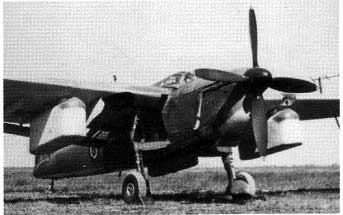
In the Southwest Pacific, our P-38 Lightnings could carry people in underwing pods....
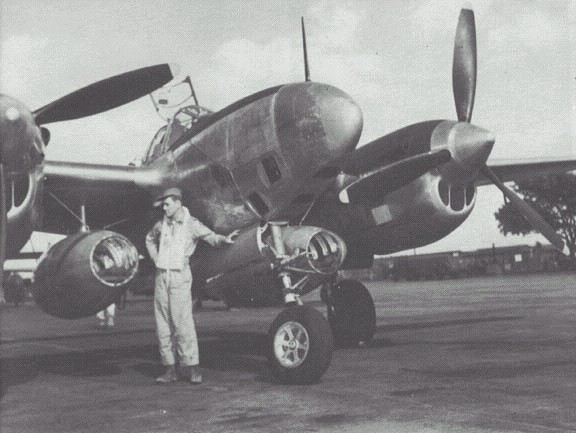
During the Korean War, small Bell 47 and Hiller Raven helicopters were able to carry wounded Soldiers to M.A.S.H. hospital on covered Stokes litters--essentially "people pods"---why not a people pod that attaches to the stub wing hardpoints of an attack aircraft?
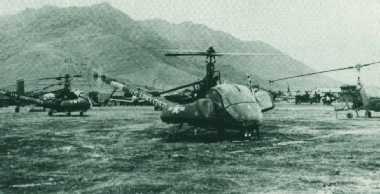
Pods on STOVL Aircraft
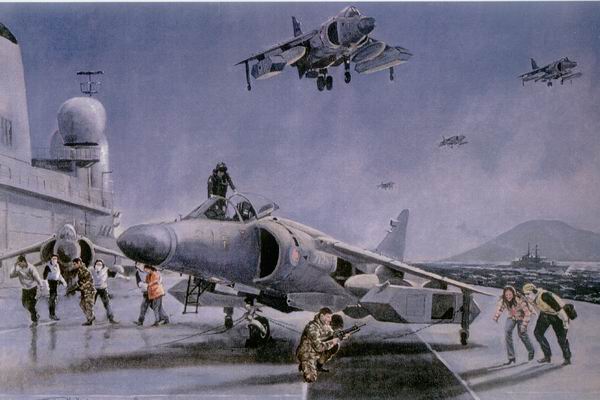
NEW!!!! James Bond Goes to Iran to Rescue Felix Leiter in "The Bell Tolls for Thee: The Poppy is Also a Flower"
 http://youtu.be/jAVV-WUZsPQ
http://youtu.be/jAVV-WUZsPQ
youtube.com/watch?v=4ltaPvRDnno
youtube.com/watch?v=-88ijiDM_Gg
From Oliver/Ryan "Warplanes Of The Future"
The company formerly known as McDonnell-Douglas (swallowed by Boeing) was working on a Ground Rescue Insertion Extraction Resupply pod (GRIER) for its AV-8B Harrier II V/STOL attack jet that would carry two men inside, taking advantage of that aircraft's ability to land and take-off vertically. This pressurized pod on the outer wings like a fuel tank would allow a 4-man LRS or SF special recon team to insert under the cover as being part of an attack jet "strike package", and/or to dart in and rescue downed pilots faster and with better armament than doing a daylight "O'Grady" which was one missile from another mc Desert One-type flaming disaster.

AV-8B Harrier II with GRIER pod
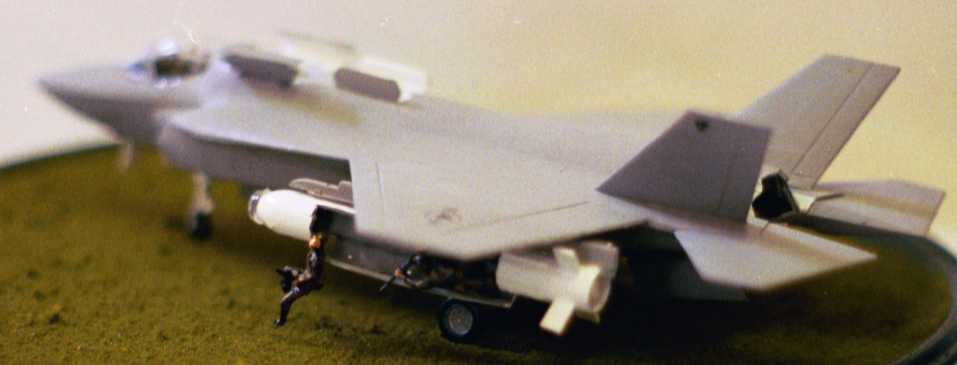
We need to take the idea a step further and create a helicopter-capable GRIER rocket/rescue pod. This would be an un-pressurized pod that would have 2.75" Hydra-70 rocket tubes inside. Thus, a weapons station is not wasted just holding an empty pod for one-man recovery ("An ounce of prevention is better than a pound of cure"). If a fellow aircrew member gets shot down (he can eject now) the first comrade on the scene with a GRIER R/R pod ejects the rocket tube inserts and lands. Delay for aircrew recovery helps the enemy not the good guys. The downed aircrew (1-2) can enter one or both of the cleared pods and be flown to safety. The point of this all is that we need a Hydra-70 rocket pod that can eject its tubes and hold a man to rescue him or by design infil/exfil a LRS recon/SF guy. As said before, in the Korean War we transported casualties in pods on Bell Model 47 helicopters--remember from the M*A*S*H TV show? What's the mental block here?
All we are doing is creating a dual-purpose pod that shoots rockets until its needed.
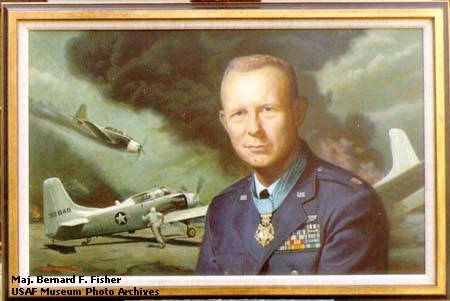
Such rescues have taken place in war--Major Bernard F. Fisher landed his A-1E Skyraider onto an enemy held runway in Vietnam to pick up a downed pilot and earned the Congressional Medal of Honor for it. Click here for a selection of video clips of the awesome Skyraider in action from the official Skyraider home page! German Stuka pilot Hans Rudel did the same kind of rescue in WWII. As wisdom has implied before----"A stitch in time saves nine"--an immediate recovery while the enemy is suppressed is better than waiting for the enemy to use the downed pilot as "bait" and ambush a full-blown rescue effort. The film, "Flight of the Intruder" depicts this common occurrence from the Vietnam War.
According to Tom Clancy in Armored Cav; page 275, that U.S. Army Aviators can hook up their flight vests to the skids of a OH-58D gunship (no extra seats) and be extracted out. Current U.S. Army Aviators wear the SRU-21P SARVIP vest which has a life support capable snap-link point that theoretically could be used to connect a Soldier to a helicopter for emergency pick-up. This is just like the British Soldiers who recently rode AH-64 attack helicopter stub wings to rescue a comrade in Afghanistan. Every Soldier should wear a life-support-capable "Rigger's belt" anyway. The question is: are there any points on the AH-64 Apache or the new RAH-66 for a snaplink to fit through and hold an aviator for a rescue? If not, or if the Soldier is injured, we need a GRIER rocket-rescue pod, put SARVIP vest connection lugs on the outside of the pod so the able bodied can be carried out using their vests. This way each pod could carry an injured Soldier and up to 2 others.
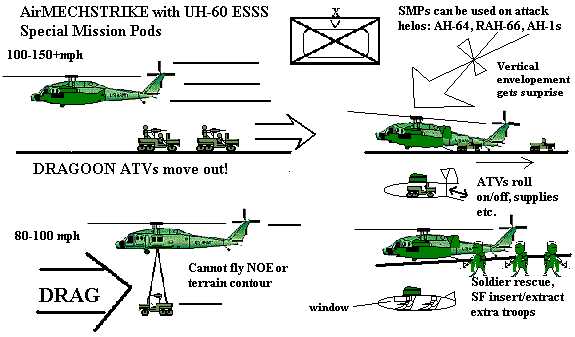
It seems entirely reasonable and desirable that at least one U.S. Army helicopter in every attack flight be equipped with a GRIER R/R pod. The gunner on that helicopter should have a pair of SKEDCO rolled up extraction litters and a M3 aid bag with IVs etc. in the space under the rocket tubes/pod, and have Combat LifeSaver (CLS) training. Upon landing, he could stabilize the wounded aircrew if needed, and if necessary drag them back to the helo pod using the SKEDCO. This is "down and dirty" and he has to be a real "stud", but there is also no reason why a SF 18D medic couldn't be onboard an armed Blackhawk AH-60L Direct Action Penetrator if it were a 160th SOAR mission or USAF Pararescueman (PJ) in a MH-60G Pave Hawk helicopter in a joint mission to give a hand rescuing wounded aircrews. For most cases, the GRIER R/R pod "snatch" would be for an able-bodied aircrew calling in for a quick pick-up.
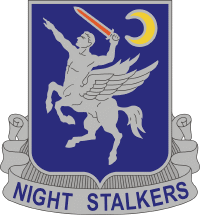
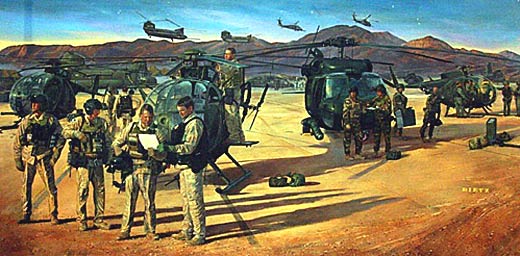
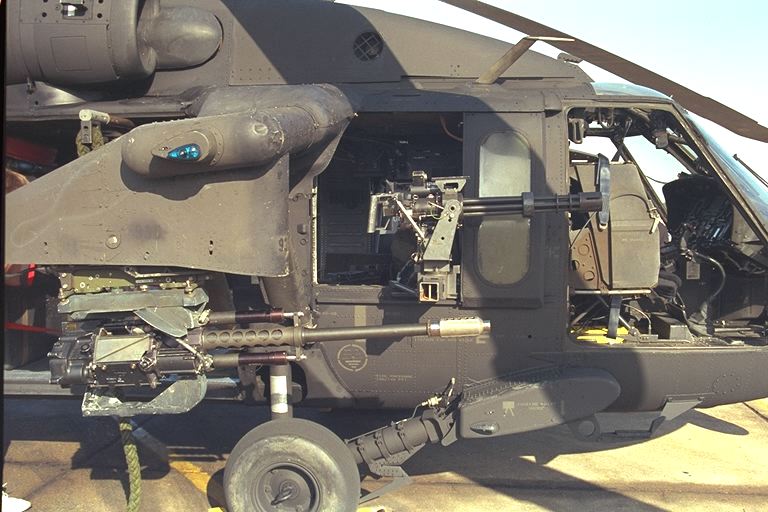
MH-60 Direct Action Penetrator with 30mm autocannon and 7.62mm MiniGun pointing forward
Another purpose for GRIER pods would be the delivery of small "All-Terrain Vehicles (ATVs) under the ESSS wings of the UH-60 Blackhawk so they do not have to be "sling-loaded". A sling-load has to be flown gingerly to prevent oscillating. ATVs carried snug up against ESSS wings in roll-on/off pods would be more streamlined and allow the pilots to fly aggressive nap-of-the-earth (NOE) flight profiles over enemy held territory. This would create an AIRmotorized "Dragoon" capability for U.S. Army Strike forces to move short distances on the ground to recover personnel and enable landing zones (LZs) off-set from the objective to keep the enemy from detecting them. An even better light mechanized commando (MECHANDO) option would be M113 MiniGavin light tanks with armored mobility and heavy firepower paradropped or airlanded.
I'm not sure where our GRIER AV-8B with 2-man pods R&D stands with Boeing gobbling up McD-D...the Brits are pursuing a 1-man pods concept...with parachute delivery, too. On a Harrier the noise intensity would have been a challenge. The Pegasus engine gives of 165-170dB close up. Above 140dB nausea can be overwhelming. Above 160dB human hair can combust! So pod sound insulation is a must!
flightglobal.com/articles/1998/09/23/43106/uk-test-fits-avpro-exint-pod-on-harrier.html
UK test fits Avpro Exint pod on Harrier
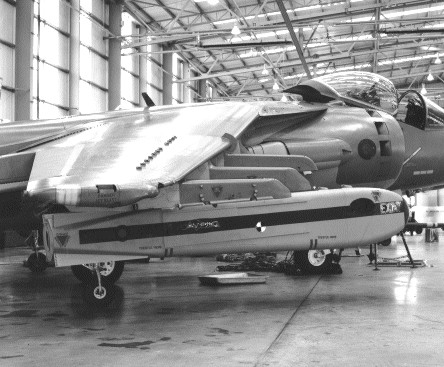
The UK Defence Evaluation and Research Agency has test fitted the Avpro Exint pod on a British Aerospace Sea Harrier F/A2 at the company's Boscombe Down facility. The system, designed for combat search and rescue and special forces insertion, will be flown later this year following interest from the UK Ministry of Defence.
flightglobal.com/articles/2000/01/25/61133/exint-cleared-for-ah-64-as-production-starts.html
Exint cleared for AH-64 as production startsUK advanced design firm Avpro has cleared its Exint transport pod for use with the Boeing AH-64 Apache. Certification to carry personnel is required. The pylon-mounted Exint is designed for combat search and rescue and special forces insertion.
Avpro director Mike Ryan says that 17 countries have expressed an interest in Exint - which has also been fit-checked on the British Aerospace Harrier - and that one is close to placing an order. The U.S. marine corps and special forces are interested parties, says Ryan.
In the special forces insertion role, an AH-64 can carry four pods, which in turn can carry 226kg (500lb) each.
Hunting will build the predominately composite structure and is embarking on a 50-unit initial production batch. The first pod is due for completion in April. Ryan predicts that the market could be worth £800 million ($1.3 billion).
Avpro is to issue shares in the Exint to fund remaining certification work. Ryan says the Exint is compatible with other attack helicopters such as Bell AH-1Cobras, Denel Rooivalks and Eurocopter Tigers.
Ryan declines to name the first customer, but it is believed to be Israel, which has a long history of using its attack helicopters to rescue downed pilots, usually lifting them out on the skids of its AH-1s. It requires a similar capability for its Apaches.
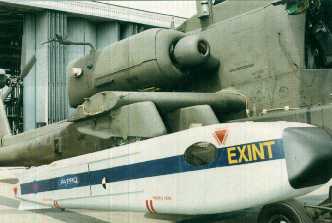
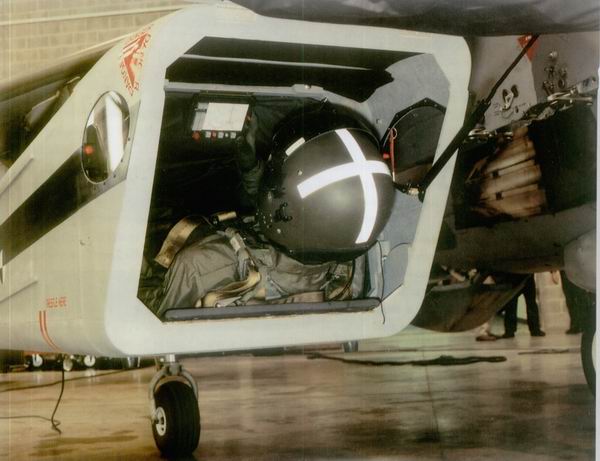
Emotive pictures of captured aircrew during the Gulf War have generated a political as well as a military need to rescue downed aircrew.Avpro, in conjunction with Hunting Engineering and the Defence Evaluation Research Agency (DERA), completed a feasibility study into a pod known as EXINT (extraction/insertion), which can recover aircrew in a rapid manner.
EXINT is a pod primarily designed to provide recovery of downed aircrew, but could also be used for other missions such as the insertion of special forces in out-of-area operations.
EXINT exploits the unique vertical take-off and landing capability of the Harrier, but will also be suitable for use on other aircraft and helicopters such as the UK WAH-64D Apache Longbow attack Helicopter, without any structural modifications to them. The feasibility addressed not only the pod design but also the Aero Medical operational and environmental aspects of recovery/insertion missions.
AVPRO Limited
PO BOX 9128 ACTON London W3 6GE UK
TEL 44 (0) 207 495 6565
FAX 44 (0) 207 394 5349
Email: mikeryan@avpro.co.uk
Farnborough Office
Avpro Limited
Farnborough Innovation Centre
Northgate Road
Farnborough, Hampshire, GU14 6TWTel: +44 (0)1252 550040
Fax: +44 (0)1252 550101U.S. Office
AVPRO Aerospace Inc.
PO Box 15680
Long Beach
CA 90815 USATel: +1 (562) 420-7488
Fax: +1 (562) 420-7644Email: avproaerospace@mindspring.com
EXINT Pod Equipment
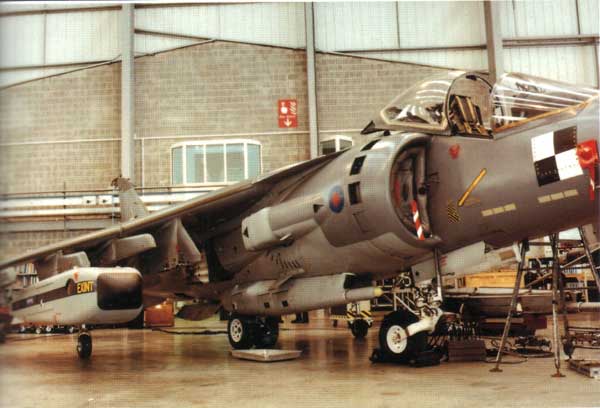
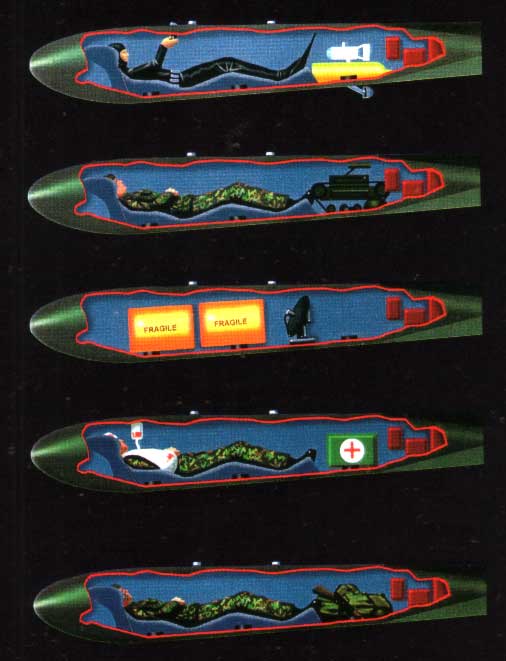
Parachute retarder system
Air Bag landing system
Global Positioning System
Radio
Air conditioning
NBC filtration system
Multi function display panelEXINT is a one-man pod of some 4 metres in length and is fitted with internal equipment such as radio and air conditioning systems. An equipment bay also allows small arms and other personal equipment to be carried. A state-of-the art parachute and airbag system, developed from the Mars Lander Space Craft programme will allow the pod to make a soft landing should it be released from the aircraft in an emergency situation.
In today's uncertain world, there are few items of cost-effective equipment that can offer the world's armed forces, the multi-role versatility, and flexibility of EXINT.
http://ebird.dtic.mil/Oct1998/s19981028pods.htm
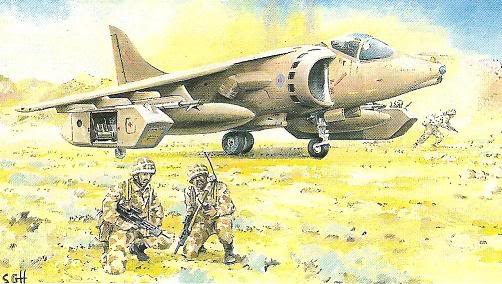
London Sunday Times
October 25, 1998Attack Pods Drop In On The Enemy: High-tech capsules could parachute Soldiers into action on clandestine missions or be used to rescue downed pilots.
Report by Mark Prigg
Parachute pods that turn into stealth boats could soon be used to deliver troops to attack enemy warships.
Each pod contains one Soldier, his equipment and breathing system. The pods can be attached to the side of Harrier jump jets, Apache attack helicopters or other military craft.
Once released at a high altitude to avoid the aircraft being spotted, the Soldier in the pod will release a steerable parachute and float down.
Mike Ryan, a director of Avpro, the company developing the pods, says: "Because the pod has its own oxyen, we can drop it from altitudes of more than 20,000 ft. Opening the parachute at this height means descent can take up to five hours, giving the Soldiers time to survey the area."
The pods have a GPS system that allows them to be guided with great precision. All the Soldier has to do is put the map co-ordinates of his destination into the pod's computer and it will do the rest. The system is accurate to within a metre, and the Soldier can take control at any time to change course.
Once the pod nears water, a proximity sensor inflates six airbags, which help the pod land safely and quietly on the water where the airbags form a protective skirt, giving, the pod extra stability. It can than be moved up to 50 miles by a propeller driven by a tiny electric motor.
Ryan says: "The pod isn't very fast, but it is completely silent. If this is used at night, there is no way anyone will see or hear you."
Windows on either side of the unit allow the Soldier to see out, and the pod's computer allows the Soldier to stay in radio contact with his superiors. The screen in front of the Soldier can also be linked to an aircraft's navigation system, so the Soldier can see exactly where he is while still attached to the plane.
"There is a small camera that helps alleviate claustrophobia by showing images from outside. There are also a number of other cameras and sensors that can be attached on the outside of the pod for surveillance operations," says Ryan. He is also working on another version of the pod for picking up downed airmen. Attached to a Harrier jump jet, the pod would allow the craft to land quickly, the airman to climb into the pod, and the craft to take off almost instantly.
"We saw in the Gulf war how difficult it was to locate and rescue downed airmen, so we came up with the pod idea. After all, the last turns, you expect in a war zone is a supersonic plane to come in, stop dead and hover before touching down to pick someone up."
Ryan's work has been sponsored by the Defence Evaluation and Research Agency (DERA), which has helped to prove the concept.
"Thanks to DERA we have been able to prove that the system will work. We now have a prototype pod attached to a Harrier which we will use for flight tests later this year," he says. "The airbag and parachute system has already been extensively tested. It is the same design used on the Mars Pathfinder mission, so we know it holds up to extreme conditions well."
Dera has also carried out tests to make Sure humans can survive journeys in the pods.
"We were worried about the safety aspect - being in one of these pods is quite a ride. We've actually been approached by an amusement company to sell rides in these things when they are strapped to a jet fighter. However, I don't think we will be working with them just yet - I certainly won't be volunteering to be their first passenger," says Ryan.
Once in production, each pod should cost about 100,000. Ryan believes that for special-forces operations this is cheap.
"This isn't something that will be used every day, and when you consider that the cost of training a fighter pilot is about 3.7m, then paying, 100,000 for something to get him back intact isn't such a bad deal."
According to Ryan, the problem now is finding funding to complete development of the pod.
"If we had an unlimited supply of money, we could have this thing in operation within six months. However, that is unrealistic and because of the way the funding process works in Britain, we think it will take about two years before we go into production. There has been a lot of interest from abroad, particularly from Japan and America, so we may be able to get extra funding there."
The Japanese authorities have expressed an interest in adopting the system for both military and civilian uses.
"At things like a road-traffic accident the pods are very useful. Not only can we ferry the injured out, we can also take in supplies and doctors. We are even looking at the possibility of having a special pod that contains an entire operating theatre that could fold out," says Ryan.
10/28/98 7:39 AM
USSOCOM CSAR AIRCRAFT ON NAVY AMPHIB SHIPS?
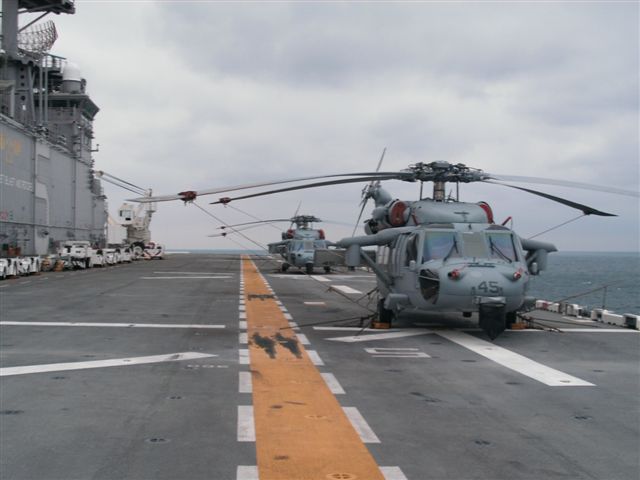
MH-60s on an USN Amphib at Sea Today: Where were they in 1995?
Shot out of his F-16 by a Serbian missile, USAF Captain Scott O'Grady is blown by the winds for 25 minutes under his parachute and begins praying. Upon landing and evading searchers who walked by sometimes as close as 5 feet from him--his final prayer was "to be rescued and not have anyone die doing it".
6 days later at midnight, his squadron mate, F-16 "Basher 11" (Captain T.O. Handlen) locates him on the radio and orders a rescue. He flies to a tanker to mid-air refuel. An AC-130 Spectre gunship for fire support and pinpointing O'Grady's location with forward looking infared (FLIR) is with him by the tanker for the armored, heavily armed, night/adverse weather sensor-equipped AFSOC MH-53J Pave Low III helicopter(s) on alert in Brindisi, Italy to fly in under the cover of darkness to extract O'Grady to safety. O'Grady has Global Positioning System (GPS) to radio his exact location to his inbound rescuers.
But the night rescue never came. O'Grady is told to wait.
Instead, the Navy Admiral in charge, Leighton Smith decides to wait until daylight and have his naval services do the mission in large visible formations: like he flew in Vietnam and watched dozens of men get shot down in the process. Denying parochialism as a motive or being ignorant of the way downed pilots are recovered in the 90s, the fact that he sent the USS Kearsarge into the Adriatic with a daylight only capable TRAP unit created ad hoc from a mortar platoon without placing an armored, AFSOC sensor equipped helicopter onboard with crews and pararescumen trained for a tactically sound night rescue exposes the lie. Instead, that morning a fleet of aircraft and men were put into harm's way in broad daylight to escort 2 huge CH-53E Super Stallion helicopters with higher ranking marines wanting to present themselves as "leading from the front" instead of shooters. Half of this entourage upon landing couldn't even get out of their helicopter when its rear ramp jammed on a farm fence landing on a non-Pathfinder surveyed LZ. What good would two helicopters packed with people be if O'Grady had been in thick undergrowth and there was NOWHERE to land? Just inviting targets as they hover to lower a rescue hoist? As these loud, vulnerable machines kicked up dust in an open danger area, O'Grady ran up to one and rescued himself as the relatively few lower ranking shooters struggled to fan out and prevent a burst of Serbian small arms or RPG fire from turning the cow pasture into another mc created "Desert One". Fortunately, O'Grady's prayers were answered as the unarmored aircraft flew out and though hit by small arms fire, were not hit by the two surface to air missiles fired that could have sent a helicopter packed with 20+ men to their deaths. Mission Commander LTC Chris Gunther :
"We all thought there were probably two or three miracles connected with the rescue of Scott O'Grady...despite the navigation system on the lead helicopter breaking down, the AWACs (USAF radar plane) was there to give us the guidance and maintain very good situational awareness throughout"
Today we debate the morality of sending 8 men in to rescue a Private Ryan on film while in REALITY we have so-called professionals willing to send in 61 to get one on a poorly conceived operation that was just one missile away from disaster, so they can showboat themselves and their service. This is all documented in detail in Mary Pat Ryan's book Good to Go which like the Serbian ambush that got O'Grady, cleverly gets the players to talk. While they boast about their decisions and "institutional values" and other chest-thumping she paints the picture a tactician or person with common sense would see as a daytime disaster asking to happen and a military where people at too high of a Command level are making decisions best made by those on the scene. She lists BY NAME AND RANK everyone involved in the O'Grady caper and its implications are sickening. Out of the 61 men needlessly risked to rescue one, 20 were officers or Staff NCOs--some packed onboard the helicopters with no business being there, some flying helicopter gunships slower than the Sea Stallions and creating more low-flying targets for the Serbs. We had the MEU commander a full Colonel and his Sgt. Major on board. Then the Lieutenant Colonel mission commander, another SNCO, all to "supervise" a TRAP team led by a 1LT. What should have been one aircraft radioing to another on alert while maintaining contact overhead to effect a simple and tactically prudent rescue at night became a jointitis "purple people goatscrew" where decisions were framed by "lowest common denominator" group think advice fed to a figurehead commander, far removed from current battlefield realities. If Admiral Smith was so eager to rescue O'Grady immediately he would have sent in the AFSOC helicopter(s) immediately to get him out under darkness and not waited. If he wanted to wait and get a more deliberate attempt he could have waited until nightfall the next day and prevented losing more men by exposing on those absolutely necessary for the rescue.
USN Lt. Commander Bob Nugent on suppressing Serbian air defenses:
"..what if they had actually gotten a missile off and a helicopter had gone down"? It would have been very hard to explain to the parents of all these people on that helicopter that we had had even ambiguous indications that there was a threat there and didn't act on it"
It would also be hard to justify a daylight mission instead of ordering night rescue.
Major Michael Ogden one of the CH-53E pilots said about using the AFSOC rescue team:
"This was going to be a daylight mission...I'm not inside the loop, so I don't know why the decision was made to send us in instead of somebody else"
Instead of an ill-equipped force is sent on a wrong mission we should have a sensor and armor equipped CSAR helo on every amphibious group to do recoveries without 60+ men.
FIXED WING AIR-CUSHION AIRCRAFT: LONG RANGE RESCUE?
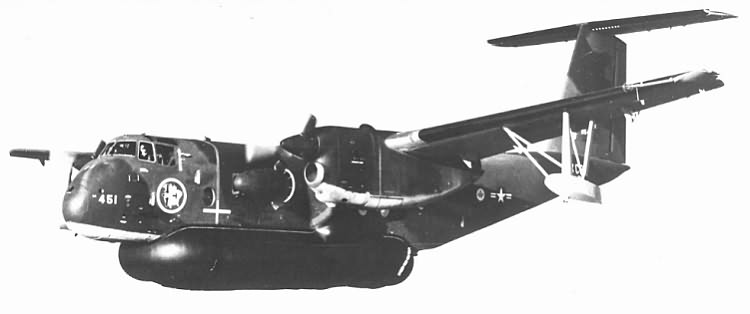
Basically the V-22 is an expensive helicopter that flies a little bit faster. The world is still 24,000 miles around, 100-200 mph just isn't going to cut it. We need to solve the basic problem of fixed-wing aircraft--which is we have them land on wheels and roll to a stop. As General Gavin said in 1947 we need a lower-pressure under carriage than that, perhaps tracks as he suggested or an AIR CUSHION. We already have made this work, and again--the Russians have a seaplane in production with it. A C-130 with an Air-Cushion Landing System (ACLS) could land almost anywhere sea or land to pick up downed aircrew and rescue all kinds of endangered people in peacetime from long search ranges. Remember you have to find them first. Instead of losing contact as you wait for a helo to refind them, land yourself and rescue them when you find them.
The world we live in moves by the speed of the AIR, our nation is a strategic AIR POWER. Some of our aircraft as hard as we try to prevent otherwise, are going to go down. Lets insure our people are not inside them when it happens.
STEP 4: If No One Will Rescue, You--Fly Yourself Back to Base!
We have had the technology for a very long time to drop a kit to downed airmen and in it, provide them with an inflatable airplane to fly themselves back to base. You could say that VTOL aircraft if they can drop a pod to you, they should be able to land themselves to pick you up as we proposed earlier as "STEP 3". Sadly, this is not always possible due to the Earth environment and enemy situation. Sometimes the best we can do is drop a pod with an airplane inside it--and we should be ready to do this. The video below details how the inflato-plane could also be used as an insertion-extraction means OF CHOICE for Commandos, too.
 youtube.com/playlist?p=PL652C40D87B73C4D3
youtube.com/playlist?p=PL652C40D87B73C4D3
U.S. NAVY/marines LIVING IN DENIAL AND ON BORROWED TIME

Bad Land Attack (LA) Lust
After World War 1, "the war to end all wars" many falsely concluded there'd be no more nation-state wars as their militaries downsized and focused on small sub-national conflicts for resources and/or political control. In the 1920s/30s the British/French reorganized themselves to fight colonial wars and were nearly destroyed completely by the Germans/Japanese at the outbreak of nation-state WW2. America is making this same mistake today, particularly with its Navy and defective wannabe land army, the marine corps and when nation-state war breaks out thousands of men are going to suffer and die horribly due to their own stupidity to get on the sub-national conflict "GWOT" land attack band wagon to fund their irrelevant cash cows.
First, if the Navy/Mc wanted to contribute to sub-national conflict capabilities they'd create kits to rapidly convert container ships into small aircraft/commando carriers so we could "sea base" off shore near third world countries and deploy relevant Army SOF/Airborne/Light infantry/Mechanized forces and Navy SEALs to kill/capture actual terrorists and support with training friendly nation-states without a large on-shore presence which can be mishandled to become an oppressive occupation as seen in Iraq. For deep inland areas, the "Container Assault Ships" can assist in projecting resupply logistics with minimal of road/trail supply lines using aircraft and cross-country capable tracked M113 AmphiGavins. Details:
Such a merchant ship escort carrier (CVE) capability had to be forced upon the pomp and circumstance Navy by wise President Roosevelt before we entered WW2. FDR had to order the Navy to escort civilian cargo ship convoys with CVEs since the wanna-duel-the-other-Navy egomaniacs with no concept of strategic or operational art were not interested in this "chore". These jeep carriers won the war against the German u-boats in the Atlantic and helped our submarines keep supplies away from the Japanese MacArthur's army bypassed to bleed and starve them into defeat. Container ship aircraft carriers could today generate enough aircraft to smother enemy air attacks and keep submarines away for us to frankly survive on the surface of the water. If we had 100 small container ship aircraft carriers we might be able to keep oil tankers and container cargo ships intact to keep our economy going in the face of attackers who could indeed be a sub-national "terrst" who strapped an anti-ship missile to a business jet. Details:
However, the Navy/Mc want none of this, they are insufferable greedy egomaniacs who only want purpose-built "capital" ships which even a rich nation like the U.S. can only afford handfuls. They don't want non-sexy seaplanes, LTA blimps, patrol planes to hunt subs or rescue men in peril in the sea. If they fly, they want to be Tom Cruise in an overweight, under-powered F-18. They want a comfortable large capital ship that operates like an office building afloat that checks into foreign ports so the men can chase wine women and song. The narcissistic attitudes of the "lifers" has not changed since when FDR had to over-rule them to get them to do their jobs. Planet earth is still the same large place it was in WW2 which required over 100 mostly small aircraft carriers to control the seas with and to think we can get the job done with less than a dozen "supercarriers" and a sub-300 unarmored ship navy packed with sailors and marines refusing to face the fact they will be easily sunk by anti-ship missiles, torpedoes, sea mines from plentiful enemy aircraft and quiet diesel-electric submarines and WILL BE IN THE WATER FIGHTING FOR THEIR LIVES WITH NO ONE TO RESCUE THEM. In a way its too bad that a mere dozen more Argentine iron bombs were not fuzed properly in the 1982 Falklands war; had they gone off, the British invasion would have failed and the half-assed WW2 re-enactment status quo would have been rebuked so we would not be in the mess we are today thinking that we don't need heavily armored ships but can somehow swat down enemy anti-ship missiles by mere countermeasures and anti-missile missiles while crouched in flimsy thin-skinned surface ships packed with thousands of sailors and marines. The entire Navy/Mc is set to find itself by the thousands floating in the water in a 100 times worse replay of the USS Indianapolis sinking in 1945; dying of exposure, thirst and sharks but this time with no one to rescue them.
How bad was WW2 when at least the Navy/Mc was trying to do the right things? A lot worse than you may have thought.
U.S. Naval Aviation News of March 1, 1946 reports:
www.history.navy.mil/nan/backissues/1940s/1946/1mar46.pdf
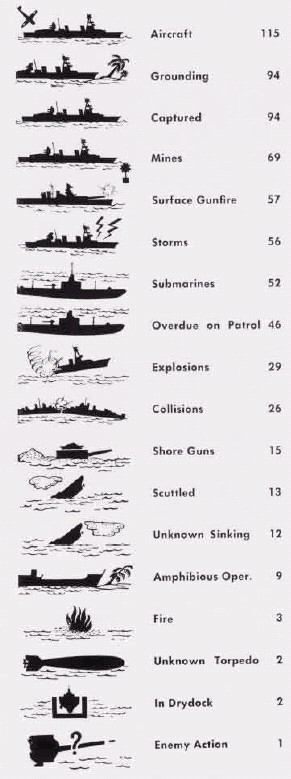
685 ships!
We don't know how many men were rescued from ship sinkings. However, we can subtract the overall WW2 Navy deaths from the aircraft deaths we do know of and get a rough idea of how many died needlessly in the water.
en.wikipedia.org/wiki/World_War_II_casualties
62, 614 Navy dead minus 11, 142 aircraft dead = 51, 472 potentially dead in ship sinkings---nearly the total number of men we lost in Vietnam!
faqfarm.com/Q/How_many_US_soldiers_died_in_World_War_2
NAVY KILLED IN ACTION 34,702; DIED OF WOUNDS 1,783
OTHER DEATHS 26,793
TOTAL NAVY DEATHS 63,278
36, 485 Navy dead from combat minus 11, 142 aircraft dead = 25, 343 potentially dead in ship sinkings
WOUNDED 33,670 MISSING 28
TOTAL NAVY CASUALTIES 96,976.
MARINES; KILLED IN ACTION 15,460 DIED OF WOUNDS 3,163
OTHER DEATHS 5,863
TOTAL MARINE DEATHS 24,486
WOUNDED 67,134
TOTAL MARINE CAUALTIES 91,620.
We cannot differentiate marine dead at sea or on land if we subtracted their aircraft dead. However, one LIE is revealed---this USMC BS that they did all or even most of the dying and somehow deserve worship and adulation is a pile of crap; the U.S. Army did most of the fighting and dying in WW2 against the very dangerous German military, and even in the side-show Pacific THE U.S. NAVY's SAILORS DID MORE OF THE DYING BY A FACTOR GREATER THAN 2-to-1. Only 18, 623 marines died in "glorious" combat in WW2.
PLANE LOSSES
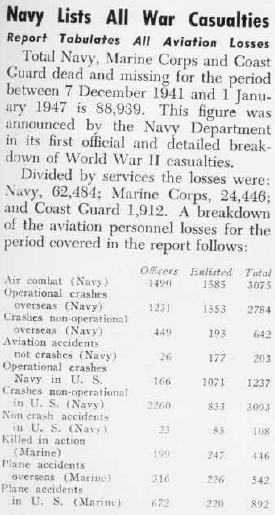
Non-Combat (TBATE)
Navy: 2, 784 + 642 + 203 + 1, 237 + 3, 093 + 108 = 8, 067 DEAD
Mc: 542 + 892 = 1, 434 DEAD
________________________________
SUB-TOTAL: 9, 501 DEAD
Combat (TBAM)
Navy: 3, 075
Mc: 446
________________________________
SUB-TOTAL: 3, 521 DEAD
_____________________________________
TOTAL: 13, 022 DEAD BY AIRCRAFT
Read the U.S. Naval Aviation News magazines from 1942-1946:
www.history.navy.mil/nan/backissues/1940s/1940smain/1940smain.htm
NARCISSISM is the #1 PROBLEM IN THE U.S. MILITARY.
What WW2 Should Have Taught Us...
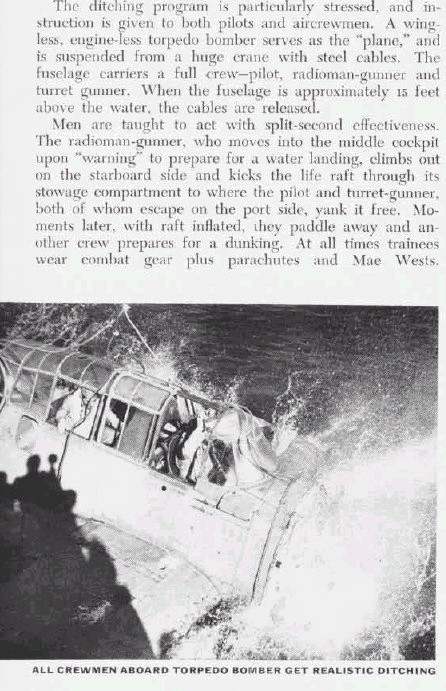

Past issues of U.S. Naval Aviation News reveals the forced adaptation to harsh circumstances in WW2 followed by the decay of the Navy and marines that started immediately at war's end. The FACTS are that in war whether you are on a ship or in an aircraft, the chances are very high that you will end up IN THE WATER. Facing this reality, the Navy by war's end realized that they actually had to have all aviators get into an aircraft fuselage on a crane and dunk them into the water and forced them to actually practice water crash landings ("ditching") and escape the aircraft and get into floatation life vests and rafts. During actual operations in combat, they had lifeguard small boats, submarines, small seaplanes from battleships/cruisers, large seaplanes and long-ranged land planes on "Dumbo" patrol ready to drop rafts/supplies and land on the open ocean (what saved the 300 survivors of the USS Indianapolis out of the 900 thrown into the water after 3 days of neglect), and even LTA blimps ready to hover over and reel-in men in the water. 2, 150 men's lives were saved. Go ask them if they are still around 6 decades later and their off-spring if this rescue effort was worth it or not. You could start with George H.W. Bush Senior who was saved by a submarine when his TBM Avenger plane was shot down in WW2...then ask why his son as incompetent RMA-driven president does not provide adequate rescue means for today's servicemen?
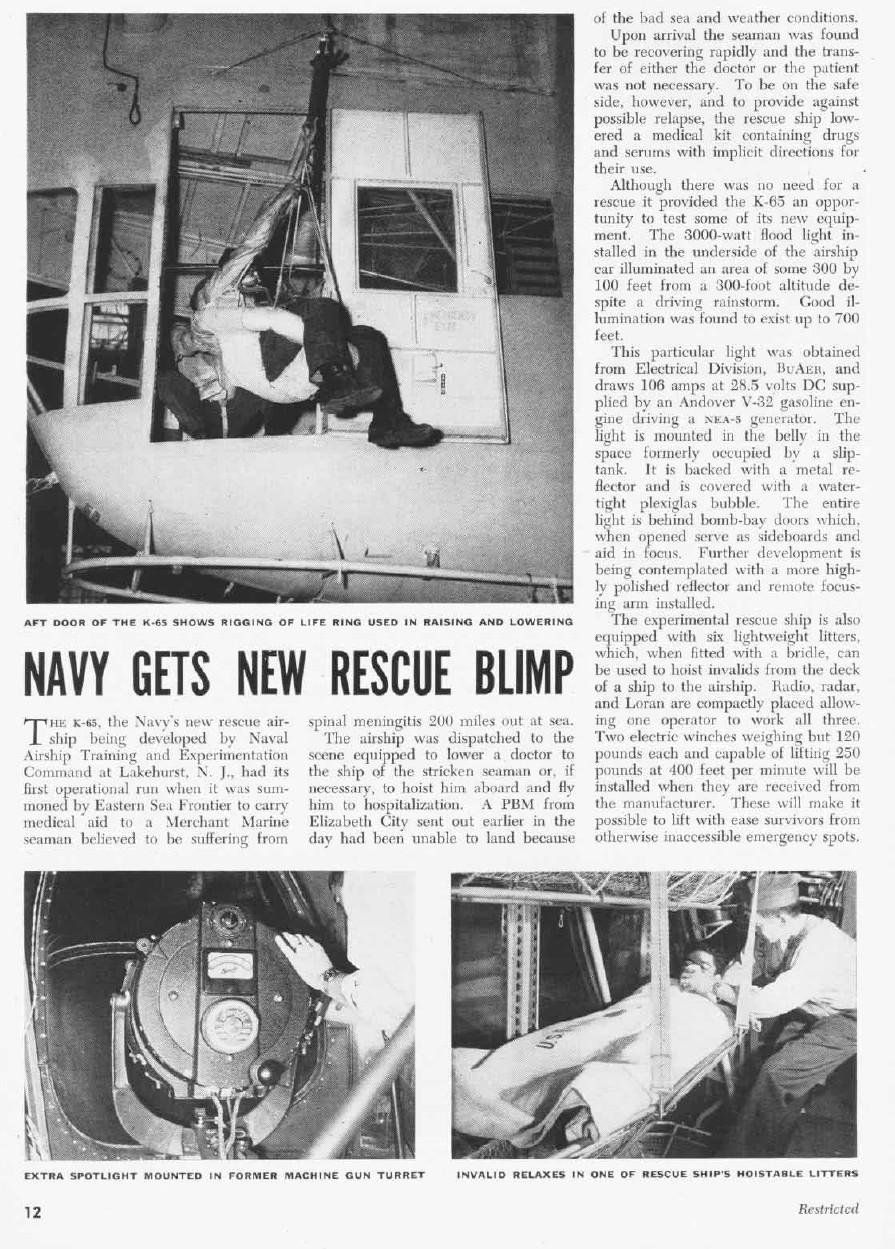
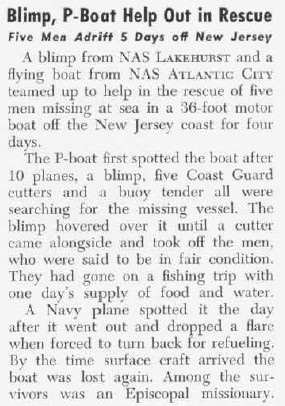
Ditching was preferred over parachute bail-out in WW2 because you could have more survival supplies if you can access your larger sea raft in your aircraft than what was carried on your person leaving the plane. Survival in the water gear was perfected and improved on. The caveat here was this was all being done to recover the costly to train egomaniac aircrew member; the sailor on a surface ship didn't get shit for survival gear and this neglect continues to the present day; if the survivors of the Indianapolis had had a fraction of the gear the naval aviators had, say solar stills, a lot of 900 wouldn't have died of thirst during the 3 days the "Big Navy" forgot they existed. The survive-in-the-water ethos of the naval aviators of WW2 needs to be brought into the surface sailor mentality who should be a WARRIOR in the first place. However, this all came to a screeching halt at the end of WW2.
Solar Still to get fresh drinking water from 1946: what's our excuse for not having these today?

As the memories of WW2 faded and common sense men left the service, the narcissistic egomaniac pompous asses took over and began to squeeze out common sense reality from the force structure to create more money for their large supercarrier ego cash cows. First to go were the small aircraft carriers. Then the small seaplanes under the bogus excuse that the short range and slow helicopter would keep everyone dry and somehow keep subs away when they can't even fly far enough to create an outer defensive ring. Next, the large seaplanes and LTA blimps were retired with another lame excuse that carrier-based and land based ASW planes would do rescues and hunt subs when they can't even land on the water. Heavily armored battleships and cruisers take money from the supercarriers, so they were substituted for flimsy, thin-skinned destroyers/cruisers packed full of sexy electronics and missiles, all ready to explode if hit. That the USN even has submarines is a minor miracle of Admiral Rickover and a WW2 veteran Congress, both of which are gone today. While not happy to have subs forced upon them, the large aircraft carrier "mafia" will damn well not waste money on things that admit that they are vulnerable to enemy subs so the carrier-based S-3 Viking ASW planes that could create an outer defensive circle are retired and the land-based P-3 Orion ASW patrol planes allowed to wear out to the current less than 100 to create more money for ego gratifying F-18s to drop expensive guided bombs for mega expensive land attack competition to the USAF doing sub-national GWOT wars. That "no one is minding the store" at sea begs the enemy to sink us en masse.
Navy/Mc Aviation not ready to go into the water...or land
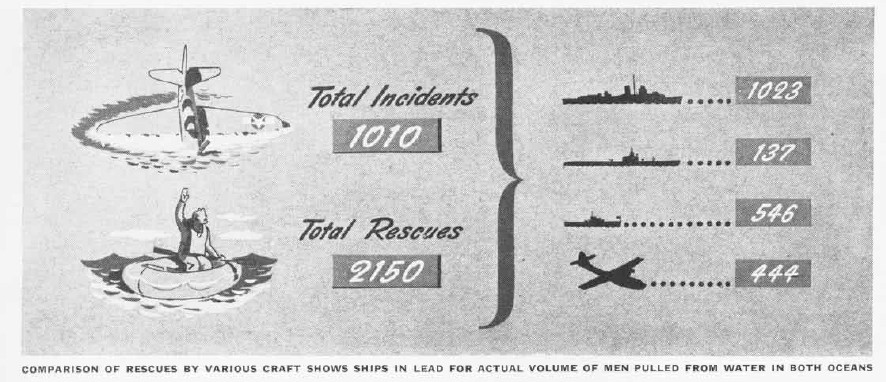
As WW2's thousands-of-men-in-the-water institutional memory faded, two tracks of aviation continued; slow airplanes and fast ones. The slow airplanes that can do ASW-AEW, COD and CSAR have as we see been slowly squeezed out of existence placing the entire survival of the surface navy in dire jeopardy. When these planes are hit by enemy fire there are two choice; you can bail-out with a parachute or crash-land. With everyone living in denial, its a question if Navy lower-life form personnel even have parachutes on the P-3s and E/C-2s or other transport planes. They all think they are in an airliner trip that will start from a smooth runway and end with a smooth runway. In 2001, this BS smashed into the crew of a Navy EP-3 Aries II (Orion) when an overly aggressive communist Chinese fighter collided with them. The pilot should have ordered everyone to bail-out if they had parachutes and been trained/prepared to survive in the water. If not, he should have prepared them to ditch into the water and get into life rafts. Again, its doubtful they had any realistic dunker training to get into the water, though lots of hardy WW2 generation sailors learned on-the-job. So instead, the pilot in command chooses to fly his damaged plane TO THE NEARBY COMMUNIST AIR BASE TO CRASH LAND THERE AND GIVE AWAY ALL OUR ELECTRONIC WARFARE SECRETS HELD ON THE PLANE TO THEM. So much for patriotism.
The point here is that the United States suffered grave compromise to its national security in the field of electronic warfare all because the screwed-up-refuse-to-face-the-reality-that-it-operates on-the-water Navy did not have an aircrew ready to either bail-out or ditch so their plane could sink to the bottom of the ocean and not fall into enemy hands. Again, the slow unsexy but necessary planes of our Navy are marginally tolerated and certainly neglected. The fact is that ALL U.S. MILITARY PERSONNEL SHOULD BE PARACHUTE JUMP QUALIFIED. EVERY PERSON WHO RIDES IN A MILITARY AIRCRAFT SHOULD HAVE AT THE VERY LEAST A BAIL-OUT PARACHUTE. Those aircrews in planes without ejection seats had damn well better start taking water crash landings seriously to include actual dunker training so they can get themselves out of the plane in a hurry and get into life rafts. Survival training to employ at sea water creating and signal devices is a must. This is the bare minimum and we are failing to do this.
One of the reasons water ditching is not on the "radar screen" of institutional Navy/Mc consciousness these days is because the sexy fighter planes they prefer have ejection seats. When you eject, you automatically get whether you like it or not a seat pack that has a small one-man life boat. So over the years, pilot ejects, he gets into his tiny boat, starts his locator beacon and awaits for rescue. If he's found, all's well, if not he was just another dead egomaniac, who cares? He signed up to be sexy and now he's dead. Live in fame, down in flames yadda yadda. However, if the pilot doesn't die after ejection but gets captured by the enemy he may end up getting tortured for years in a "Hanoi Hilton". What is the navy's response then? Rather than admit that the best way to affordably project high explosives en masse is by the sea based artillery of Iowa class battleship guns, they want to take humans out of the airplanes so they don't have to hassle with any of this we-got-to-rescue-him costs/complications: enter the UAV model airplane BS. And this BS is far from new. AS SOON AS WW2 ENDED THE NAVY BRASS WERE ALREADY GA-GA OVER PILOTLESS REMOTE CONTROLLED PLANES. We flew 24 F-6F Hellcats by remote control into the nuclear bomb mushroom cloud at Bikini atoll in 1946. The question that arises is, if we were able to guide planes and bombs and missiles by WW2's end, WHY WERE WE DROPPING IRON BOMBS OVER NORTH VIETNAM TO TRY TO DROP BRIDGE SPANS USING HUMAN BEINGS IN FIGHTER-BOMBER AIRCRAFT, suffering thousands of casualties?
The UAV and the cruise missile are costly attempts to FLY WITH WINGS THE ORDNANCE TO THE TARGET. The USAF already has this disease in spades as its reverting back to a blue uniform expensive version of Army field artillery. As the Navy continues to neglect is core responsibilities of controlling the sea, its following the Air Force to be an ultra expensive sea-based version of field artillery to do LA.
Exposure Suits: Great For Pilots, what about the 5, 000 Sailors that could end up in the water if the carrier is sunk?
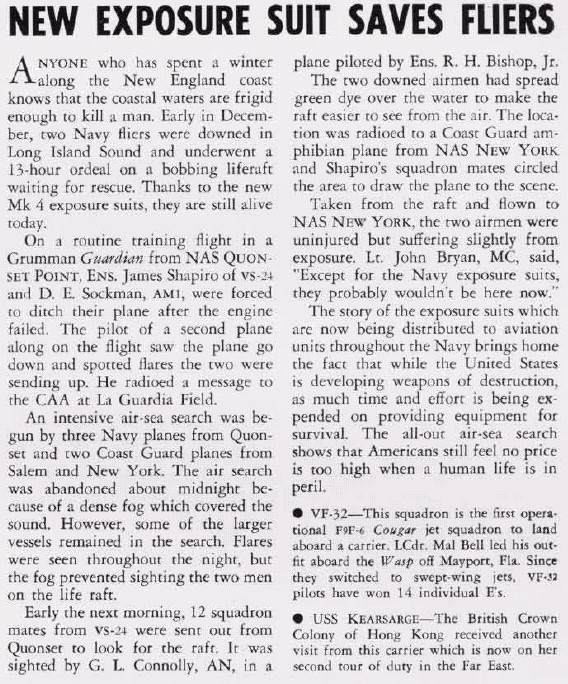
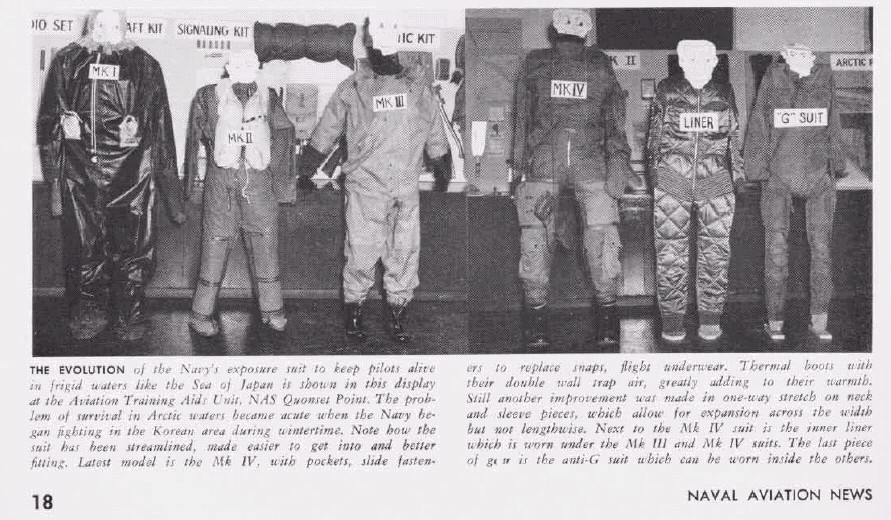
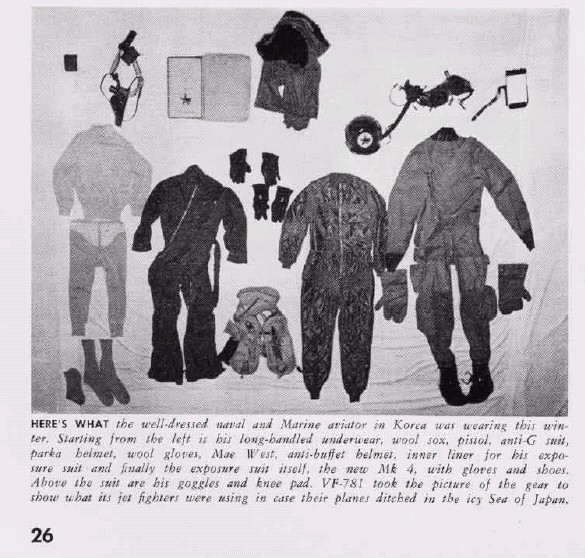
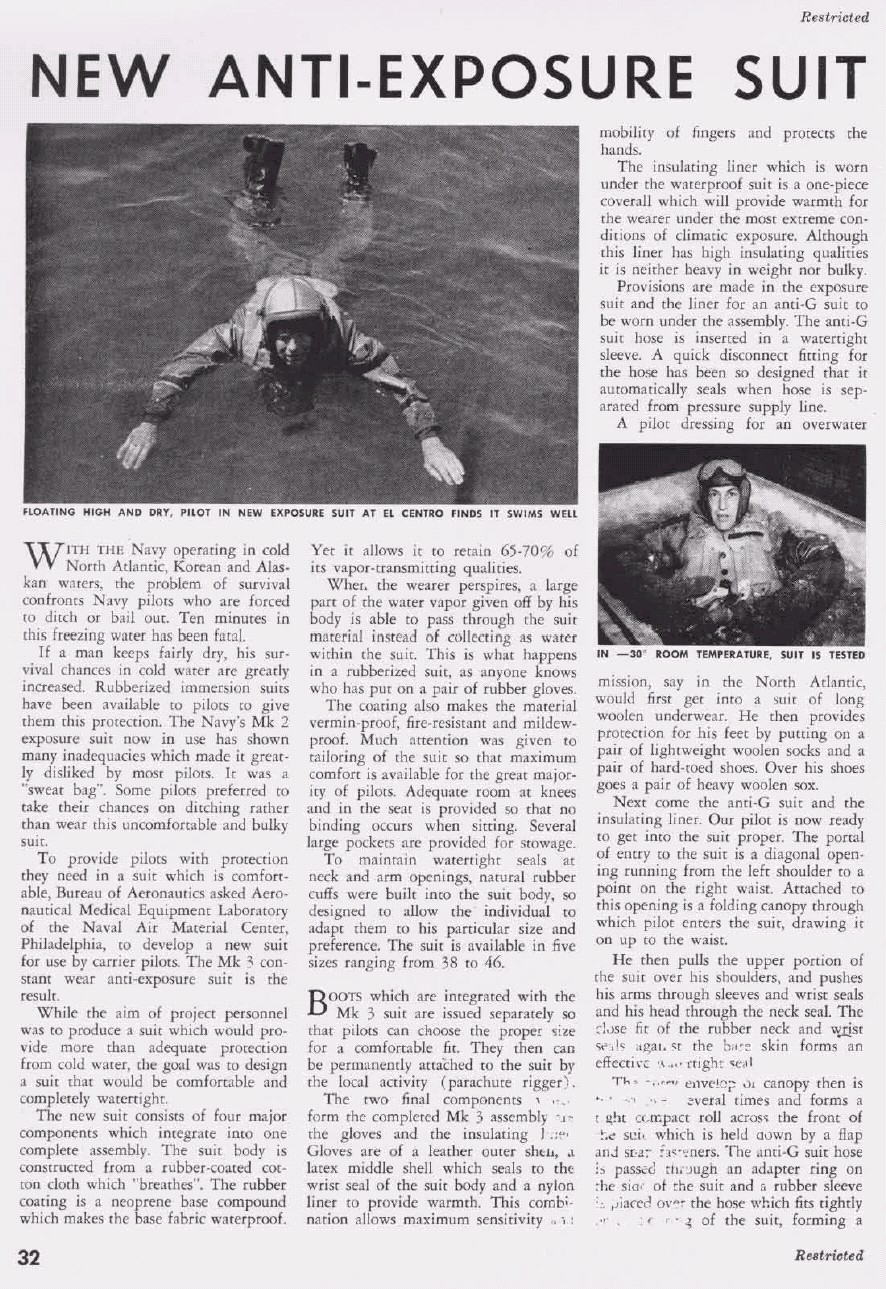
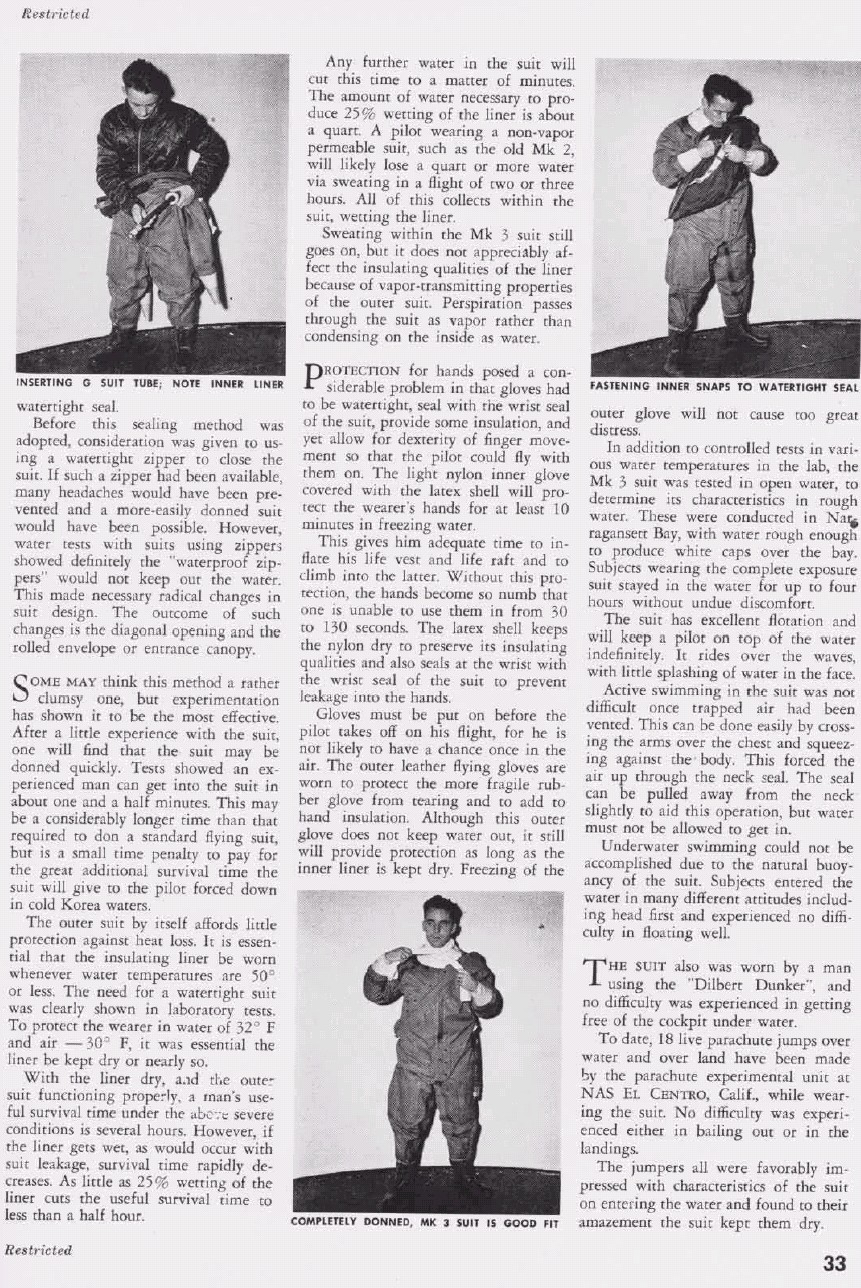
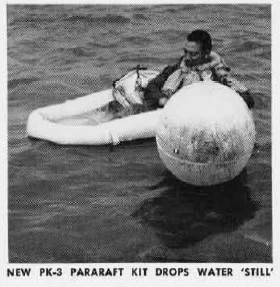
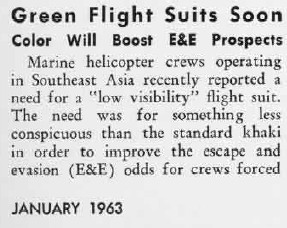
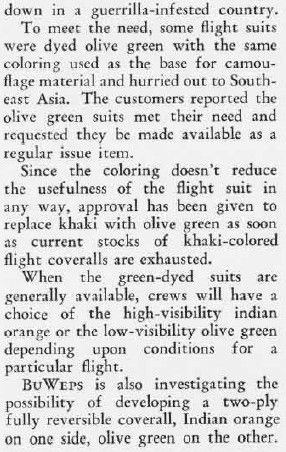
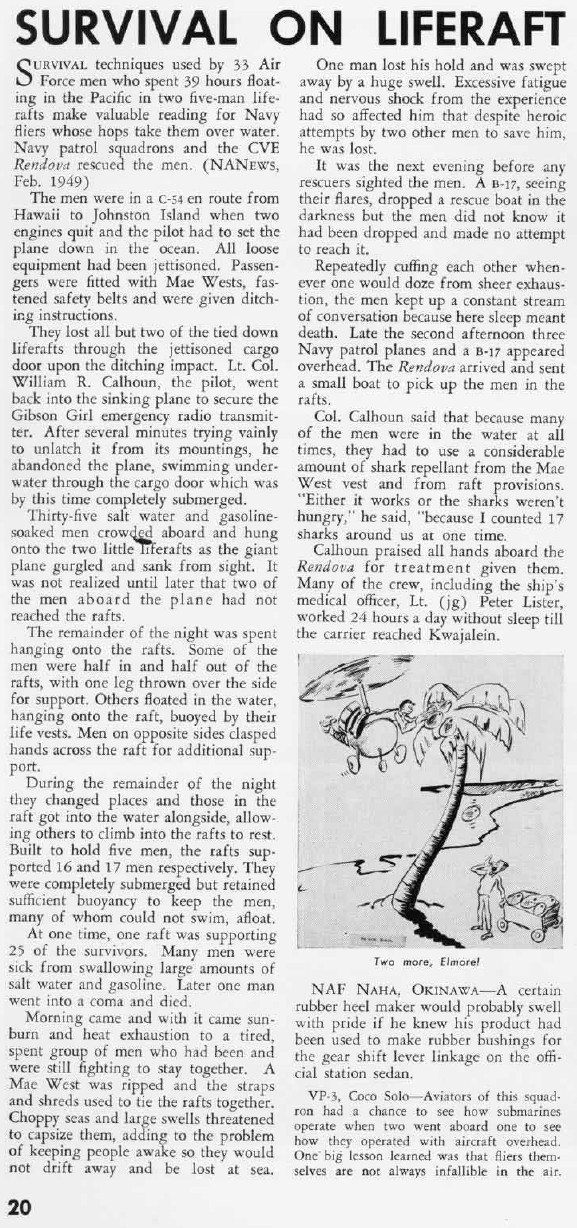

This is all great for the fighter pilot who may end up as a middle-aged video game operator, but for the 5, 000 slaves on the supercarrier enabling his "high flight" ego trip, if THEY get blown into the water, they don't have shit. The slow don't-have-much-of-the-right-stuff aircrews have to bail-out or ditch. And in a major shooting war, there will be no one to rescue any of them when our tiny can't control the seas from air or sub attacks, unarmored surface ship navy is itself in flames and doing a Titanic without Kate Winslett. There is no "PLAN B". There are no armored battleships/cruisers, small or large seaplanes, no blimps and not anywhere enough submarines to rescue the THOUSANDS that will be in the water when a "carrier battle group" (CVG) or better known as a CARRIER VICTIM GROUP gets sunk.
When UAV firepower doesn't work? Send in the clowns
Another thing a fresh look at WW2 would reveal is that we DID NOT CATCH JAPANSE KAMIKAZE AIRCRAFT ON THE GROUND TO PREVENT THEM FROM DIVING INTO OUR SURFACE SHIPS. If you look carefully at the back issues of Naval Aviation News you will see pictures and reports of the Japanese extensively using dummy planes to absorb our aircraft firepower. The Navy brass pompously boast that carrier planes hit many kamikaze planes in pre-emptive strikes, yet the FACTS are that THOUSANDS OF KAMIKAZES TOOK OFF FROM OUT OF NOWHERE AND TRIED TO DIVE INTO OUR SHIPS AND MANY WERE NOT STOPPED BEFORE SUCCEEDING TO KILL THEMSELVES AND LOTS OF AMERICANS. Its inescapable to have to conclude that the planes you see in obvious horseshoe revetments in Navy pictures at the time MUST HAVE BEEN DECOYS INTENDED TO BE SEEN BY US. The Japanese certainly must have taken off in a small plane and looked down at themselves to see how their deception and camouflage was working or not working.
So if MANNED aircraft can be fooled by enemy C3D2, then certainly the UAV with a soda straw view and TV imagery is going to be fooled, and we will end up expending $BILLIONS of dollars of expensive ordnance blowing up NOTHING. When this happens, the inevitable result when the "transformational RMA" bullshit fails is to SEND IN HUMAN BEINGS IN THE AIR AND ON THE GROUND TO FIND OUT WHERE THE ENEMY REALLY IS. Exactly what recently befell the IDF in southern Lebanon after they listened to our RMA lunatics. And when these folks are sent in they will be ill-prepared because for the years preceding the conflict they bought into the RMA push-button firepower war bullshit and neglected TRACKED ARMORED GROUND MANEUVER and manned observation/attack aircraft that can work together to separate the actual enemy "wheat" from the decoy "chaff". They will die by the thousands fighting the enemy "even" on foot or get constantly blown up in flimsy rubber-tired trucks that can't leave roads/trails where enemy land mines await them. Turn your TV on and watch video from Iraq. Our aircrews will get shot down and become bloated bodies on the water or be captured/tortured and used on TV as hostages.
What should we do?
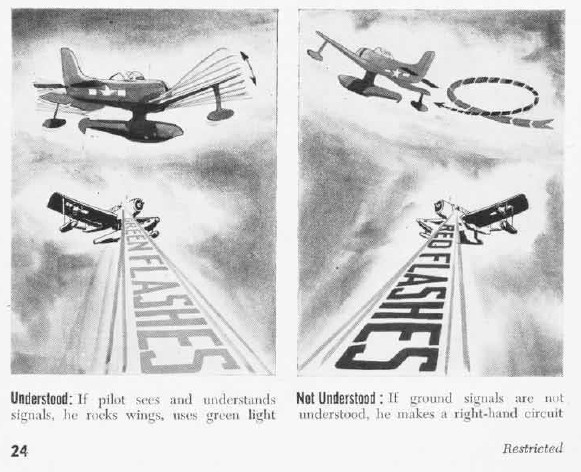
We need to wake up (replace greed and ego with humility and practicality) and restore a sea control Navy that can smother enemy air and sea attacks in the first place with container ship carriers. We need to bring back heavily armored battleships/cruisers, small and large seaplanes and LTA blimps for ASW/CSAR/COD/SOF, and improve ejection seats so they can glide a short distance for safe recovery by a rescue plane in flight or on the ground/sea. EVERYONE in the Navy/Mc needs to be trained and equipped as individuals to bail-out parachute jump or ejection seat parachute jump or be thrown without warning into the ocean after a ship explosion/sinking and survive. The USAF's choice of the CH-47 helicopter as its new CSAR platform is very wise since it can land on water and roll-off M113 Mini-Gavin armored tracks to go pick-up downed aircrews as the Chinook sits in a semi-secure location. At least someone is on the ball in our physically emasculated DoD.
We need to stop packing dumb marines by the thousands in vulnerable surface ships just to deploy them ashore on foot and in wheeled trucks just so they can get themselves killed to self-validate at tax payer's expense. What amphib ships we have to be sent out only if grouped with adequate container ship carrier air cover to keep them from being sunk. The future must be in submarine amphibious assault carriers and large WIG seaplanes; if the narcissistic marines want to keep replaying WW2 frontal beach assault blood baths, then its time to disband them and give the job of projecting land maneuver forces from the sea to the U.S. Army who has always done a better job of it anyway (North Africa, Normandy, Sicily, South France, New Guinea, Philippines, Inchon).
We must also face the fact that aircraft WILL CRASH and stop accepting these human and materiel losses because this feeds the greed of the MICC-TT. We don't make thousands of airplanes anymore like we did in WW2, so we damn well better do EVERYTHING we can to save them. We need SIMPLE, AFFORDABLE observation/attack "Killer Bees" that we can have in the THOUSANDS that are CRASH-WORTHY and have redundant recovery systems so at the very least we get an aircraft back for cannibalization for parts. What this could be from a "clean sheet" design is covered on the web page below:
www.combatreform.org/killerbees2.htm
We need to stop living in denial and face the fact that we as humans have to be involved IN THE MEDIUM WE ARE FIGHTING IN a.k.a MANEUVER and stop these false notions of absentee firepower warfare.
 FEEDBACK!!!!
FEEDBACK!!!!
Army Aviator replies:
"During the Vietnam conflict the Army experimented with ejection systems for the Cobra helicopter. Blow the rotor system followed by ejection for the pilots. It never got far as the time for the sequence took to long for the flight profile of a Cobra without rotors. Aviators also were more comfortable with attempting autorotation. This was before the days of SAMs. SAMs drove helicopters to low level as we entered the days of massed formations with ZSU 23-4 and SA-8 and MANPADS. So in this environment bailing out would be non-productive. Also there was the possibility of jumping out into the tail rotor, that would ruin your day as well. The American (and European) method was to build aircraft with shock absorbing seats, impact absorbing fuselage sections, and long stroke landing gear. These have proved viable as long as the aircraft impacted at lower speeds and with the dirty side down. Indeed this is what kept some of the aviators alive in the Blackhawks that got shot down in Somalia. The Army is introducing airbags into helicopters now to further improve the survivability factor for the crews. Escape from transport helicopters was never considered as it was felt that it would not be good for moral to have the aviators leave the damaged aircraft with the troopers in the back. Better they should share the troopers fate and maybe get the aircraft on the ground safely, versus punching out at the first sign of fire, etc. Interestingly for this very reason the marine corps elected not to put ejection/bail out capability in the V-22.
With the change of flight profiles (higher again) there has yet to be an issue of attempting bail out. Still not flying high enough to get out and open before the sudden stop at the bottom. Ejection requires you blow the rotors and there is no guarantee they will all come off. Of interest the Russians have designed the KA-50 Werewolf (NATO: Hokum) with an ejection system. Part of the reason that the Russians have opted to go this route is that they have a different flight profile/philosophy than we do. The Russians use there aircraft more as a close air support system. Indeed the KA-50 seems to have more in common with an A-10 Warthog than an Apache helicopter. Big cannon (forward firing), massive amounts of armor plating, good stability in forward flight. Ironically the high time Hokum pilot was killed last year when he attempted to land his helicopter with major rotor damage when he was in a position to use the ejection system. The Russian way is to fly race tracks, or high speed routes to an initial point, then climb to altitude for a diving attack run. This and the Russian experience in Afghanistan that required them to operate in high mountain environments at high altitude I think has lead them to this methodology. I will defer to Mr. Grau on this issue if I'm off target.
As to the issue of CSAR and extraction. This is an area that the Army is finally waking up to. Until recently most Army aviators felt that if you went down in Indian Country, you were on your own, to "hoof it" back to friendly lines. With the hyperpress capability the modern world (Durant in Somalia, USAF CPT in Bosnia, F-117 pilot Serbia) we are starting to learn how to do extraction. Aviators now have a survival vest with leg straps and d-rings. The Special Ops aviators developed it and the rest of us thought it a great idea. Indeed the one Apache crew that was shot down in Iraq ran over to their wingman's aircraft and clipped themselves to the landing gear. Most of the missions now flown in the Balkans either have a Blackhawk along for crew extraction or have one with a reaction force standing by at the base on notice to fly out and extract the crews. Most helicopter crews will try to extract their Buddies themselves.
The British have taken up on the GRIER concept Mike talks about for their Harriers, mostly because flying around outside at 300-500 knots is not good for ones health. I don't mean to dismiss the concept. I actually think it is a good idea. Hanging around on the outside of a helicopter in the dead of winter does not seem to be a good idea. But how many do you take on a mission? Every pod is one less station for munitions. I really like the concept of having enough room in an attack aircraft for a couple of extra people somewhere. That however causes the designer dilemma of how to deal with the requirement with all the other factors. More space equals more weight, equals bigger engines, equals more gas, equals bigger airframe....
As long as the main propulsion for Army Attack airframes is above the aviators head, I do not see an ejection system being viable. With the flight profile still being low (> 1000 ft) manual bail out would be highly risky (by the time an aviator decides he can't deal with it he has probably lost half his altitude). Think we are making great strides in CSAR, we have room for improvement. New survival radios with GPS beacon give us the ability to pinpoint downed crews for rapid extraction (the F-117 pilot last year). Still the Army needs to continue to develop internal and joint doctrine."
REPLY:
The Russian pilot was trying to save the Ka-50, Russia is cash-strapped, he was being heroic to help the program not hesitant about the ejection seat system in my opinion.
 Return to U.S. Army Airborne Equipment Shop
Return to U.S. Army Airborne Equipment Shop

